




The technical magazine for those involved in the design, construction and refit of superyachts

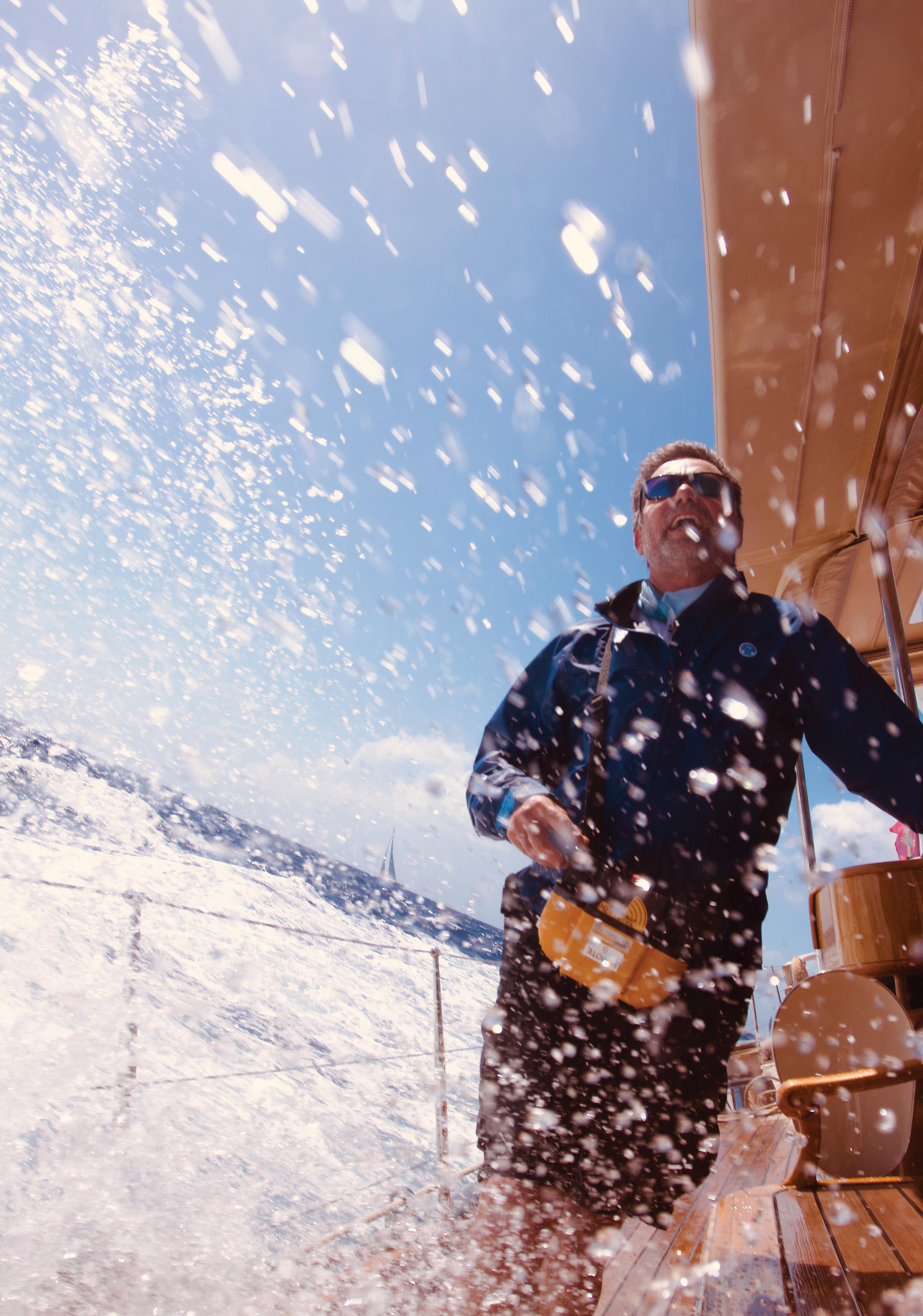
EDITORIAL
EDITOR IN CHIEF
EDITOR | HOW TO BUILD IT
EDITORIAL CONTRIBUTOR
NEWS EDITOR
FEATURES EDITOR
FEATURES WRITER
WRITER
SOCIAL MEDIA MANAGER
CONTENT CREATOR
Francesca Webster
Justin Ratcliffe
Charlotte Thomas
Sophie Spicknell
Emma Dailey
Enrico Chhibber
Ellen Ranebo
Marina Vargas
Nick Smits
DESIGN PRODUCTION
CREATIVE DIRECTOR
GRAPHIC DESIGNER
Ivo Nupoort
Beatriz Ramos
INTELLIGENCE
HEAD OF INTELLIGENCE
RESEARCH ANALYST
DATABASE MANAGER
YACHT HISTORIAN
Ralph Dazert
Adil Zaman
Syrine Mellakh
Malcolm Wood
SALES & ADVERTISING
HEAD OF SALES
SALES MANAGER
SALES MANAGER
SALES MANAGER
SALES MANAGER
CLIENT SERVICE MANAGER
SALES ITALY
Marieke de Vries
Justus Papenkordt
Daniel Van Dongen
Charly van den Enden
Nuri Ozkaya
Johanna Borreli
info@admarex.com
CORPORATE
FOUNDER & DIRECTOR
TECHNOLOGY DIRECTOR
FINANCE DIRECTOR
Merijn de Waard
Fabian Tollenaar
Laura Weber
SuperYacht Times B.V. Silodam 256, 1013 AS, Amsterdam, The Netherlands 31 (0) 20 773 28 64 info@superyachttimes.com www.superyachttimes.com
Cover Images:
Amer 41 by Amer Yachts
Volvo Facility by Volvo Penta Leapher Yachts by Justin Ratcliffe
How to Build It is published by SuperYacht Times B.V., a company registered at the Chamber of Commerce in Amsterdam, The Netherlands with registration number 52966461. The magazine was printed in October 2024.
With the Cannes, Monaco and Fort Lauderdale shows behind us, November means it’s time for METSTRADE. Indeed, this issue of How to Built It is timed to coincide with the start of the 36th edition of the keystone B2B event in Amsterdam. In anticipation, we’ve gathered a selection of the latest product innovations from companies exhibiting at the ever-growing Superyacht Pavilion in an extended products section starting on page 85.
We have an intriguing double bill of in-build reports for you. Leapher Yachts is a recent brand in the Netherlands aiming to build its first 60-metre explorer yacht of 1,750 gross tons in just 26 months. I went along to the shipyard on the banks of the Rhine to check on progress and find out how it plans to complete the build so quickly.
The second report comes from Plymouth, UK, where two brothers have embarked on an enterprising journey to transform a 50-year-old GRP sailing yacht in hideous condition into a luxury charter vessel. What’s more, they are doing it by employing the latest sustainable materials, technologies and build processes.
Just before the inaugural Asia-Pacific Superyacht Summit in Hong Kong last June, I popped over to Taiwan to visit Ocean Alexander. The composite builder has historically designed its yachts specifically with American users in mind and the US is by far its biggest market. But is the brand looking to widen its client base with the new Puro series by Italian designer Giorgio Cassetta?
Back in Europe, we call in on CMC Marine near Pisa. The supplier of electric stabilisation and steering control systems has long dominated the domestic superyacht scene, and continues to expand with strategic partnerships and a new production site near Naples. Furthermore, since setting up a branch in the UK it has started to make inroads into the tough north European market.
With winter fast approaching and summer holidays a distant memory for most of us, to finish off we thought we’d inject a little sunshine into your life by taking a look at solar energy. More specifically, at the current status of solar tech and why shipyards are happy to install it on the roofs of their facilities but rarely on their superyachts.
Enjoy!

Justin Ratcliffe - Editor


24 Business Brief: Eastern Promise
Asian shipyards have become a force to be reckoned with and Ocean Alexander in Taiwan regularly figures among the top 10 superyacht builders.
CEO in Conversation: Farsounder
Since founding FarSounder in 2001, Matthew Zimmerman has driven the technical development
and navigate
36
Build Report 1: Turning A New Leaf
Leapher Yachts in the Netherlands is rethinking engineering and production processes along commercial shipbuilding lines to build its first steel explorer yacht more quickly and efficiently.
51 Concept in Focus: Ulstein Thor
Since first unveiling is Thorium-powered Ulstein Thor design in 2022, the Norwegian company has continued to update and develop the concept. But will a nuclear-powered superyacht ever be feasible?
58 Build Report 2: Say it In Steel
We take a closer look at the 41-metre Amer Steel, the smallest in the new superyacht range from Permare that will be the first to carry Volvo Penta’s new IPS40 professional platform.

69 OEM: Control My Ride
Celebrating its 20th anniversary next year, CMC Marine in Italy is 12 months into a three-year investment and expansion strategy centered around product innovation, production capacity and market offering.
79 Inside Angle: Jan-Pieter Braam
Owners’ rep, project manager and technical advisor Jan-Pieter Braam of JPMarine BV believes in effective communication, meticulous planning and strategic team management.
85 Industry Events: Superyacht Pavilion Spotlight
Just some of the innovative new products to watch out for at the 36th edition of METSTRADE in Amsterdam.
99 New Tech: Going Pro
Volvo Penta’s new IPS professional platform takes the original concept, beefs it up for commercial use and aims it at yachts in the 40- to 60-metre size bracket.
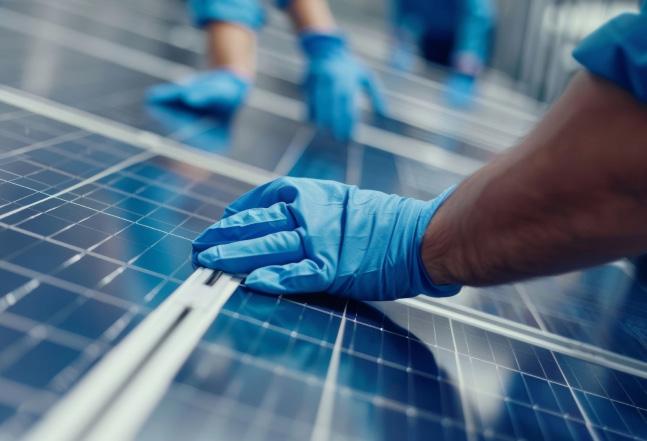
107
Refit & Conversion: A Voyage of Discovery
How do we deal with fundamentally eco-unfriendly GRP? The bold rebuild of a 22.77-metre sailing ketch in Plymouth, UK, is coming up with some innovative answers.
117 Rules & Regs: Builidng to the REG Code
Julian Smith, Principal Surveyor for Cayman Islands Shipping Registry and Red Ensign Group Yacht Code Secretariat, summarises the revised yacht code that came into effect on 1 July this year.
123 Sustainability: Let It Shine
What is the current status of solar tech and will it ever have its moment as a renewable source of energy aboard superyachts?

Volvo Penta has unveiled its helm-to-propeller hybrid-electric package, with delivery set to begin at the end of 2025. The D13 IPS hybrid-electric package comprises an electric motor and diesel engine that works in parallel on the same drive shaft, allowing for smooth Pure Electric drive mode, Hybrid mode, and seamless automatic power transitions. In Cross-Over mode, one diesel engine propels both drives to optimise efficiency and extend engine maintenance. Depending on the chosen drive mode, the system automatically controls whether the boat should be powered by the electric motor, the combustion engine, or both.
Volvo Penta also debuted its long-awaited IPS Professional Platform at the 2024 Monaco Yacht Show. Designed to deliver enhanced efficiency and performance, it is engineered with the flexibility to accommodate a range of power sources, including the potential for electric and hybrid configurations.

MIT.EQ (Marine Innovation Technology Equipment Expo) is a new international trade fair event for professionals in the marine industry with a focus on sustainable development and innovation in the sector. Designed as a meeting and networking place for shipyards, technology companies, accessories, services and solutions for the marine industry, the first edition will be held at the Rimini Exhibition Centre from 5-7 March 2025 in conjunction with KEY - The Energy Transition Expo dedicated to integrated technologies and solutions for energy efficiency and renewable energies in the Mediterranean area.
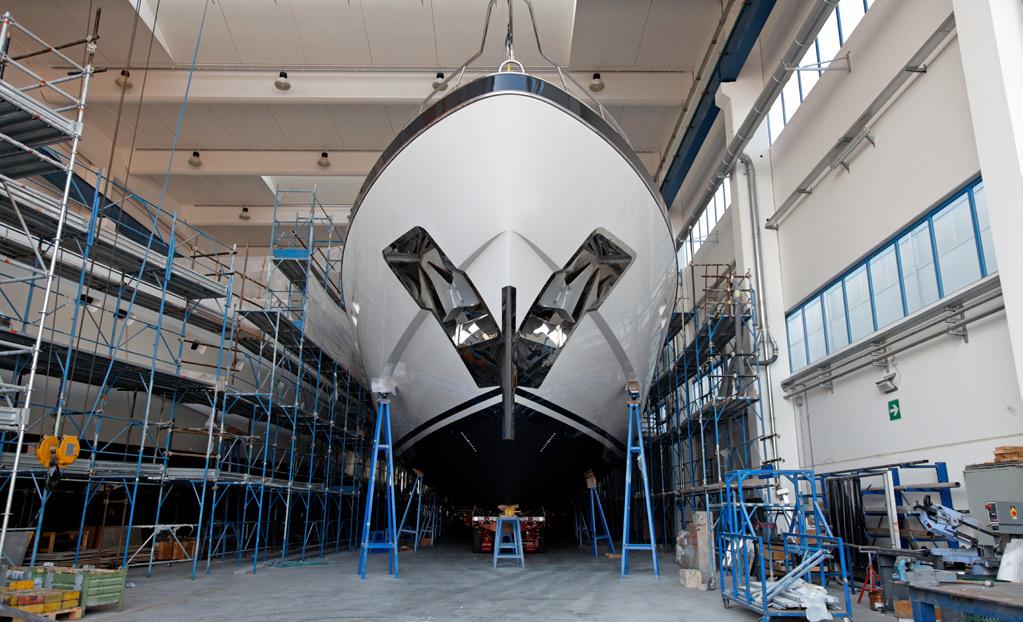
“The marine industry is a strategic sector for Italy and we believe there is room for a new vertical event dedicated to the entire industry,” says Marco Cecchini, Business Development Manager Italy & EU of Italian Exhibition Group (IEG).
“MIT.EQ will not only be a B2B trade fair, but also a speaking-platform to elevate the national and international debate on sustainable innovation in the sector.”
MAN Engines first presented its new MAN V12X engine series to a global audience at the Cannes Yachting Festival 2022. The newly developed V12 engine for yacht applications is now in serial production. For the first time the new series offers an output of 2200 hp (1618 kW) from 30 litres of displacement. Compared with the previous most powerful yacht engine from MAN Engines – the MAN V12-2000 with 2000 hp (1471 kW) – the displacement of the MAN V12X has been increased by more than five litres and the maximum torque from 6500 Nm to 7350 Nm.
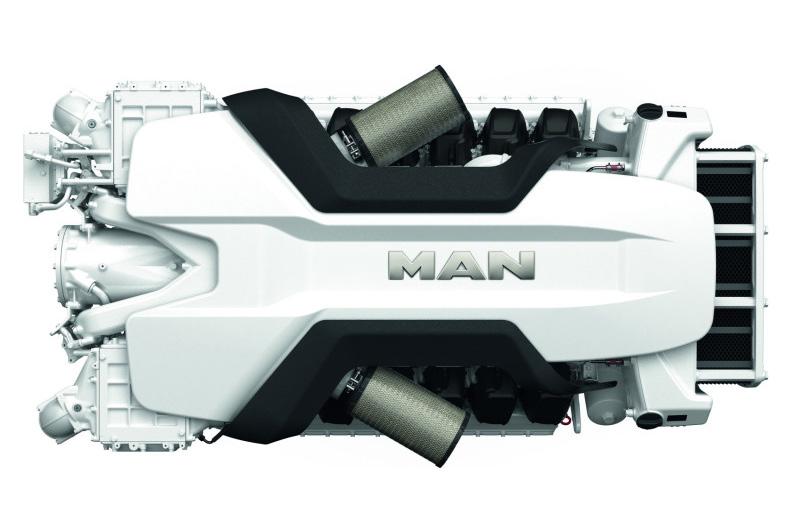
A new coolant pump and a new thermostat housing provide the MAN V12X with an optimised coolant supply for long service life. The engine is also optionally available with an outer-skin cooling system instead of the closed coolant circuit. The cylinder head of the MAN V12X, which has also been optimised in terms of flow and cooling, is designed to meet the same development goal. In addition, the oil supply has also been modified by using new oil pumps and new oil coolers, as well as optimising the flow.
Quantum hopes to introduce a breakthrough in powering stabilisers with its new patent-pending F45 – Electric/ Hydraulic Hybrid Power System that draws on the best attributes of a traditional hydraulic power unit and the cleaner advantages of a direct electric drive system. After almost five years in development and months of testing, the first F45 System was installed on a refitted 47-metre Feadship.
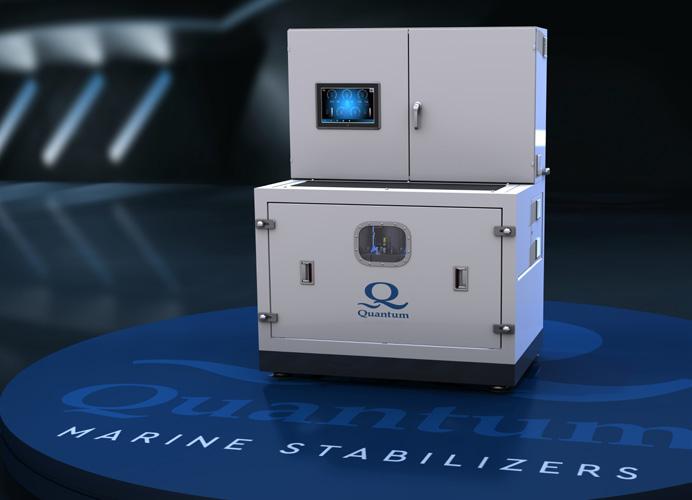
Lloyd’s Register, RINA, DNV, Bureau Veritas, and ABS, announced the formation of the Yacht Safety and Environmental Consortium (YSEC) at the Monaco Yacht Show 2024. The consortium aims to enhance safety and environmental standards within the yacht industry, with a focus on yachts over 24 metres in length.
The new consortium is committed to driving forward the safety and environmental performance of yachts, promoting and advising on achieving the best practices in the industry. The yacht sector has a considerable need for a unified consortium of class societies, as yachts are not covered by the International Association of Classification Societies (IACS) in the same way other vessels are.
Stabilisers are big consumers of power, particularly at zero speed, with an operational profile that often generates large power fluctuations, causing a strain on the generators and the power grid. The F45 is able to manage power fluctuations, as well as store and recover power, through a proprietary flywheel solution called MESS (Mass Energy Storage System). Furthermore, excess energy from fin deceleration (zero speed) or hydrodynamic force (underway) can be recovered and stored for future use through Dynamic Energy Recovery. At the 2024 Monaco Yacht Show, Quantum also showcased the E-Fin, its first fully electric stabilisation system. “The product is designed for a fin size in the three to five-metre range, which we refer to in terms of fin square-metres, and can be easily retrofitted to a Quantum XT.” says John Allen, owner of Quantum Marine Stabilizers.
“LR is proud to work with our class peers to establish the Yacht Safety and Environmental Consortium,” says Engel-Jan de Boer, global yacht segment director at Lloyd’s Register . “The collaboration is a shared vision that will enable the industry to address safety and environmental challenges more effectively. By working together, we can set new benchmarks and ensure best practice across the industry.”
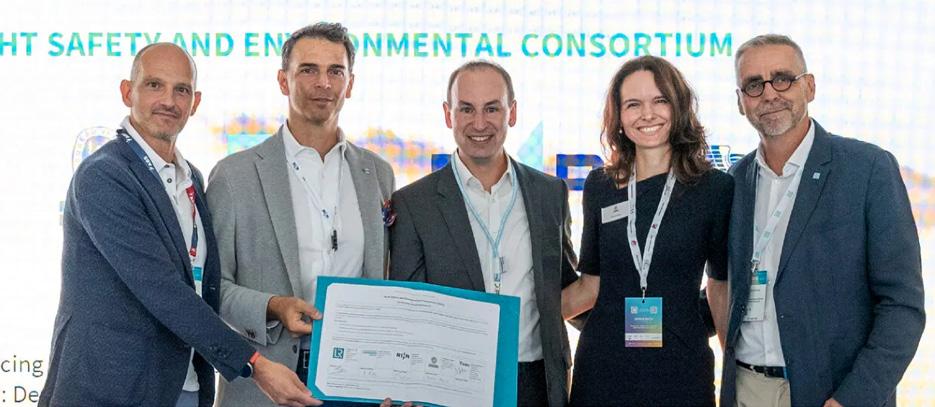

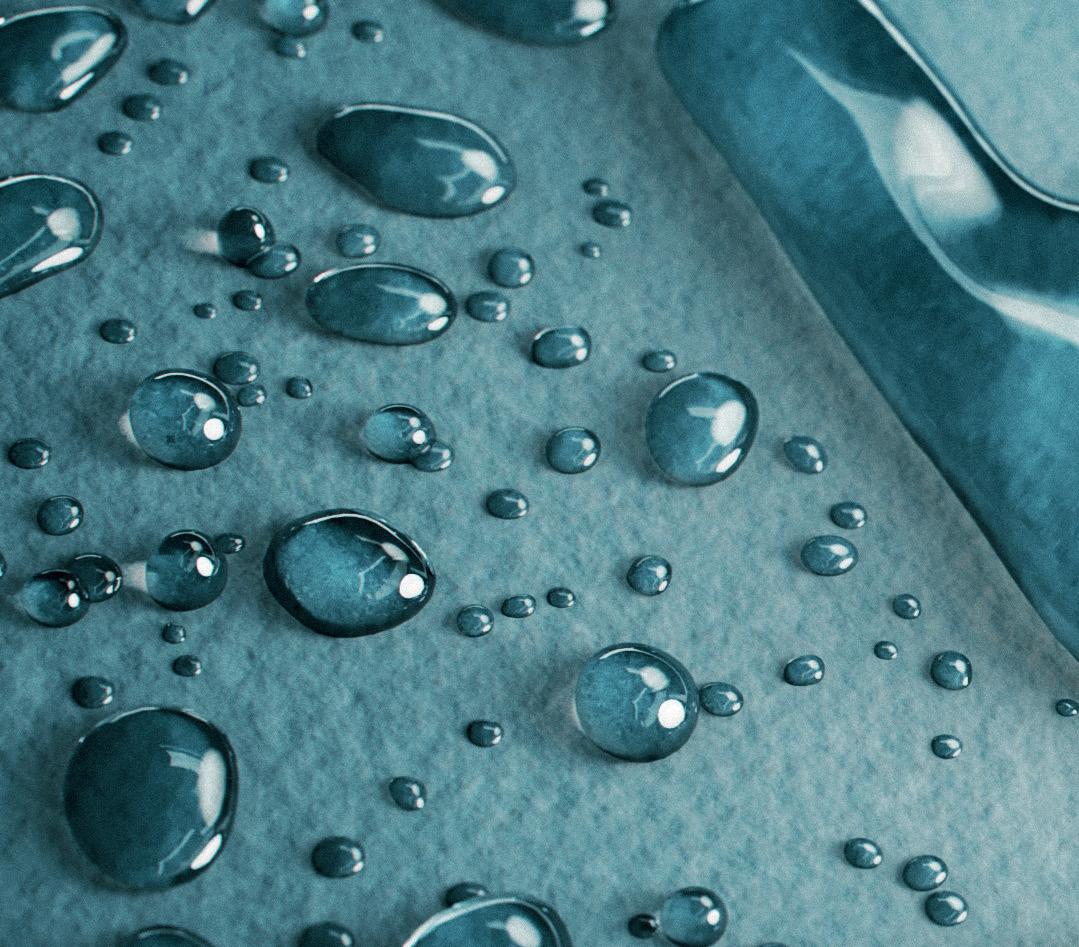



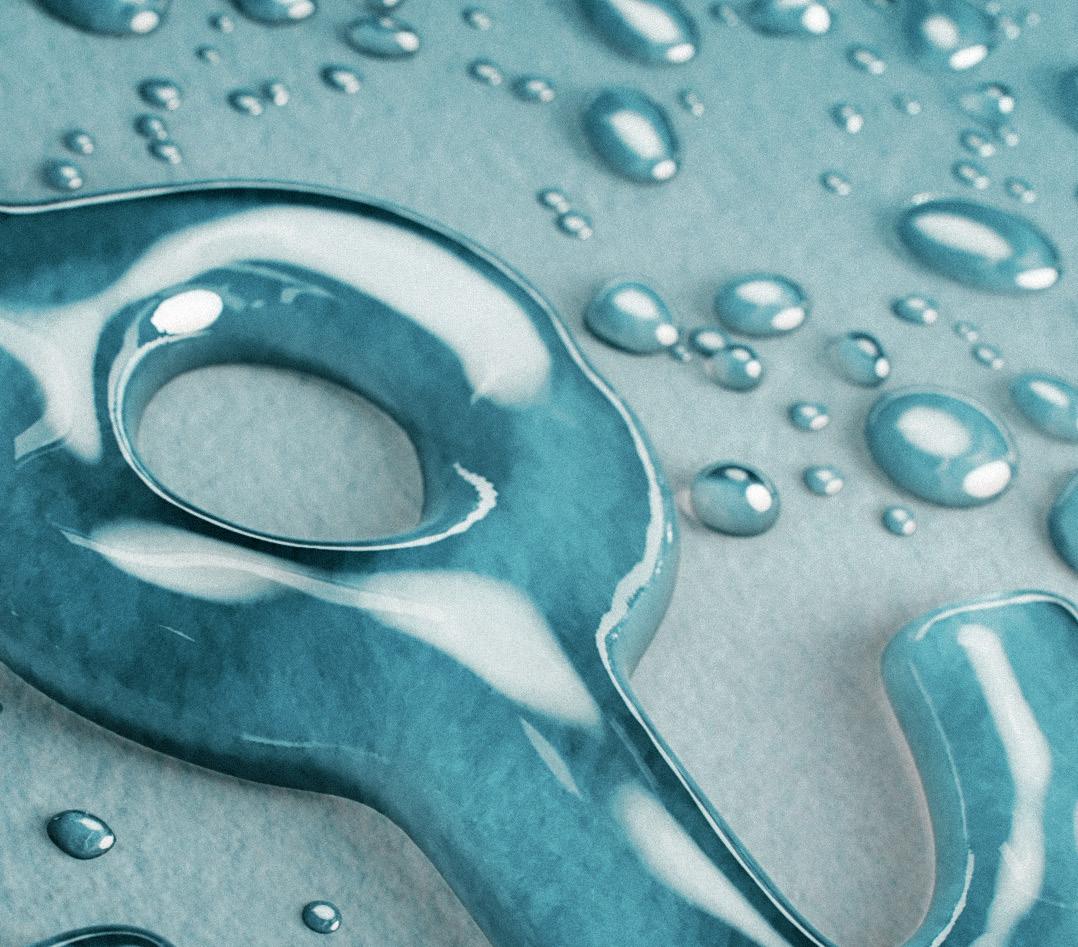
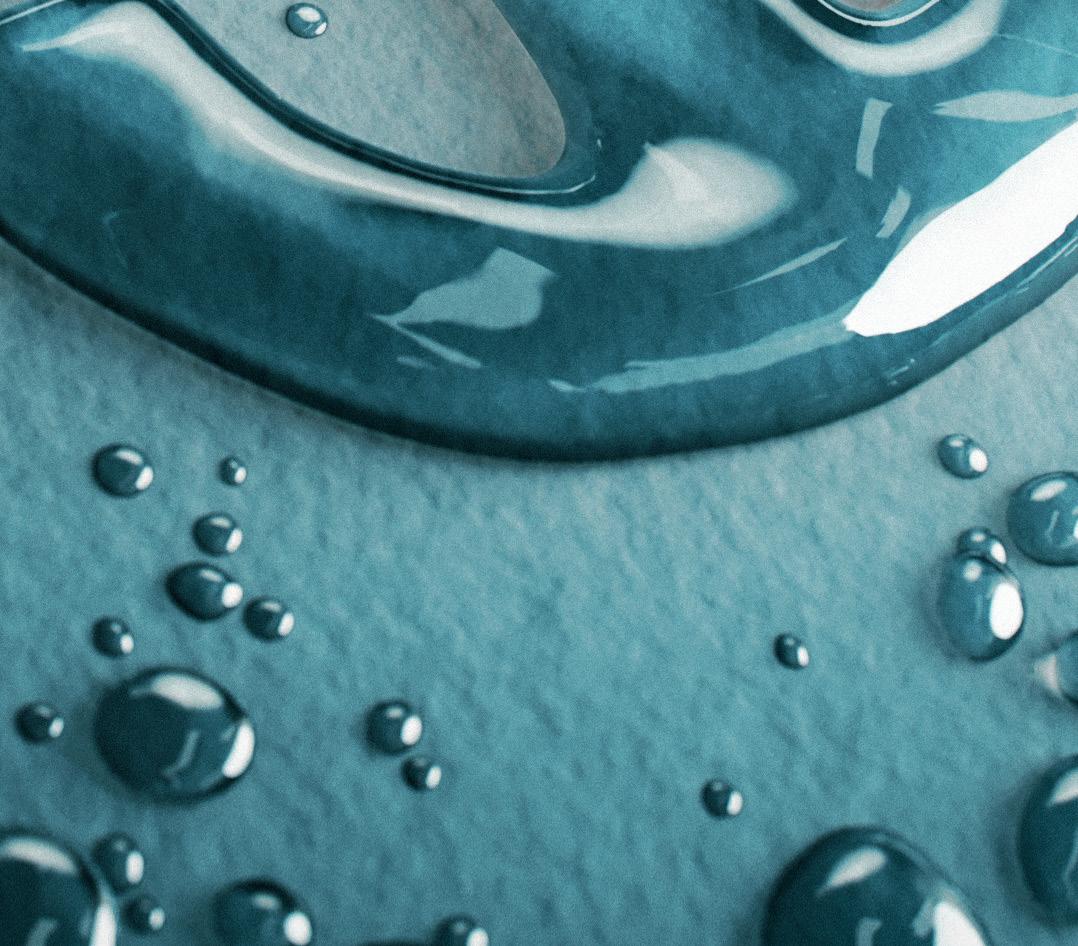



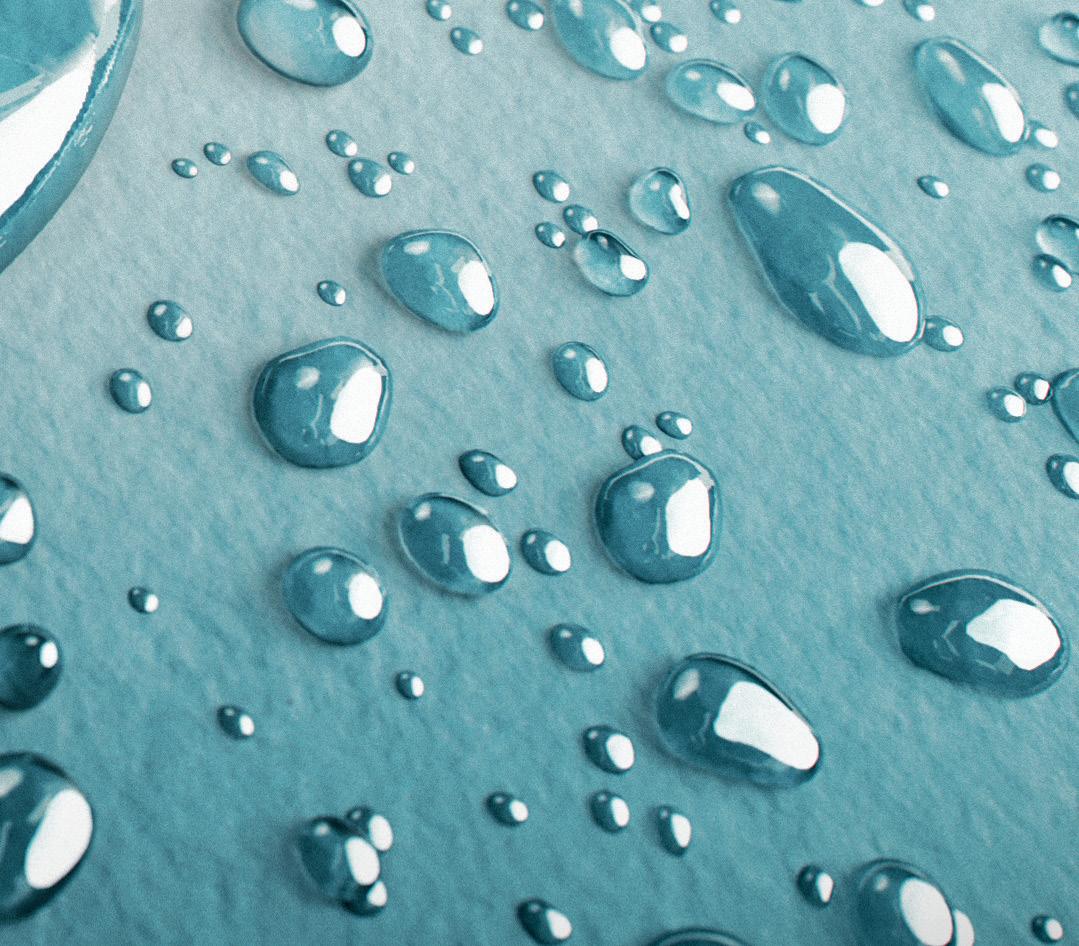






Following the successful launch of the Awlgrip® 3D Color Visualizer, AkzoNobel has added two further digital capabilities to its technical service offer. The new innovations include RealWear, a camera headset that will change the way applicators worldwide can access support, and Virtual Reality (VR) Spray Gun technology. Both RealWear and the VR Spray Gun are compatible with the Awlgrip, Interlux®, International® and Sea Hawk® brands and will help train and upskill both the current and future generation to deliver superior yacht finishes, globally.
The RealWear camera headset is a safe and hands free visual assistant tool that connects applicators directly to the AkzoNobel team for real-time technical support. Users wearing the RealWear glasses can stream video and take pictures, allowing the AkzoNobel technical team to observe issues and offer support in real time from anywhere in the world. The software can be used via mobile and is compatible with both Apple and Google operating systems.
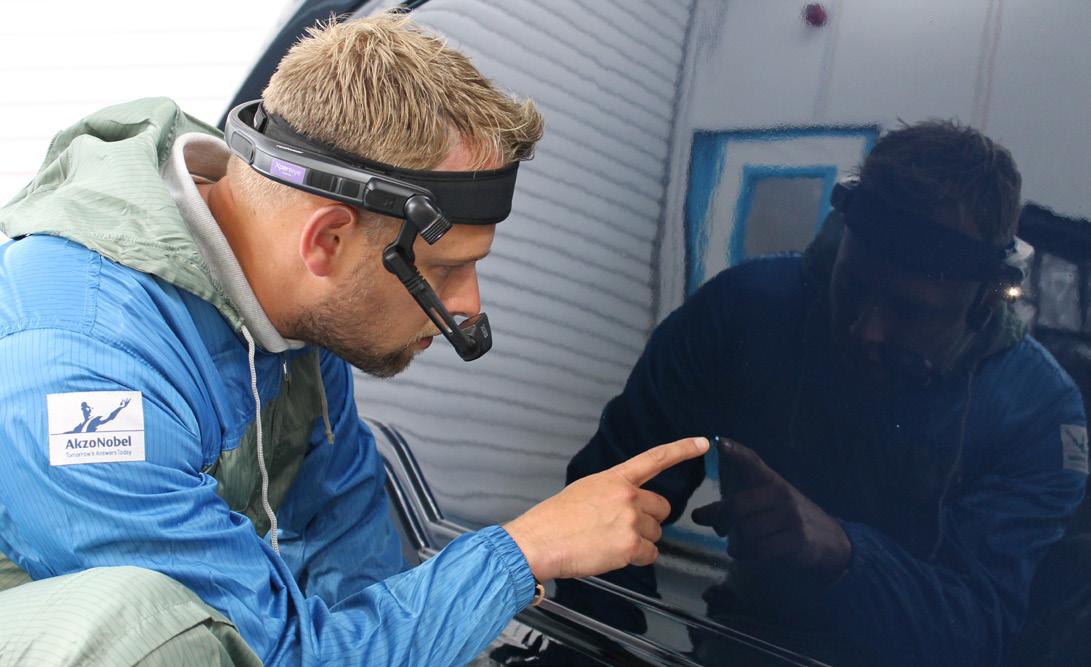
Tijssen Elektro, the yachting navigation and communication specialist, part of the Alewijnse Group, is opening a dedicated service location in Palma de Mallorca to service motor and sailing yachts of all sizes. The new facility will complement the Barcelona and La Ciotat service facilities.
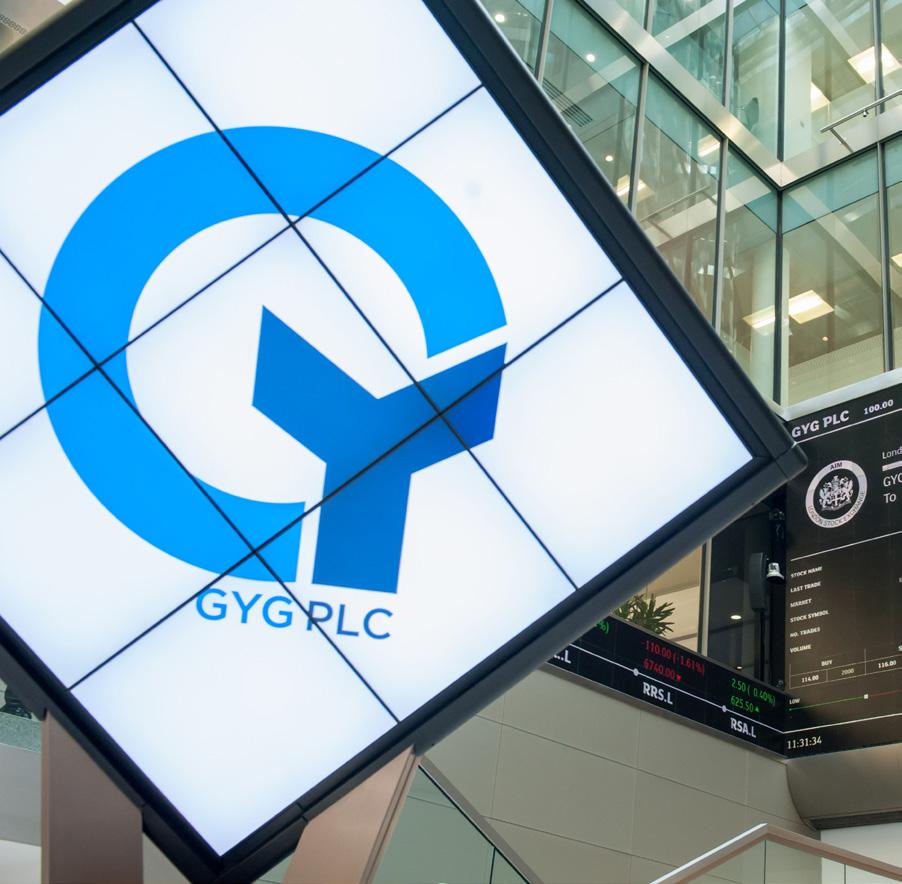
The long term partnership between MB92 and the yacht paint specialist GYG Limited has taken another step with the announcement that MB92 intends to acquire the company. GYG Limited operates primarily under the brands Pinmar, Pinmar Yacht Supply and Technocraft, and has worked with MB92 on various refits for the past three decades. MB92 announced that the decision was made in order to enhance its in-house capabilities in a competitive market and to ensure the highest quality of service.
GYG Limited will continue to operate under its established brand names, with the integration into MB92 aiming to strengthen its growth potential.
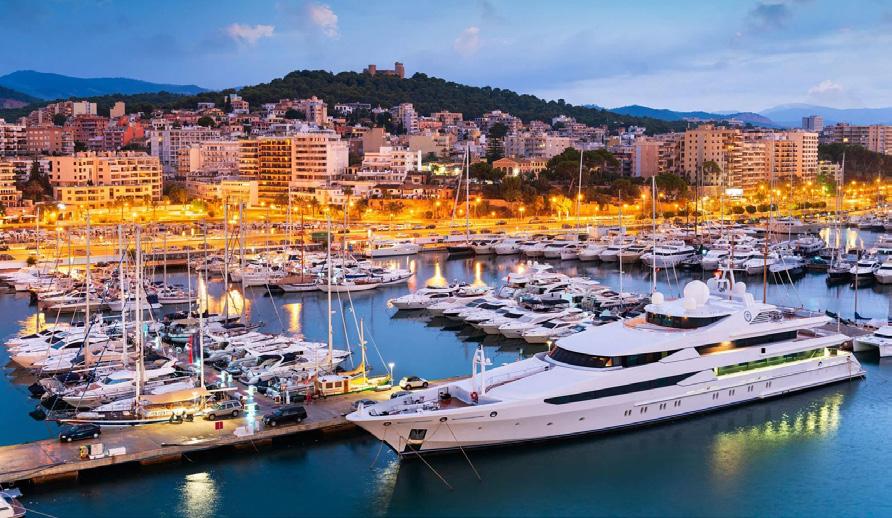
In addition, Ronald Bunders, nav-com designer and installer, has returned to the company after a period with A+T Instruments and will be joining the Palma facility. “Palma de Mallorca is the best place to provide services to large yachts, particularly sailing yachts, in the Mediterranean region,” explains Robert Brugman, General Manager at Tijssen Elektro Zeeland. “With its strategic location off the Spanish coast, there is constant demand for servicing and refits on sailing and motor yachts, with peaks in the spring and autumn. After the Monaco Yacht Show, which takes place in late September, many yachts dock in Palma de Mallorca. There they can either finalise preparations before crossing the Atlantic to the Caribbean or stay there for the winter for maintenance or larger refits. Then, in the spring, this trend goes into reverse.”

New projects in early stages of construction that present opportunities for OEMs, suppliers and subcontractors.
The explorer yacht will feature exterior and interior design, as well as naval architecture by Marcello Penna. As for accommodation, she will have six staterooms for guests and four for crew members. The owner’s suite features a private terrace that is strategically positioned on the main seck. This deck also hosts a full-beam VIP cabin, while the four guest staterooms are located on the lower deck. The captain’s suite is ideally situated on the bridge deck adjacent to the wheelhouse. Additionally, a massage room on the upper deck serves dual purposes, functioning as an optional single cabin for crew members or guests.
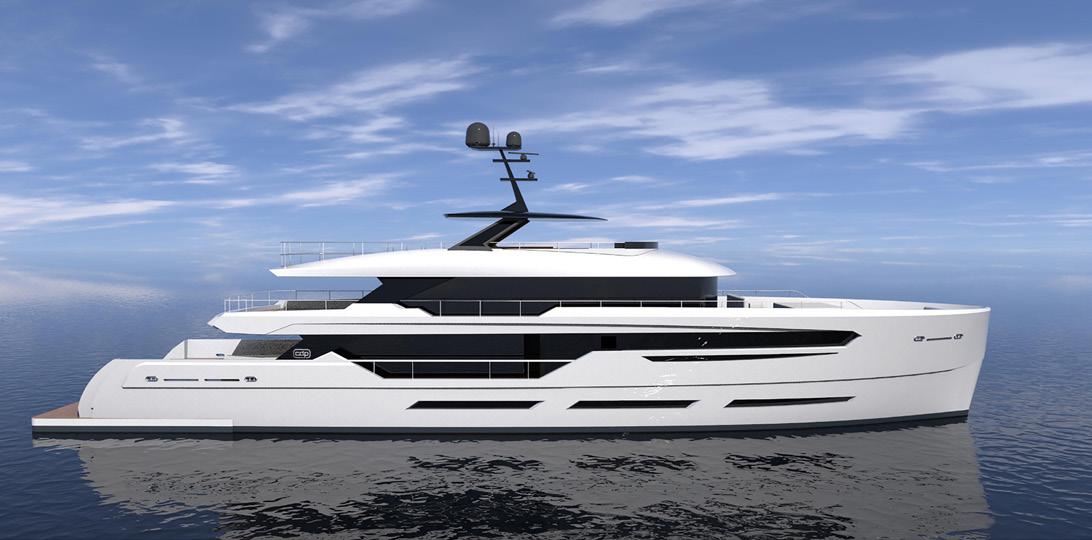
LENGTH: 37.5-metres BUILDER: Cantieri di Pisa GT: 385 GT COUNTRY OF BUILD: Italy DELIVERY YEAR: 2026
NAVAL ARCHITECTURE: Marcelo Penna EXTERIOR DESIGNER: Marcelo Penna
INTERIOR DESIGNER: Marcelo Penna
The first ISA Viper 120 motor yacht sold to an American client in July, with Zarpo Yachts introducing the buyer. With a hull and superstructure in composite with carbon fibre reinforcements, the ISA Viper 120 yacht features a sea-level beach club fitted with a multipurpose transformer serving as both a bathing step ladder and gangway. Located two side steps away is a spacious sun pad facing aft as well as a lounge consisting of sofas and a coffee table.
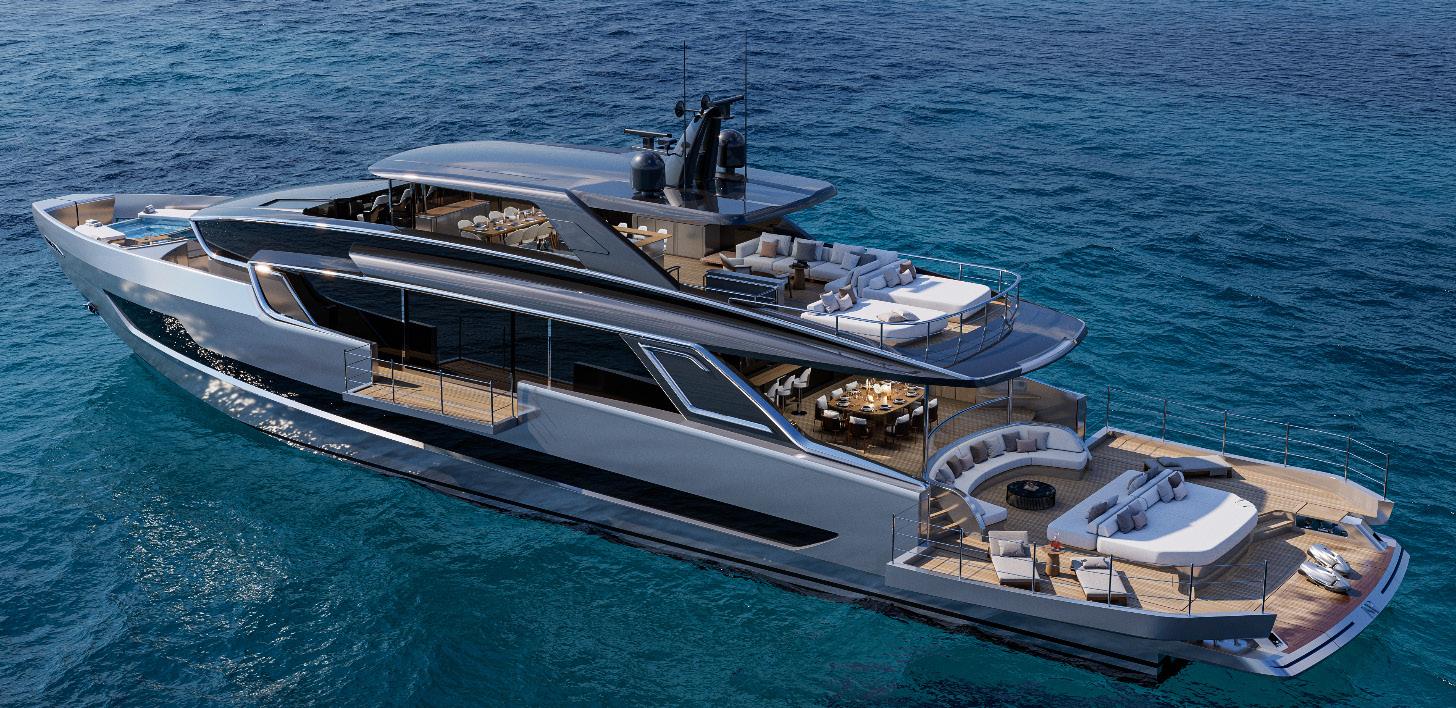
LENGTH: 37.7-metres BUILDER: ISA Yachts GT: 300 GT COUNTRY OF BUILD: Italy DELIVERY YEAR: 2026
NAVAL ARCHITECTURE: ISA Yachts EXTERIOR DESIGNER: Fulvio De Simoni
INTERIOR DESIGNER: Fulvio De Simoni
Baltic Yachts have unveiled the details of their first multihull project, a 32.9-metre blue water cruising catamaran, which was sold in June of this year. She is due to begin construction in October and will be delivered to her owner in the summer of 2027. The full carbon yacht will have the ability to regenerate electricity through her propeller when under sail and will feature pivoting centre boards that allow for exploration through shallow waters.
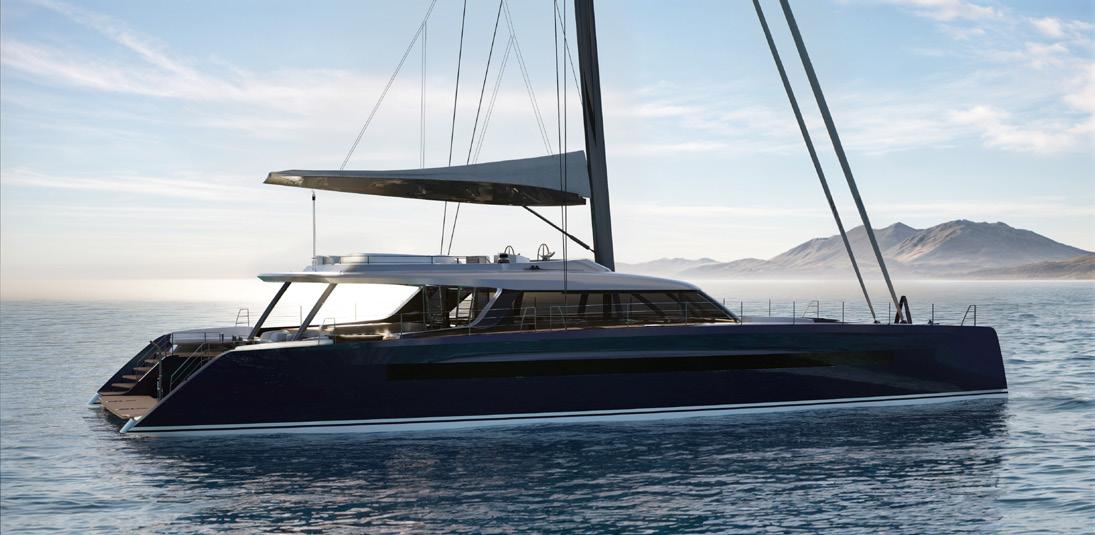
LENGTH: 32.9-metres BUILDER: Baltic Yachts GT: 250 GT COUNTRY OF BUILD: Finland DELIVERY YEAR: 2027 NAVAL ARCHITECTURE: Berret Racoupeau Yacht Design EXTERIOR DESIGNER: Berret Racoupeau Yacht Design INTERIOR DESIGNER: Jamie Bush & Co
She is the first yacht from the new Turkish that has a range of aluminium yachts spanning from 24-metres to 56-metres in length; the brand’s first 42-metre model, the GX42 RPH, is currently in-build. She will feature a hybrid propulsion, a smart hull design and solar charging. Construction of the first 42-metre GX42 is underway, as the keel laying ceremony took place on 1 June 2024, and more than 50 percent of her hull has already been welded.

LENGTH: 42.1-metres BUILDER: GX Superyachts GT: 353 GT COUNTRY OF BUILD: Turkey DELIVERY YEAR: 2026 NAVAL ARCHITECTURE: NAMES by Francesca Rogantin EXTERIOR DESIGNER: Marco Casali Too Design INTERIOR DESIGNER: Marco Casali Too Design
Announced during Cannes with the first hull sold before the show, the tri-deck explorer features a bold, yet strong exterior design, geometrical aesthetic. The yacht can accommodate up to 10 guests across a five stateroom configuration, with her owner’s suite situated on the main deck and her remaining four staterooms located on the lower deck. RAW will be powered by twin Caterpillar IMO tier III engines, with an expected top speed of 13 knots and a cruising speed of 11 knots.
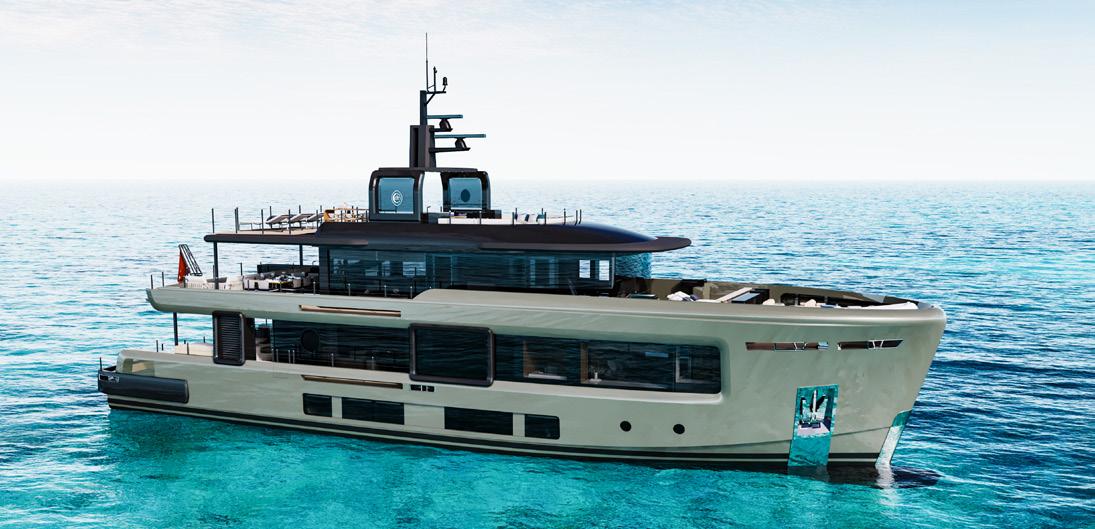
LENGTH: 31.08-metres BUILDER: CdM GT: 250 GT COUNTRY OF BUILD: Italy DELIVERY YEAR: 2026 NAVAL ARCHITECTURE: N/A EXTERIOR DESIGNER: Cassetta Yacht Designers INTERIOR DESIGNER: N/A
Project Iron Man is primarily characterised by her dedication to spacious outdoor entertaining spaces to support a multi-generational family, and allow for scenic surroundings similar to that of the family’s current Benetti yacht.

LENGTH: 80-metres BUILDER: Benetti GT: 2,050 GT COUNTRY OF BUILD: Italy DELIVERY YEAR: 2028
NAVAL ARCHITECTURE: Benetti EXTERIOR DESIGNER: Cassetta Yacht Designers INTERIOR DESIGNER: N/A
Riva’s largest ever yacht, sold in the summer and unveiled at the Monaco Yacht Show, will be delivered in 2028. The yacht has a steel hull and aluminium superstructure. Defined by her technologically advanced solutions, Riva 70 Metri will feature the latest generation hybrid propulsion, heat recovery technology and a PTO/PTI system, setting an example for ecofriendly yacht production for the Ferretti Group.
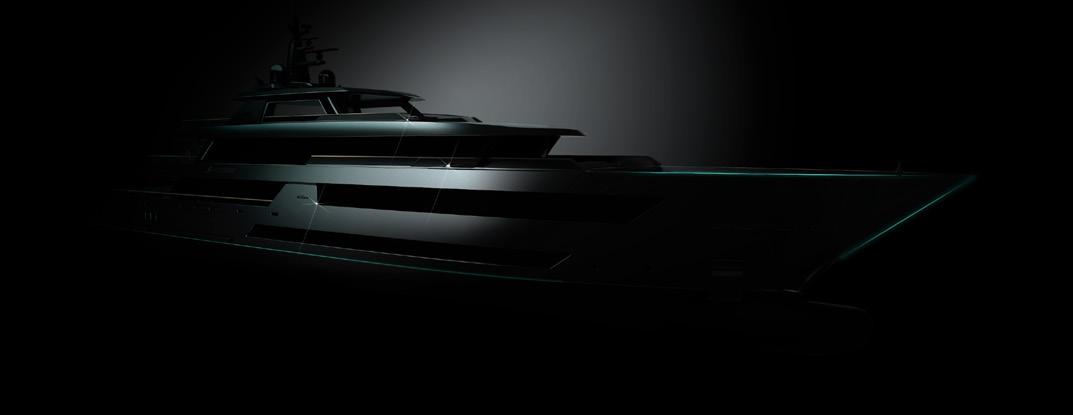
LENGTH: 70.5-metres BUILDER: Riva GT: 1,350 GT COUNTRY OF BUILD: Italy DELIVERY YEAR: 2028 NAVAL ARCHITECTURE: Riva
EXTERIOR DESIGNER: Officina Italiana Design (Mauro Micheli) INTERIOR DESIGNER: Officina Italiana Design (Mauro Micheli)

Advertisement
The marine stabilisation industry has made significant advancements in recent years, with Quick Group leading the way through its MC² brand. Andreas Karlsen, Quick Group’s Chief Commercial Officer, shares how MC² is transforming boat stabilisation technologies.
MC² originated when Quick Group acquired a small company that developed gyro stabilisers. Building on this foundation, Quick Group expanded the MC² line to include a wide range of gyro stabilisers named Quick Gyro, two series of trim tabs, Intercepta IN Series trim tabs and Intercepta X Series trim tabs, and Viator fin stabilisers. Together, these technologies create an integrated solution for yacht stabilisation, setting MC² apart in the marine industry.
The unique strength of the MC² system is its ability to integrate multiple stabilising technologies. Whether the yacht is in motion or at anchor, the system uses AI-driven algorithms to anticipate and adjust to changing conditions, optimising fuel efficiency and overall performance across the three stabilisation methods.
Karlsen emphasises the main advantage of MC² lies in its integration: "Our goal is to make gyro stabilisers, interceptors, and fins work as a unified system," he says. “Unlike competitors, MC² is the only system that combines all three stabilisers, resulting in better performance and smoother boating, aided by advanced algorithms and artificial intelligence” and continues "When interceptors, gyros, and fins work together, the result is a significantly improved experience. Our algorithms ensure all systems communicate and respond as one, enhancing stabilisation and efficiency."
This approach addresses the growing demand for integrated solutions rather than standalone technologies. Since the launch of the first Quick Gyro stabilisers in 2017, interest in MC²’s system has increased among customers seeking comprehensive systems for both refits and newbuilds. The integration of these technologies not only improves stabilisation but also enhances fuel efficiency and vessel performance.
A key innovation in the MC² line is its interceptor technology, which has two ranges: the Intercepta IN Series trim tabs and the Intercepta X Series trim tabs. The IN series is designed for easy installation and it has an integrated electric actuator, while the X Series allows for customisation in size, making it ideal for bespoke builds and the motor is mounted inside the hull.

A standout feature of the MC² Intercepta is its versatility in standard or custom installations depending on the series chosen, designed specifically to provide more installation options. For production shipyards, the IN Series offers a straightforward, easy-to-install solution. In contrast, the X Series is fully customisable, both in length and in engine position, catering to the specific design and performance needs of larger or more complex vessels.
"In large-scale production, the MC² Intercepta Series provides a consistent and reliable solution," says Karlsen. "For high-end, custom yachts, the X Series is customisable to meet the exact requirements of each vessel."
The official mass-market release of the MC² Intercepta is planned for late 2024, following months of extensive testing and final refinements. While still in development, the product has already attracted significant interest from the marine industry.
"Since we introduced the MC² Intercepta at the METS Trade Show, we’ve seen a lot of excitement from the market," says Karlsen. "There’s real demand for integrated systems, and we’re eager to launch a product that will enhance vessel performance worldwide."
Quick Group's dedication to quality is reflected in its thorough testing process. The company owns two demo boats, a Nimbus T11 and a Falcon 80, where they rigorously test all MC² systems in real-world conditions. This ensures the products meet the highest performance and reliability standards.
"Testing is critical for us," says Karlsen. "We don’t just rely on internal evaluations; we work closely with customers, whose feedback helps us refine and improve our products."
Quick Group's MC² line stands at the forefront of marine stabilisation technology, offering an integrated solution combining Intercepta trim tabs, Viator fin stabiliser, and Quick Gyro Stabilizer. With a strong focus on innovation, customisation, and system integration, the MC² brand is set to revolutionise the marine industry.
To find out more: https://quickgroup.com/mc2/
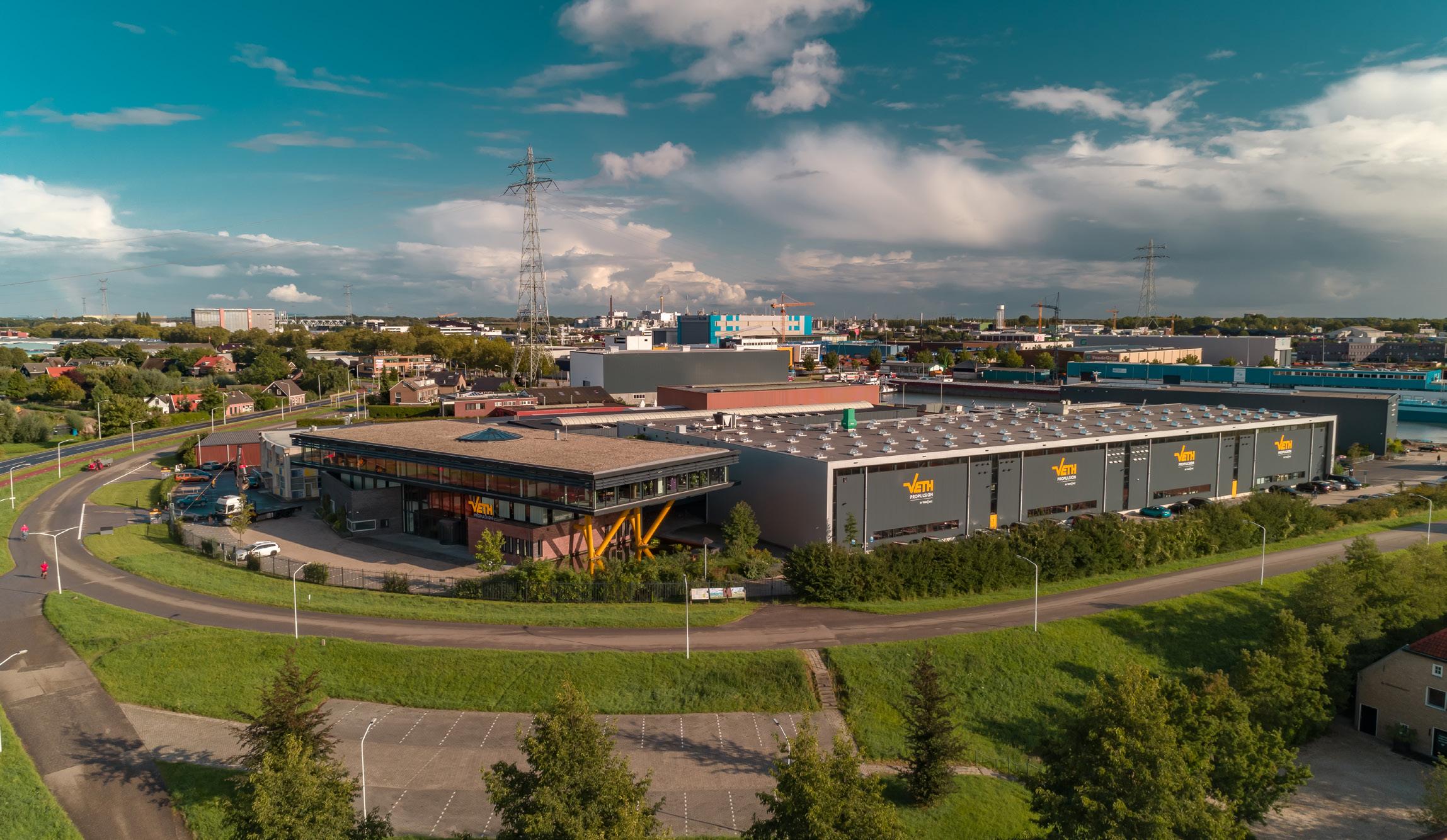
Specialising in azimuth thrusters, bow thrusters, and control systems, Veth Propulsion in the Netherlands has become a trusted name in the maritime sector by offering custom-engineered propulsion solutions. Founded in 1951 and acquired by American firm Twin Disc in 2018, Veth has expanded its global reach, working across multiple sectors including yachting, inland shipping, and offshore services. The luxury yachting segment, however, accounts for 1520% of the company’s business. Diesel-electric superyachts equipped with Veth thrusters include Rossinavi’s 59.4-metre Akula, Admiral’s 75-metre Kenshō, and Feadship’s 84.2-metre Obsidian
At the 2024 Monaco Yacht Show, Veth Propulsion showcased their ELITE™ thruster series, its latest range of thrusters designed to meet the needs of superyachts.
The 360° thruster combines Veth’s Contra Rotating technology, Rolla's class S propellers with the successful Integrated L-drive thruster, distributing power between two propellers, reducing the overall diameter and minimising noise and vibration – two key concerns for yacht owners who prioritise comfort and quietness onboard. The thrusters are compatible with yachts from 30-120m+ and have a power output range from 150 up to 2000 kW per thruster. On top of that, Veth is exploring the possibilities for a bigger model, providing 2800 kW per thruster.
“We have adapted and refined a concept we've successfully utilized for decades in commercial applications—our contra-rotating propellers—to specifically meet the performance and noise reduction standards of the yachting industry.” says Navneet Chadha, Veth’s R&D hydrodynamic engineer. While not exclusive to Veth, this contrarotating propeller system is what differentiates its thrusters, with the configuration improving thrust efficiency by reducing the rotational energy in the water flow that is typically lost in conventional single-propeller thrusters. This results in a more efficient propulsion system, particularly at higher speeds, while the CFD-optimised strut and customised propellers enhance overall efficiency.
Veth’s commitment to reducing onboard noise has been a key driver in the development of the ELITE™ thruster series. This was made possible, in part, through a collaboration with Rolla SP Propellers, a leading manufacturer of propellers that meet the stringent "S" Class

over Underwater Radiated Noise (URN) and its effects on marine ecosystems. The company is actively investigating its Elite systems to ensure they operate quietly, both onboard and in the surrounding waters, reducing their environmental impact.
"We have undertaken comprehensive testing, including both simulations and real-world trials," says Navneet. "Our thrusters have been thoroughly model-tested at several leading European research institutions and are now undergoing validation on full-scale yachts. Additionally, we have carefully compared the results from our simulations with actual performance data gathered from these trials to ensure accuracy and reliability."
Unlike the commercial marine sector, yachts have unique demands in terms of available space for technical areas, more so now that beach clubs have become a staple of yacht design, limiting the volume available for the technical deck below. The ELITE™ thruster series has been specifically designed with a compact build-in height to free up space.
Looking ahead, Veth is investing in real-time monitoring and optimisation systems working closely with owners’ teams regarding noise and vibrations. These optimisations have resulted in the minimisation of pressure pulses caused by the rotating propeller blades as they pass near the hull of the vessel, which are one of the main causes of noise and vibration. Known as "hull-excited vibrations," Veth’s research engineers have also optimised the shape of the propeller and components, such as the headbox, to reduce these pulses, resulting in quieter operations.
With a commitment to providing bespoke solutions, Veth Propulsion works closely with designers, naval architects, and engineers to ensure its products meet the unique requirements of each yacht. This approach enables the company to offer customisable options, from propulsion power to aesthetic considerations.
In response to the growing focus on sustainability, Veth Propulsion has also been working to integrate electric technologies into its product range. “As hybrid propulsion becomes more widespread,” says Simon Langstraat, teamlead sales at Veth, “Veth thrusters are designed to integrate with a range of power sources – from diesel-electric to emerging hydrogen and methanol systems that may become standard in the future.”
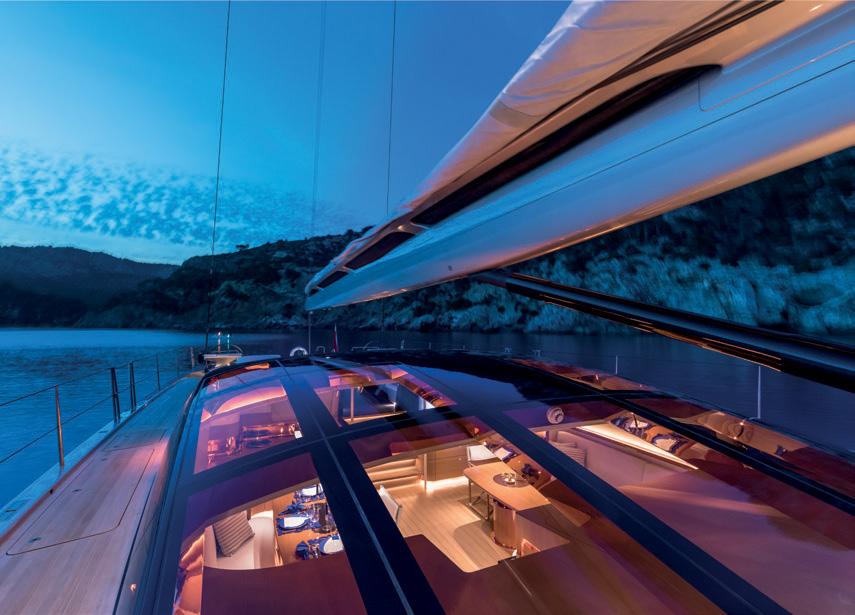

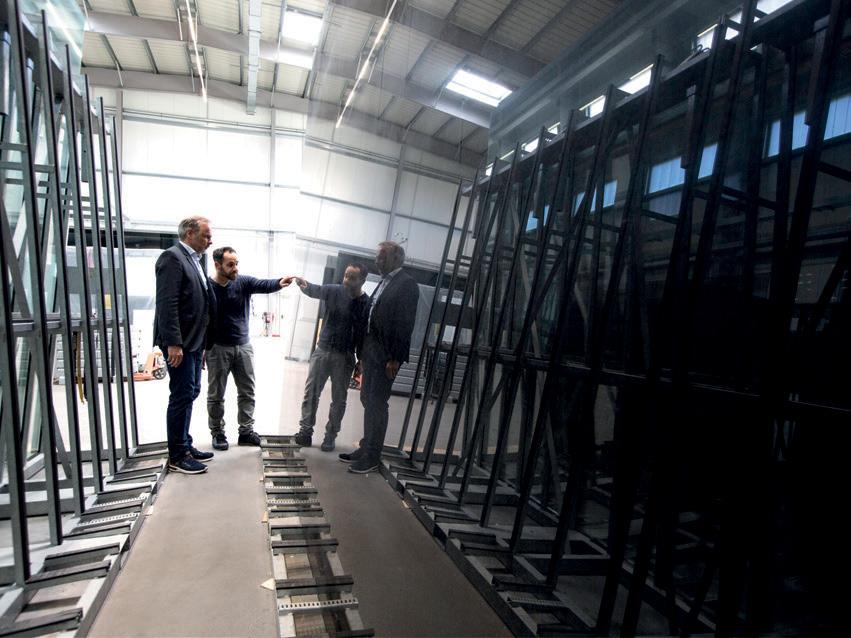



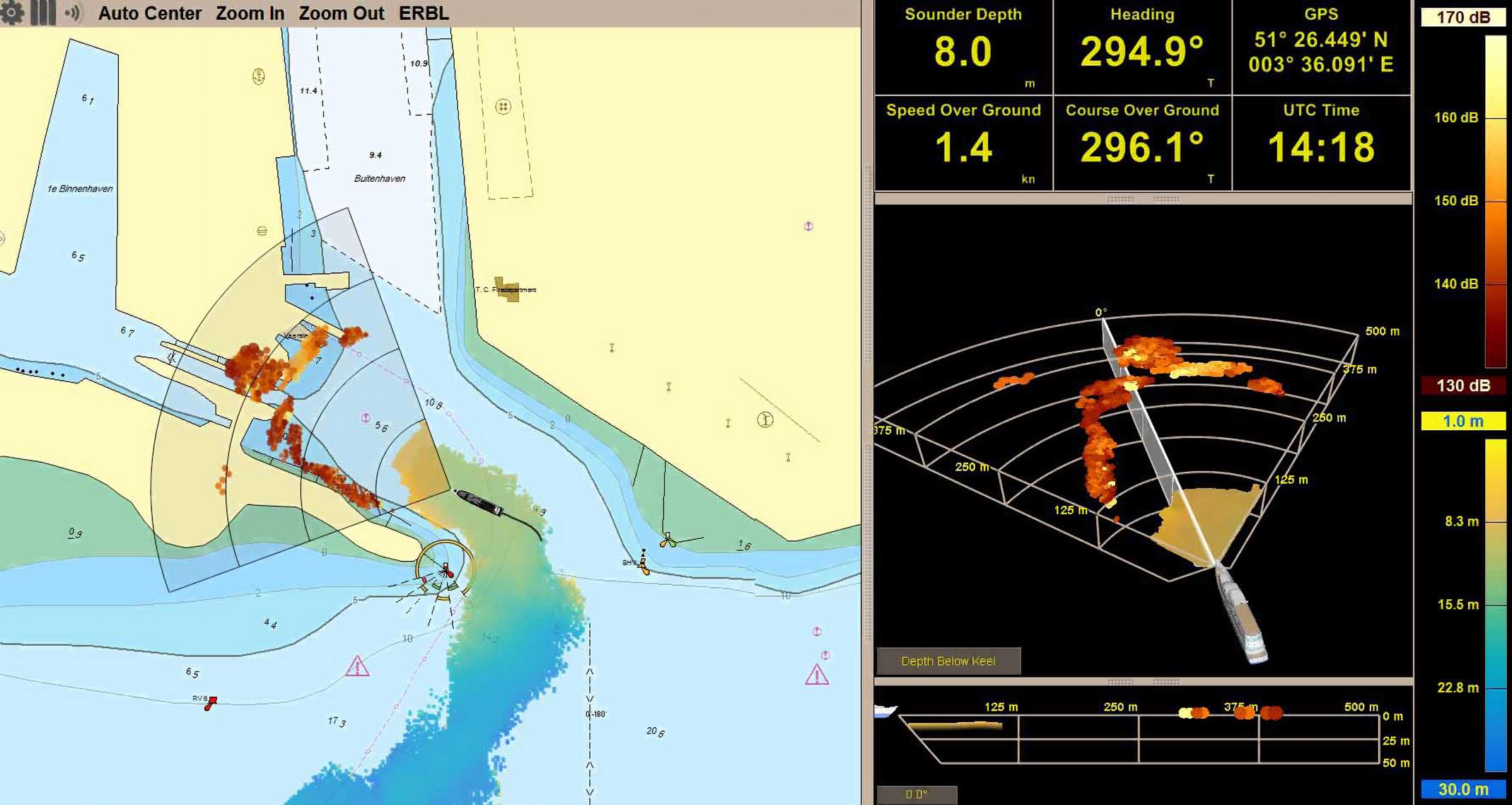
Rhode Island-based sonar technology developer FarSounder set out with the mission to reduce whale strikes by yachts and superyachts. Over the last 23 years it has expanded the scope of its capabilities, recognising the value of Forward Looking Sonar (FLS) in uncharted or poorly charted regions. CEO Matthew Zimmerman shines light on how the technology has developed.
BY FRANCESCA WEBSTER
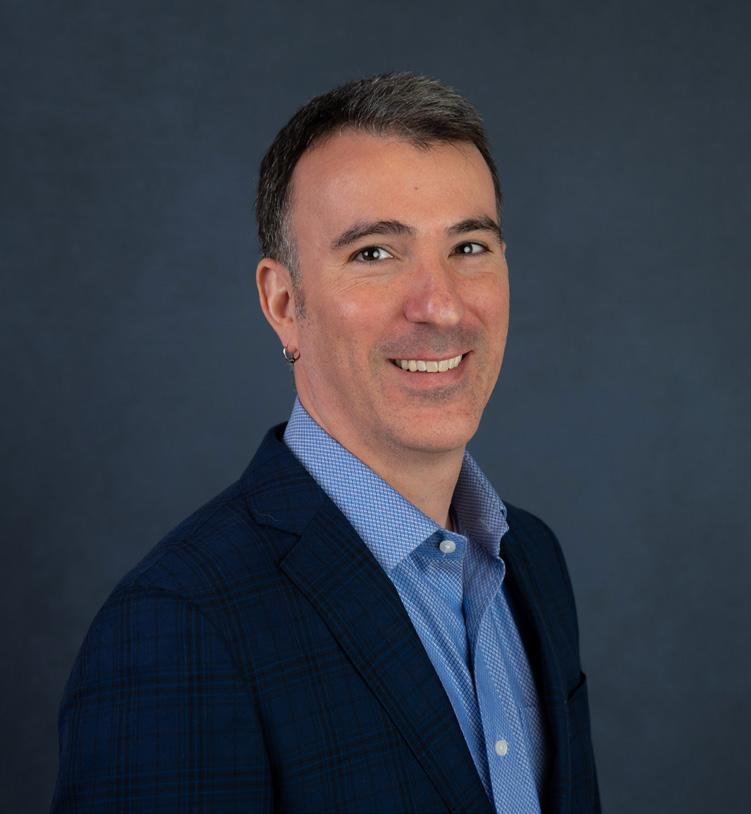
What was the origin concept of FarSounder?
During my university studies there was a major oil spill incident caused by a barge hitting a rock near Rhode Island, and around the same time I became aware of the high number of whale deaths being caused by ship strike. I began to think that there must be a technology to prevent vessels from hitting rocks and whales, but after reviewing the market discovered that there was no existing product designed for that application. Vessels have many sensors onboard – GPS, radar and depth sonar being the most common – none of which give you accurate real-time information about transient objects or shifting underwater scapes such as sandbanks. So we set out to develop a product that filled that gap.
Did you lean on pre-existing technologies when developing the FarSounder FLS?
It was more complex, more expensive and took longer than we initially thought. Globally there are very few individuals with expertise in sonar and marine acoustics development outside of the military and academia. Even then, most of the developments are incremental changes to legacy systems, but no one ever set out to use sonar to solve issues relating to shallow-water navigation. Everything had to be developed in-house, from circuit board design, software development and engineering to firmware and the mechanical design of the products. We contract manufacture of all of the components from US suppliers, but do all of the final assembly and testing in-house. Although the company was founded in 2001, we didn’t start supplying our products until 2005, which tells you a bit about the complexities.
What is the sonar made from and how is it installed on yachts?
We offer three different models, and their sizes vary based on the model. Our largest model, which has the longest range, features a transducer array that's approximately 9 inches tall and 14 inches wide. The housing for this model is made from 316 stainless steel, a strong and durable material that’s also quite expensive. We chose this material because we want to create ship-grade equipment, not recreational or cheap plastic products, for robustness and long-term reliability. Inside, we use standard off-the-shelf electronics similar to what you'd find in cell phones, but they’re integrated into custom-designed circuits and boards. These boards are assembled in the US and shipped to us for testing and final assembly. The transducers, which convert acoustic energy into electrical energy, are made from ceramic – an industry standard for marine acoustics.
How long does it typically take to retro-fit one of your systems?
The installation process can be relatively quick, especially when compared to something like hull painting, which requires weeks of planning. For instance, on a commercial vessel, we've seen installations completed in as little as 48 hours, from cutting the metal to launching the boat. For a yacht refit, we’ve had installations done in about three days. While it may not be as visually polished as a longer installation, it is fully functional and gets the job done without being highly disruptive during the refit process. Integrating the fairing onto the hull is key so as not to interfere with the vessel’s performance.
FarSounder is a partner of Seabed 2030 to better map the seabed – how do you protect yacht privacy?
We’ve been contributing in two ways. For the past five or six years, we’ve sent USB hard drives to select customers who are interested in collecting data. This helps us improve our algorithms by gathering data from various environments and vessels, and it also enables us to troubleshoot any issues they may encounter. Some of these customers allow us to contribute their data to Seabed 2030.
About six months ago, we launched a pilot program to share data anonymously across our FarSounder fleet. This allows us to create an aggregated map of the seabed data and contribute it anonymously on behalf of our users to Seabed 2030. Importantly, the data is stripped of any identifying information – it only includes a unique randomised ID tied to the sonar, not to the vessel itself. The truth is, with AIS and satellite tracking systems, it's almost impossible to fully obscure a vessel’s location anymore, so the concern about FarSounder’s data revealing a boat’s location is somewhat outdated.
What other types of data are you collecting and contributing through this program?
In addition to bathymetry (sea floor depth), we’re soon launching new functionality to allow our users to contribute other valuable data, such as whale sightings and floating trash observations. We’ve already set up the cloud service that connects depth measurements through our servers for Seabed 2030, so we thought, why not facilitate the collection of other meaningful data? For the trash observations, we’ll be passing the information on to Eyesea, a nonprofit focused on mapping marine debris. It’s an exciting way for our users to contribute to the global understanding of marine ecosystems.

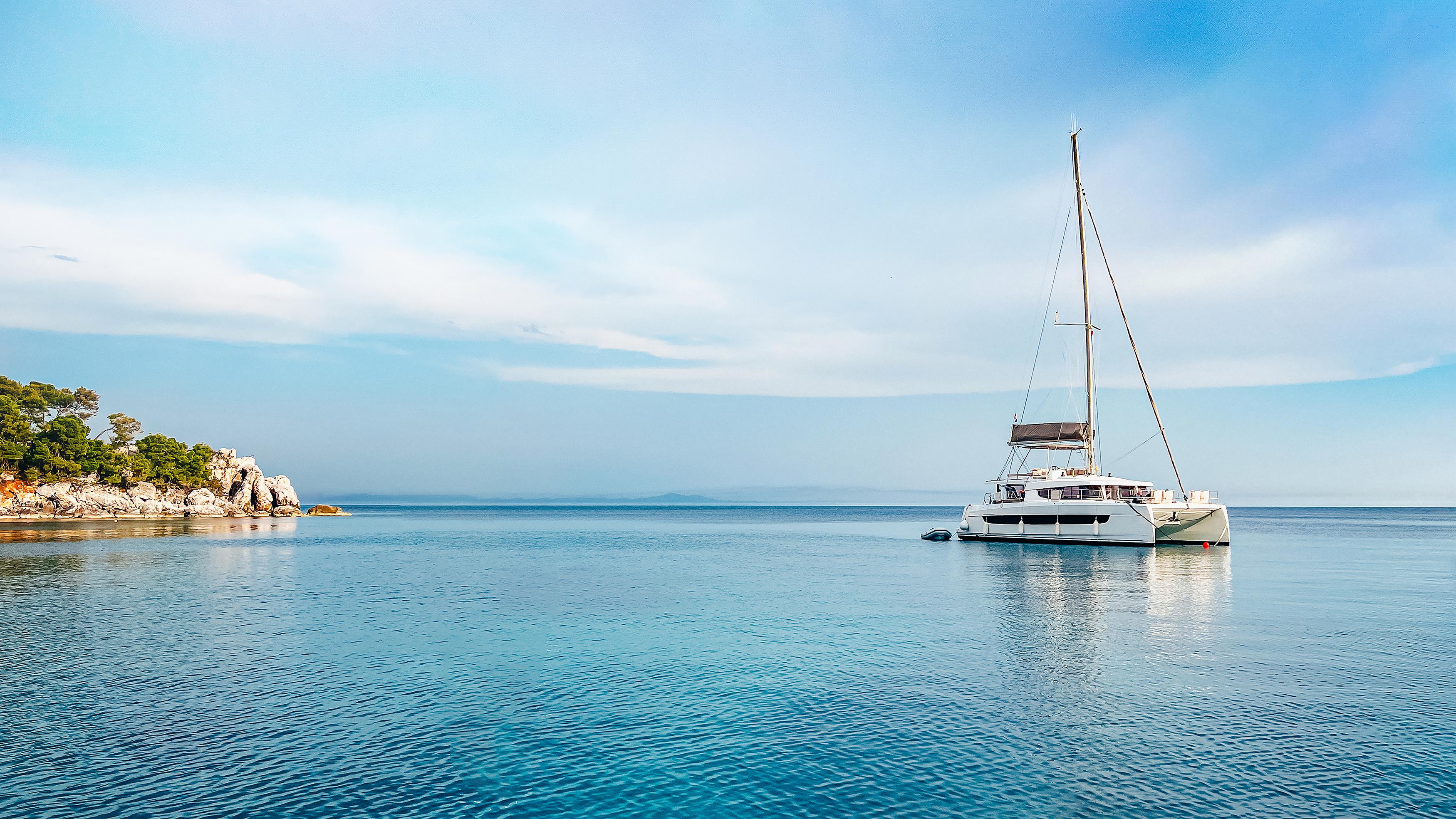
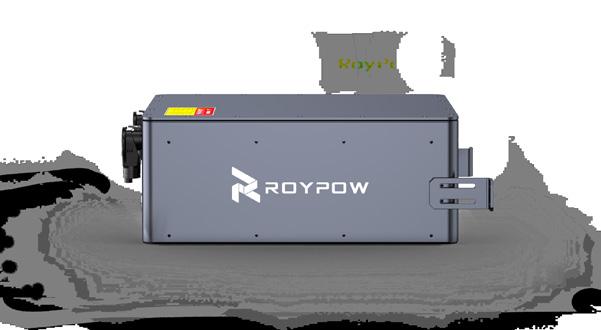
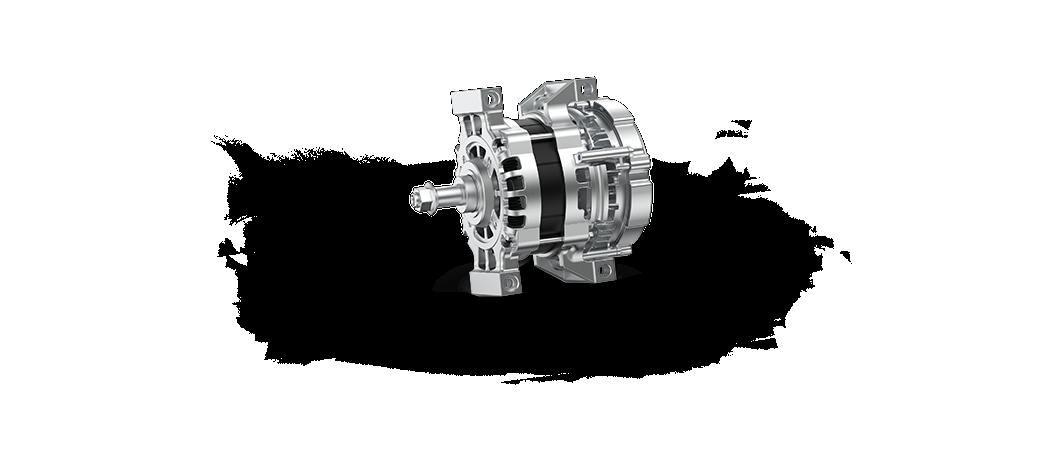
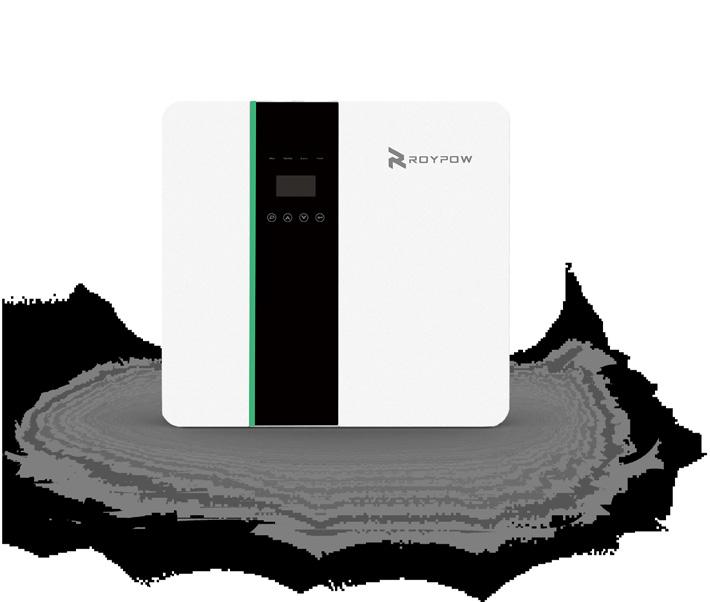
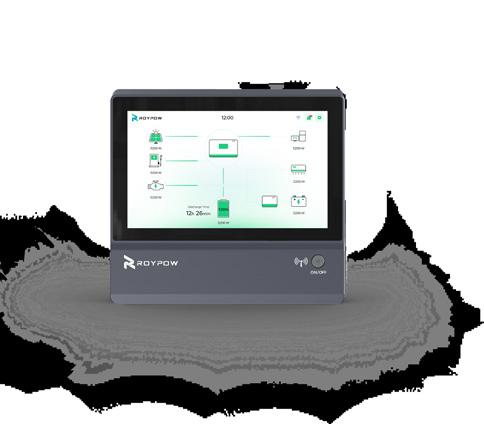
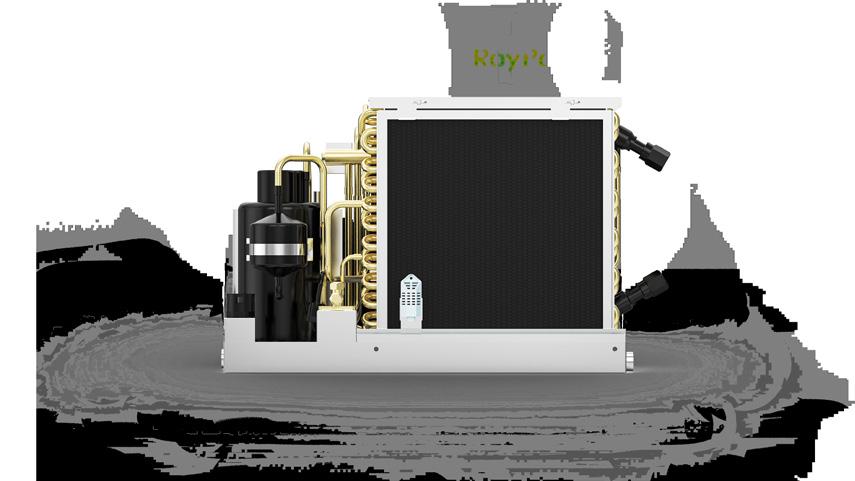
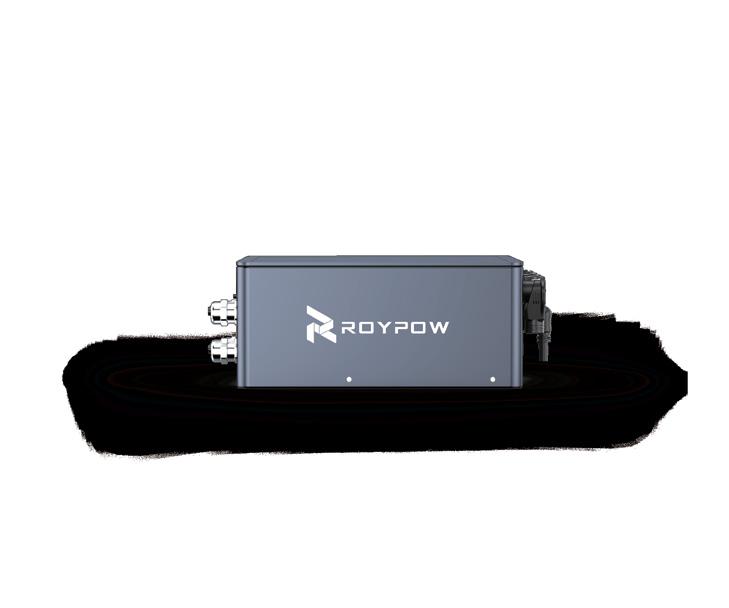
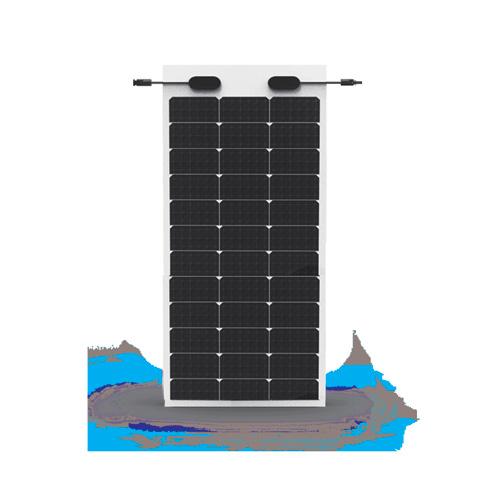
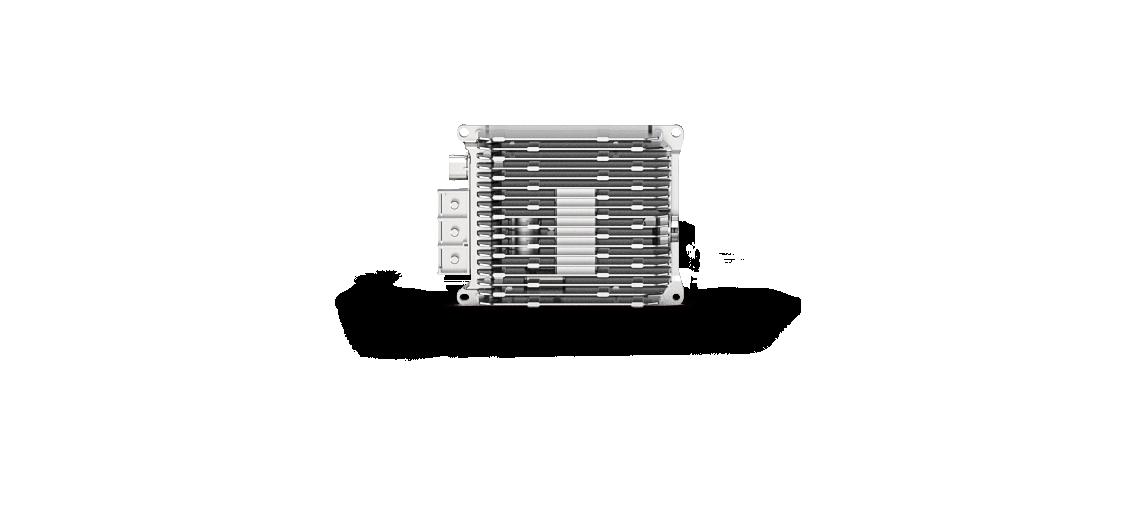






Asian superyacht shipyards have become a force to be reckoned with and Taiwan is the region’s leading producer. Just prior to the start of the inaugural Asia-Pacific Superyacht Summit in Hong Kong last June, we travelled to the Taiwanese city of Kaohsiung to visit Ocean Alexander, which regularly figures among the top 10 superyacht builders.
BY JUSTIN RATCLIFFE
The story goes that Ocean Alexander was born when founder Alex Chueh was approached by a close friend seeking financial assistance for his failing shipyard. Apocryphal or not, from humble beginnings as a small boat builder in 1978, Ocean Alexander is now among the best-selling superyacht brands in the US. At the same time, it has helped to establish Taiwan as a yacht production powerhouse.
The US has been Ocean Alexander’s primary market since day one. In fact, although its yachts have long been built in Taiwan, the brand’s corporate headquarters were originally in Seattle, a city that has always had strong trading links with Asia, and the US head office is still based there. Around 85 percent of production goes to the US and just shy of 20 yachts were delivered to American customers last year, with six sales in the last quarter alone. Nearly all the rest finish up in Australia.
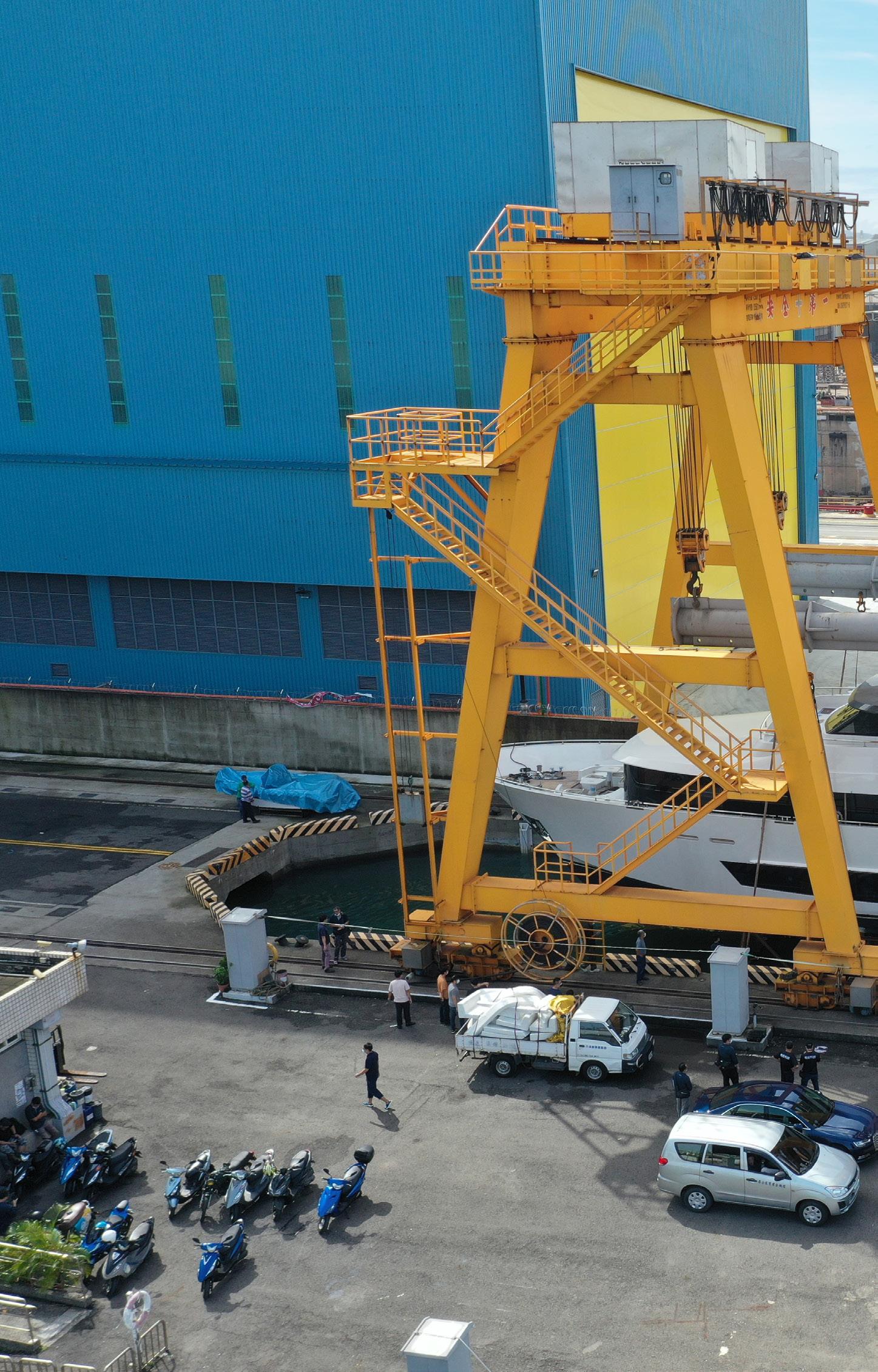

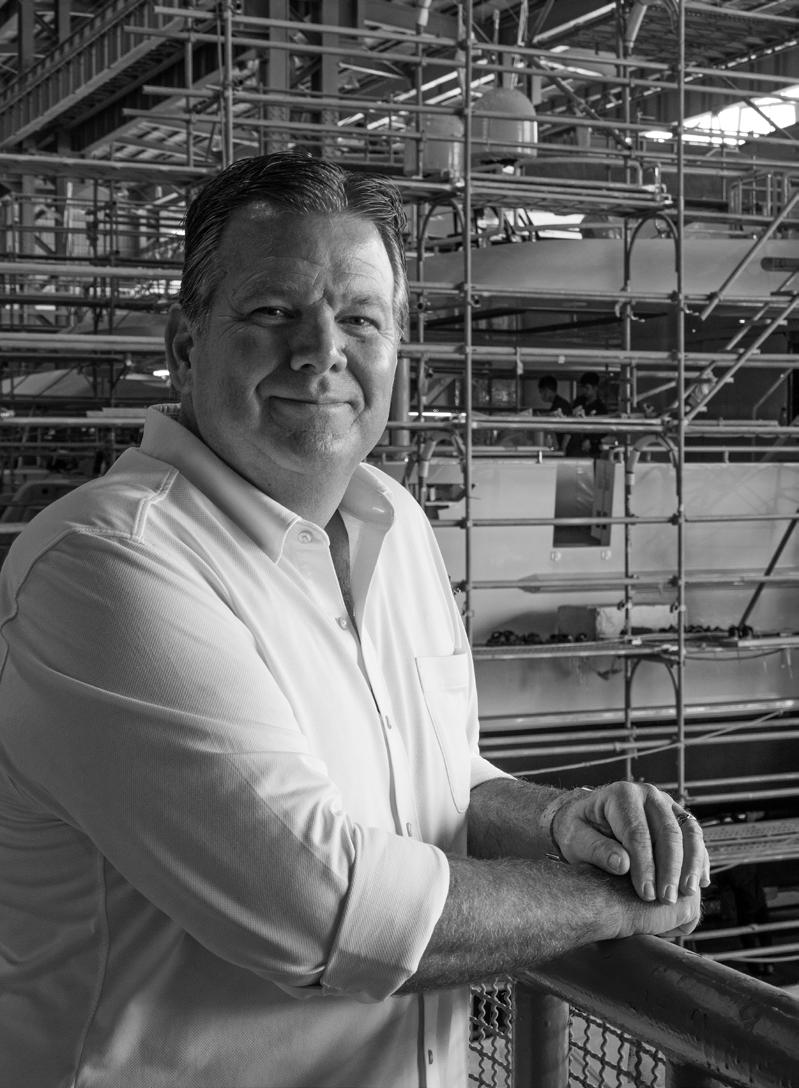
“The past two decades have been our period of most consistent growth,” says Dan Mundy, Ocean Alexander’s head of global operations. “That really coincides with two tipping points in the company’s history: Johnny Chueh taking over the reins from his father, and the launch of the first Ocean Alexander 100.”
Perfectly at home in both Asian and Western cultures, Johnny Chueh studied finance and economics in Australia and the US. In the early 2000s he set about restructuring the company along industrial lines. The Ocean Alexander 100 designed by London-based Evan K. Marshall built on the success of its 90-foot predecessor and marked the brand’s entry into the 30-metre-plus segment when it was introduced at the 2014 Fort Lauderdale International Boat Show. It was followed by a 112 and 120-foot series.
“This was all part and parcel of a wider expansion drive,” continues Mundy. “The market was changing, motoryachts were becoming bigger and bigger, and the company focus was anticipating the future market trends and preparing to move in a new direction. We realised we needed to expand our distribution out of Seattle and the Pacific Northwest. We already had a dealer in California – and the Great Lakes region for a time – but now we wanted representation in Florida to become a coastto-coast concern.”
Ocean Alexander became part of the parent company Alexander Marine International and the outlets it owned on the West Coast were rebranded as Alexander Marine USA. MarineMax became the exclusive East Coast dealer for Ocean Alexander yachts and in 2017 Alexander Marine USA acquired MarineMax’s San Diego office (for MarineMax, the dealership meant it could enhance the diversity of its offering by introducing larger yachts to its small to medium-sized product portfolio). Ocean Alexander then set up its own strategic service and commissioning centres on both coasts.
“The difference between manufacturers and retailers is always an interesting one,” says Mundy. “The manufacturer thinks they can do some things better than the retailer, and the retailer thinks the same about the manufacturer. But we just said to MarineMax, ‘Tell us how you see the the needs of the market’, and since that collaboration started we have seen an absolute spike in sales of around 50 percent.”
That surge has been helped by progressive expansion of the Kaohsiung facilities to increase production capacity and sales have now stablised at pre-Covid levels following the post-pandemic peak. Construction of a new state-of-the-art facility adjoining the current main assembly site is due to start shortly that will further boost production and enable projects over the current 40 metres.
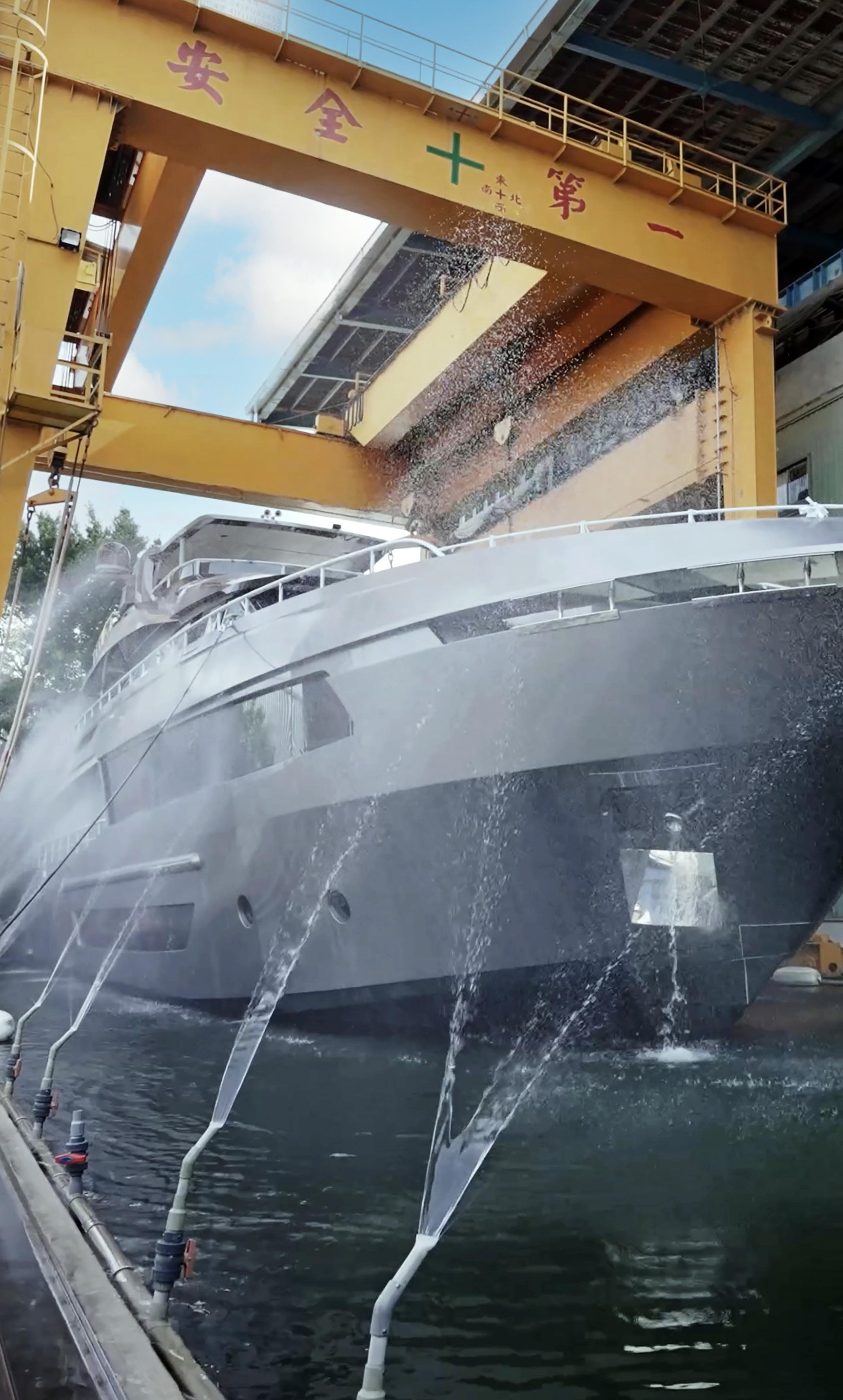
“We study data, we study the industry, we study the market, and that serves to really have our finger on the pulse.”


Facing page: Checking windows and seals for watertightness in the yard’s test tank.
Below: 20 yachts were in various stages of construction at the time of our visit.
Bottom: A 30R ready for delivery.
As a semi-production builder, Ocean Alexander manufactures pre-designed models with customisable features and takes a very methodical approach to what might be interpreted as market trends – Mundy calls it responding instead of reacting to the marketplace. In practice this means that it can ramp up or slow down production of certain models quite quickly without disrupting production schedules.
“We study data, we study the industry, we study the market, and that serves to really have our finger on the pulse,” says Mundy. “What we’ve learned over a long period of time is that a saturation point does not lead to a termination; it only leads to a reduction. As soon as the market starts to feel that reduction, demand goes up again because of scarcity. So we’re responding to these trend cycles more than we’re reacting to them.”
At the time of our visit, there were 20 yachts on the factory floor at various stages of a 16 to 19-month build cycle. All were ‘sold’ in the sense that they have a first client, which may be MarineMax, Alexander Marine USA or Alexander Marine Australia.
About a quarter of those units had a final customer already signed up, a figure that may be as high as 60 percent by the time the yachts are completed. Conversations with owners usually happen within the last 12 months after hull and deckhouse have been connected, but still in time to let clients put their personal stamp on the interior. Each yacht goes through full quality controls and sea trials before leaving the factory in Kaohsiung. The interior is then dismantled, wrapped for protection and stowed on board for transport to the US or Australia, where it will go through another six-week commissioning period. This effectively means the whole QC process is carried out twice.
Some semi-custom builders offer more than one layout, but Ocean Alexander prefers not to mess with general arrangements as it makes it harder to stick to production schedules and can lead to further customisation requests. Instead, it aims to utilise the same spaces in different ways by taking stock of customer requests and engineering alternative iterations into the initial design. Mundy recalls one customer for a 27R who wanted a second master suite, for example. The layout already provided for two VIP cabins forward of the engine room, which could be easily turned into a full-beam master stateroom without any structural modifications.
“We’re not putting the information out there that, hey, we’ll do anything you want us to do,” he explains. “We’re pre-thinking what somebody might want and we can affect those changes well into the production cycle, which again speeds up the whole process. In the past five years I can think of just one example where we reconfigured bulkheads for a client.”
Although yachting in Asia-Pacific is on the rise, the region is not a market for Ocean Alexander. This is largely explained by the difference in usage between American
and Asian owners. Americans are often owner-operators who undertake long-range voyages, racking up hundreds of hours on engines and generators (last June the San Juan archipelago off Seattle hosted Ocean Alexander’s annual West Coast Rendezvous attended by yachts that travelled from far and wide to get there). It stands to reason that they appreciate sturdy construction, quality engineering, plenty of living and storage space, and comfortable but functional interiors – features that resonate less with Asian owners who are more inclined to take short day trips, or even enjoy the boat without leaving the marina.
“We build in Taiwan, but we use American thinking behind our construction methods and remain focused on the dominant US market,” Mundy told the audience during the Asia Pacific Superyacht Summit in Hong Kong. “As we expanded our distribution opportunities and the service side of the industry, we just found ourselves completely consumed. So we’ve been fortunate to never have a moment in time where we’ve had to stop and say, okay, where’s the broader market? Where do we begin to expand further?”

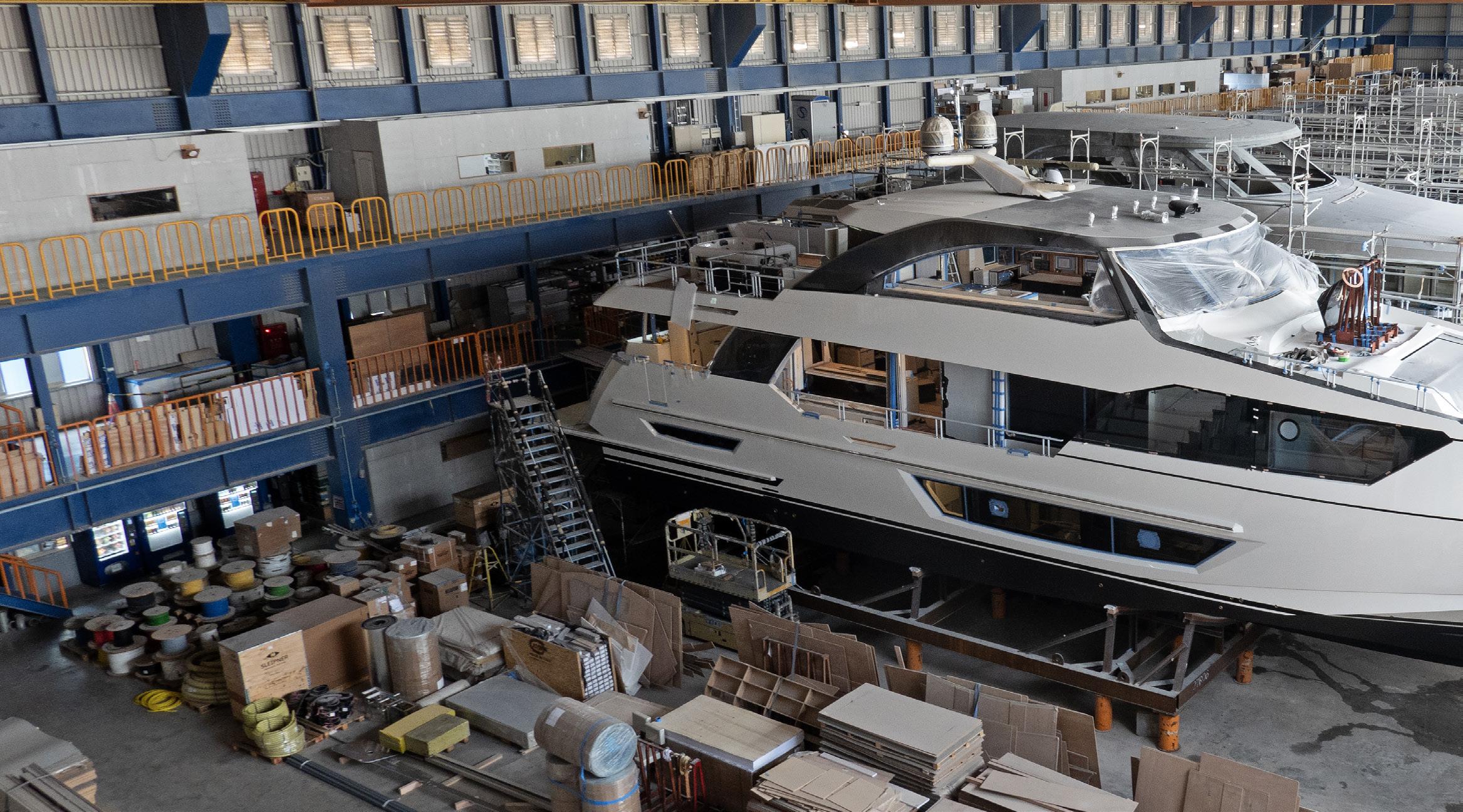
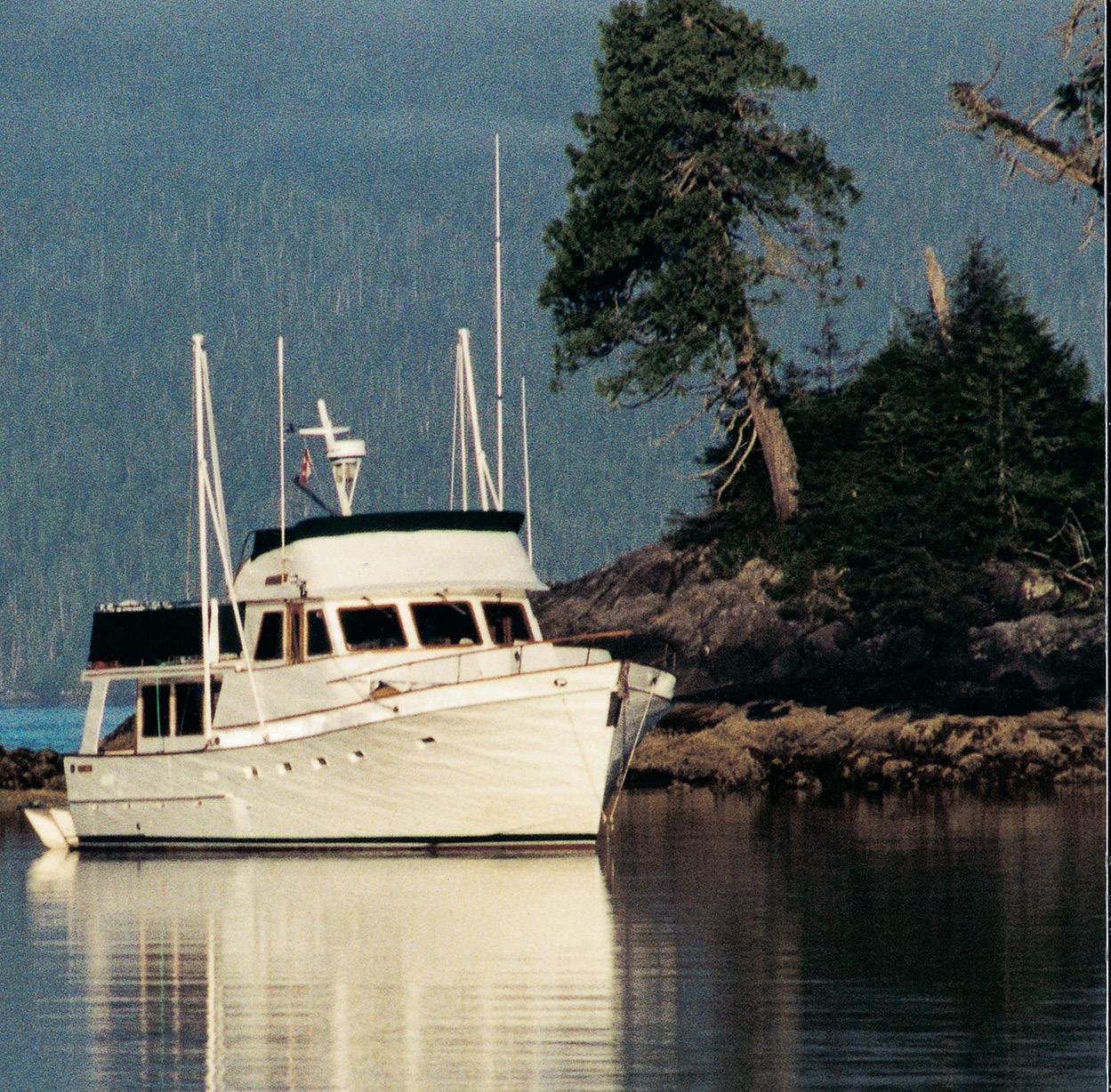
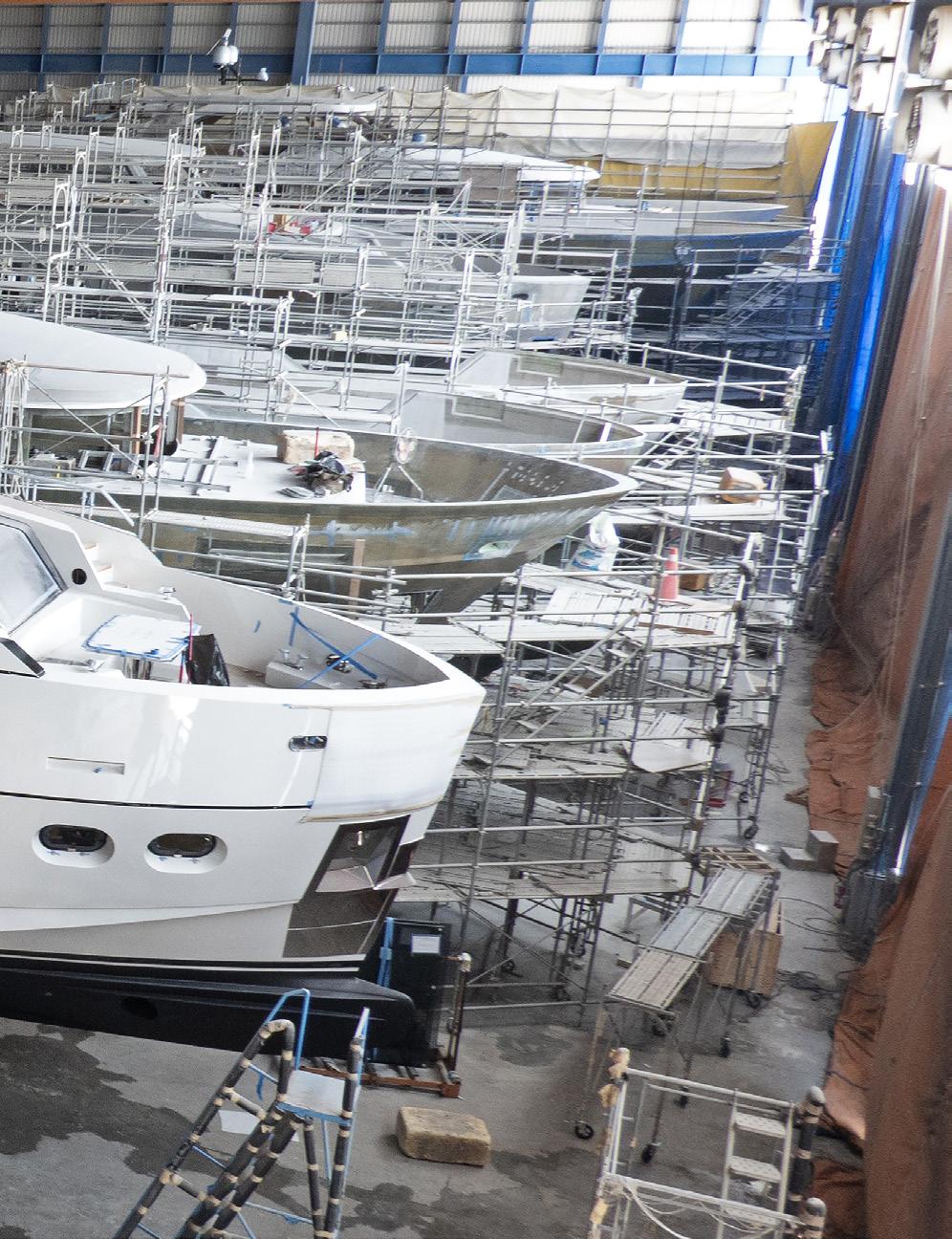
According to the Asia-Pacific Superyacht Market Report 2024 prepared by SYT iQ, as of the start of 2024 builders from AsiaPacific (including Australia and New Zealand) accounted for 509 out of 5,787 operating yachts over 30 metres in the world, a share of 8.8 percent. Of those 509 yachts, 163 were built in Taiwan. If we then look at developments over the last 10 years, the share of builders from the region has gone up to 9.9 percent, as Asia-Pacific builders delivered 159 out of 1,604 yachts completed between 2014 and 2023.
The region is now in second place after Europe, as the role of North American has declined and Taiwanese builders in particular took over a large part of the US market for motoryachts up to 40 metres. Of the 659 superyachts over 30 metres under construction as of mid-May 2024, 40 yachts (6 percent) are under construction in AsiaPacific countries: 23 in Taiwan, 13 in China, and the remaining four spread over four other countries.
Founded by Alex Chueh in Seattle, Ocean Alexander specialises in building fibreglass superyachts from 27 metres up to 40 metres (soon to be 45 metres). Of six production sites owned by the company in the city of Kaohsiung in southwest Taiwan, four are active in front-end manufacturing and two are responsible for back-end assembly (a yard in China that was building smaller yachts closed in 2013). A new facility adjoining the main assembly site in Kaohsiung represents an investment of more than US$60 million and is expected to be operational next year.
Supported by its retailing partnership with MarineMax, over the past decade the brand has broadened its presence to Florida and the East Coast, but also Australia with an office in Brisbane. A rare blip in business was a joint venture in 2009 with Christensen Shipyards in Vancouver to produce the 120 Megayacht. A mould was shipped across the Pacific and the first hull was launched in 2012, but with Christensen’s subsequent financial collapse two other hulls were transported to Taiwan for completion.
Early Ocean Alexander models were designed by Ed Monk Jr, son of the legendary naval architect Ed Monk Sr and a top-notch designer in his own right. Ed Monk Jr created the brand’s classic combination of sturdy construction, seaworthy lines and practical amenities that appeal to American owner-operators. But like other legacy brands, Ocean Alexander has had to balance well-loved looks with the need to innovate. The classic lines and flared bow of the Legend series by Evan K. Marshall, for example, draws on the brand’s Northwest heritage, but the Revolution series by the same designer with its near-vertical bow introduced a more modern aesthetic. The Puro 35M designed by Giorgio Cassetta is the latest addition to the fleet that adds a new flavour to the mix and targets a global clientele.

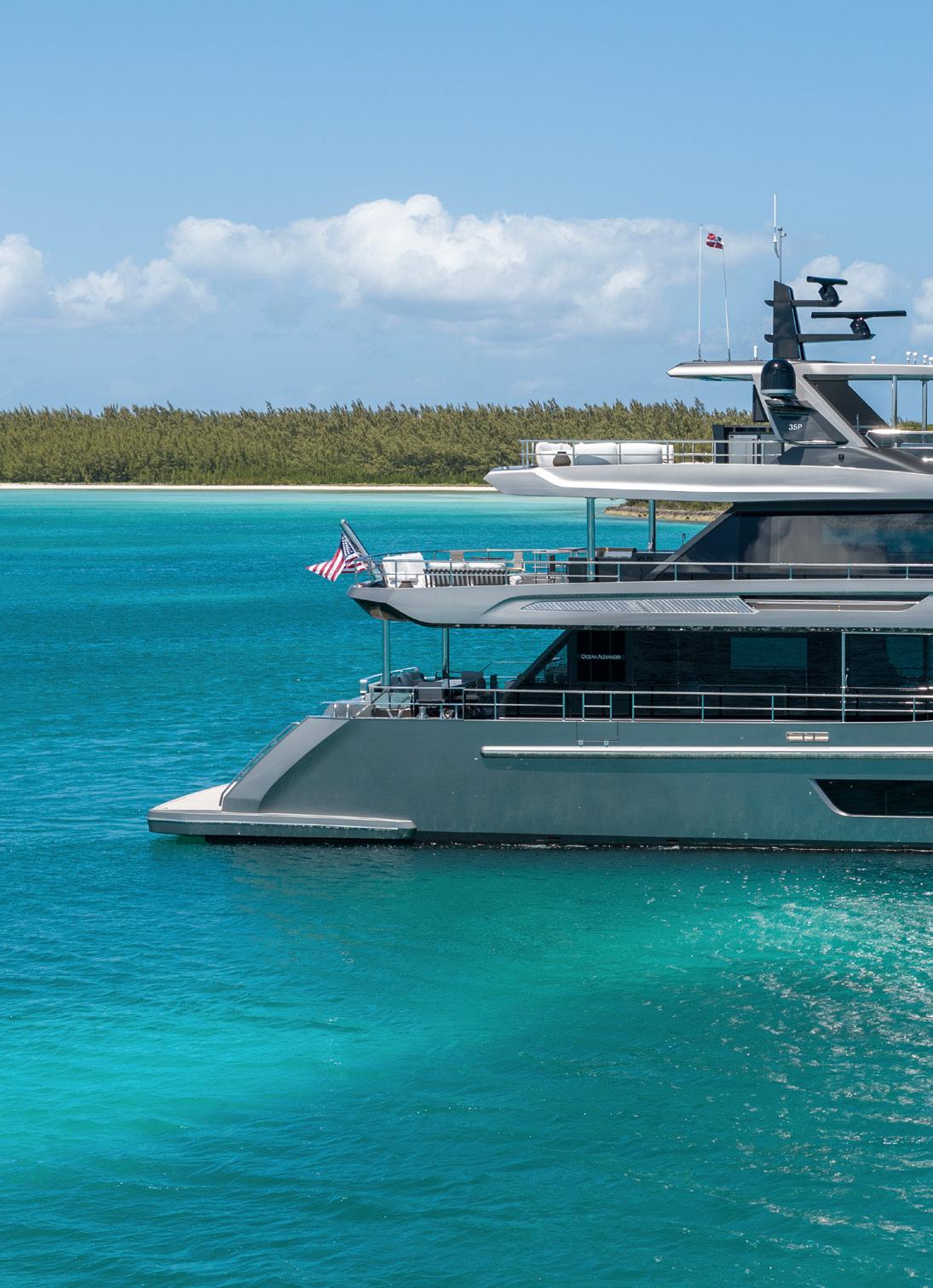
“We asked Giorgio for Italian – or better still, European – design with American sensibility.”
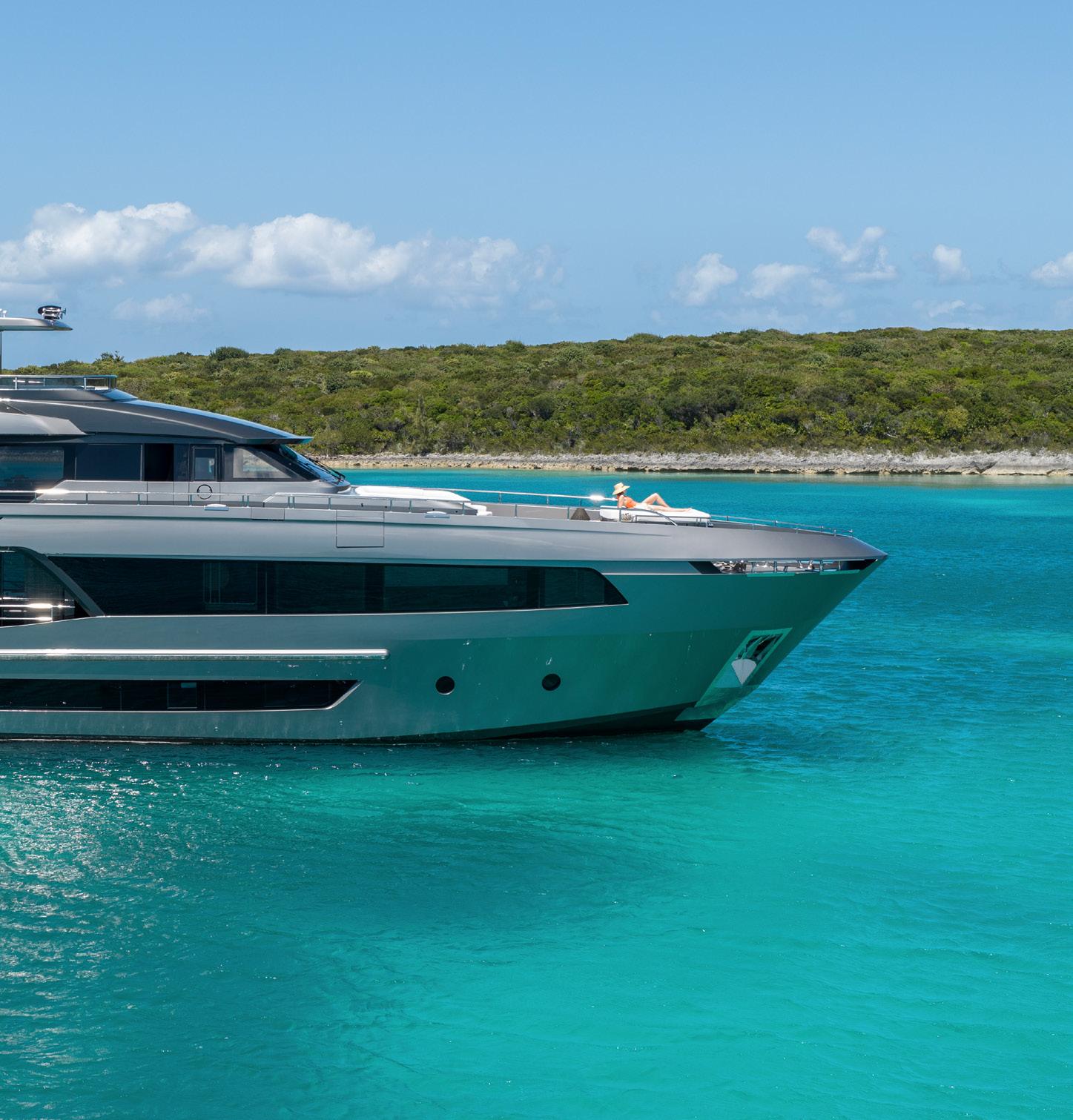
JUSTIN RATCLIFFE
That moment may be now. The first 35M Puro designed inside an out by Giorgio Cassetta with naval architecture by Italybased NavalHEAD made its debut at the 2024 Palm Beach International Boat Show to wide acclaim. Six more units in the series are in build, production of a 40-metre Puro has started and a 45-metre, sub400GT version is in development. The Puro brings a distinctly Italian flavour to what is commonly perceived as a stolidly American brand, which suggests Ocean Alexander is looking to expand its appeal beyond its traditional borders.
“We asked Giorgio for Italian – or better still, European – design with American sensibility,” says Mundy. “We wanted something that is stunning, beautiful and sexy to look at, but then we’re going to build it so it actually lives up to the expectations of our clients. Yes, Europe is of interest and we have a very specific strategy how to approach that market, but it will be executed as a marathon and not a sprint.”
The new facility in Kaohsiung will allow Ocean Alexander to build up to 45 metres and beyond, but the brand has no intention of going over 500GT, which is nearing the limits of GRP construction and would pit the brand against steel and aluminium builders. However, competitive advantage is just one consideration: just as important is remaining true to its roots and a client base with a 40 percent return rate.
“We are very much in tune with the market that we serve and the best thing is that at 40 or even 45 metres, we’re still dealing directly with the client and not with a representative or family office,” concludes Mundy. ”We love building yachts for people, not for entities.”
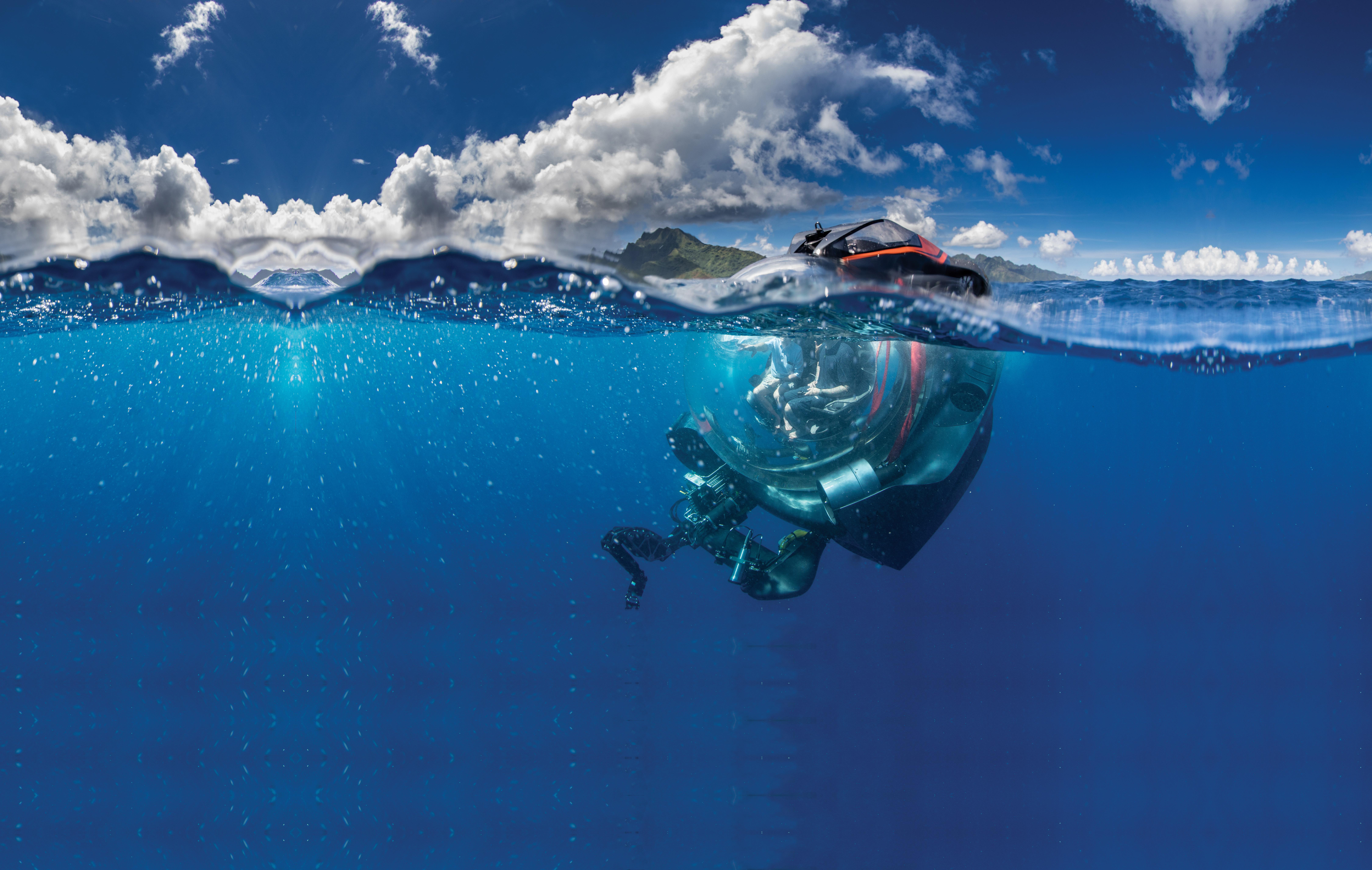

As the longest-established personal submersible manufacturing company, SEAmagine has been setting industry benchmarks for manned submersibles since 1995. SEAmagine’s fleet has completed over 13,500 dives with a perfect safety record, a figure representing more dives than all other submersible manufacturers combined.
Based near Los Angeles, SEAmagine has cultivated long-term relationships with its yacht clients, including one superyacht owner who recently returned for a third submersible. This loyalty stems from two key factors: first, SEAmagine’s submersibles are designed and customised to fulfil the owners’ dreams. Second, the subs’ proven reliability and performance, along with the company’s 24/7 international support, alleviate captains’ concerns, allowing the underwater vehicles to seamlessly integrate with other onboard activities.
“Many yacht owners, captains and yachting professionals are unfamiliar with the distinctions between well-designed and poorly designed submersibles, as this technology comes from a different marine sector,” explains Charles Kohnen, co-founder and chairman of SEAmagine. “Our subs, which are sized and built specifically for yachts, prioritise design features that enhance the owner’s diving experience while ensuring ease of maintenance and operation. The difference SEAmagine’s design makes in terms of owner and captain satisfaction for their sub is like night and day.”

The first key factors a yacht must consider when selecting a submersible are its passenger capacity, maximum depth rating and launch weight limit. These parameters determine the sub’s size and weight, but additional considerations are equally important. One key purpose of a sub on a yacht is to provide an unforgettable underwater view for the owners. This is best achieved with a panoramic bubble design, unobstructed by a hatch on top, which can significantly block the overhead view. The difference in experience between a sub with an overhead hatch and a SEAmagine sub is undeniable.
Anyone who has had the opportunity to dive in both will attest to this. SEAmagine designs its submersibles with a unique rear hull section that houses the hatch, pilot station and equipment, allowing the front bubble to maintain an unobstructed panoramic view while offering passengers a more spacious interior. Space aboard a sub is premium real estate, and SEAmagine subs offer more room within their launch weight category than any other sub on the market. This additional space allows SEAmagine subs to include larger, more comfortable leather seats and maximised personal space for all aboard.
Another standout feature is the cabin’s quiet interior. All SEAmagine subs are equipped with powerful propulsion thrusters that operate without gearboxes, eliminating loud noises from the motors that could startle marine life or create an annoying hum. To further enhance the tranquil atmosphere, SEAmagine has designed a quiet air conditioning system and fans, prioritising a peaceful environment. SEAmagine has also optimised the boarding and disembarking process to ensure comfort while the submersible is floating on the water’s surface. The patented design features a horizontal top deck with handrails, allowing passengers to board through the rear hatch and descend a short staircase to their seats. This extra-large hatch design improves convenience and safety.
These are just a few of the distinguishing factors that contribute to an exceptional submersible. The resulting superior designs are only possible due to SEAmagine’s experience gained over thousands of dives and nearly 30 years of dedicated submersible development.


Leapher Yachts is a new and innovative brand that aims to complete Horizon, an Ice Class explorer yacht of 60.5-metres and 1,750 gross tons, in just 26 months by rethinking the design, engineering and production processes along commercial shipbuilding lines.
BY JUSTIN RATCLIFFE
Yiannis Andriotis, founder of Leapher Yachts in the Netherlands, is a man on a mission. The former professional sailor and owner of the Odyseas Marina on the Ionian island of Meganisi has spent a decade immersing himself in the superyacht world, spending time with owners, guests, captains and crew to find out their likes and dislikes, preferences and pet hates. Now he is putting what he learned into practice.
“I started cherry-picking solutions to the many issues the sea can throw at you and together with a like-minded client we set out to design the ideal explorer,” he begins.
“Everything pointed to a steel-hulled yacht and Horizon, the first in our Navix explorer series, is the result of bringing all those ideas together. I believe it offers the best balance of what people want in terms of space, comfort, efficiency, flexibility, operability and servicing.”
The next stage was to find a shipyard to build it. Although the cheaper option would have been Greece, Turkey, Italy or Spain, his search focused on the Netherlands because of the country’s legacy of building both yachts and special-purpose working vessels. Cor D Rover, the Dutch designer of the Leapher range, suggested the family-owned De Hoop Shipyard, a builder of compact expedition cruise ships and subcontractors for the likes of Damen with production sheds, quay cranes and construction slipways on the Rhine in Tolkamer. An opportunity arose when the 135-year-old company closed its doors in the wake of the Covid-19 pandemic. Leveraging the shipyard’s knowledge, experience and proven designs, Leapher formed a strategic partnership with the former De Hoop team in late 2022.
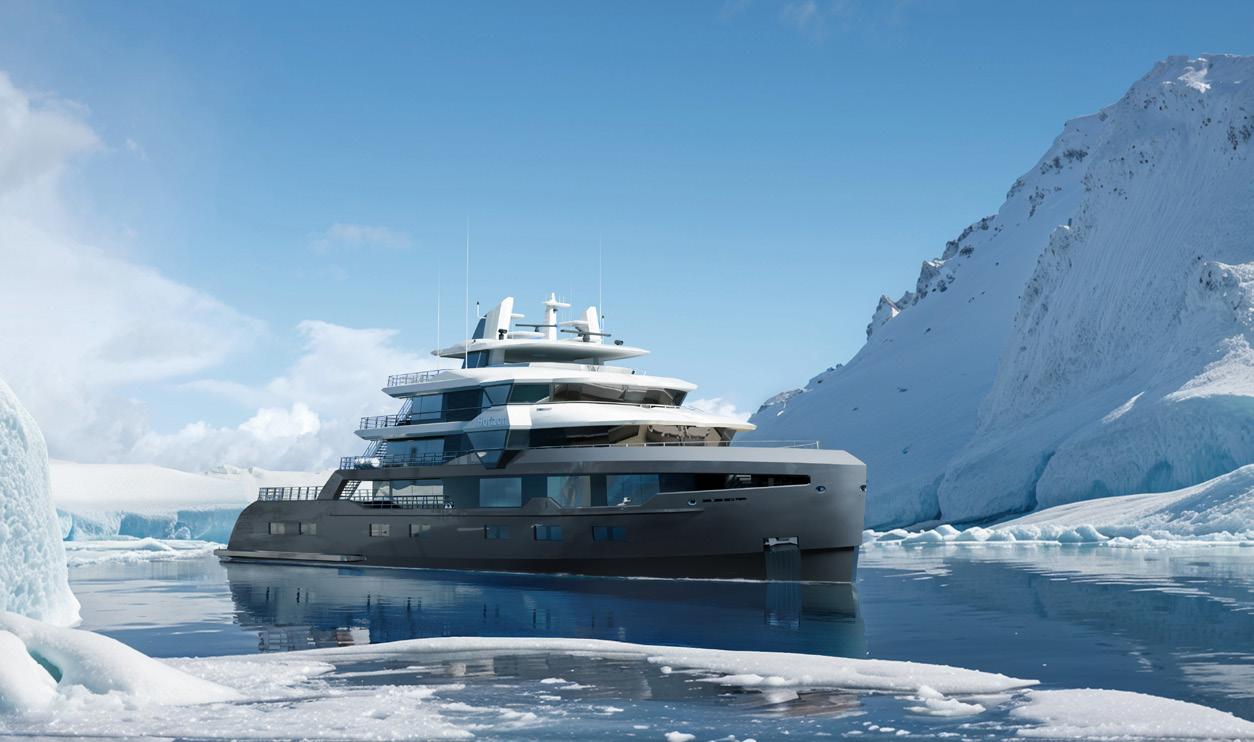

Leveraging the shipyard’s knowledge, experience and proven designs, Leapher formed a strategic partnership with the former De Hoop team in late 2022.
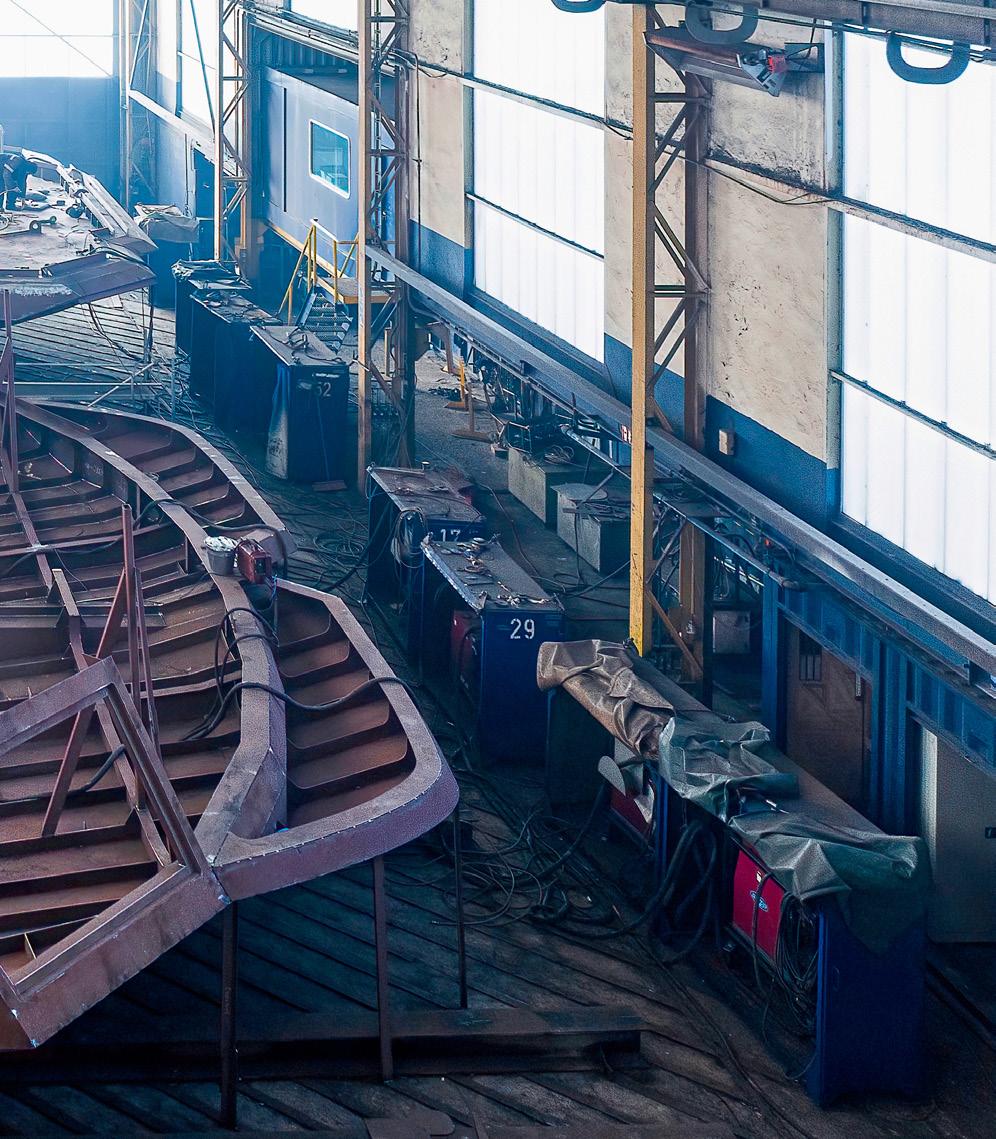
It is not just the design, layout and makers’ list that defines Leapher’s focused approach to yacht building; it also aims to emulate commercial shipbuilding practices to speed up production and contain costs.
“Building a good boat is one thing – building a financially successful boat is another,” says Leapher founder Yannis Andriotis. “To do that you need to build in as little time and with as few extra costs as possible. That means designing for fast production scheduling, because when you make a decision about equipment and its installation, it also affects engineering and production.”
Leapher’s production process is structured so workers can carry out their trades –welding, fairing, carpentry, and so on – in adjacent spaces on board at different stages of the build process. This is achieved by firstly preparing the blocks as much as possible in advance with cable trays laid and piping penetrations completed, so that by the time they are brought to the slipway, aligned and welded, installation of equipment can start while the vessel is still being built. “In this scenario volume is our friend,” says Yiannis, “because having the space makes it easier for different processes to be going on side by side.”
Although the shipyard has its own flatbed plasma cutter, for the time being it is quicker to have a subcontractor cut the metal and deliver it ready-shaped, although Leapher may bring more processes in-house in the future. To further save production time, even the piping sections are laid out individually inside one of the hangars ready for installation so they don’t get scratched and have to be repainted.
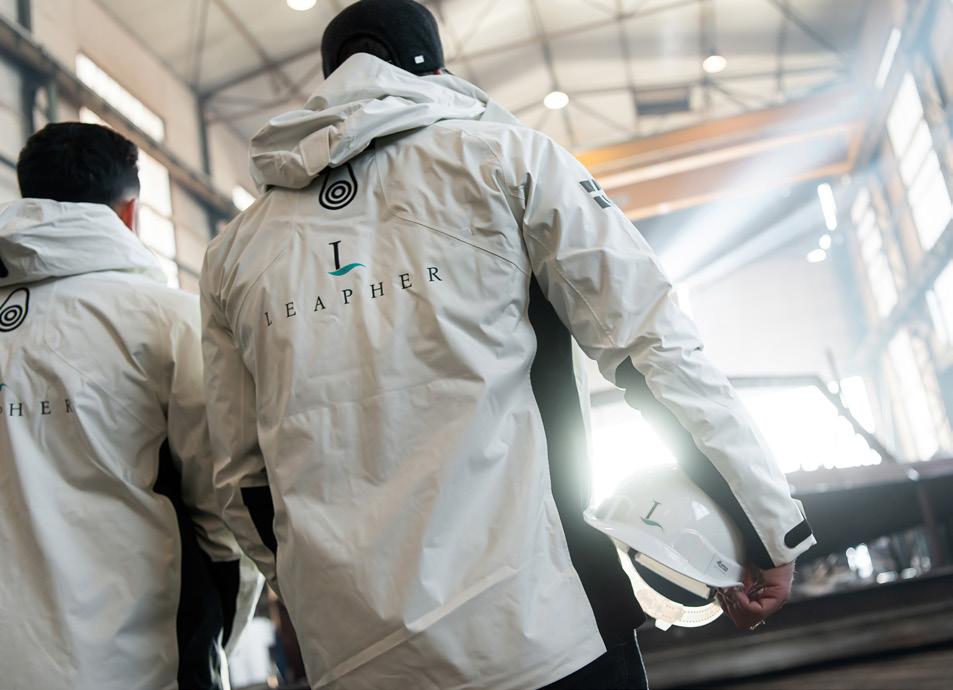
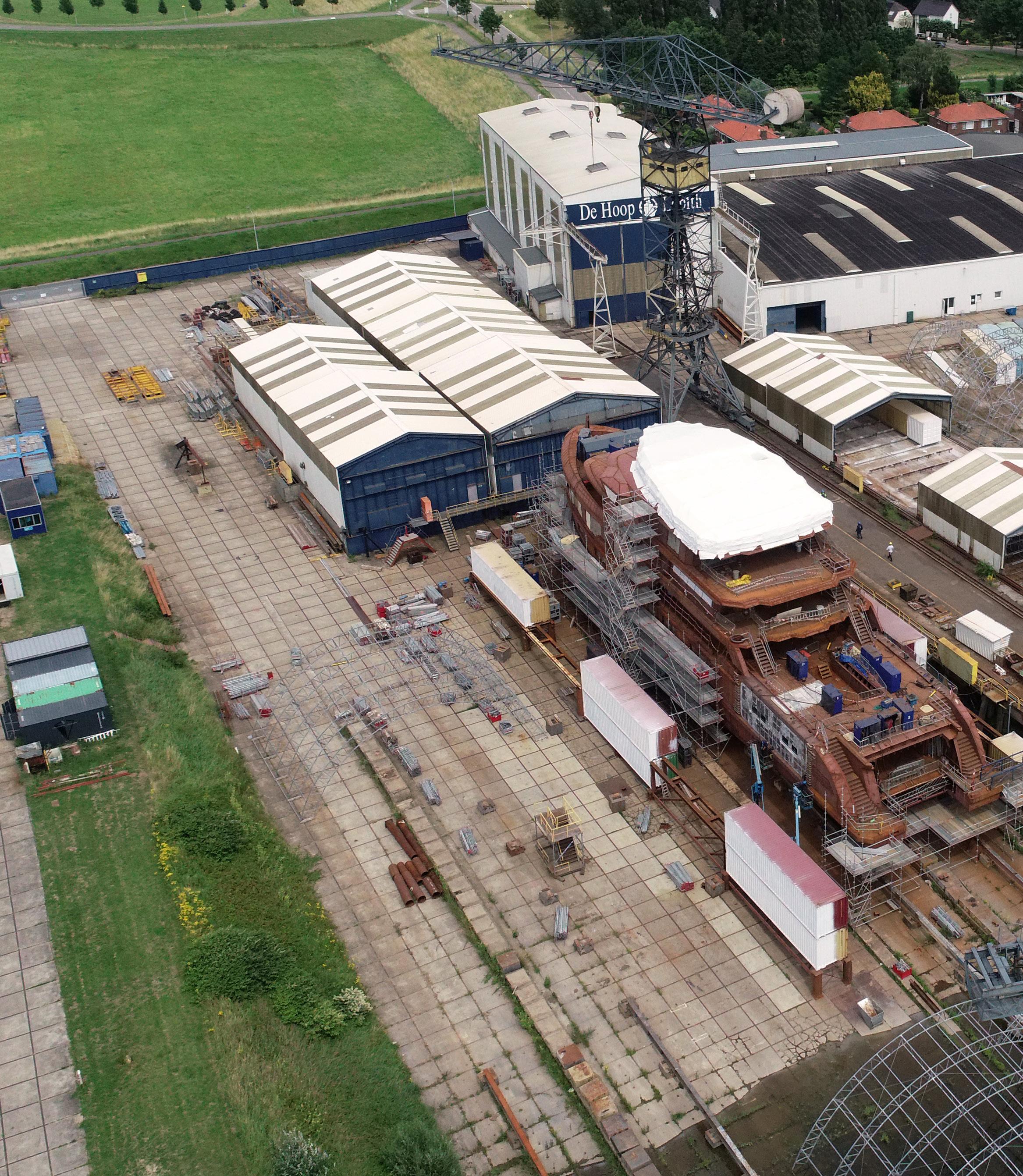
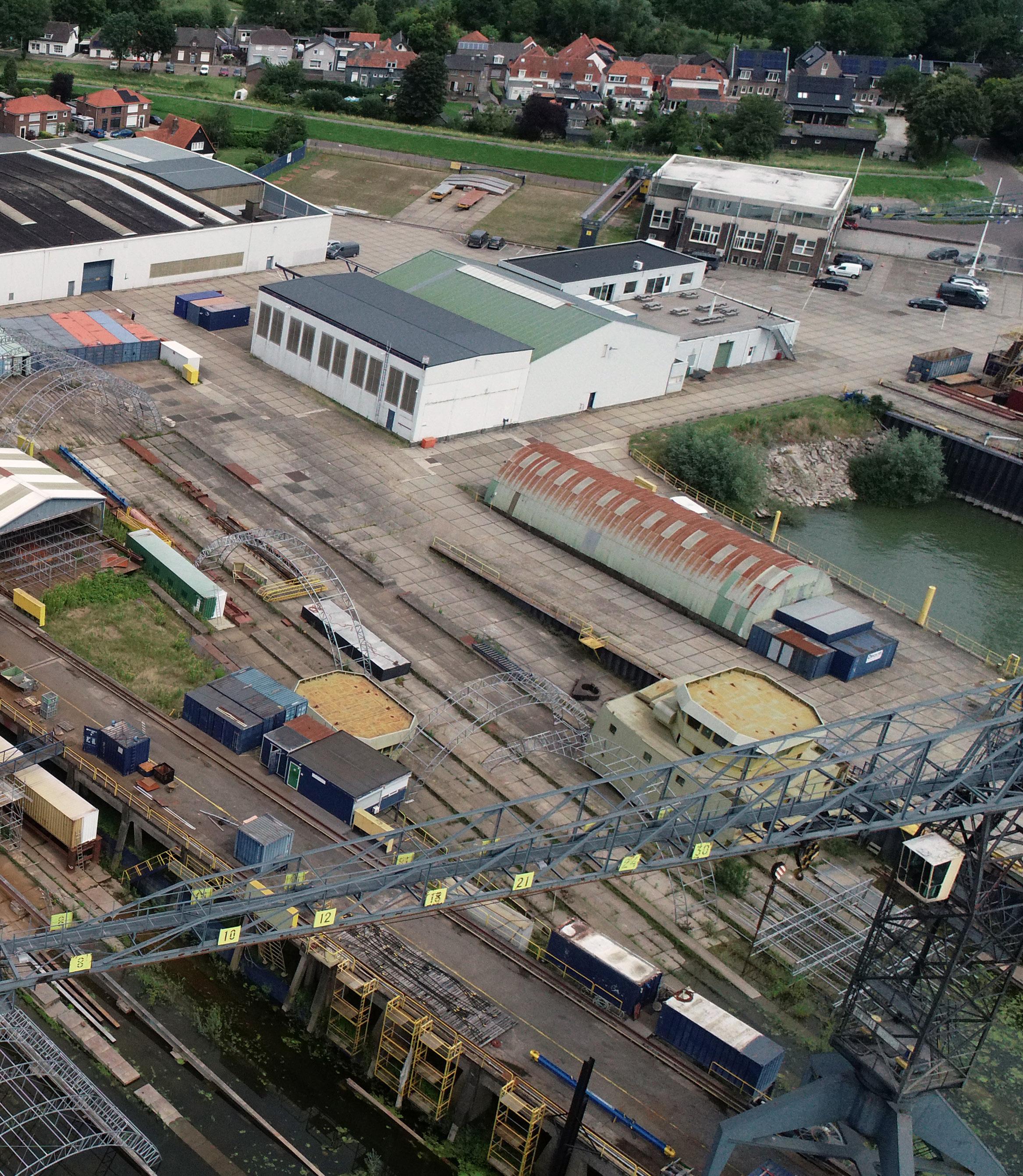
“The goal was clear: to merge maritime offshore technology with luxury superyacht features and quality into a single package.”
Horizon’s naval architecture is by 07 Designers with hull optimisation by Van Oossanen, but the former De Hoop engineering team has also brought its experience and expertise to the project. A closer look at the scale models of De Hoop vessels lining the Leapher offices reveals why: all of them have diesel-electric propulsion.
“The reason why these ships are full dieselelectric has nothing to do with fuel economy,” says Yiannis. “It’s because they are robust, efficient and proven systems offering very high torque and manoeuvrability. Our decision to go with shafts and propellers instead of Azipods again comes down to practicality and reliability: if you have an issue with a pod in a remote location, you could be in trouble, but if you prang a prop you can get it fixed in most places in the world.”
It is indicative of Leapher’s ship-like approach that the GA of Horizon refers to A-deck, B-deck, C-deck, D-deck and E-deck instead of lower, main, upper, bridge and sun decks. The whole of the tanktop deck is devoted to technical spaces and includes the propulsion, generator and switchboard rooms, a dry store, walk-in freezer and cold rooms, and a garbage handling room for up to 40 days’ autonomy with zero discharge (see sidebar p.47). A large laundry provides a comfortable and functional working space for crew instead of being crammed into a corridor, and an expedition store serves as a multifunctional space that can be equipped as a research laboratory.

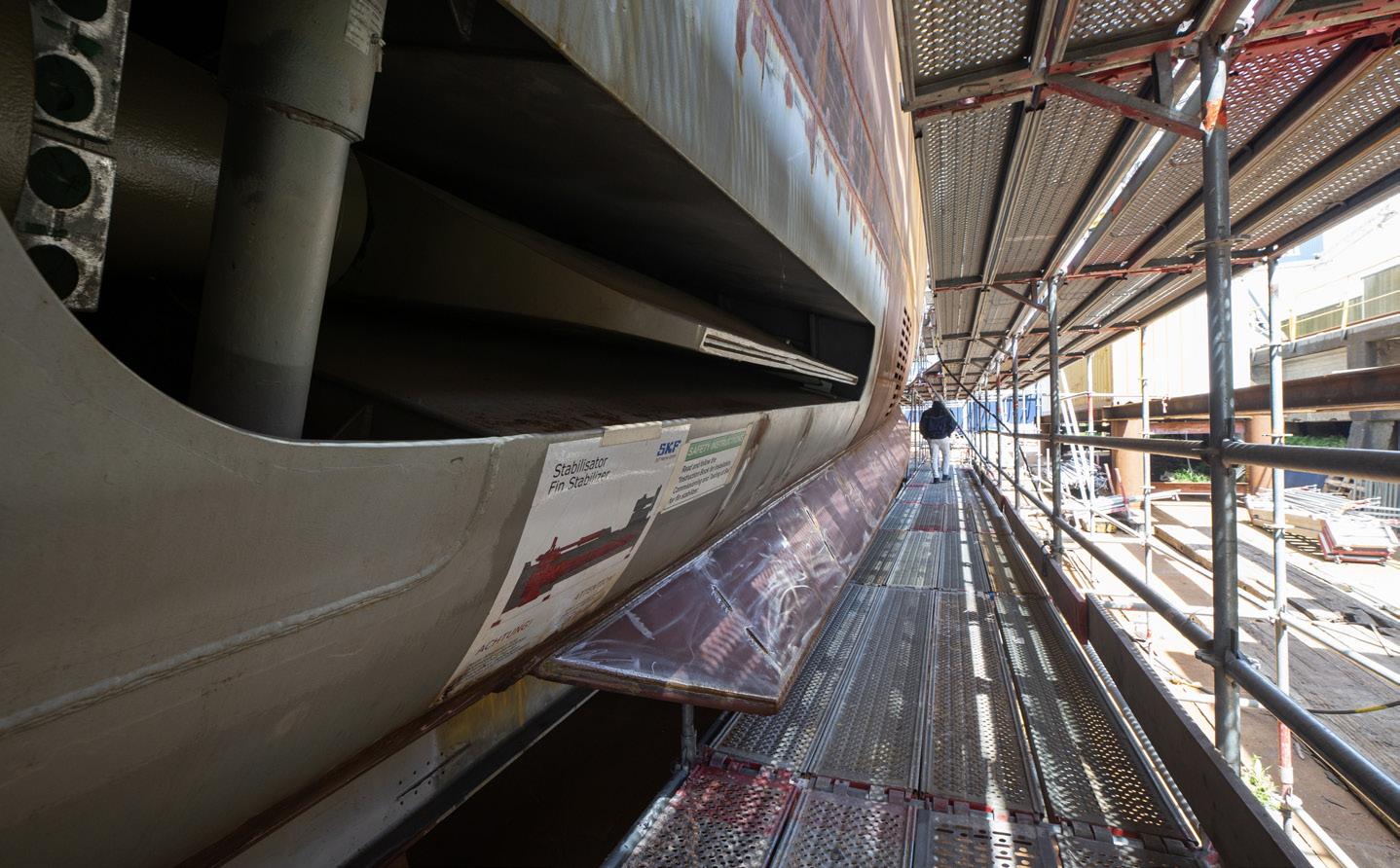
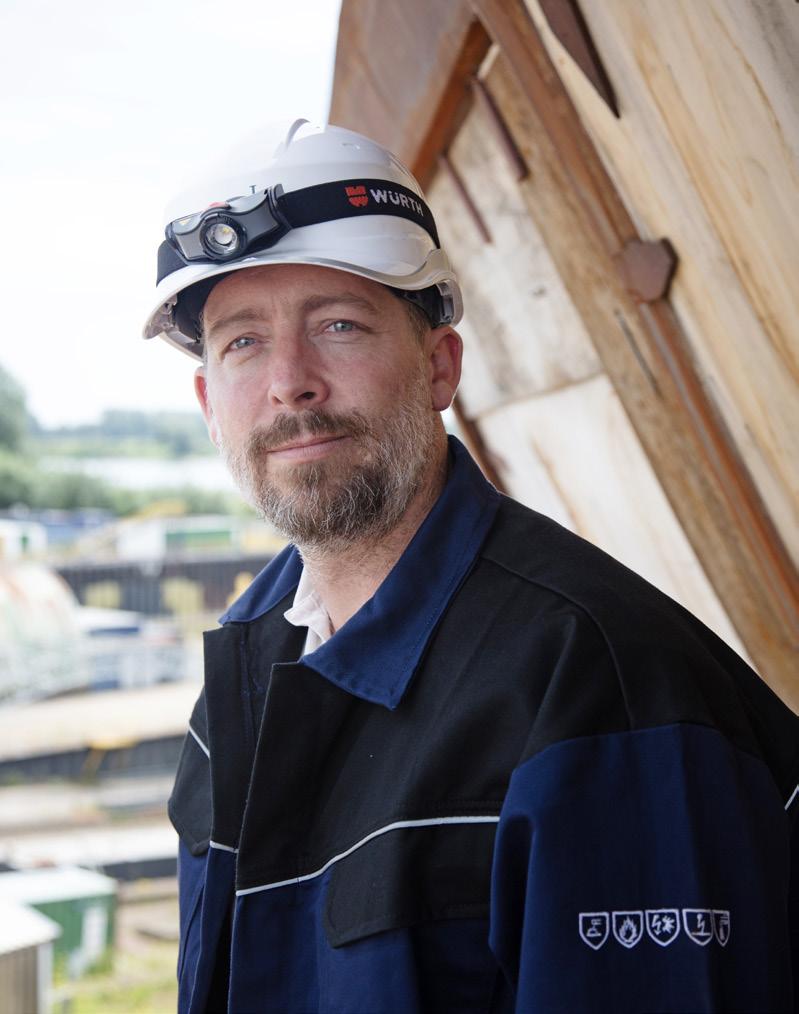
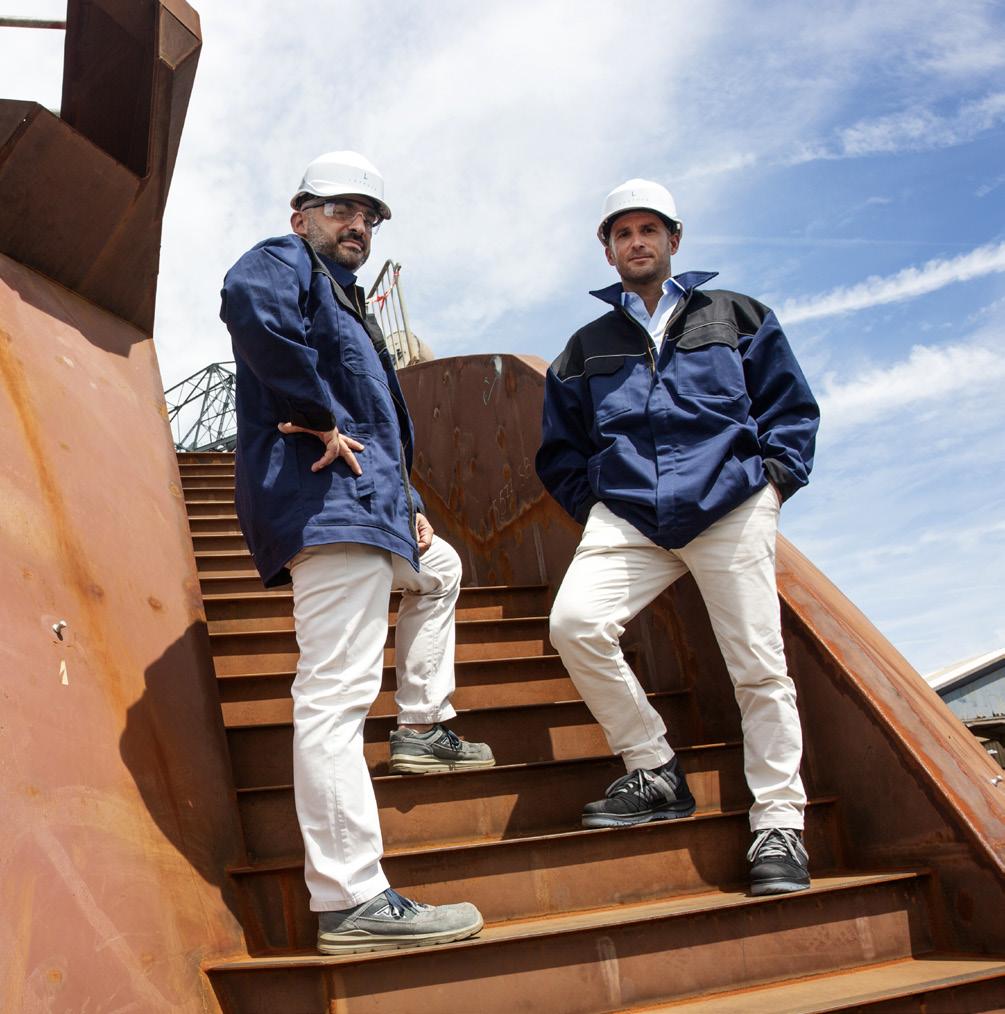
Diesel-electric propulsion is not the only feature derived from De Hoop’s example. The four Tier III compliant, Scania DC16 generators (456kW each with both SCR and DPF units) and Stamford alternators were chosen with easy repair and maintenance in mind. Coupled with the low-noise electric motors (700kW each) from Drivewerx and low-vibration 5-blade propellers by Blokland, the yacht will have a top speed of 12 knots and a massive range of up to 10,000 nautical miles at 10 knots when it burns just 150 litres of fuel per hour. For safety and redundancy purposes, the generators, propulsion gear and switchboards are divided into two independent systems that can function in tandem or separately. If there is a critical issue with one propeller or shaft line, for example, one half can be shut down and the watertight propulsion compartment sealed while the vessel runs on the other two generators and remaining prop in ‘get home’ mode.
The yacht also carries 600kWh of lithiumion batteries for peak-shaving, silent running at anchor and an emission-free range of 15 nautical miles at 6 knots in full electric mode. The A60 battery room on the lower deck is equipped with Novec fire suppression and sprinkler systems, but its position between the pool and the dump tank provides boundary cooling to help dissipate heat in case of fire (together with Lloyds, the build team is looking into being able to flood the compartment with water from the pool).
Two Veth bow thrusters, tunnel and retractable, provide redundancy and enhance DP capability together with Becker flap rudders for transverse thrust. Unusually, the retractable stabiliser fins are by SKF Marine, which has been equipping ocean-going vessels for over half a century. The fins are housed completely inside the hull without any protrusion, reducing drag and fuel consumption. Another relatively unknown brand in yachting is HatenboerWater for the watermakers that supplies the Royal Netherlands Navy. The HVAC system is based on Heinen & Hopman engineering that has been customised to meet the specific requirements of the yacht.
Low tech but efficient box coolers are mounted in the hull below the waterline. Like a radiator on a car, the coolant in the system transfers heat to the seawater before it returns to the engines. Often seen on ships, the closed-circuit cooling system eliminates the need for seawater to enter the vessel as well as the associated raw water pumps, strainers and high maintenance of opencircuit systems.
“The goal was clear: to merge maritime offshore technology with luxury superyacht features and quality into a single package,” says build captain Tobias Leigh-Oberholzer. “This approach, along with excellent seagoing capability, offered cost benefits as commercial equipment is often more durable, less maintenance-intensive and more costeffective than yacht-specific equipment.”

One of the key design criteria was to have two 10-metre tenders based on military-spec hulls used by the British Royal Navy, one of which is fully enclosed for colder climates. Housed in a garage on the lower deck (A-deck), there is room left over for four PWCs and even a small car or mini sub. These are launched through hatches by a 2,500kg-capacity crane with an 11-metre reach that is built into the upper deck overhang, where the steel fashion plates and superstructure have been engineered to provide a rigid tripod effect. The same crane can be used to launch a seaplane from the raised aft deck where the pool has a lifting floor.
“Originally we had a helicopter hanger instead of the pool and that’s still an option on future builds, but this time we favoured a seaplane because of the limited range of helicopters,” says Yiannis. “We calculated that the longest trip could be from the Ross Sea in Antarctica to somewhere like South Georgia. That’s over 1,000 nautical miles, which is too far for a helicopter in an emergency.”
Every effort has been made to make life on board as comfortable and efficient as possible for the crew, so opposite the pro-spec galley is a very large crew mess, the crew cabins have a floor area of fully 12 square-metres, there is a crew gym and a full-size service lift that travels from the garbage handling room on tank top level up to the bridge deck.
The main deck (B-deck) follows a more conventional layout with a main saloon and indoor dining, four guest suites and a fullbeam VIP suite forward. The guest suites are exactly the same size with mirrored layouts, which means furniture and fittings can be standardised for fast, semi-custom production. A simple but smart design feature is that the walk-around sections on all the decks have railings instead of solid bulwarks – a cost-effective solution that allows for easy boarding from the dock in case of extreme high and low tides around the world.
“You can only design the boat once, so you need to pre-engineer as much as possible and look ahead as many moves as you can.”
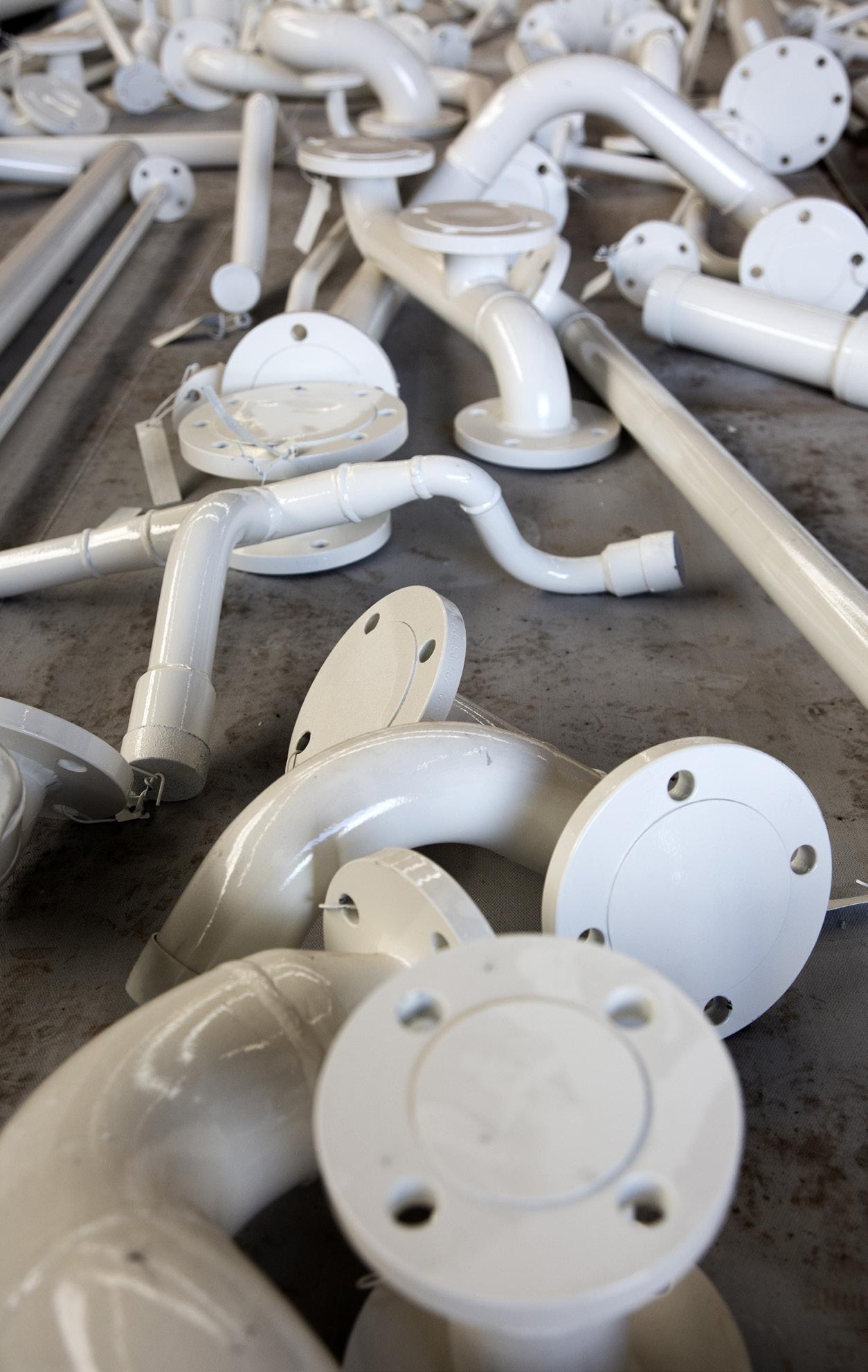
Below: All the painted pipe sections are laid out carefully on the floor ready for installation to avoid scratching them. Facing page: At the time of our visit the build was waiting to be covered prior to deck levelling.
“The vessel’s design evolved from a rough workboat concept to a high-class, expedition-style yacht with everything from dynamic positioning and hybrid propulsion, fully kitted out dive and mud rooms, garbage handling room and onboard medical facility, to a heated pool with a contra-flow system, sauna, massage room, observation lounge, gym, and a fire-pit,” says Captain Tobias.
The forward-facing master stateroom occupies fully half the interior volume on the upper deck (C-deck) and is 14.4-metres wide from window to window, which extend beyond the maximum beam. However, the layout has been designed to offer various options and the owner’s lounge can also be closed off to serve as an extra suite with a drop-down bed, an office or family room. All the guest areas and passerelles are wheelchair friendly.
“You can only design the boat once, so you need to pre-engineer as much as possible and look ahead as many moves as you can,” says Yiannis. “Take the wheelchair access, for example. This a boat for private use but it’s being built to commercial class. If you can add something without seriously affecting cost, complexity or production time, why not do it?”
The wheelhouse with enclosed wing stations and top-end equipment such as Hatteland monitors used by offshore and naval vessels, is another XL space designed for guests to be be involved in the navigation process when the yacht is traversing the Northwest Passage or cruising the fjords of Greenland. One of the guest couches will have a monitor that can display charts and 3D scans of the seabed.
The former De Hoop facility has plenty of covered buildings at its disposal, but these are mostly low-rise production sheds. The actual assembly work takes place outside on the slipway – unusual for a yacht builder in northern Europe. At the time of our visit and with the hotworks complete, the shipyard was preparing to cover Horizon prior to deck levelling and fairing (instead of sandblasting, it is also testing an innovative laser system that Andriotis calculates saves several weeks’ production time) and is being creative in how it uses its facilities. A hangar that served for assembling the steel plates, for instance, will be converted into a temporary, climate-controlled hangar for painting large components like the aluminium hardtop and tender garage doors.
It seems that Leapher’s bold strategy is going to plan and Horizon is progressing on schedule since construction began in June 2023. But what began as a pared-down series project has taken on more custom characteristics and everything will have to continue to run smoothly if the team is to meet the target of showcasing the yacht in Monaco next year. Before leaving, I ask Yiannis whether his 26-month build schedule for a yacht of 1,750-plus gross tons might be a touch too ambitious?
“We’re a new shipyard with new people, but I think we can build this very complex yacht in the allotted time,” he replies with only the slightest hesitation. “The most important thing right now is that we continue to test ourselves and focus on delivering a great boat.”
“We’re a new shipyard with new people, but I think we can build this very complex yacht in the allotted time.”
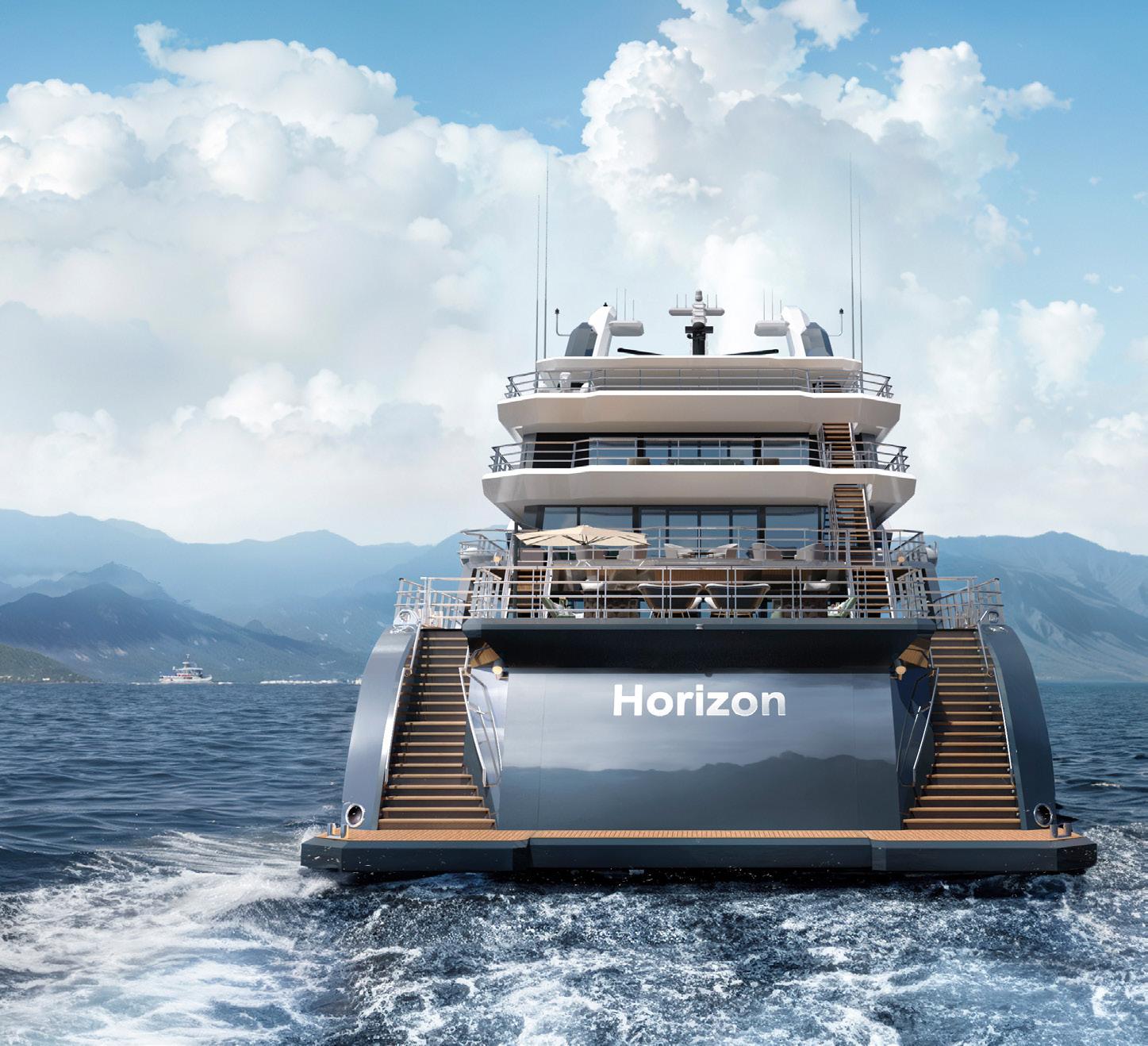

Horizon is equipped with a biological sewage plant. Based on 12 guests and 16 crew at 250 litres per day, the system can produce 7,000 litres of clear water per day of which three percent goes into a sludge tank and rest into treated water tanks with a capacity of over 86,000 litres. The more limiting factor is the sludge, but Captain Tobias calculates the tankage capacity still provides zero-discharge autonomy in protected areas for up to 40 days at full capacity. The pool water is first de-chlorinated before passing through the biological sewage system. Space has also been left to retro-fit an evaporation unit if needed.
A food waste disposal unit macerates waste food and dehydrates it (the water is cycled into the sewage plant). Along with a glass crusher and industrial compactor, there is storage space for waste in the refrigerated garbage room for more than 40 days at sea.
Because there is no seawater passing through the vessel, the closed box cooling system further reduces environmental impact. A heat recovery system on the generators and box coolers pre-heat all the hot water on board, and can be used for heating the interior and decks in cold weather.
On superyachts the hull fairing usually extends a short distance under the waterline, but that makes little sense on an Ice Class vessel where even brash ice will quickly strip off the fairing compound. Instead, the fairing on Horizon will stop where the ice belt starts and below will be treated with self-cleaning, biocide-free, silica-based anti-fouling that offers better protection from ice, but also improves fuel consumption by reducing resistance through the water.
An issue associated with being autonomous for long periods is the availability of fresh fruit and vegetables. Captain Tobias is looking into installing in the dry store a system that its maker describes as “the world’s first autonomous vegetable grower.” Specifically designed by Agwa for use at sea, the AI-based system calculates and generates precise growth plans tailored to each plant’s requirements, from leafy greens to fruits, in special vertical cabinets.
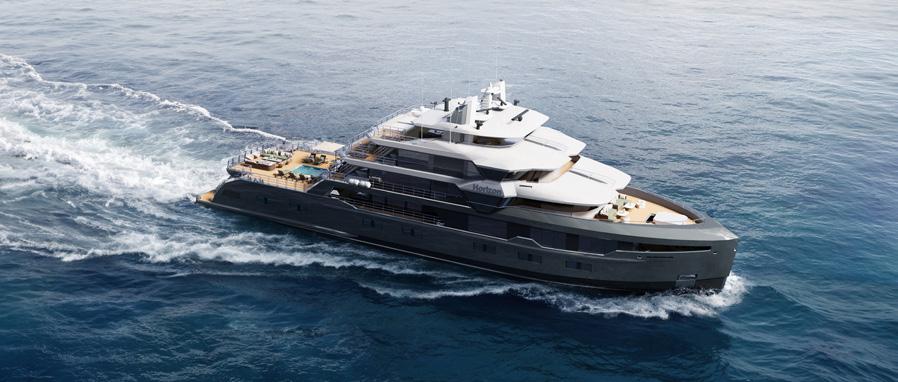

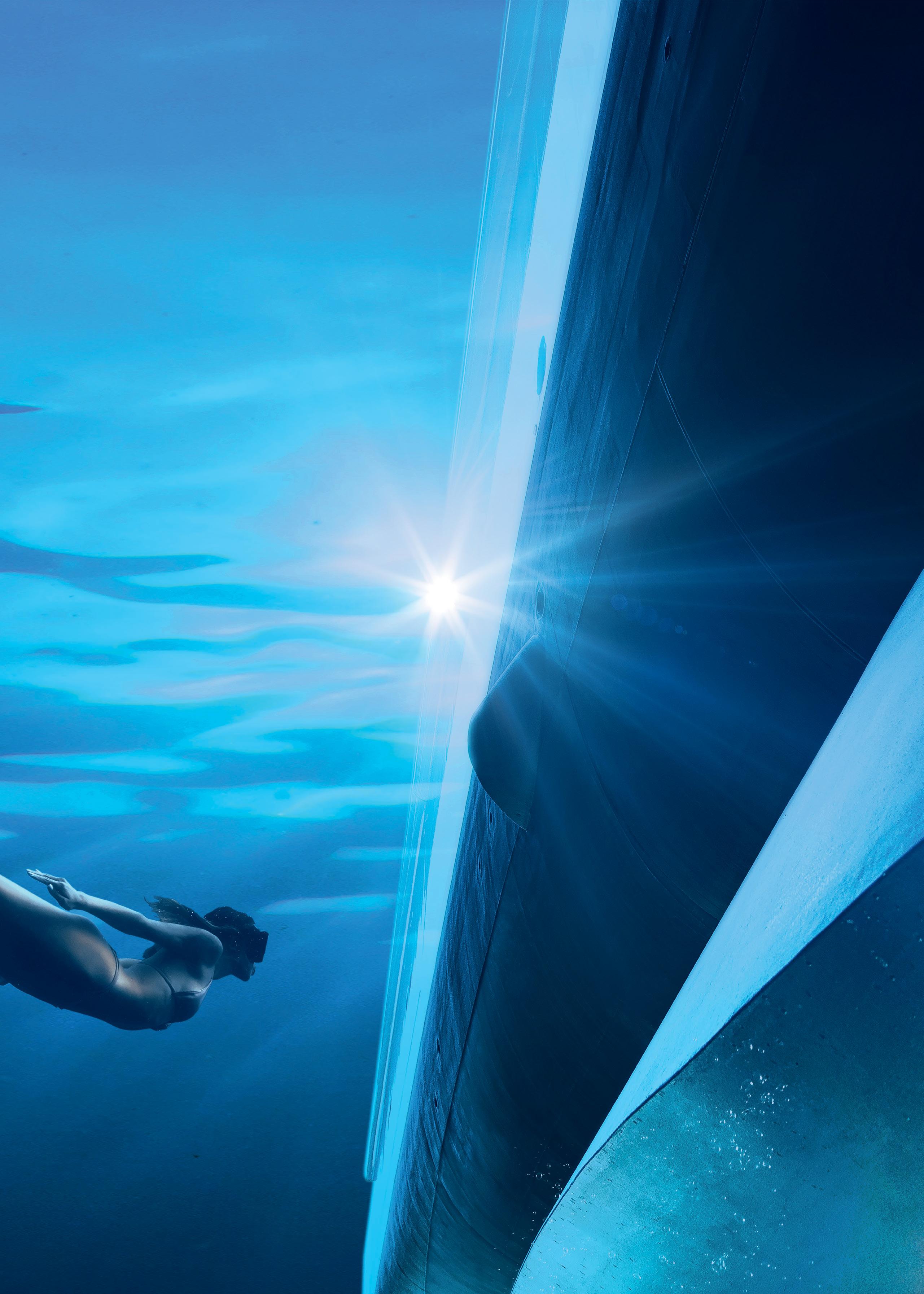






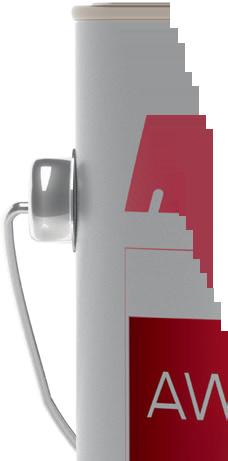
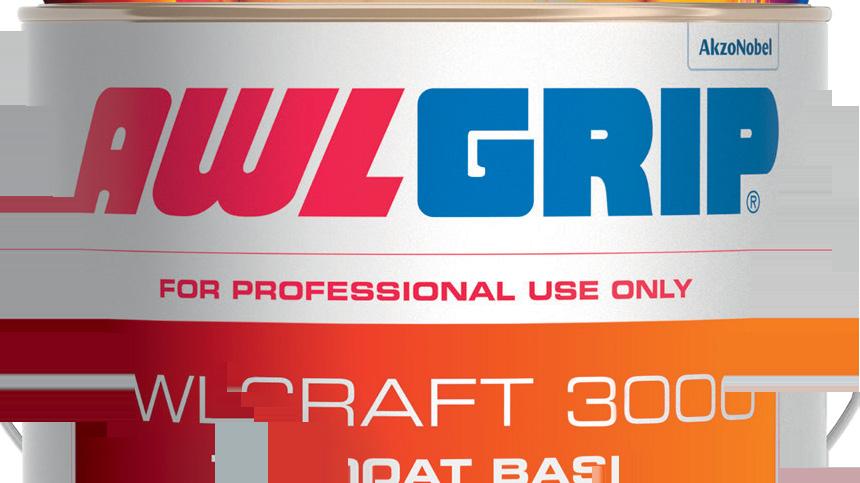




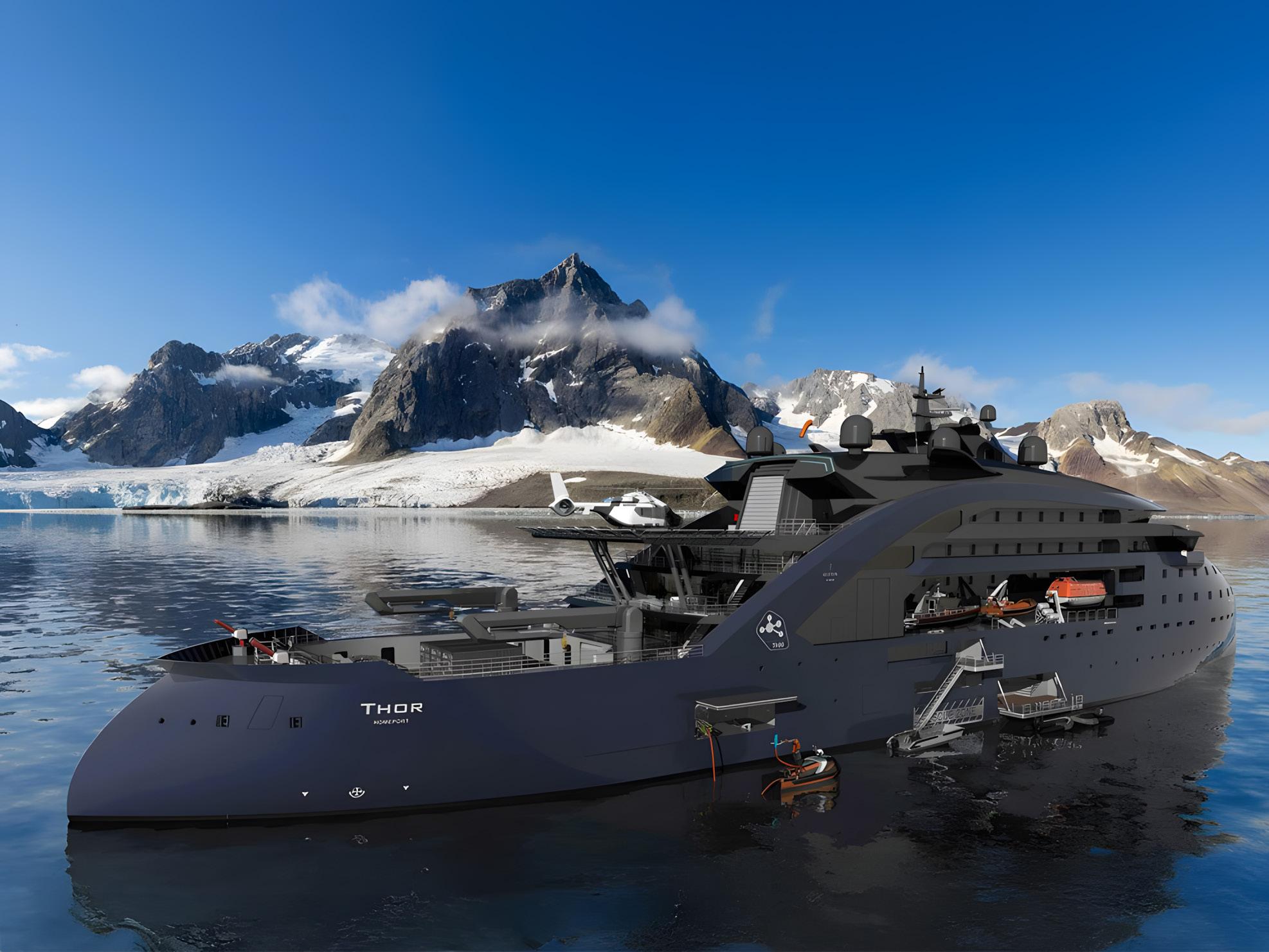
Ulstein began its thorium-powered Thor concept with a question: What if we could design and build a vessel with an abundant emission-free energy source able to support other vessels with clean fuel? There are some 160 vessels worldwide with nuclear reactors, nearly all of them military ships or submarines, but will we ever see a nuclear superyacht?
BY JUSTIN RATCLIFFE
“We’re starting to see micro reactors and associated systems that can be scaled to fit on bigger superyachts.”

Ulstein first unveiled its 149-metre Thor concept in 2022 together with the full-electric cruise ship concept Sif. With carbon emissions and alternative fuels in the spotlight, the disruptive project garnered considerable industry interest and last year the Norwegian group was invited to join a panel of class societies and flag states to discuss nuclear energy at the Superyacht Forum during METSTRADE in Amsterdam.
“What was interesting was that each session was given 45 minutes before breaking for lunch, but ours had a record show of people and lasted one-and-a-half hours,” says Øyvind Gjerde Kamsvåg, Chief Designer at Ulstein
International. “Most people were sceptical about nuclear power at first, but many were converted by the end of the session.”
The clever thing about Thor from a superyacht perspective is that it is categorised as a Replenishment, Research and Rescue (3R) vessel and conceived as a floating power and charging station. Equipped with a Micro Modular Reactor (MMR) or a thorium-powered Molten Salt Reactor (MSR), it would be able to generate 20MWe of clean, safe electricity for recharging a new breed of full-electric vessels at sea, with the potential to also be plugged into the renewable energy grid.

“Thor would be able to satisfy a variety of different needs in the market,” continues Kamsvåg. “So you can use it as a first responder, you can use it as a scientific research hub, you can use it as an energy replenishing unit. It can serve so many functions once we start to explore the nuclear energy infrastructure.”
The alternative to a mobile charging station like Thor is installing a nuclear reactor on board the yacht itself, which comes with other potential advantages. As the fuel is contained within the reactor there are no fuel tanks, combustion air intakes or exhaust stacks that take up valuable space.
Besides being emission free, nuclear reactors require no regular maintenance and provide extremely long intervals of operation before refueling. The latest reactors on submarines, for example, are designed to last the lifetime of the ship, during which time they circumnavigate the globe many times.
“Superyacht clients like the idea of Thor because the reactor is separate from the yacht itself,” says Kamsvåg. “But we’re starting to see micro reactors and associated systems that can be scaled to fit on bigger superyachts. That is still a bit further up the road, but I think both scenarios are equally interesting.”
Feadship considered the question with its Relativity concept back in 2012 and concluded that “technically speaking, a nuclear fission reactor design could be made, customised to fit the available space on a yacht and dimensioned to allow for all operating conditions.” Like Ulstein, thorium was envisaged as fuel in a high-temperature, low-pressure molten salt reactor. The heat output would then be converted to mechanical power using high efficiency, closed-cycle Helium gas turbines to drive the generators. But the technology was not readily available and issues associated with insurance and port controls rendered the idea compelling but ultimately impractical.
More recently, a 2023 joint study between the Feadship R&D department and Delft University tackled the topic again. The study identified that a IV generation Micro Modular Reactor using a uranium, carbon and oxygen fuel kernel might be the best fit for the load profile of a superyacht. A fraction of the size of a conventional nuclear reactor, MMRs can be factory-assembled and transported as a unit for installation. Both Feadship and Ulstein have looked into the volumetric requirements of installing such reactors on board and found they would occupy less space than alternative fuel systems. However, the Feadship study underlined the massive weight implications of the lead and concrete shielding materials required. Depending on the size and power of the reactor, the whole installation could weigh over 2,300 tons, more than doubling the weight of an 80-metre yacht!
This is just one reason why Feadship believes a more realistic role for maritime nuclear power would be to make green hydrogen or methanol either onshore, or close to shore, for use as carbon-free fuels. This view was backed up by Ronno Schouten, Design Manager at Feadship, at the Alternative Fuels conference during the 2024 Monaco Energy Boat Challenge:
“Yes, a nuclear-powered yacht will be technically feasible sometime in the future, but why integrate an MMR with an average onboard load of about 10 percent, when you can put it to better use onshore making green fuel like methanol for multiple yachts at maximum power?”
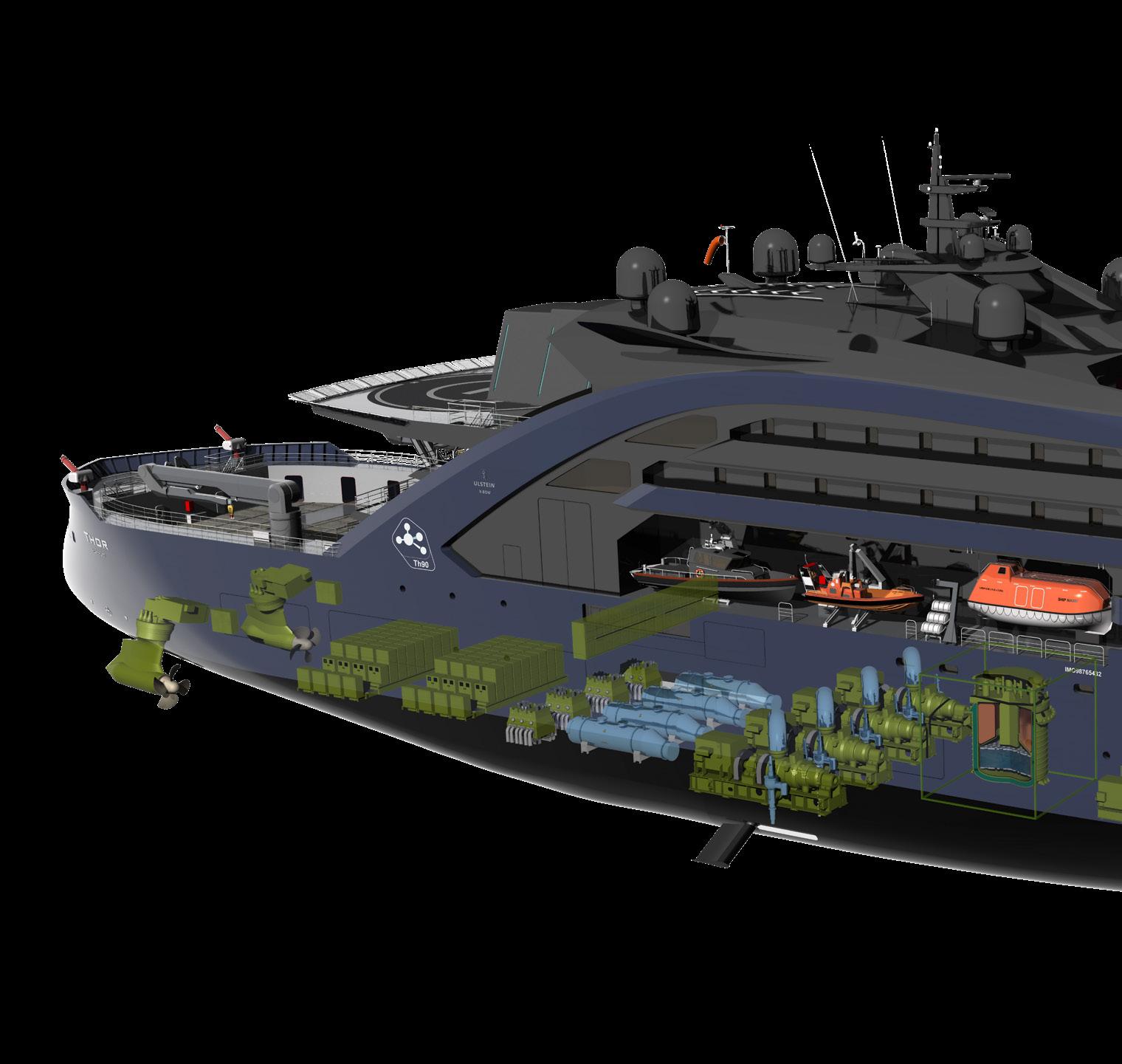
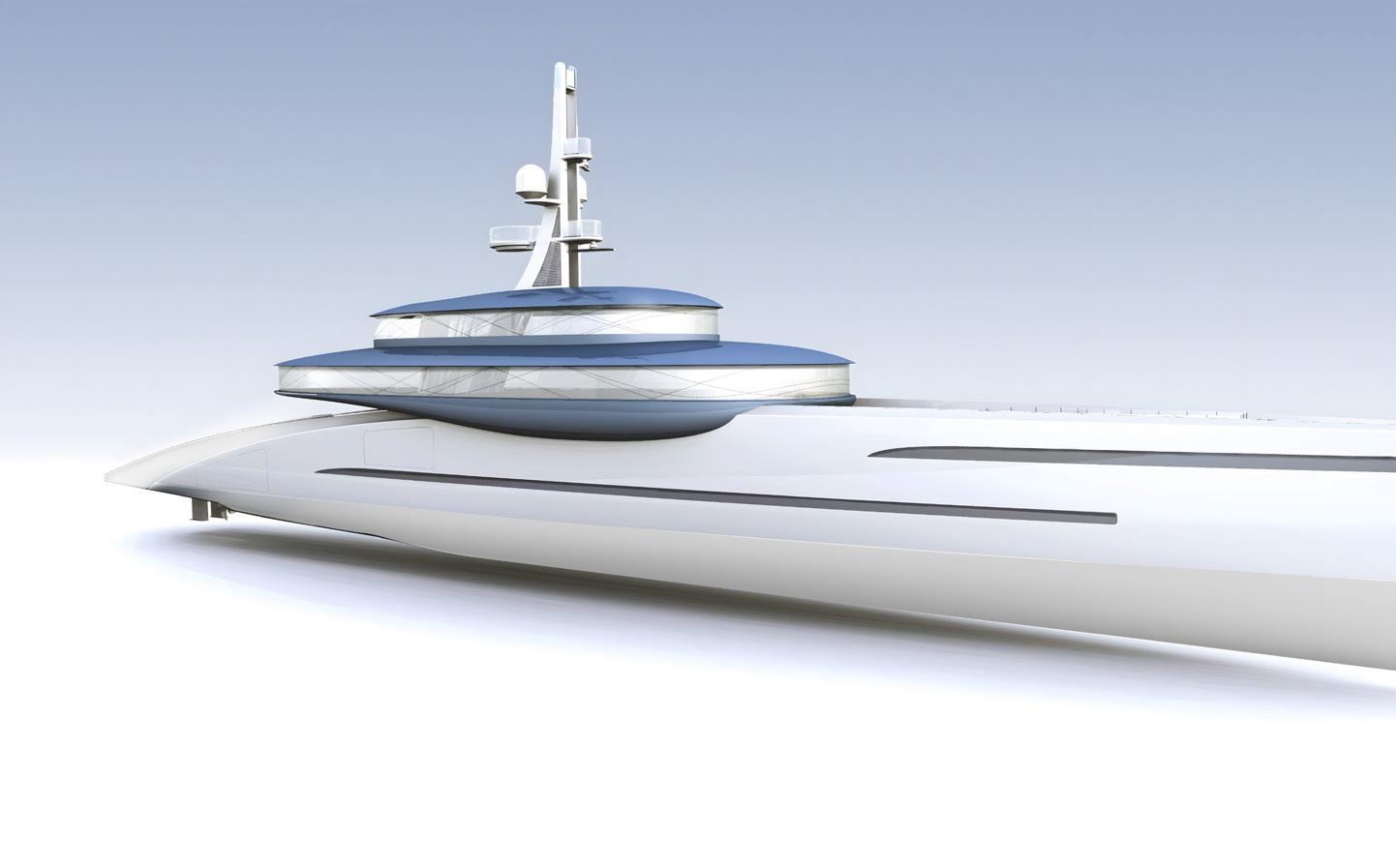
“The regulatory bodies and flag states all agree that nuclear will play a role if we want to go into emission free or more sustainable shipping.”

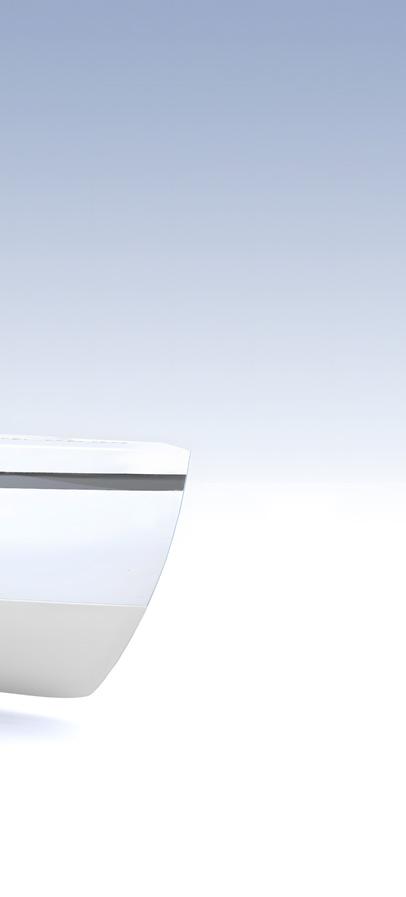
Although technically possible, onboard nuclear power faces other hurdles. Public perception of the danger of radioactivity, heavily influenced by high-profile accidents like the Chernobyl and Fukushima disasters, is a major concern although sometimes overstated. The latest nuclear technology makes leakage or meltdown highly unlikely, but checks need to be put in place to prevent accidents due to grounding, impact, collision, machinery damage, fire, explosion, and other causes. Last but not least is the near total lack of maritime legislation, insurance policies and flag state rules covering nuclear reactors on yachts.
Left: Thor is essentially a multi-purpose recharging station equipped with a Micro Modular Reactor that dissolves thorium, an abundant and naturally occurring metal with low radioactivity, in molten salt.
Bottom: Feadship’s Relativity concept in 2012 first mooted the topic of a nuclear powered superyacht.
“The regulatory bodies and flag states all agree that nuclear will play a role if we want to go into emission free or more sustainable shipping,” says Jose Jorge Garcia Agis, managing director at Ulstein International. "The main challenge today is that the international regulations for nuclear-powered ships are outdated and based on old nuclear technology. This makes it very difficult to implement them on modern vessels. Ship design is heavily influenced by regulations; we work within the rules. Without clear rules, we have to define our own framework and then seek approval, rather than designing around an existing framework."
The commercial shipping industry is aware of what is at stake. Last year, Fincantieri and RINA signed an agreement with newcleo to carry out a feasibility study for applications in shipping for the nuclear tech company’s leadcooled, small modular reactors. In August Lloyd’s Register announced a project together with Core Power – a leading developer of floating nuclear technology solutions – and A.P. Mølle - Maersk to assess the viability of a nuclear-powered container ship that could be deployed in European waters. Lloyd’s Register further launched a new report at the Monaco Yacht Show in September entitled Fuel for Thought: Nuclear for Yachts that highlights its potential as a clean, powerful and long-lasting energy source.
“Nuclear energy offers the potential to be as transformational to shipping as the shift from wood to iron or from sail to steam,” says Engel-Jan de Boer, global yacht segment director for Lloyd’s Register. “Unlike alternative fuels that might serve as direct replacements for traditional oil-fired systems, nuclear power represents a fundamental shift that could redefine luxury yachting”.
Below: Newcleo’s LFR (Lead-cooled Fast Reactor) is a small nuclear battery producing a 30MW electric output. The nuclear tech company signed an agreement with Fincantieri and RINA last year to explore mini reactor applications for decarbonising the shipping industry.
The first nuclear-powered merchant ship, NS Savannah, was launched way back in 1959 by the New York Shipbuilding Corporation in New Jersey, USA, as one of only four nuclear cargo ships ever built. A demonstration vessel designed to serve also as a passenger ship, she was appointed with 30 air-conditioned ensuite staterooms, dining facilities for 100 passengers, a lounge that could be converted into a movie theatre, a swimming pool, veranda and library. However, high operating costs, low commercial value, limited port access and public concerns about safety led to her being taken out of service in 1971.

Sixty-five years after the launch of NS Savannah, the situation is very different. Nuclear technology is far more advanced, the reactors are much smaller and safer, and the IMO has doubled down on carbon-reduction ambitions by setting a net-zero emissions goal by 2050. Moreover, geopolitical tensions around the world are making the energy independence offered by the nuclear option an increasingly attractive proposition. In this scenario, another Norwegian research project, NuProShip (Nuclear Propulsion of Merchant Ships), is aiming to develop a commercially viable nuclear technology for ships that satisfies all stakeholders and requires no subsidies after the initial development process.
Heading up the NuProShip project is Jan Emblemsvåg, professor of ocean operations and civil engineering at the Norwegian University of Science and Technology (NTNU). He believes that given the poor energy density of other low- and zerocarbon fuels we might not have much choice but to embrace nuclear power for oceangoing vessels, and draws on a very graphic example to make his point: if hydrogen’s energy density was one metre long, uranium would be 32 kilometres long and thorium would be 38 kilometres long.
“This is what the green transition must be about,” he says. “We need to learn how to deal with these two atoms and then we should be just fine.”










The F45 Hybrid Power System is so efficient, you’d swear you were on a sailboat.









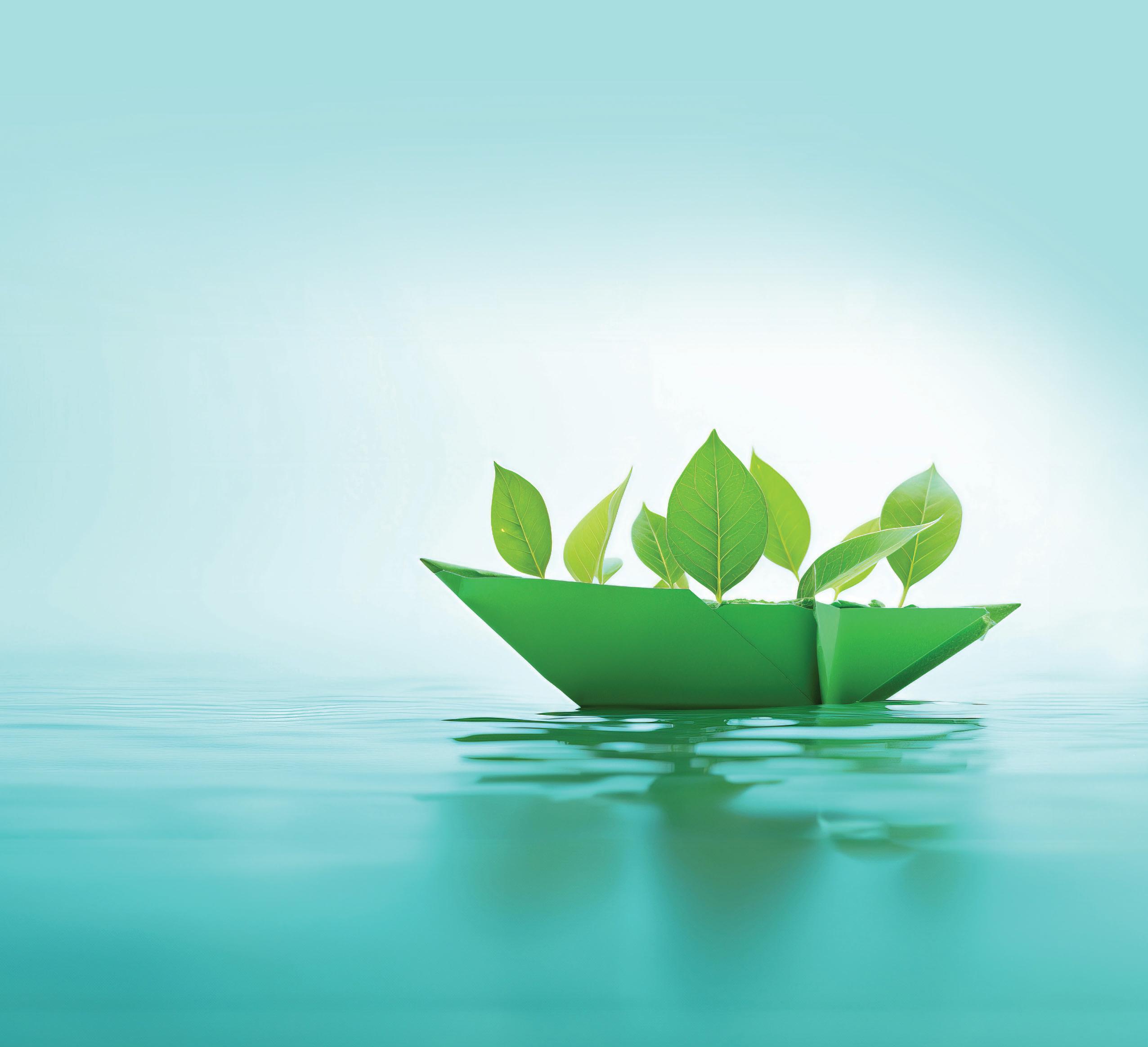





Quantum’s new F45 – Electric / Hydraulic Hybrid Power System is 60% more efficient at Zero Speed™ and recovers 80% of the energy in underway mode. Though it resembles the energy efficiencies of a sailboat, it’s designed for a motoryacht.
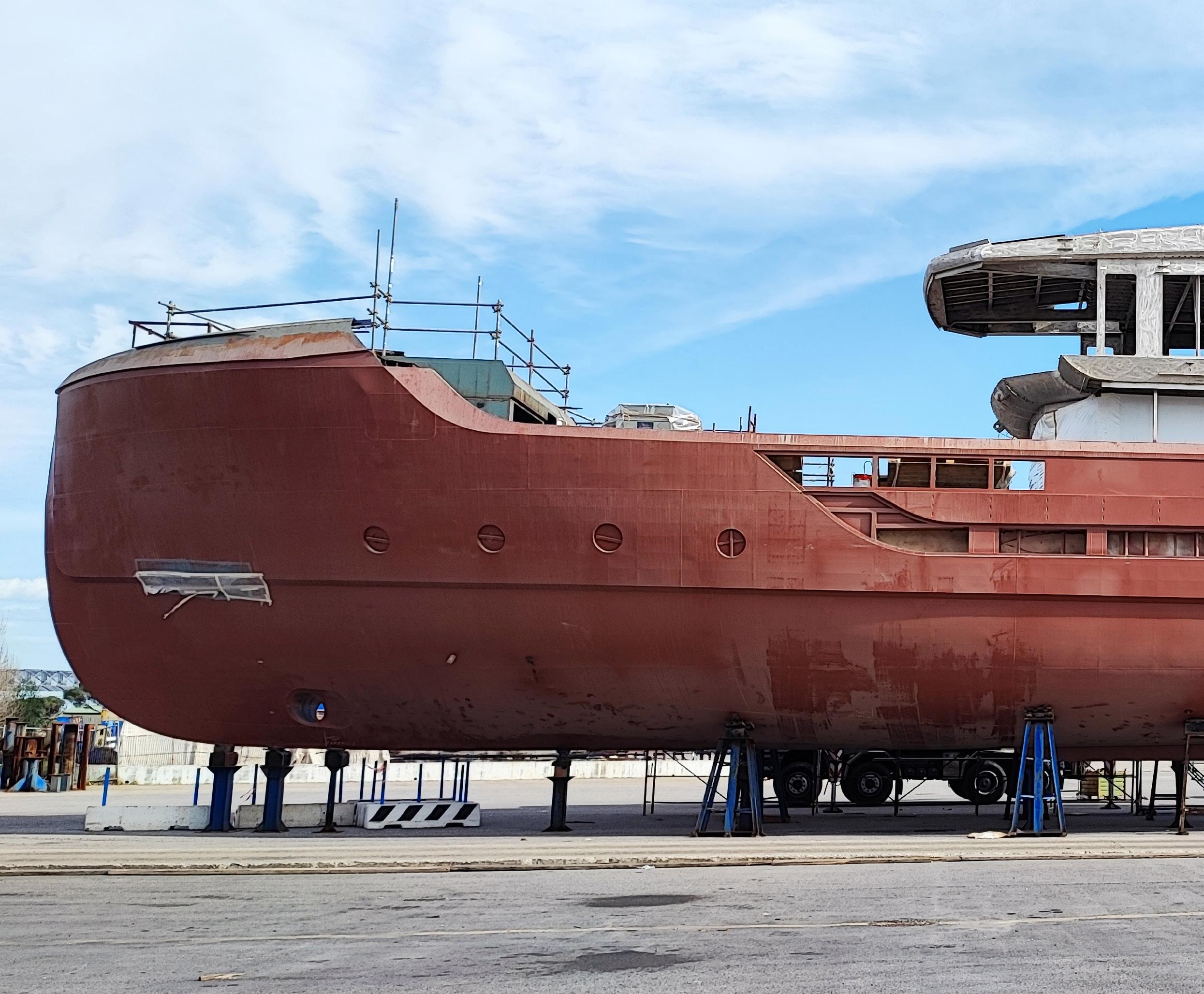
Eyebrows were raised when Italian fibreglass builder Permare announced construction had started on its first steel and aluminium superyacht. Two more Amer Steel projects followed in rapid succession. We take a closer look at the 41-metre explorer yacht, which will be the first to launch next year and the first steel hull to carry Volvo Penta’s new IPS professional platform.
BY JUSTIN RATCLIFFE

Two years ago when Permare started cutting steel on a 70-metre flagship, it represented a massive scaling up in size for the family-owned boatbuilder. The group has been building in fibreglass under the Amer Yachts brand for over 30 years and enjoys a loyal customer base, but the largest model in its composite range to date, the 36.5-metre Amer 120, is fully half the overall length and a fraction of the volume.
“It’s true we’re known for our smaller fibreglass boats, but Permare also has three refit shipyards in Liguria – Cantiere Sanremo Ship, Cantieri del Mediterraneo, and Cantieri del Ponente,” says Barbara Amerio, Permare CEO. “One refit was the complete restoration of Destiny S, a classic 1959 Camper & Nicholson, which involved rebuilding the riveted steel hull, so it’s not like we’re unfamiliar with the material and began building in steel overnight.“
However, Permare had no serious plans to start building new in steel until a satisfied refit customer approached them for the 70-metre project. That contract was quickly followed by another with an experienced client introduced by Luiz De Basto for a 41-metre explorer yacht, and a third sale for a 50-metre hull with a repeat client looking to upgrade from composite to metal. Although all are being built in rented hangars in Pisa, Permare is investing in a new state-of-the-art facility nearby that should be up and running by the end of next year (see sidebar).
Previous
Below:
Bottom:
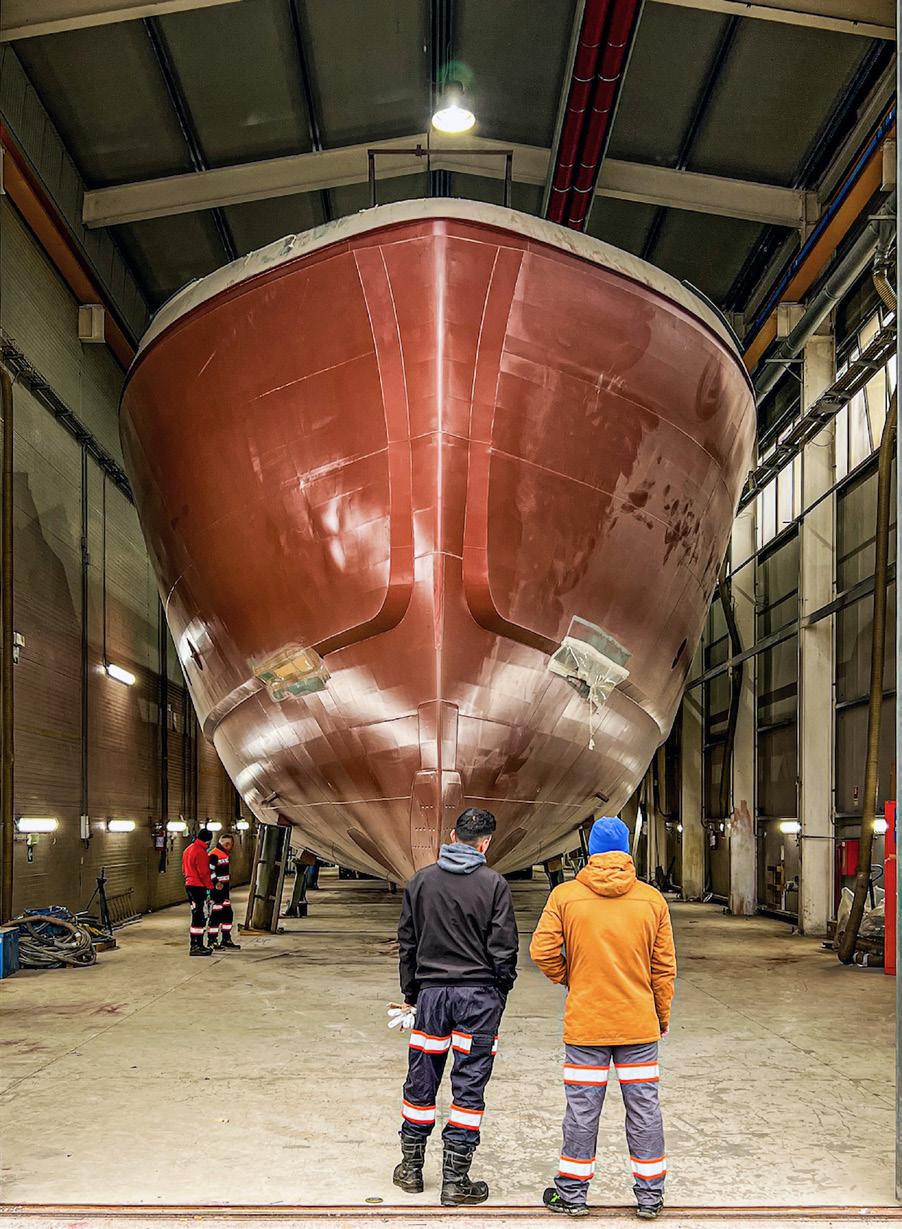
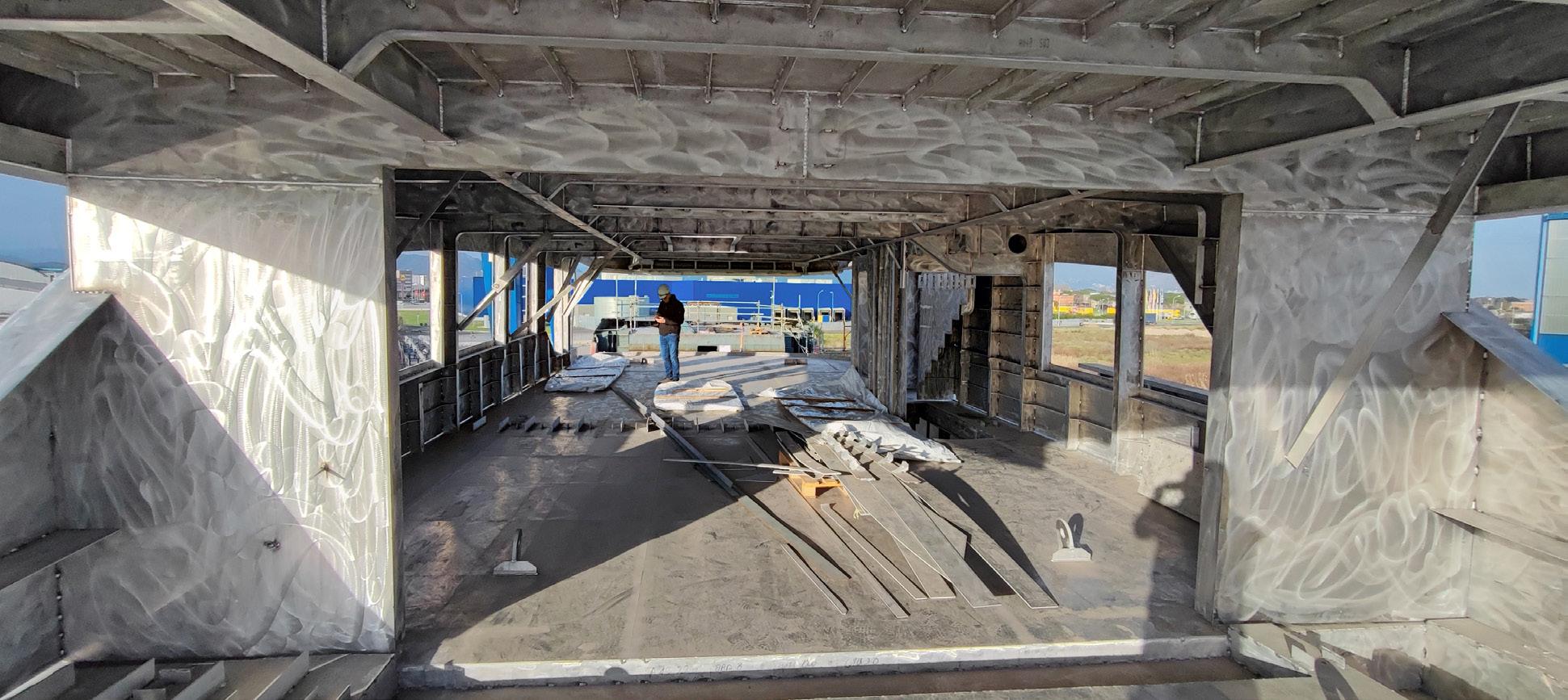
Permare was founded by Fernando Amerio in 1973 in Sanremo, Italy, to offer nautical services to a growing clientele from Liguria and the nearby French Riviera. In the early ‘90s, Permare began building boats under its own brand, Amer Yachts, and the first to launch was a 20-metre model. Today, its products have been exported well beyond the Mediterraean to the USA, the Middle East and the Far East. Sustainable solutions have long been central to the brand’s ethos and Barbara Amerio is both company CEO and and CSR (Corporate Social Responsibility) manager.
Steel is a recyclable material, but what about alternatives to fibreglass for your composite production? We’re looking into hybrid materials to replace traditional fibreglass and the Amer 120, our biggest model which will be presented this year, was designed to use less composite by replacing it with aluminium for the superstructure. This reduced the amount of fibreglass for the hull and the flybridge by four tonnes. Now we’re going a step further and introducing a third material: basalt fibre derived from melting basalt rock at extremely high temperatures and then processing it into fine filaments that are woven to create a cloth. Basalt cloth is a versatile material with a wide range of applications and provides excellent mechanical, thermal, chemical and electrical properties.
This is all part of an ESG [Environmental, Social, and Governance] study with RINA to measure the integration of sustainable principles into our corporate strategies and activities. The assessment uses a rating methodology based on a set of key indicators according to international best practices. We’ve created an international working group with the bio-resin coming from France, the PET core from Sweden, and the basalt fibre from Germany to create a bio-composite that will be a completely recyclable. We’ve already ordered the first shipment of RINA-certified basalt fibre, and the idea is to build two decks, one in fibreglass and one using basalt fibre, then make comparison tests. All this is happening in Tuscany where our mould-maker will be the first to infuse the deck of a 106-footer made from this new hybrid material. We want to be the first to develop something that works, but once we have the results we don’t plan to keep it to ourselves and will make our findings available to other builders.
Tell us more about the new shipyard Amer is planning in Pisa Navicelli. It represents an investment of around €12 million in total and the local municipality has already accepted our development plans. We’re just waiting for final approval as the building is close to the airport; if all goes well we hope to be operational by the end of 2025. It will be the production base for Amer Steel where we will build yachts from 40 to 70-plus metres, but our sweet spot is somewhere in the middle where we can still use Volvo Penta IPS propulsion. It will be a cutting-edge facility, both in terms of architecture and environmental impact, with human capital at the centre of its design. The idea is that the Permare philosophy is reflected in the building itself.
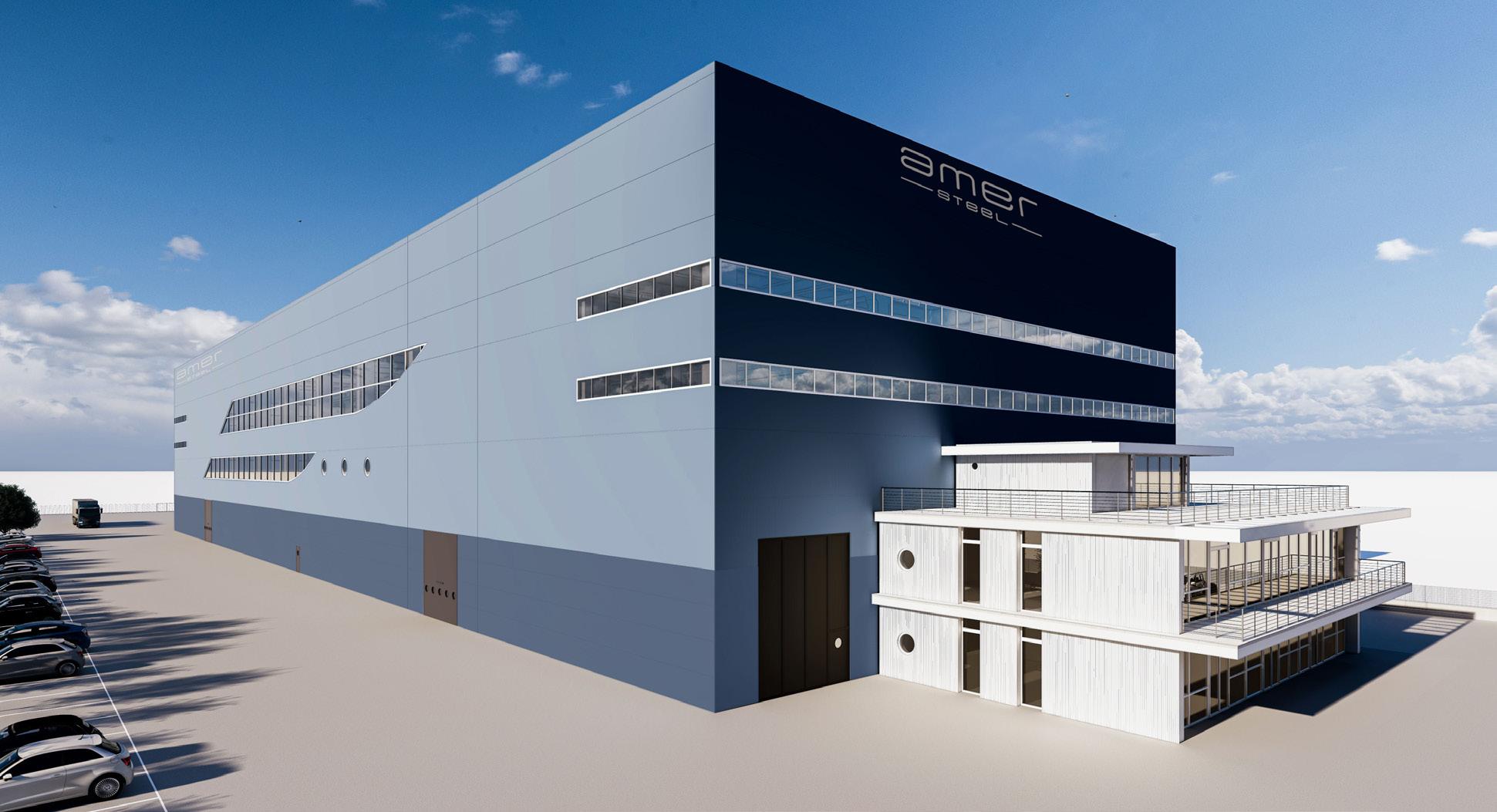
The client De Basto brought to the table is the previous owner of the 46.5-metre explorer Far Far Away, also designed by De Basto and launched by Inace in 2012. The new yacht bears a distinct family resemblance with its raised fo'c's'le and open foredeck for storing tenders, but is a much more sophisticated version of the Brazilian boat in every way. Moreover, as a full-custom Ice Class project it differs from the other two hulls in build that form part of the Amer Steel series designed by Antonio Luxardo of Optima Design.
“The owner went all over the place with Far Far Away and knew exactly what he wanted,” says De Basto. “His new yacht, which will be called Even Further, is basically a distillation of everything he liked about the old one minus the things he didn’t like, such as the Jacuzzi on the fly bridge that he never used, and I added some of my own ideas along the way.”
One such idea are the two cranes integrated into the forward bulwarks, a feature that appeared in De Basto’s 62-metre Nautilus concept for Turquoise Yachts. The two 7.5-metre tenders stored in the foredeck well are large for the size of yacht, hence the cranes have a lifting capacity of 2,500kg (one will also serve as a life-saving appliance for the rescue tender) and a reach of 7 metres. At the time of our visit to Pisa, the cranes were still being built by Mor Saverio, a specialist in the design and construction of hydraulic hardware in Brescia in northern Italy. Although it has been suppling the yachting industry with platforms, gangways and shell doors for 45 years, the brand is less well known than some other suppliers of hydraulic equipment.
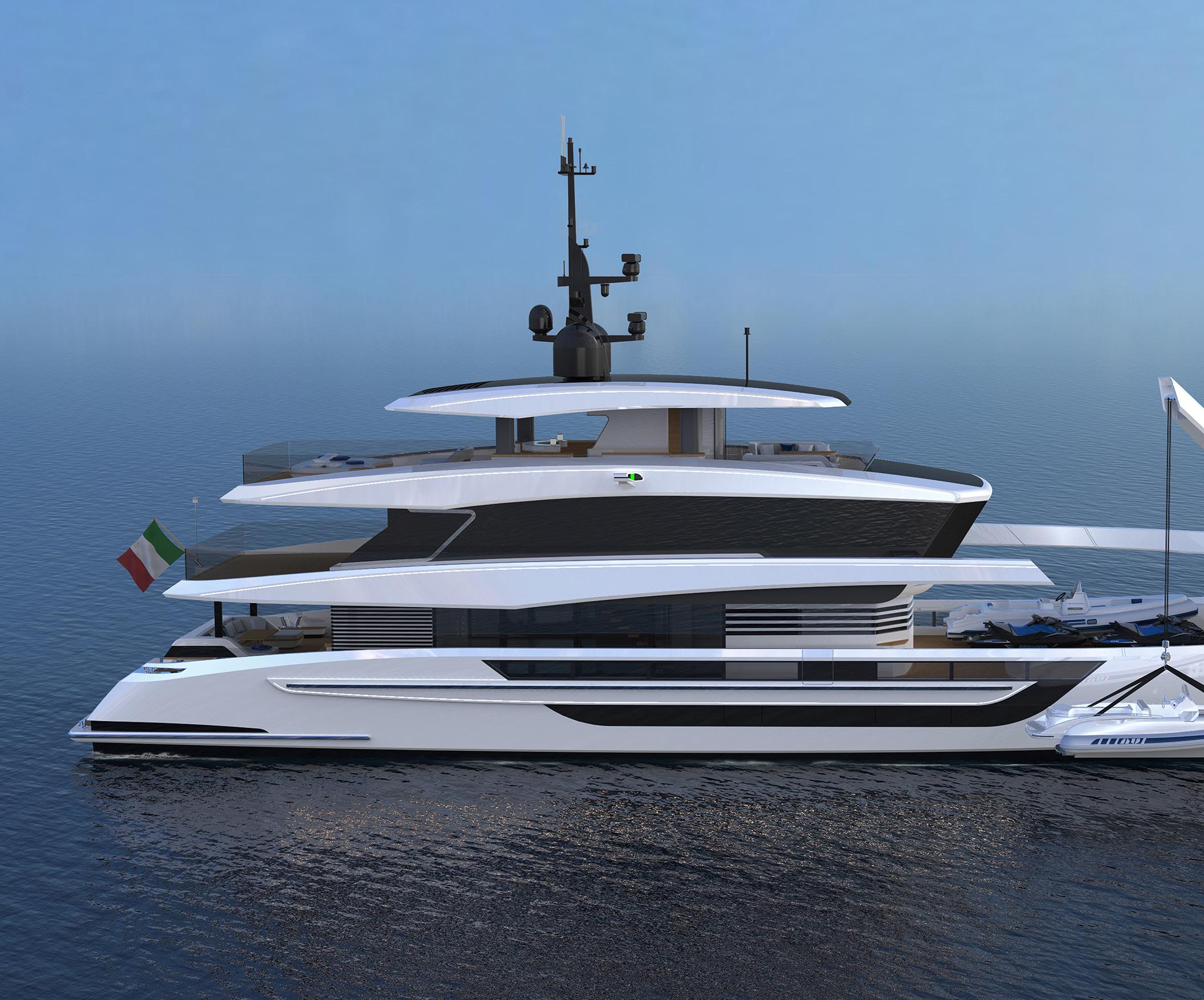
“Permare gave us a lot freedom to make certain decisions when it came to the technical design process,” says Luxardo. “For example, they did not necessarily have contacts with the best suppliers for a steel project, so we developed the interface with the right companies so we could integrate the technical components into the design from the start. If you can define the maker’s list in advance it avoids revisions down the line and improves the build quality.”
Optima Design engineered the whole yacht in 3D and optimised the the concept and hull lines by De Basto to match the common technical platform developed for the Amer Steel series. The studio has also moved eight of its staff into an on-site office in Pisa to oversee the construction.
“We prefer to have a team on site,” says Michele Zignego, head of engineering at Optima Design. “Decisions have to be made on a daily basis and the idea is to keep as close to the original design and engineering as possible. When you’re dealing with multiple suppliers and subcontractors, it gives us more executive control.”
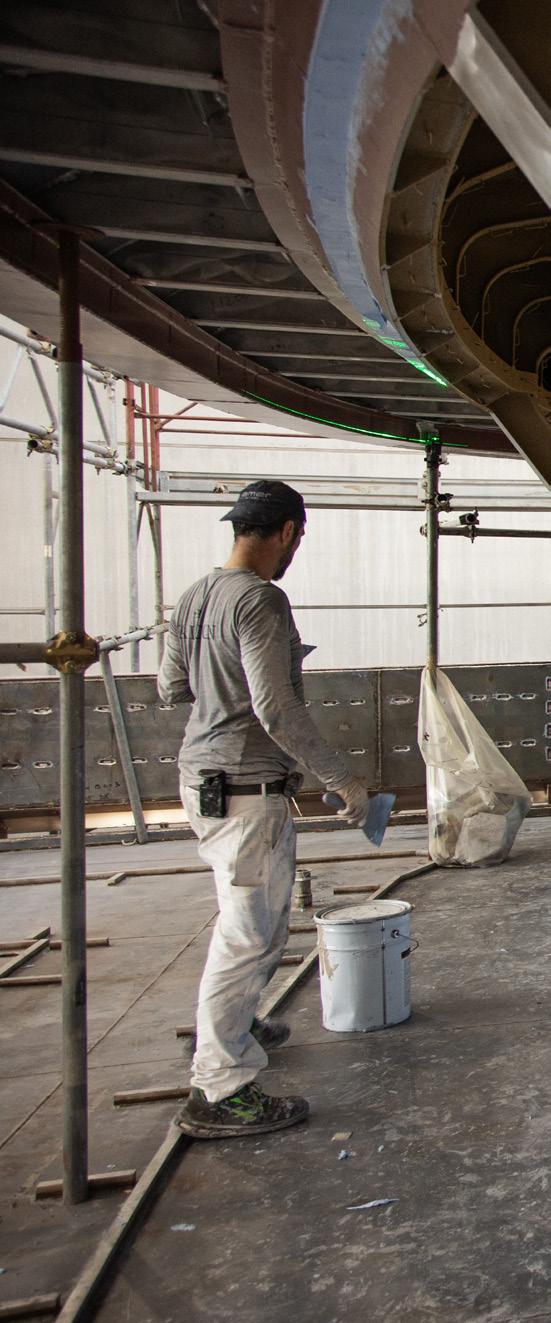
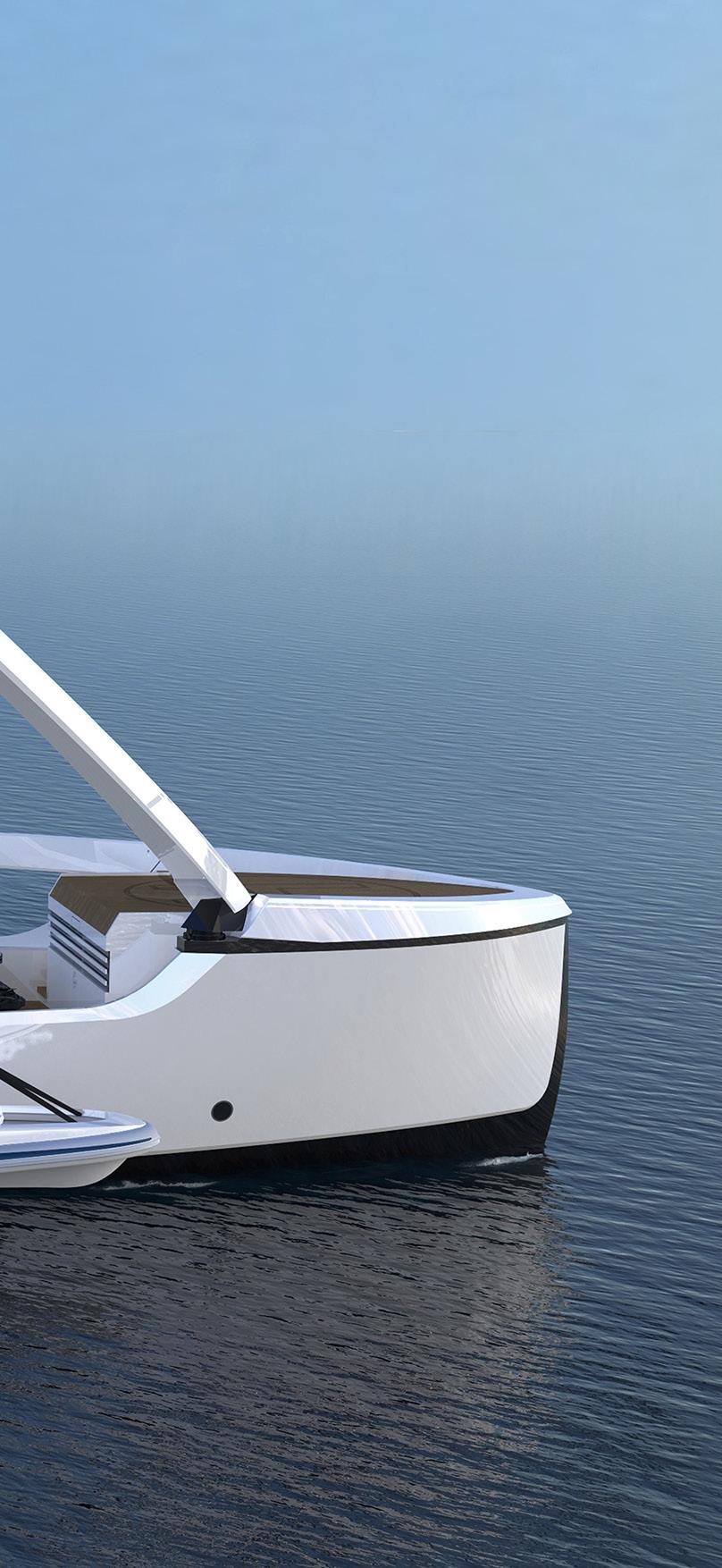
“Permare gave us a lot freedom to make certain decisions when it came to the technical design process.”

Control was especially important as the 41-metre explorer will be the first steel hull to be equipped with Volvo Penta’s new IPS40 professional platform for superyachts up to around 55 metres in length. Permare is accustomed to equipping its composite boats with IPS propulsion, but the latest iteration has a very different configuration and added another level of complexity. Volvo Penta was still engineering the concept when construction started and will not start series production until next year.
The new IPS system is powered by not one but two Volvo Penta D13 engines, which are paired with Selective Catalytic Reduction (SCR) units to comply with the IMO Tier III standards. Based on average operational profiles, the dual-power input is designed to offer increased flexibility, modularity and sustainability. The platform is also pre-prepared for a mix of power sources, from combustion engines running on renewable fuels to fully electric or hybrid solutions (see the article Going Pro on how Volvo Penta developed the system in this issue of How to Build It) .
The four engines, each with their own SCR unit, occupy a slightly smaller footprint than a pair of bigger engines with drive shafts, but they still required a fresh look at the layout of the engine room to ensure – in Zignego’s words – “everything fit everything into a compact space on a compact yacht.” In addition, the IPS system was originally designed for semi-displacement and planing boats and you can’t just copy and paste it onto a steel displacement hull. Unlike traditional shaft drives, the pods have to be mounted parallel to the hull to ensure all the available power is used to drive the yacht forward efficiently, but the buttocks of a displacement hull slope up towards the stern. To create a horizontal surface for mounting the pods, Optima Design had to design a hydrodynamic ‘blister’ under the stern and shared its CFD data and tank test results at MARIN with Volvo Penta so it could finalise the through-hull interface.
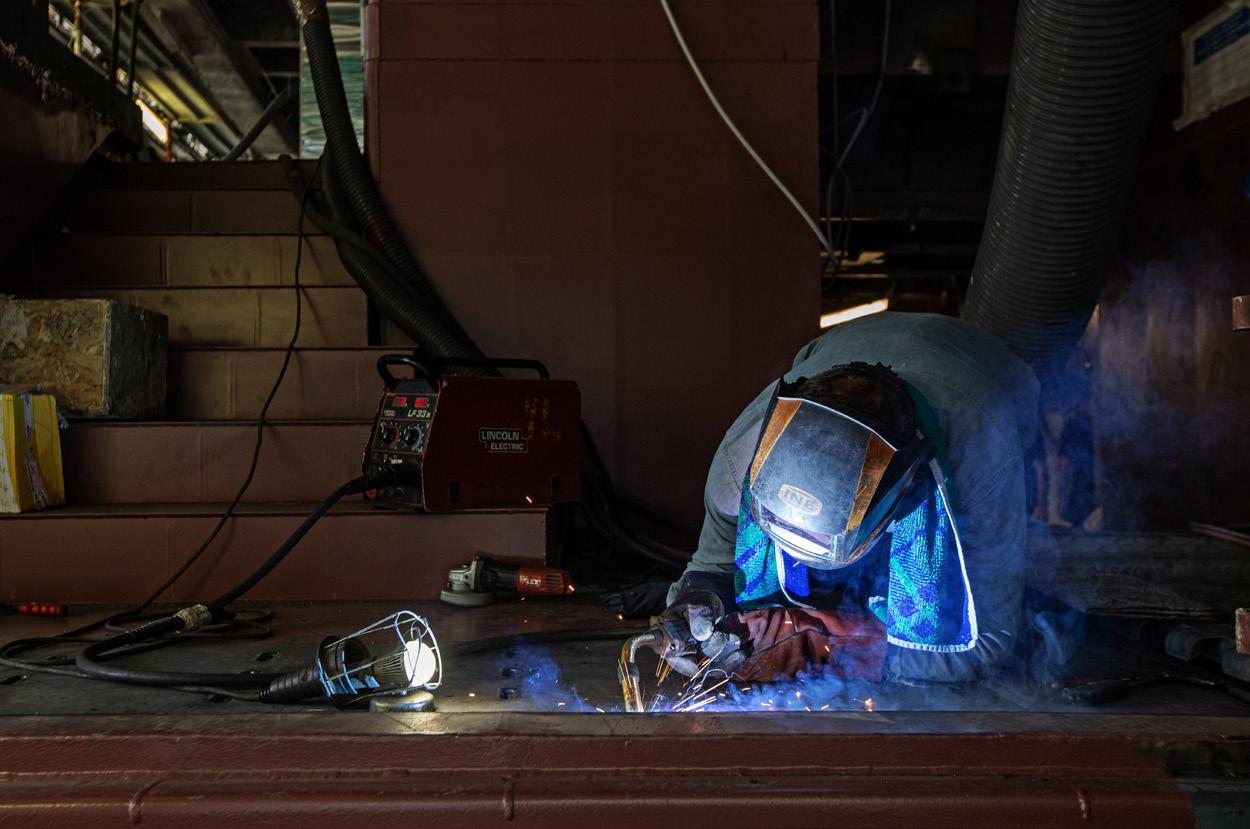
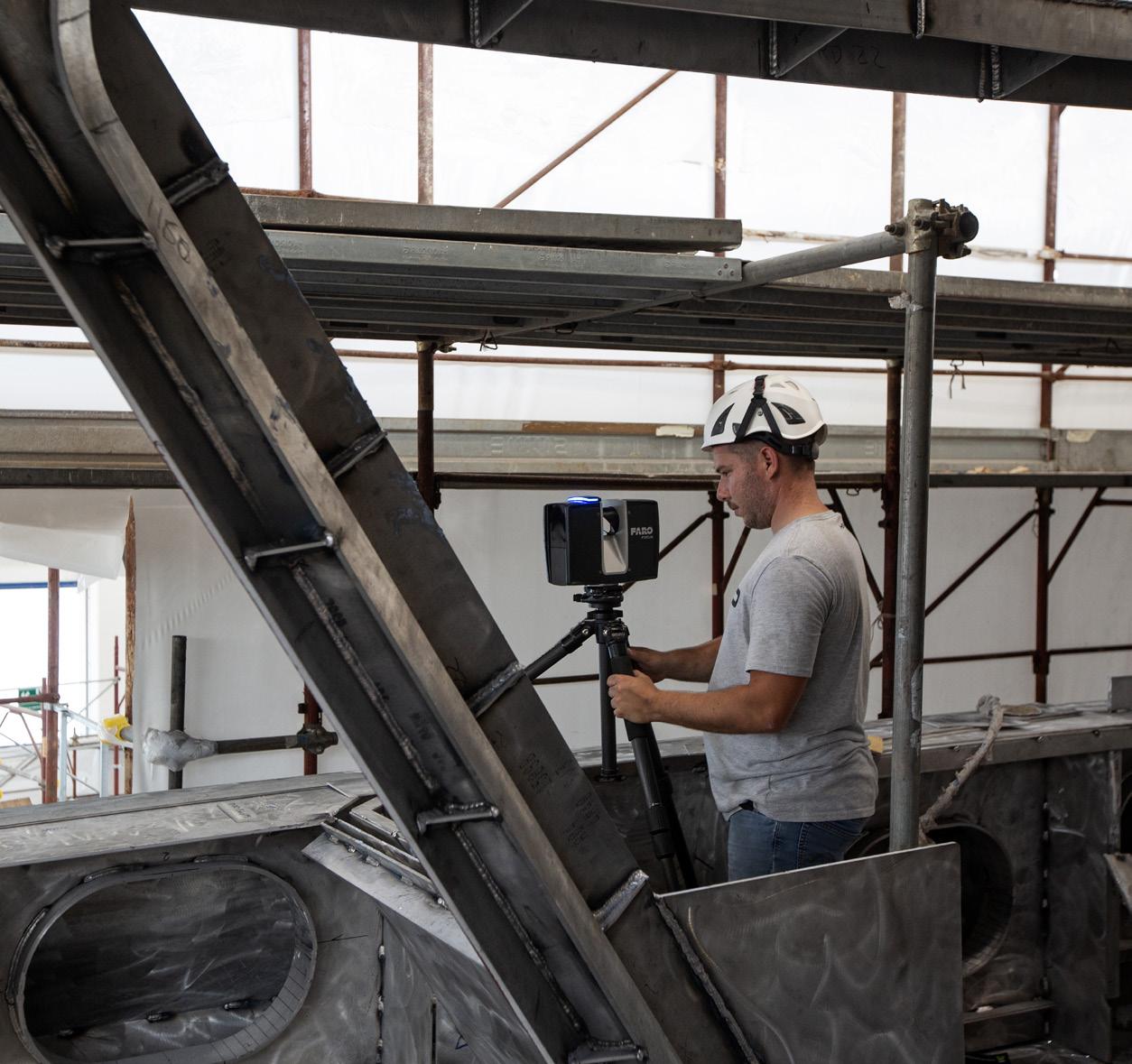
Amer yachts customarily have air-conditioned engine rooms and the Amer 41 Steel is equipped with a separate chiller system for the engine room. Ordinarily, supply and extraction fans take care of the combustion air intake and fresh outside air to dissipate heat from engines, boilers, generators and electrical equipment. This can involve very large amounts of air with huge fans and ducting systems. According to ISO 8861 the base for the ambient outside temperature is set at 35°C with a temperature rise from the passing air of 12.5K. But If you’re sailing in an area where the outside air temperature is higher or cruising in an icy area with sub-zero temperatures – as the Ice Class explorer is likely to do – a different approach is needed.
“Instead of big fans we have a dedicated chiller and an RCU [Recycled Air-handling Unit] that controls the air circulation in the engine room, but also the pressure, temperature and humidity level, which brings multiple benefits,” says Luxardo. “Everything lasts longer and runs better because you’re removing the humidity and most equipment prefers cooler air; watermakers are very sensitive to heat, for example. At the same time, you’re getting rid of those big, noisy air ducts and you can see that smaller trunking means we have more usable space in the main saloon.”
Amer Yachts has a loyal client base that tends to move up in size with the brand, but there comes a point when that means building in steel or aluminium and they have to look elsewhere. By establishing Amer Steel, the strategy is to keep those customers in the family fold.
“It may be a client looking to upscale from fibreglass, or someone who has already owned metal yachts and has a specific idea for something a bit different,” concludes Amerio. “We’re a boutique shipyard in some ways because we build in small numbers, but that means we can also be very flexible if owners come to us well prepared with clear ideas about what they want.”


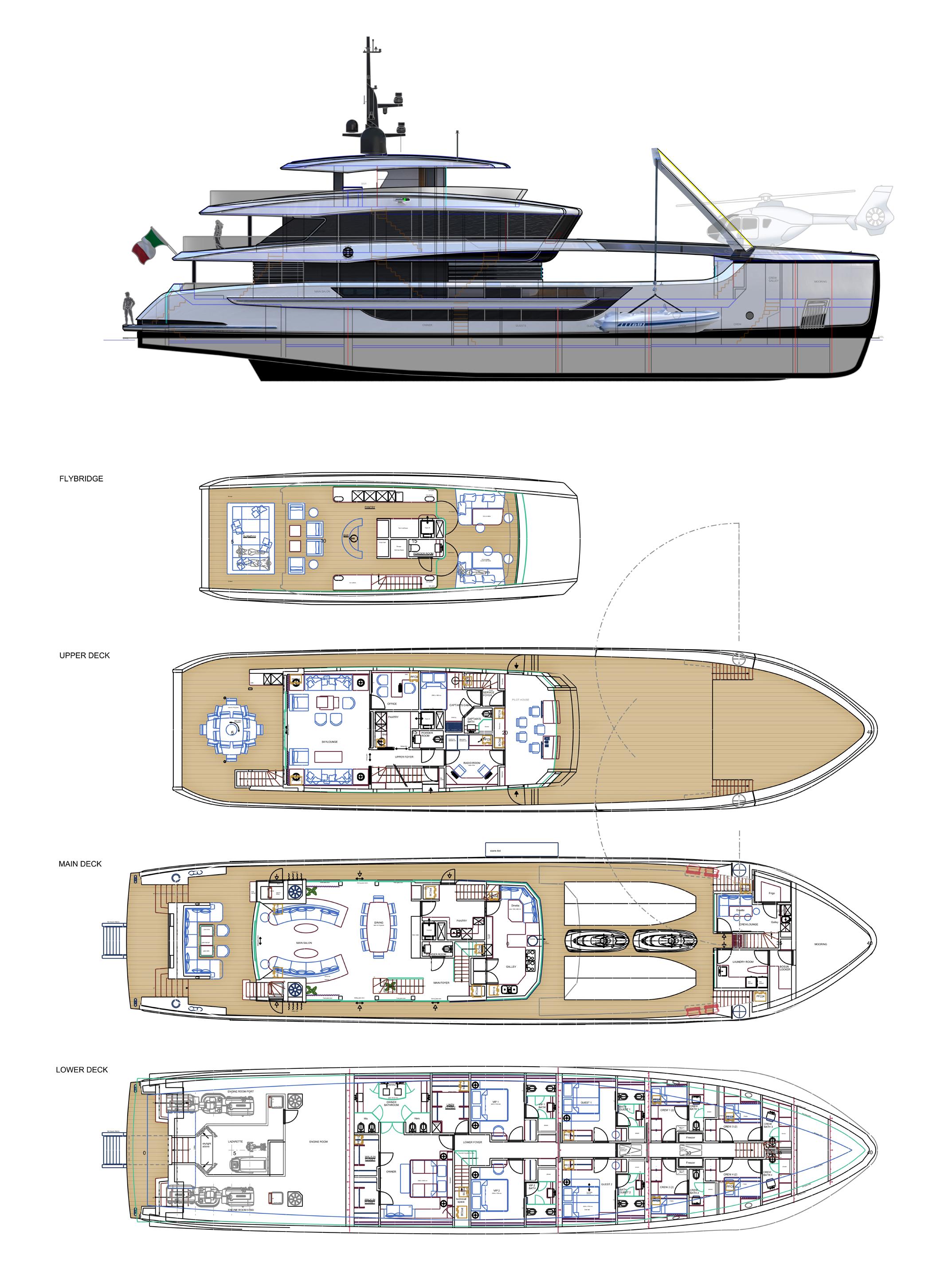
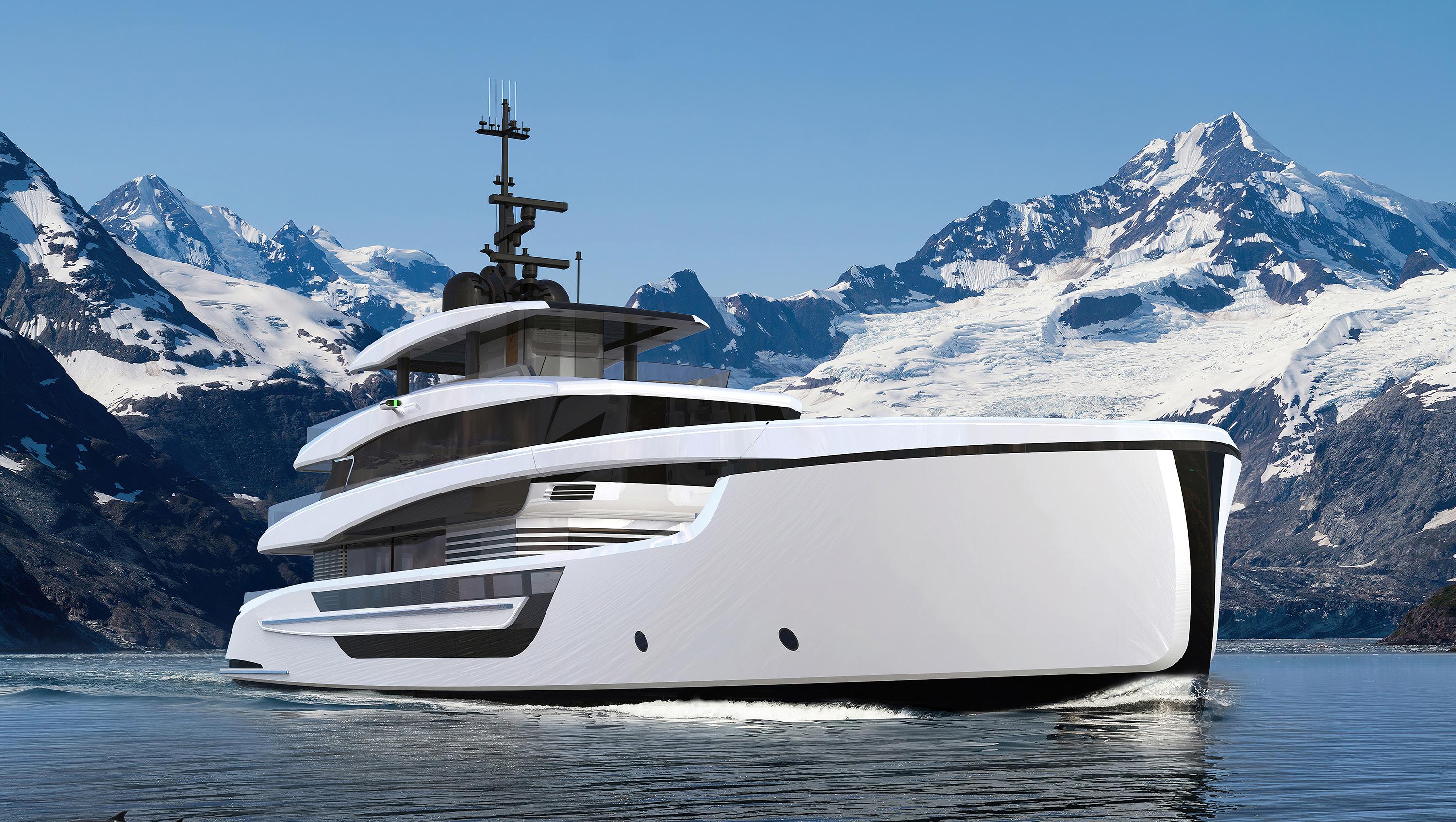



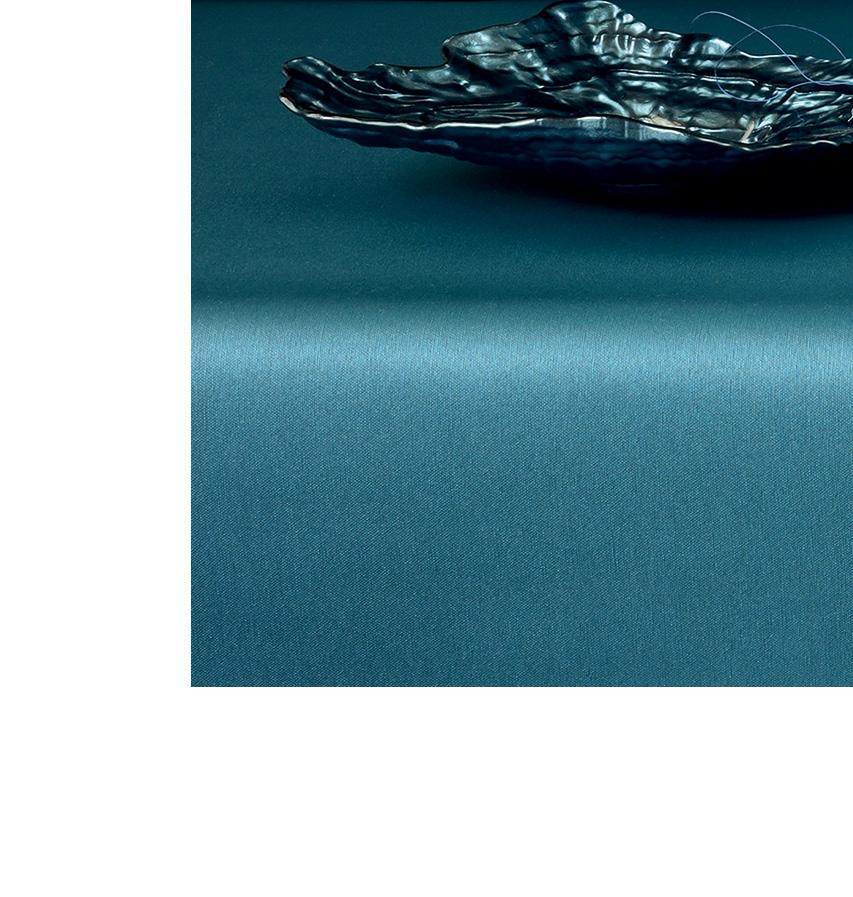



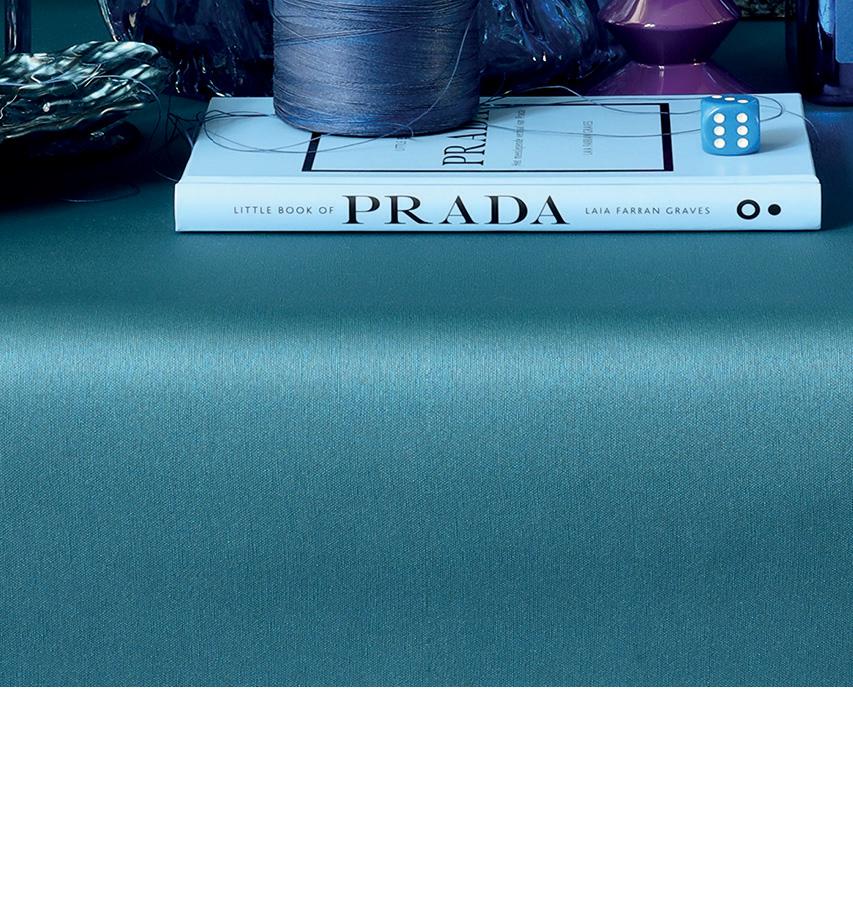


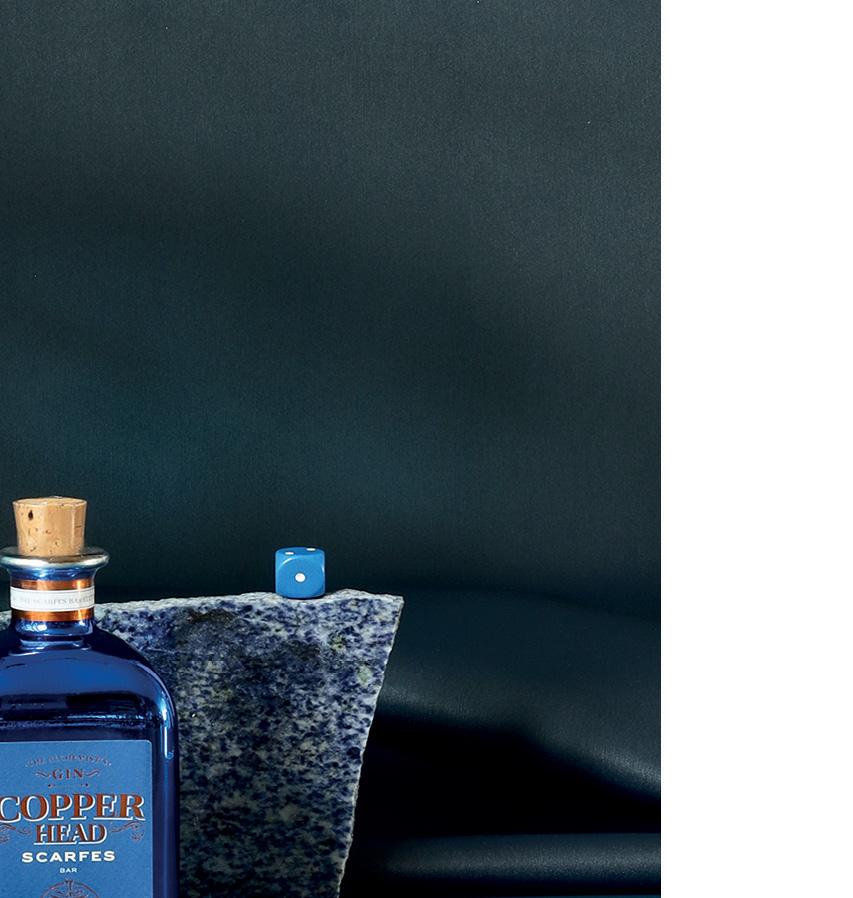
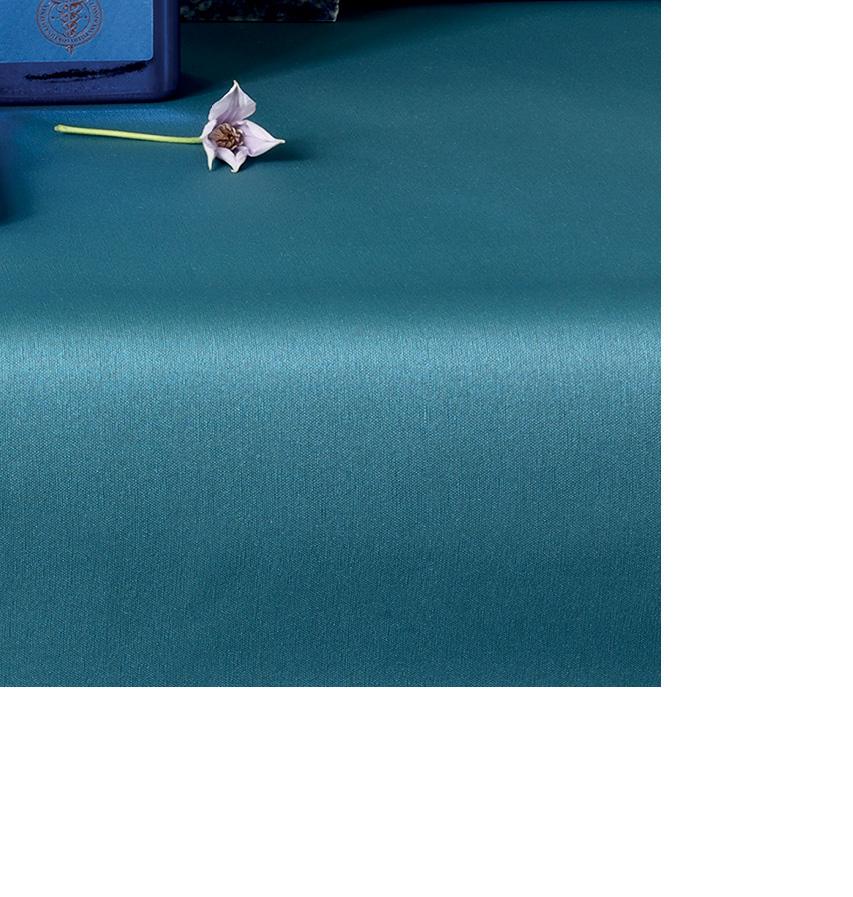

CMC Marine in Italy is the leading supplier of electric stabilisation, thruster and steering control systems for yachts over 30 metres in length. Well into a three-year investment programme and with its 20th anniversary approaching, we took the opportunity to visit the company’s production plants near Pisa in Tuscany.
BY JUSTIN RATCLIFFE
When naval engineer Alessandro Cappiello set up CMC Marine in 2005, he was already well known for his work as head of Rodriquez Marine Systems on motion control systems for passenger vessels and fast ferries. Initially, he transferred his experience of hydraulic stabilisation systems to large yachts, but soon realised that the time was right to move from hydraulic to electric.
“The traditional mindset was that only hydraulics could provide the kind of torque needed for proper stabilisation,” he says. “But electrically-actuated systems are quieter, faster, more energy efficient and easier to install than hydraulic ones. The ultimate outcome is more comfort for owners, so it was the right idea at the right time.“
The world’s first electrically-actuated stabiliser fin, the Stabilis Electra was launched in 2008. AC-powered and designed to offer a higher dynamic response with less noise and power consumption, the first deliveries were to Sanlorenzo and Azimut. It went on to win a DAME Award and a European patent. From being the only company supplying such a product, in subsequent years CMC saw all its main rivals scramble to develop their own versions.
Today, CMC electric stabilising systems are installed on yachts from 12 to 70 metres and the company enjoys a 68 percent market share of yachts built in Italy above 24 metres. CMC Marine Ltd in the UK is also making inroads into the tough northern European market and recently signed off its first new-build – as opposed to refit – project with Feadship on a 50-metre yacht. Thanks in part to the postpandemic yachting boom, the company saw its turnover more than double between 2020–23 from €15 million to €33 million. Determined to maintain that upward momentum, at METSTRADE last year it announced a €10 million investment and expansion strategy spanning three years and centered around product innovation, production capacity and market offering.
“Electrically-actuated systems are quieter, faster, more energy efficient, and easier to install than hydraulic ones.”
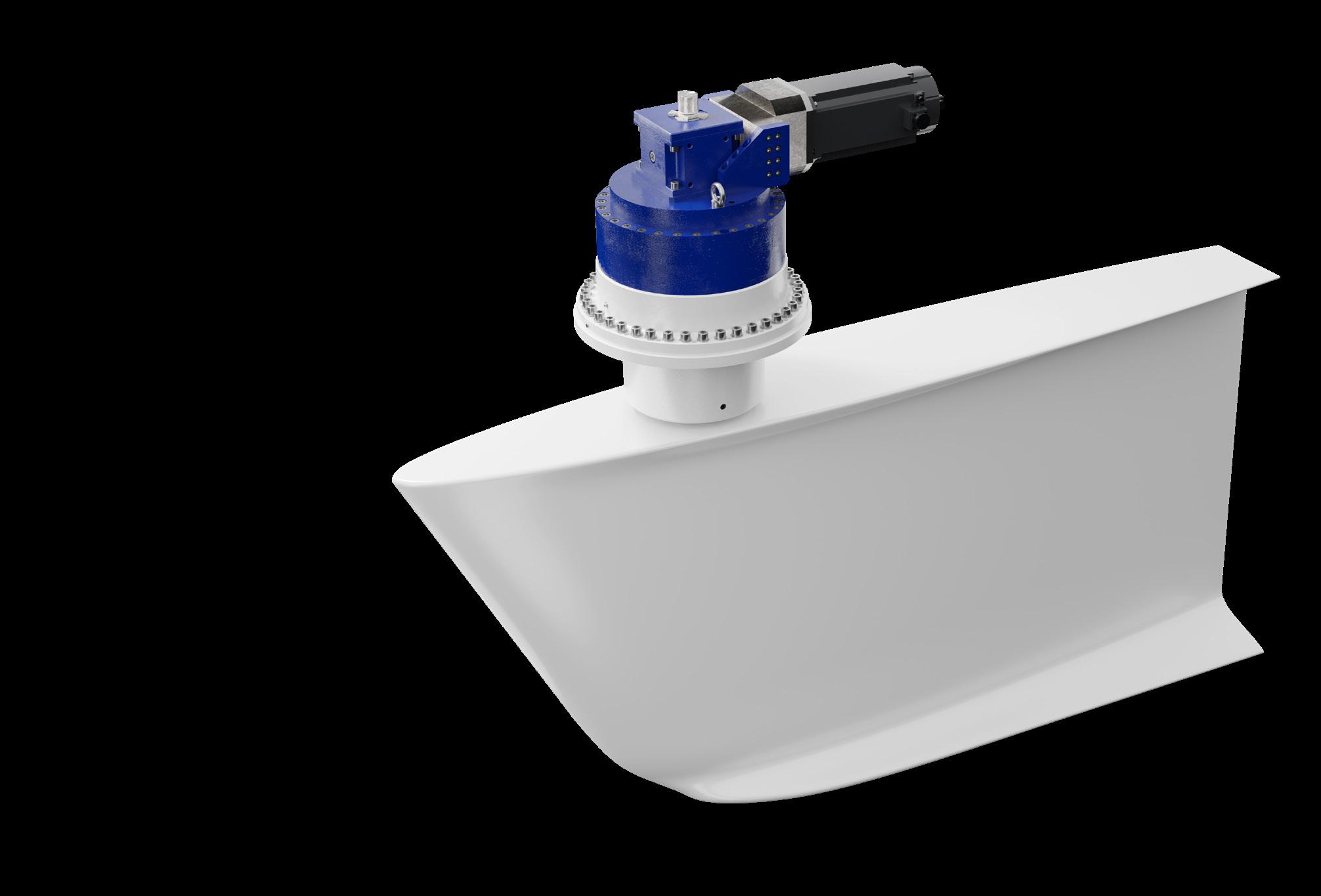
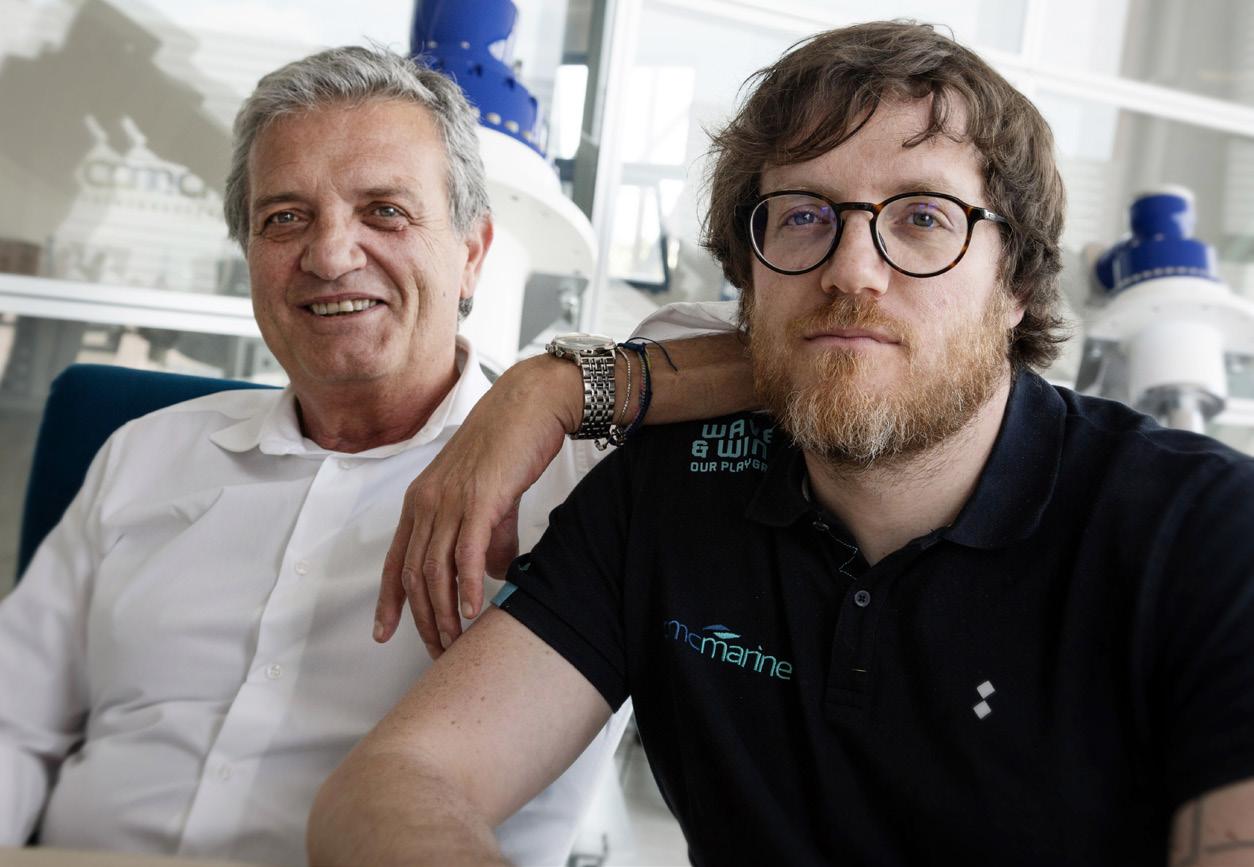
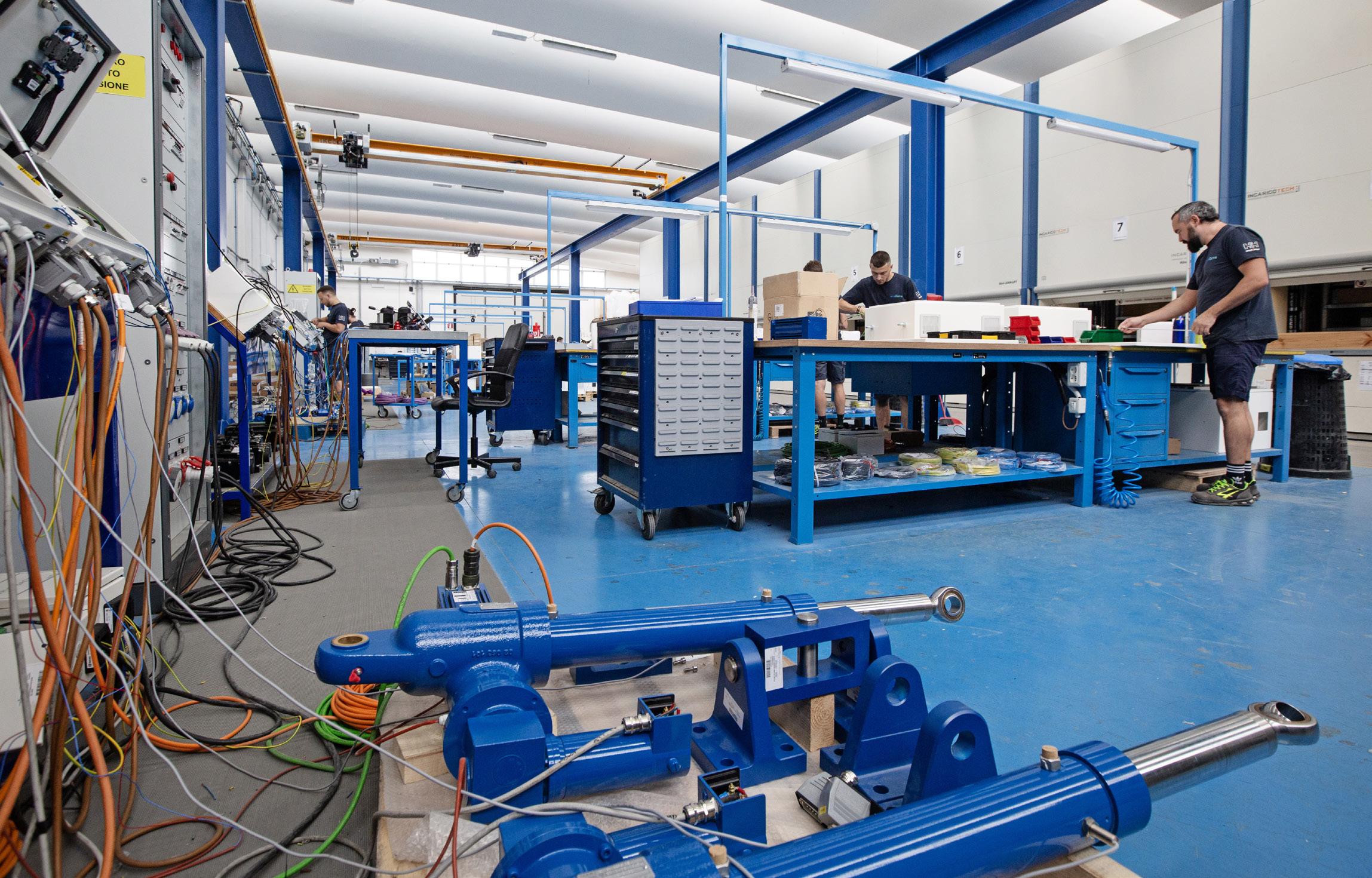
“Innovation has always been a founding pillar of CMC Marine and about five percent of revenue is poured back into R&D projects,” says Pietro Cappiello, Alessandro’s son and company vice-president. “Technological developments move very fast, so we’re constantly working with academic institutions and our technical partners to make our systems more sophisticated and attuned to the needs of the market.”
A portion of the multi-million-euro investment has gone into growing the R&D team based in Milan and bringing in new competencies such as CFD engineers. This has led directly to the development of the new fin shape presented at the Cannes Yachting Festival with a concave ‘fishtail’ trailing edge that improves stabilisation at anchor without increasing surface area or sacrificing performance under way. By upgrading its digital tools and simulator software the company is probing deeper into other appendages like canards and foils to enhance all-round motion control and reduce the accelerations that induce discomfort at sea.
Updating the patented control software, which is developed exclusively in-house, is the focus of ongoing development. CMC’s Dia-Log user interface and control system, for example, offers adaptive mode whereby the fins are controlled according to roll signals, wave frequency and heading so it can ‘predict’ the sea state and pre-load the stabiliser fins. After adding the Directa and Dualis range of steering and thruster systems to its line-up of fins, the next step was to develop algorithms, processors and motion sensors that permits all three to ‘talk’ to each other.
The resulting Argo system allowed the autopilot to be in constant communication with fins, rudders and thrusters, so that instead of fighting each other they work together to improve route stability, fuel efficiency and onboard comfort while reducing the stresses on the fins and rudders. One of the first yachts to be equipped with Argo was the Azimut Grande Trideck back in 2020.
“Design trends like big beach clubs are changing block coefficients and how hulls behave in the water, which can affect course keeping, especially in following seas,” says Pietro. “We have to keep tweaking our control software to keep up with these developments.”
“The Dutch pocket superyacht market is experiencing an exciting period with surging demand.”
Increased integration originally focused on its own products, but the company is broadening its market share by fostering strategic collaborations with third-party suppliers. An enquiry from Benetti to combine CMC thrusters with Dockmate’s low-speed manoeuvring system, for example, led to a joint R&D project to simulate integration in the laboratory. As a result of this synergy, the owners of two Benetti yachts can use their Dockmate TWIST wireless remote control to manage all the onboard manoeuvring systems. CMC has also announced a thirdparty version of its Argo system.
A new collaboration is the integration of CMC systems with Furuno Multi-Function Displays (MFDs) and chartplotters using its DALI (Display, Assistance & Logging Interface) system. End users gain access to functionalities such as monitoring fin movements and performance, selecting operating modes and parameters and accessing system information and alarms directly from their Furuno displays. For yachts equipped with CMC’s Directa steering, rudder positions and operating modes can also be managed. The company is due to announce similar agreements with Raymarine, Garmin and Simrad.
Most recently, CMC announced a strategic partnership that combines its fin stabiliser technology with Dometic’s Optimus electric steering for yachts up to 33 metres in length. Access to the Dometic communication protocols will allow the integration of the Optimus steering system into CMC’s Argo control algorithm so the fins can work together with the rudders. Additionally, the steering angle will be displayed in CMC’s DIA-LOG information system.
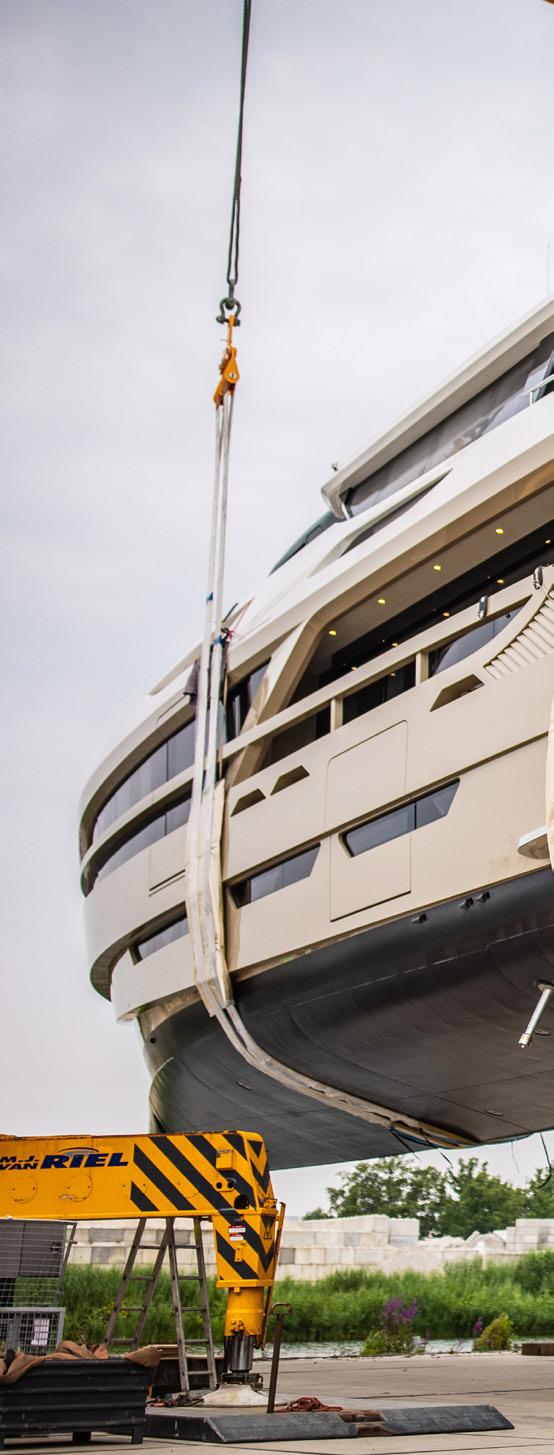
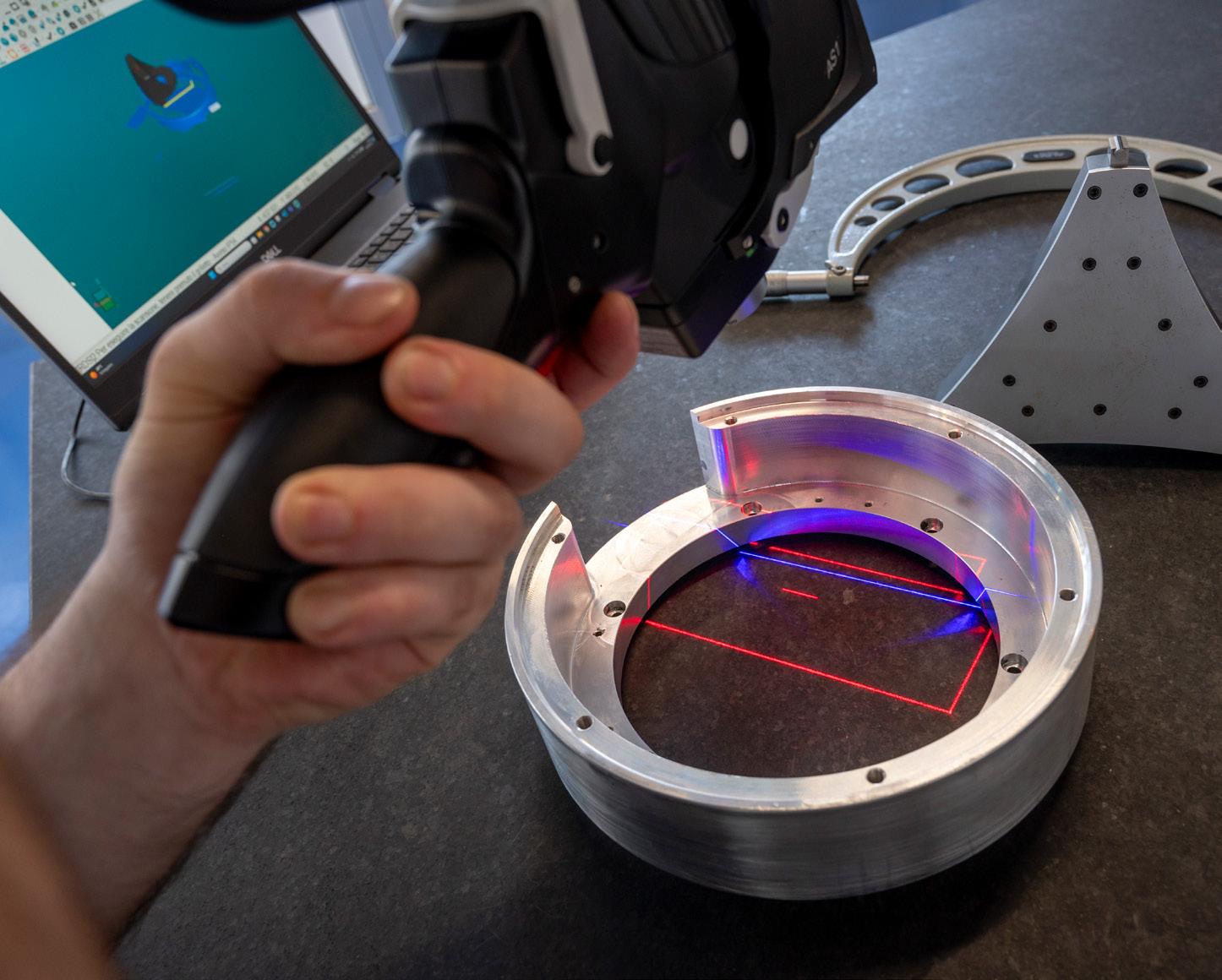

In addition to its R&D office in Milan and two production plants in Tuscany, last year CMC Marine UK (set up in 2018 together with CMC Marine USA) opened a new facility in Poole covering 6,000 square metres. Headed up by Sam Crockford who has a proven track record across the commercial and yacht sectors, the team in Poole works closely with northern European clients, including Sunseeker in the UK, Van der Valk, Moonen and Mulder in the Netherlands, and Conrad in Poland, among others. With warehousing to stock spare parts and complete systems for faster and more complete service needs, this new facility serves as the base for an expanding team that can respond rapidly to requests in northern Europe and beyond.
“The Dutch pocket superyacht market is experiencing an exciting period with surging demand,” says Crockford. “In this dynamic landscape, we’ve calculated that our systems are installed on 66 percent of the 30- to 40-metre yachts currently under construction in the country – quite an achievement considering we entered the Dutch market with our first order from Moonen in 2018.”
Additionally, a new production site in Salerno near Naples began operations at the start of this year. Covering 10,000 square metres and encompassing three industrial sheds, the new facility will significantly boost production by bringing mechanical component manufacturing in-house while contributing to the company’s ongoing expansion strategy.
“The Salerno facility is a vital step in our growth plan,” says Alessandro. “We had outgrown our assembly plants in Tuscany and needed more space, but as well as increasing production capacity I wanted to safeguard the supply chain, have direct control over costs, and be able to better supervise quality control throughout the whole manufacturing and testing process.”
CMC has continually and consistently expanded its product range in line with owner expectations. The newest additions to the Stabilis Electra range are the LR 180 and LR 250 that feature upgraded algorithms for improved performance and latest-generation Mitsubishi electronics. The 180 has a fin of 3.9 square metres coupled with a 15kW actuator for yachts over 50 metres, whereas the 250 offers a 6.5 or 7-square-metre fin and 30kW actuator for yachts over 70 metres. Squarely aimed at superyachts above 500GT, as a four-fin configuration these additions to the range can serve the stabilisation needs of the largest superyachts.
A promising new market segment for CMC is the commercial one. It has been the distributor contact for Wärtsilä since 2022, covering the Finnish technology group’s mid-sized waterjet series for fast workboats and high-speed ferries as well as yachts. But Alessandro foresees other opportunities and is angling for more of a foothold in the sector: “Technologies for superyachts, passenger vessels and work boats are converging,” he says. “I came from the world of fast ferries and we have all the tools to be successful in this market.”
On the larger yachts, customisation continues to be a key ingredient of CMC’s offering. When Rossinavi received a request for an auto-docking feature on a sub-500GT project, for example, CMC was able to calibrate its stabilisers, thrusters and rudders to work with the Kongberg system. Similarly, when a shipyard in France received a late request for DP capability from the owner of a 50-metre explorer yacht already in build, the company provided an integrated systems solution. Although CMC has focused on superyachts since its inception, it has been careful not to exclude smaller boats. Its superlight, foam-filled Waveless STAB already caters for high-speed hulls as small as 12 metres, but we can likely expect to see other solutions as part of CMC’s wider strategy to increase its market share.
“Today the market has changed and owners of smaller boats are also demanding stabilisation systems, which can make a huge difference in terms of enjoying your investment regardless of size,” says Pietro. “That doesn’t mean we can just downsize our existing products, because the rules are different and smaller boats generally travel less and spend more time anchor.”
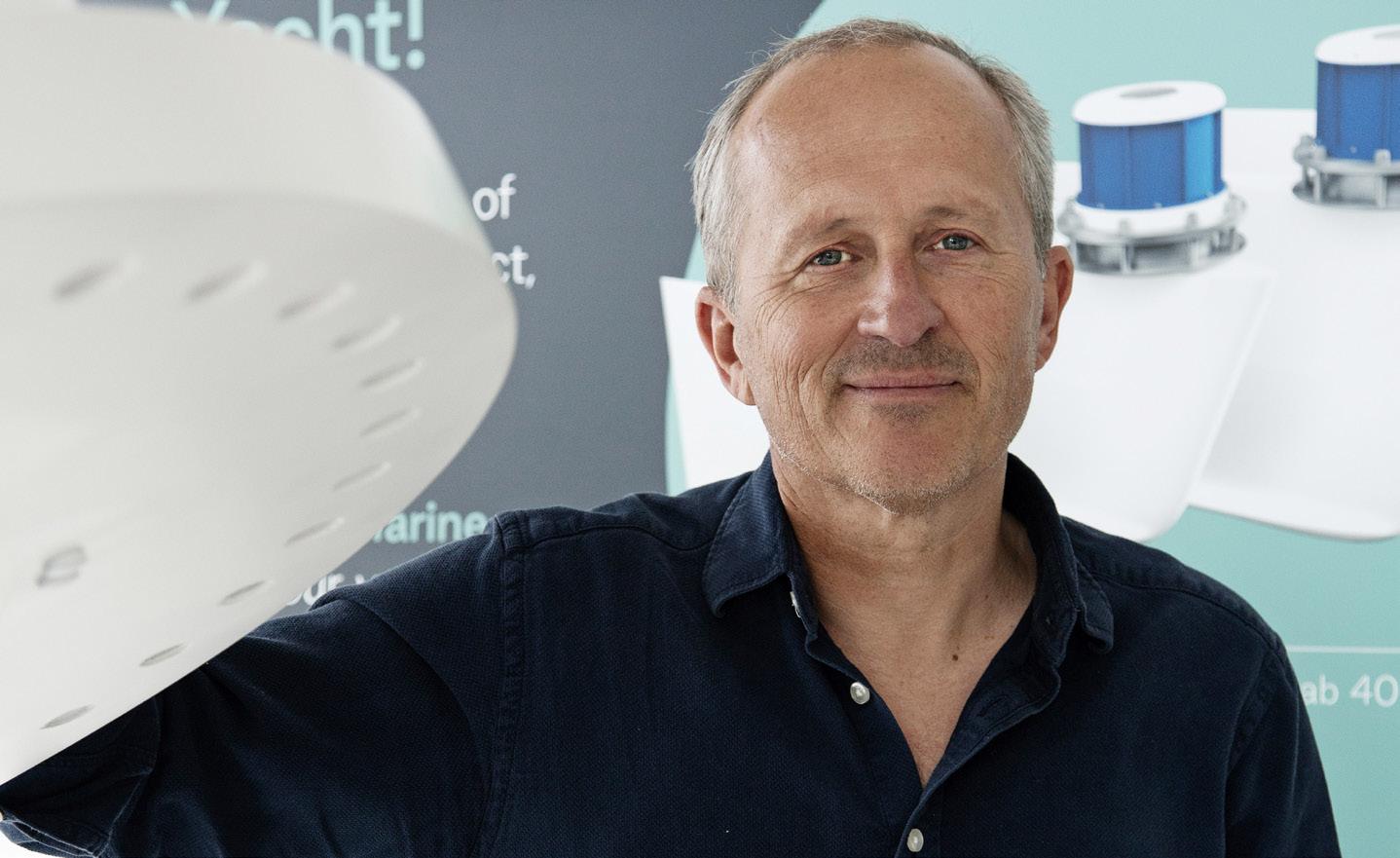
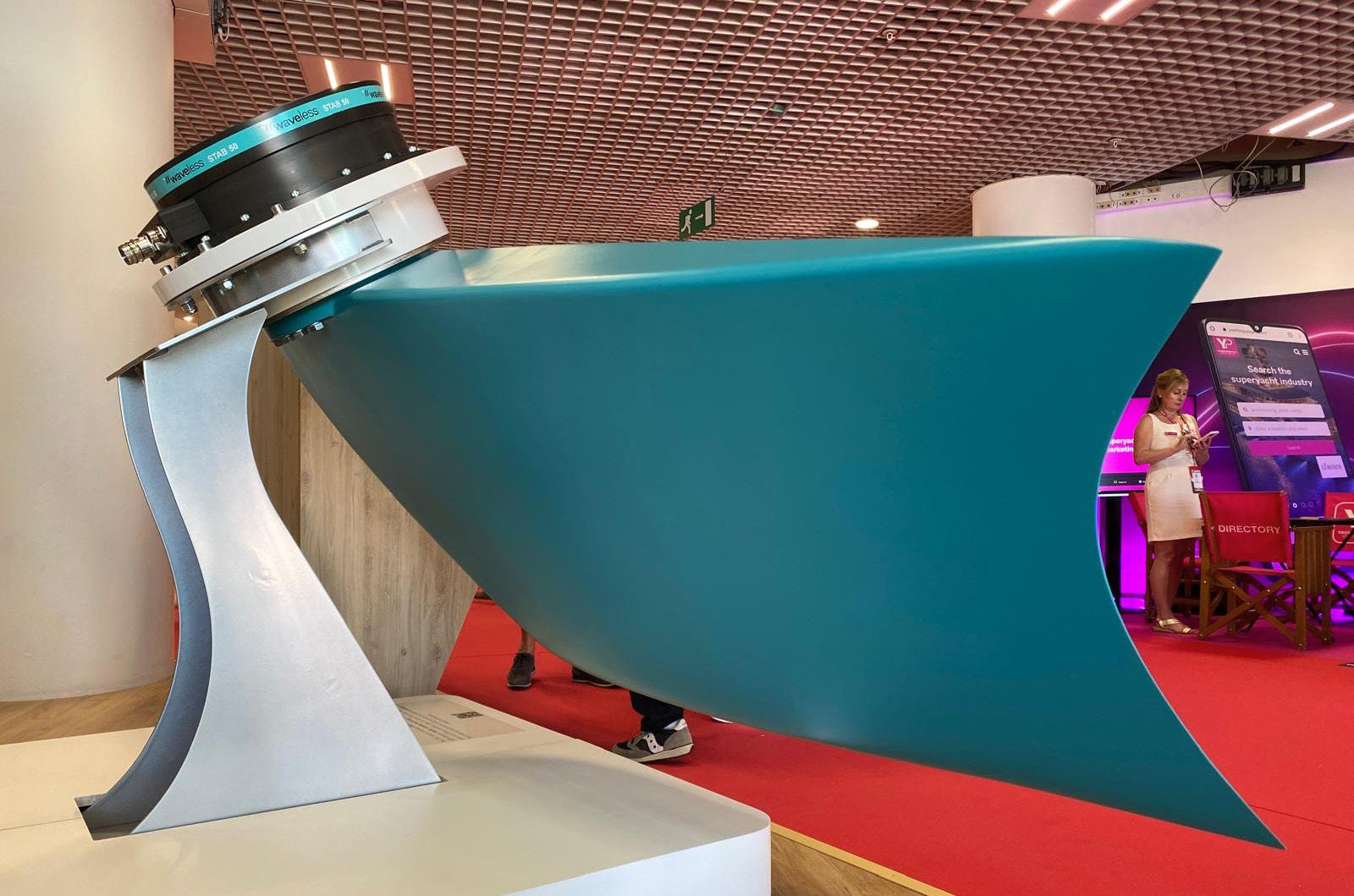
Clockwise from right: CMC also produces rudders for integration with its Argo system; the new factory in Salerno; a new fin design with a scallop-shaped trailing edge premiered at the Cannes boat show; Sam Crockford, MD at CMC Marine UK.


Below: The electrics and circuit board cabinets are all assembled in-house.
Bottom: Quality control checks during the testing process.
Right: Measuring tolerances of the tunnel for a CMC bow thruster.
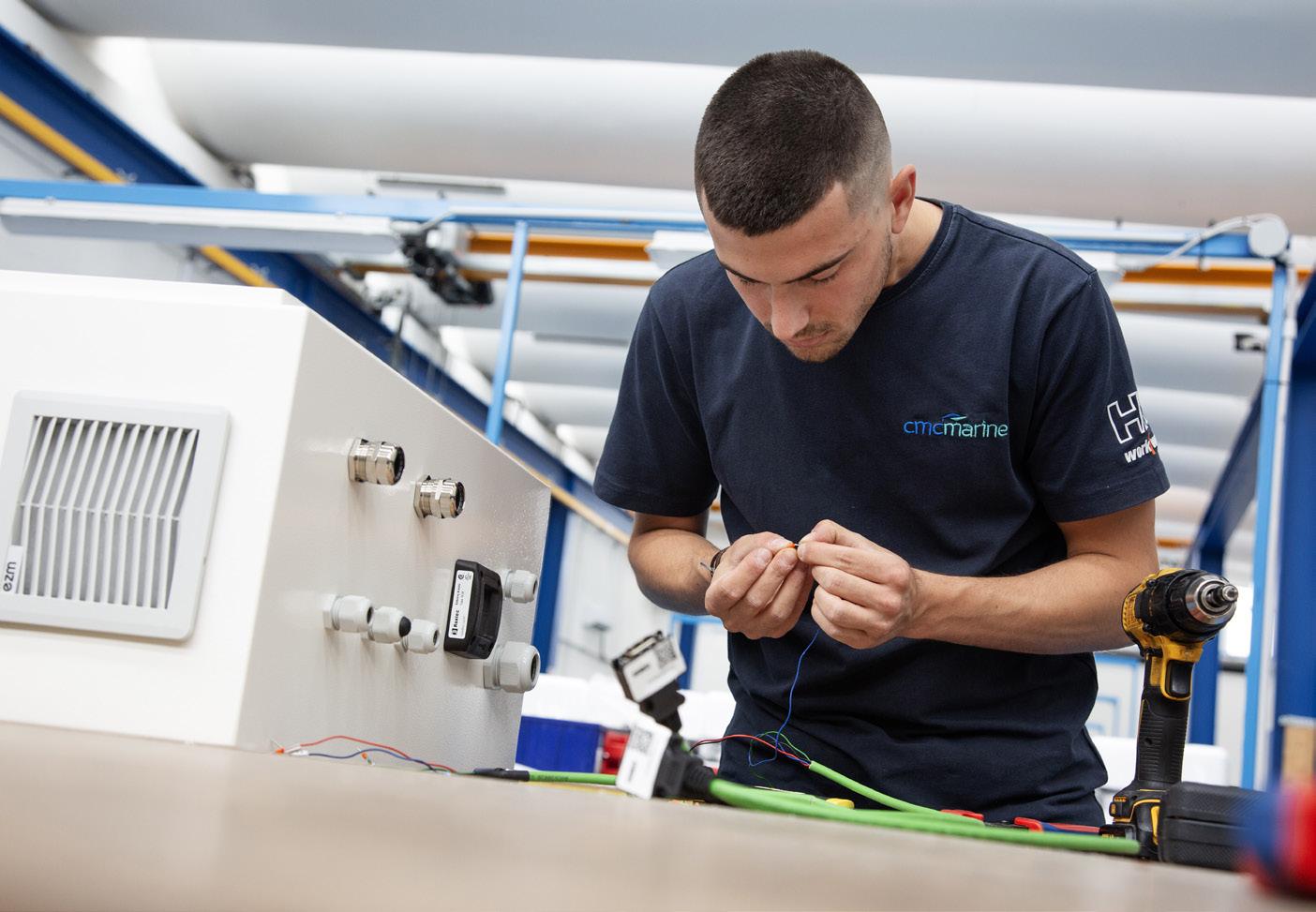
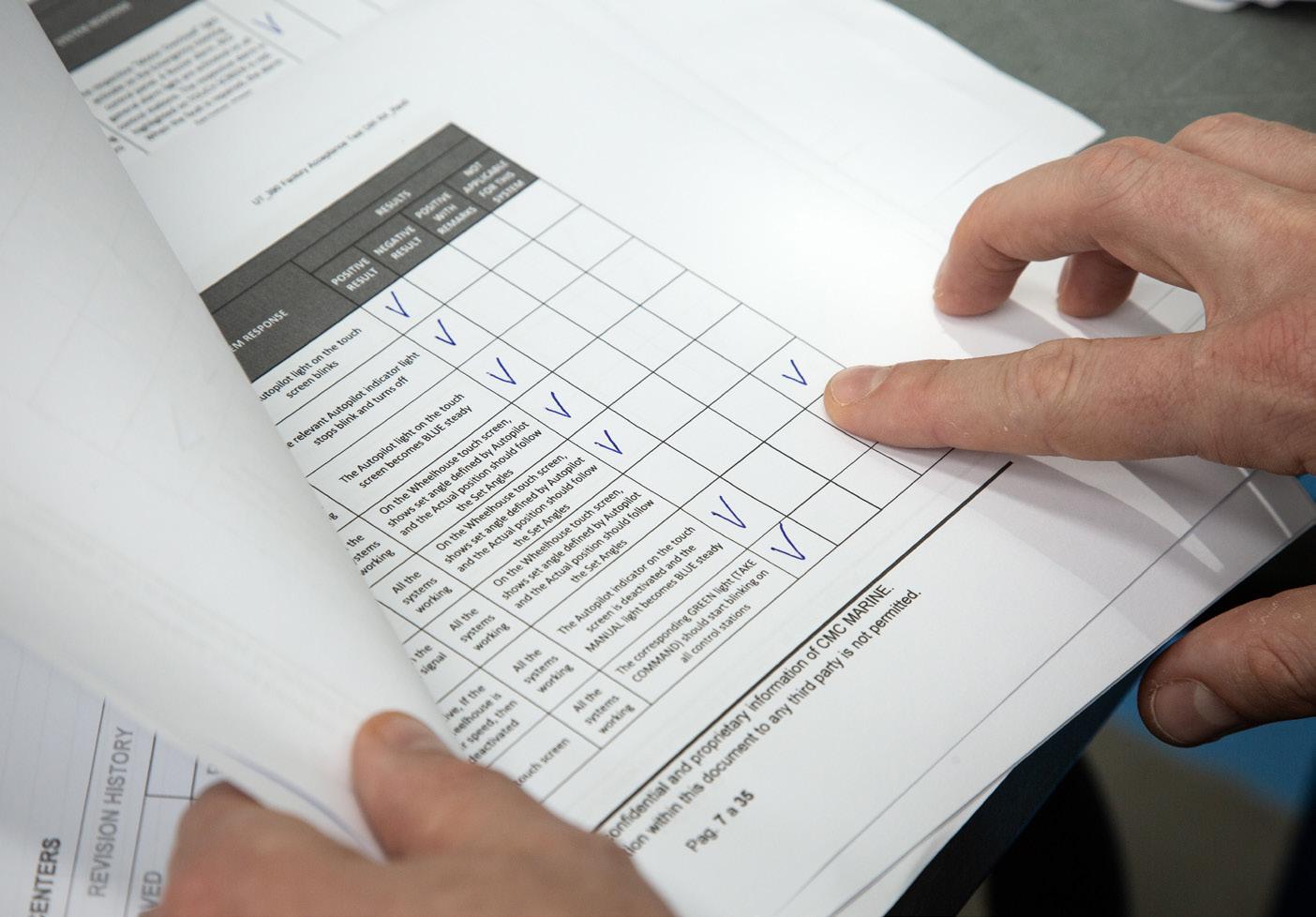
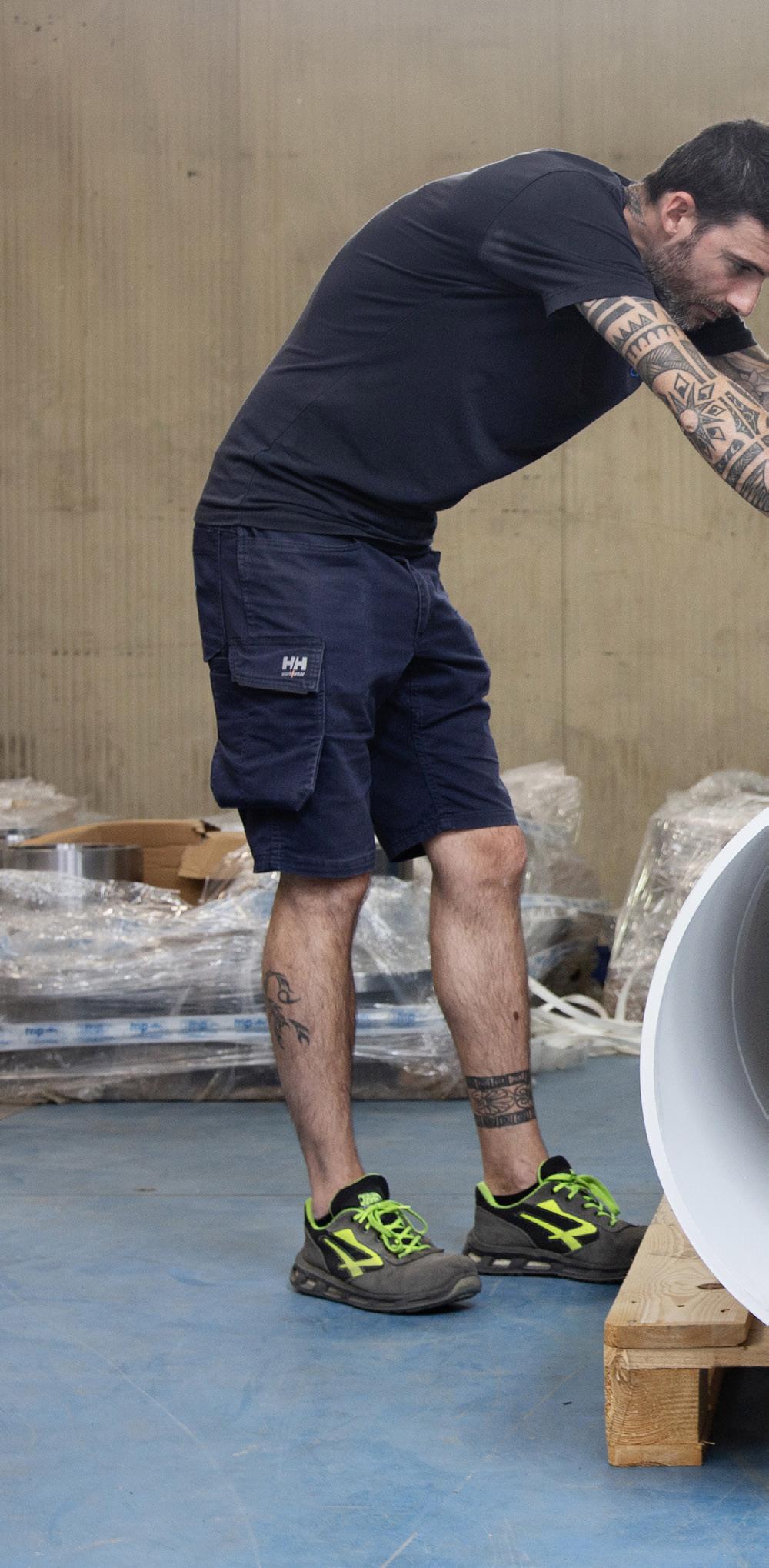

A full 12 months into its ambitious expansion plan, CMC is now looking to enter a period of ‘soft’ growth and consolidation. It is remarkable just how swiftly the company has transformed the stabilisation market, although it hasn’t always been straightforward in a conservatively-minded industry. Pietro recalls occasions during the approval process for its electric fin and steering systems, for example, when the class society surveyors, more accustomed to hydraulic systems, asked for specific pressure values: “We had to explain that these were fully electric systems, that there was no pressure and they needed a different approach.”
The transition towards electric and hybrid power on board has no doubt oiled the wheels for CMC, but credit for the company’s ongoing success is mostly thanks to its founder and president, who recognised early on the difference between following existing demand and creating it anew, and the importance of market share. Hence the frequent launching of new products and partnerships, which results in new sales, which in turn increase market share. And because market share is an indication of market competitiveness, it has allowed the company to better identify key trends in consumer behaviour.
“We are in the process of deeply transforming CMC Marine from a project company into a product company,” concludes Alessandro. “Of course, superyachts are more project oriented and that will remain part of our DNA, but we want to be a strong player in other sectors as well so we can channel our resources according to demand.”



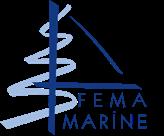













A naval architect by training with an MBA postgraduate degree, Jan Pieter Braam believes in effective communication, meticulous planning and strategic team management. With nearly two decades of frontline experience at Feadship, he has navigated a diverse career path from project managing iconic new-build and refit projects to hands-on line management roles. Since founding JPMarine in 2017, he has drawn on that experience to assist his clients in achieving the best possible results.
How did your time with Feadship helped you in your independent career?
Working as a project manager on yachts like 102-metre Symphony, the first Feadship to cross the 100-metre mark with all the PYC challenges that involved, has been invaluable. I also spent three years as head of production at Van Lent, which gave me insight into the production and teambuilding side of things, which ultimately made me a better project manager. But I also learned that I missed the interaction with clients and their representatives, with the naval architects and designers, and realised that I could best serve as the catalyst in the build process between the client and the shipyard. At that point I had a chat with Jan-Bart Verkuyl, CEO at Feadship’s Royal Van Lent shipyard, who was very supportive when I said I’d like to start up on my own. I was then lucky enough to go on to work with Feadship representing the owner on the 71-metre new-build Juice
Part of your role is to gathering the right team around you when a new-build project starts up. How do you decide who to take on, where to build, and so on?
Ideally, you start with an owner’s brief, a list of priorities and how he or she will use the boat, which sounds obvious but is not always the case. This is important because you can then distill from that brief four or five sentences that you can use as almost a war cry to keep the project on track. If you’re going to manage client expectations it stands to reason that you need to know where their priorities lie. It may be quality, it may be family, it may be value for money, or it may be time. If it’s about money, for example, there are certain yards to choose from; if it’s about quality, there are other obvious places to go; if it’s about time, it will depend on the availability of a build slot, and so on.
In terms of team building, if a client has already had a good experience with a certain designer or shipyard, that’s a good place to start, but it also makes sense not to be too conditioned and look at alternatives. I’ve often been brought into projects in the middle and then it’s more about assessing where we are with the scope of work, the schedule and the financials, but two considerations that are often overlooked are communication and the team itself. Communication is also about process, such as how you share documentation and conduct meetings; and building a team is also about trust, matching capabilities and covering all the bases. Sometimes somebody is dysfunctional, or the team is dysfunctional, and you have to take a harsh decision and remove somebody from their position, which is never a fun thing to do.



Is it the same process for a refit as it is for a new-build?
In principle, it is the same: you determine a scope, you negotiate the scope, you do the build, adjust where necessary, quality control, commissioning, and after-sales. However, with refit you're squeezing it all into a much shorter time period, which is fun, actually! There is no time for uncertainties in refit, so you need to be very focused.
But the very nature of refit can throw up uncertainties and sometimes you don't discover things until you start digging down. You usually have a pretty good idea of the level of uncertainty of a refit before you start. So in that respect, you also have to manage you client’s expectations and manage the shipyard based on the client’s priority as a mix of scope, cost and time. Again, a lot of the job of a project manager is to think ahead and ask the questions not yet asked, whether it’s a new-build or a refit. When something unexpected happens in a refit, you find out what is most important: getting the job done, or getting it done on time. If it's the latter then you need to have a frank conversation with the client and say ‘OK, this means the job can’t be done within your time constraint of time and we need to plan for it next time’.
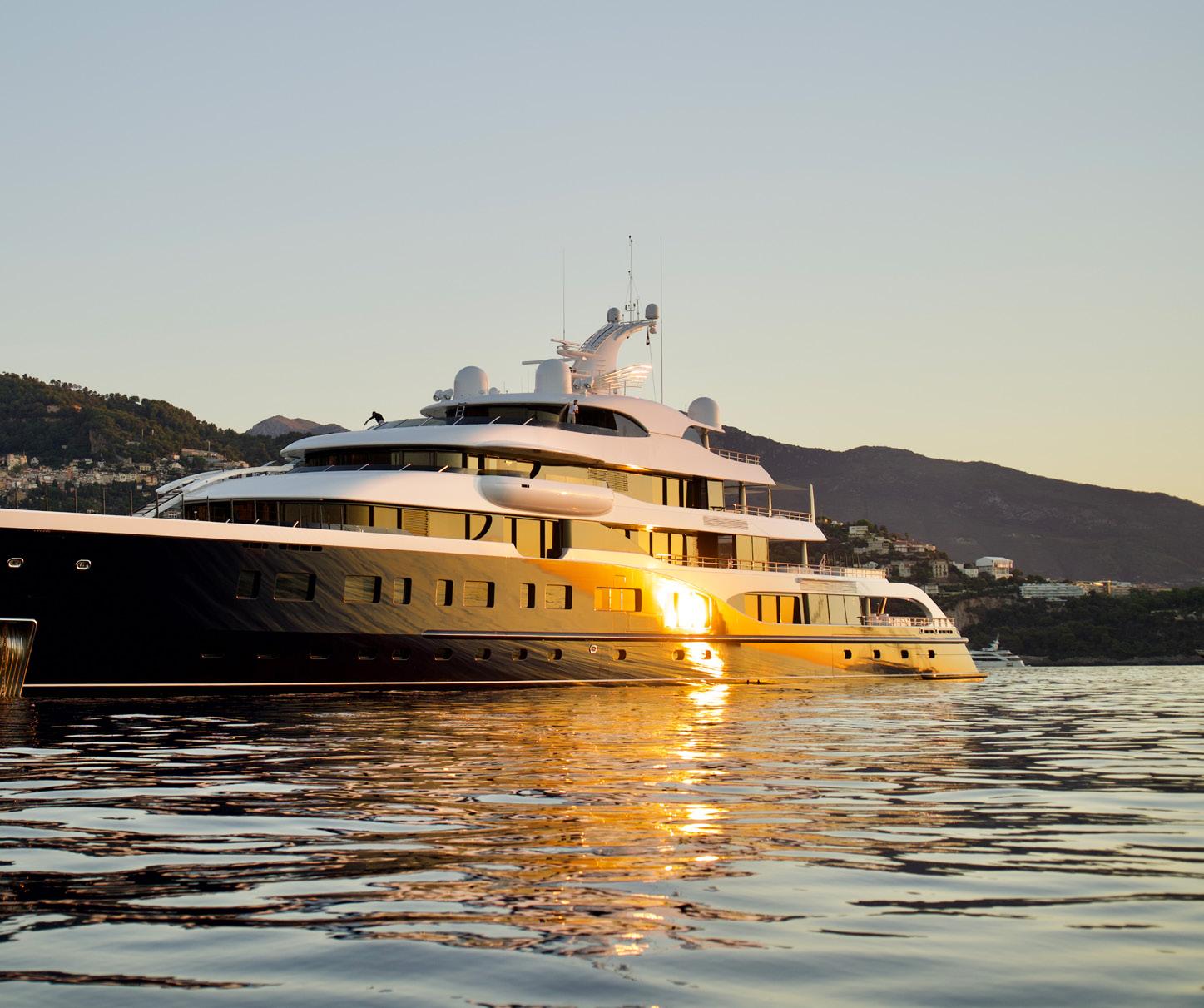
Something that can throw up delays are late change orders. How do advise your clients on those?
Everyone prefers to avoid change orders, the shipyard especially, but not all change orders are necessarily disruptive. It's our job as part of the owner’s team – and I include the designers and shipyards in that group – to ask the right questions at the right time to make sure there are as few change orders as possible. There’s usually a good reason why clients want to make a change: it may something they saw they weren’t aware of before, or perhaps they want a new technology. But the presentation has to be very clear: what are the pros, what are the cons, and what are the trade-offs in terms of cost and delay? The crux usually happens before the change order, but when it does happen you have to be well prepared to keep the client happy while minimising any inconvenience for the build or refit process.
You say the challenges associated with refits can be fun; what is it you most enjoy about your job?
Using everybody's knowledge and experience to build something exceptional. If the guys at the shipyard are really proud of what they’re doing, they will do a good job. I am 100 percent sure that when people like their jobs and stand behind what they're doing, they will deliver the best product possible. So that's one side of it, and the other is making it enjoyable for the client. This very much depends on individuals as some are more involved than others, but if a client visits the yard and leaves with a smile, I find that very rewarding.
“A lot of the job of a project manager is to think ahead and ask the questions not yet asked, whether it’s a new-build or a refit.”
Traditionally, superyachts maintained a clear distinction between the interior and exterior. However, modern designers are challenging this and increasingly blurring this ethos of separation. Interior designers now consider all possible ways to seamlessly blend the two spaces, bringing the essence of nature inside.
The renowned specialist interior outfitter Sinnex is helping do just this, facilitating designers' interior creations that harmoniously blend luxury with natural elements. The Germanfounded company with headquarters in Austria is pushing the boundaries with design across a range of comprehensive services, from project management and detailed design to raw material sourcing and interior production. Now, with the introduction of their developing department dedicated to special surfaces they are further poised to transform visions into realities.
Erika Verachter, CEO of Sinnex, explains the significance of this new venture: "The advancements in special surface treatments developed at Sinnex provide designers with opportunities to create even more unique and extraordinary designs." This department represents a significant leap forward in the company's capabilities, offering designers who seek fresh and innovative ways to use various textures and finishes.

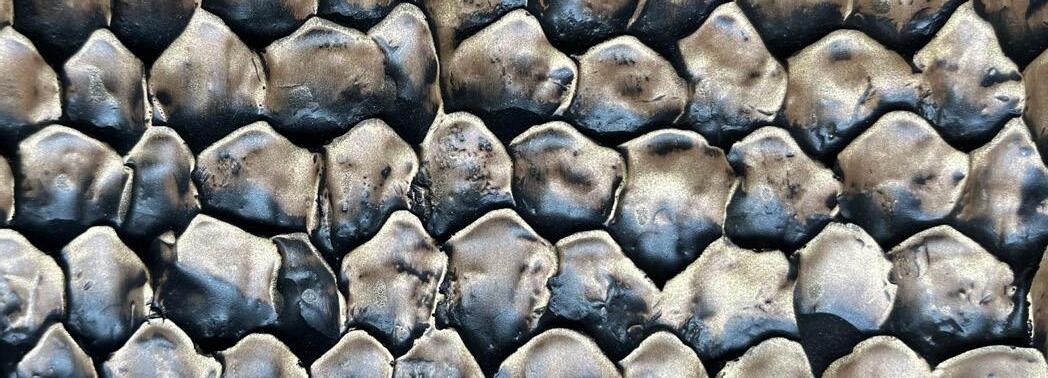


In interior yacht design, each element contributes to a grander vision. Those with superyacht knowledge and expertise best curate such a vision. Setting Sinnex apart is its complete dedication to superyachts; this focused approach tailored to the sector ensures that each surface and finish is specifically engineered to meet the unique demands of yachting.
"We place great emphasis on ensuring our new surface materials meet the highest standards in both aesthetics and durability," Verachter explains. This commitment to quality is crucial in an environment where materials must withstand harsh conditions and constant movement.
These special surfaces now offered by Sinnex provide a wide range of benefits, balancing visual appeal with high functionality. Verachter emphasises: "We recognise that each yacht is a unique reflection of its owner's individual style, which is why we work closely with designers to create surfaces that not only make a visual impact but also suit the demands of life aboard a superyacht."
In recent years, integrating nature as a design strategy has become dominant within the yacht interior sphere, using nature-inspired colour palettes, materials, and textures onboard. Sinnex has, therefore, looked to draw inspiration directly from the natural world when creating its range of surfaces that are now both innovative and harmonious with the environment.
An example of the nature-inspired approach is a new design that combines the texture of cacti with liquid metal techniques. This pairing creates a special surface that is visually intriguing for accenting furniture and other interior elements. "By combining advanced technology with natural inspiration, we can create surfaces that are not only highly functional but also aesthetically sophisticated," adds Verachter. The use of organic forms allows designers to add distinctive touches to their creations. These surfaces go beyond mere decoration, representing a deeper philosophy of design that seeks to bridge the gap between the natural world and the luxurious interiors of superyachts. As Verachter notes: "These surfaces are aesthetically stunning and also beautifully harmonious - a perfect symbiosis of technology and nature."
Sinnex's commitment to traditional craftsmanship and modern technology makes the development of these special surfaces possible. In 2022, the company doubled the size of its Austrian facilities, expanding to 8,000 square metres of production space. This expansion has allowed Sinnex to broaden its range of materials and surfaces while maintaining its time-honoured ethos of quality and attention to detail.
Combining traditional artisan processes with the latest in manufacturing technology, Verachter explains: "By utilising modern materials and manufacturing techniques, we can achieve a level of quality and longevity that was previously unattainable."
As yacht interiors continue to evolve by encompassing more natural elements within design features, the role of more innovative surfaces will only grow in importance. Companies like Sinnex are leading the way in developing such materials and surfaces, blending the natural world with the latest in surface technology. To create these unique, nature-inspired interiors, Sinnex's special surfaces departments offer exciting future possibilities for the next generation of yacht interiors.
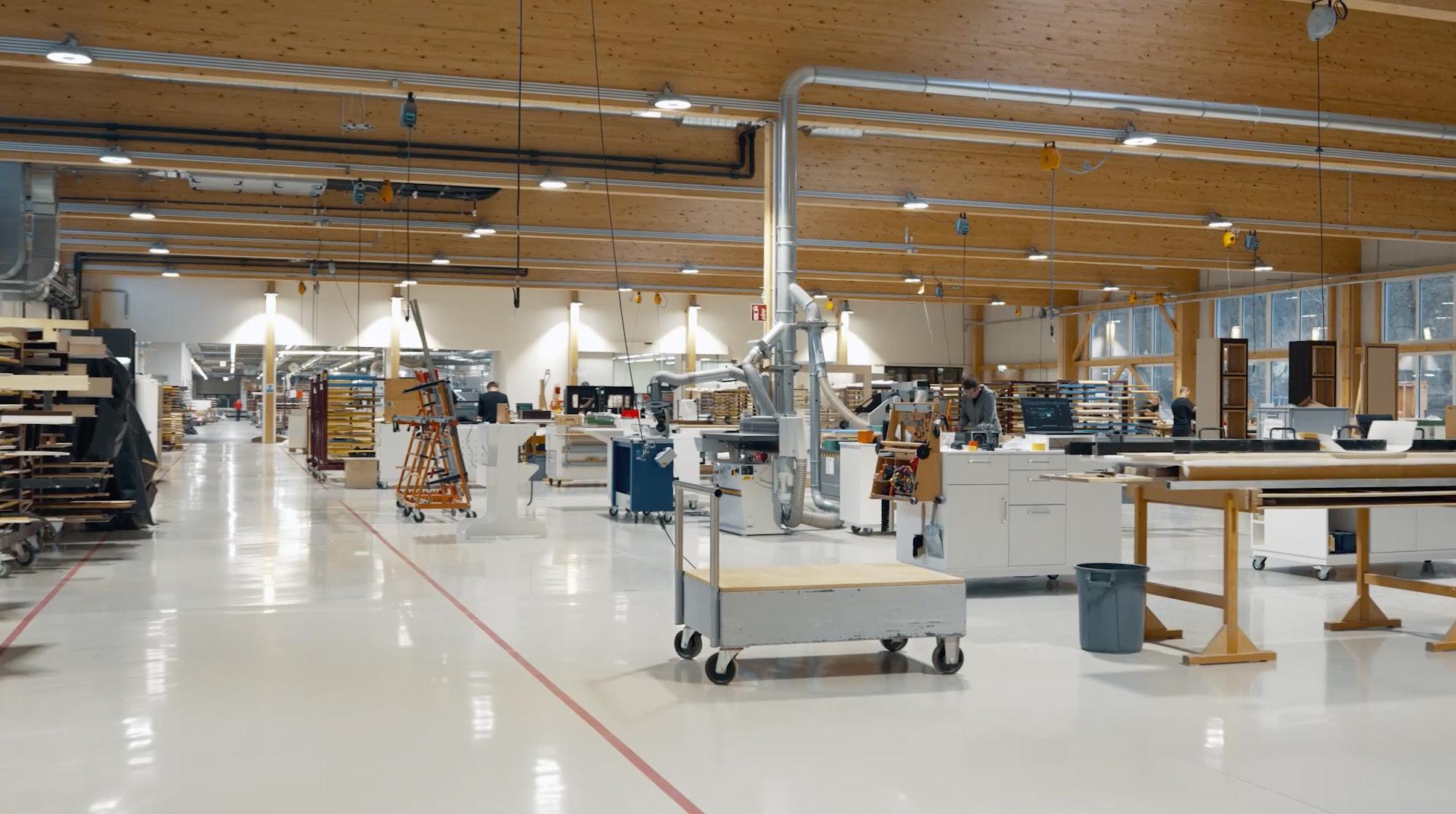

The METSTRADE Show is the world’s largest marine equipment trade show and the only truly international B2B exhibition. With excellent networking opportunities, a broad range of showcased innovations and located in one of the most beautiful cities in the world, the METSTRADE Show is an unmissable event for every professional in the marine industry.
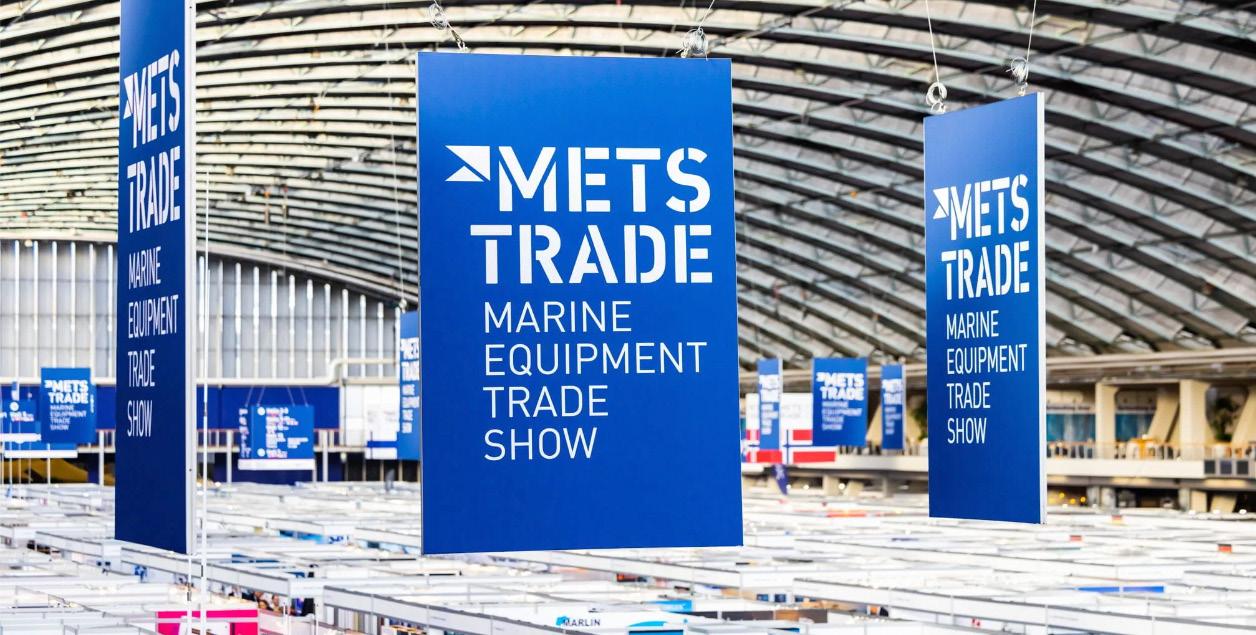
With three dedicated halls and an associated educational and social networking programme, the Superyacht Pavilion at METSTRADE serves as a B2B platform for leading manufacturers and suppliers to showcase their response to evolving industry needs, client expectations and sustainable solutions in a very different environment to on-the-water boats shows. Here are just some of the brands and products to watch out for at the 36th edition of METSTRADE.
BY GEMMA HARRIS
A lightweight power solution
Ampros, the electric propulsion partner for marine applications, is set to showcase its 140kW REX range extender genset for serial hybrid propulsion systems. Weighing 600kg, it is touted as the lightest in its class. This weight-efficient genset operates at 30-140 kW with a variable-speed combustion engine (1200-2700 rpm) designed for a 700 VDC nominal voltage system.
Highlights of the extender include its compatibility with lithium-ion batteries and solid-state battery systems that feature smart charging integration. The development builds on Ampros’ experience with its flagship 390kW model and aims to address the growing demand for lightweight hybrid propulsion solutions to reduce fuel consumption while maintaining power output.
“We have expanded our range by 140 kW and these are now the lightest generators on the market,” says Ampros CEO, aerospace and marine engineer Tomasz Gackoski. “For applications at 700 VDC, our REX 390kW model has operated for 50 hours under laboratory conditions and an additional 300 hours in a real-world marine environment.”
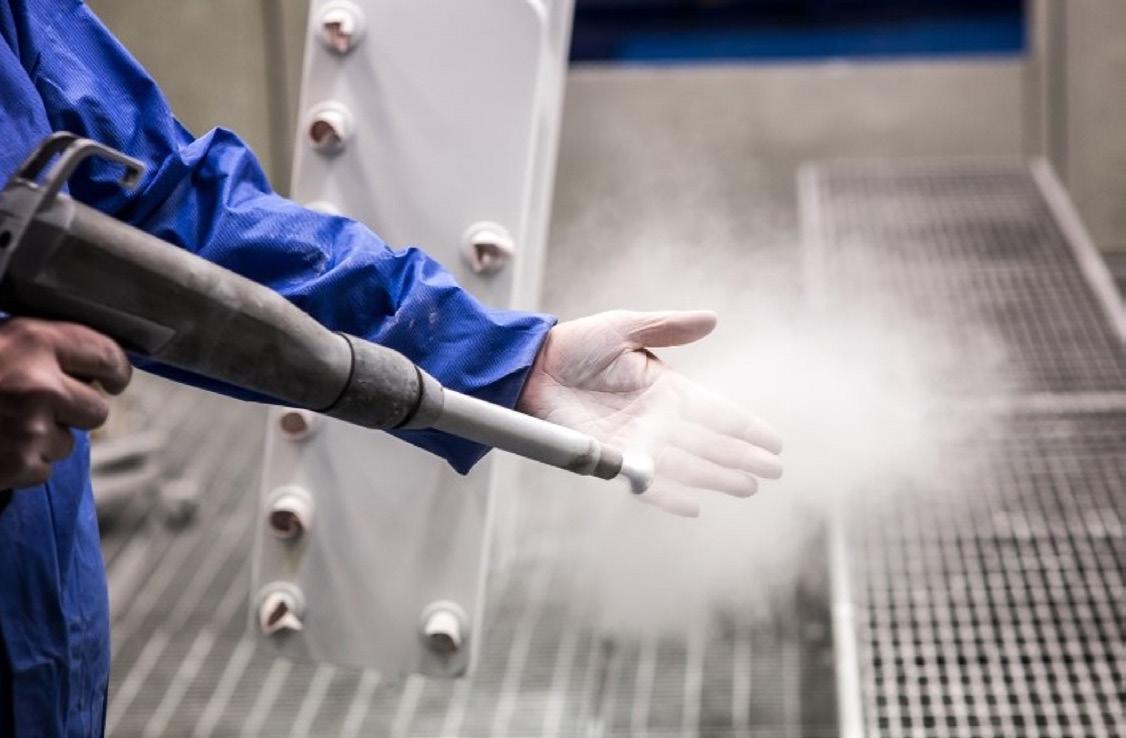
Surface treatment technology
Renowned for designing and manufacturing standard and custom-made products for the industry, such as passerelles, cranes, automatic roof systems, and boarding ladders, Besenzoni is back this year with a new production capability. Its advanced surface treatment and powder coating plant is a fully automated facility and features an electrostatic powder coating system. The process ensures a highly durable finish, achieved by applying an epoxy powder coating cured at 230°C in an oven to fix the coating. This facility is a valuable addition to Besenzoni’s UNICA range of custom components for superyachts.
CEO Giorgio Besenzoni says: “Our new powder coating system epitomises our dedication to excellence and innovation, ensuring that our products meet the highest standards of durability and performance.”
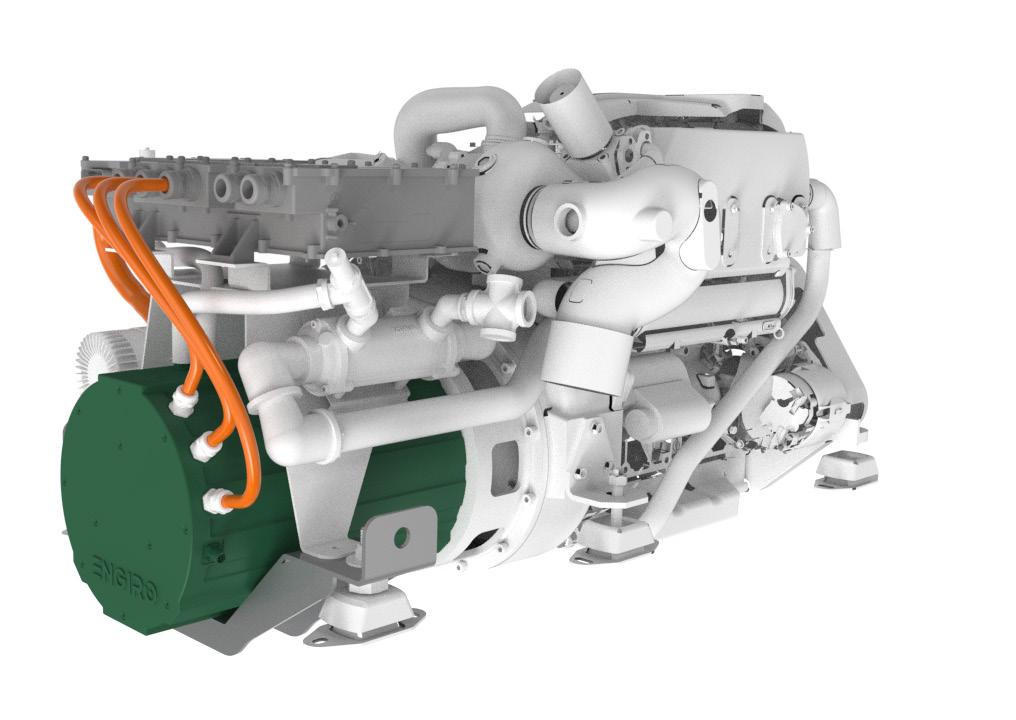
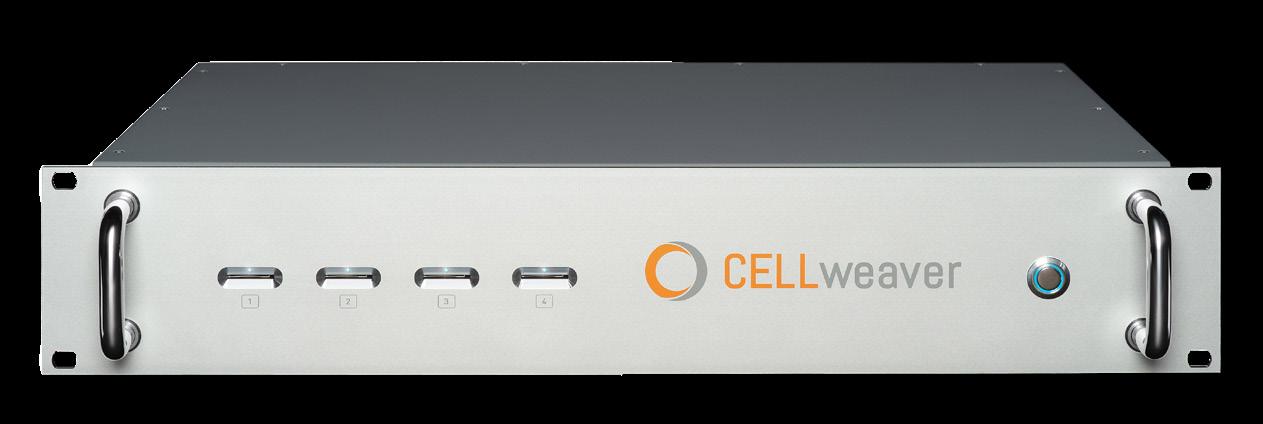
Multi-source connectivity
CELLweaver provides solutions specifically for superyachts to accommodate onboard connectivity to the Internet. The CELLweaver LEO (Low Earth Orbit). A new solution that takes four 5G SIM cards and combines data streams with eight or more WAN sourcestypically LEO satellite systems like Starlink and OneWeb into one ultra-fast internet service. The latest software generation provides improved aggregation algorithms for increased performance and efficiency. The system is easy to retrofit, and users can expect a realistic average speed of multiple GBits/s.
Says CELLweaver CEO Wilko Darger: “The feedback from existing clients regarding perfectly reliable video calls, streaming speeds, and response times has been excellent.”
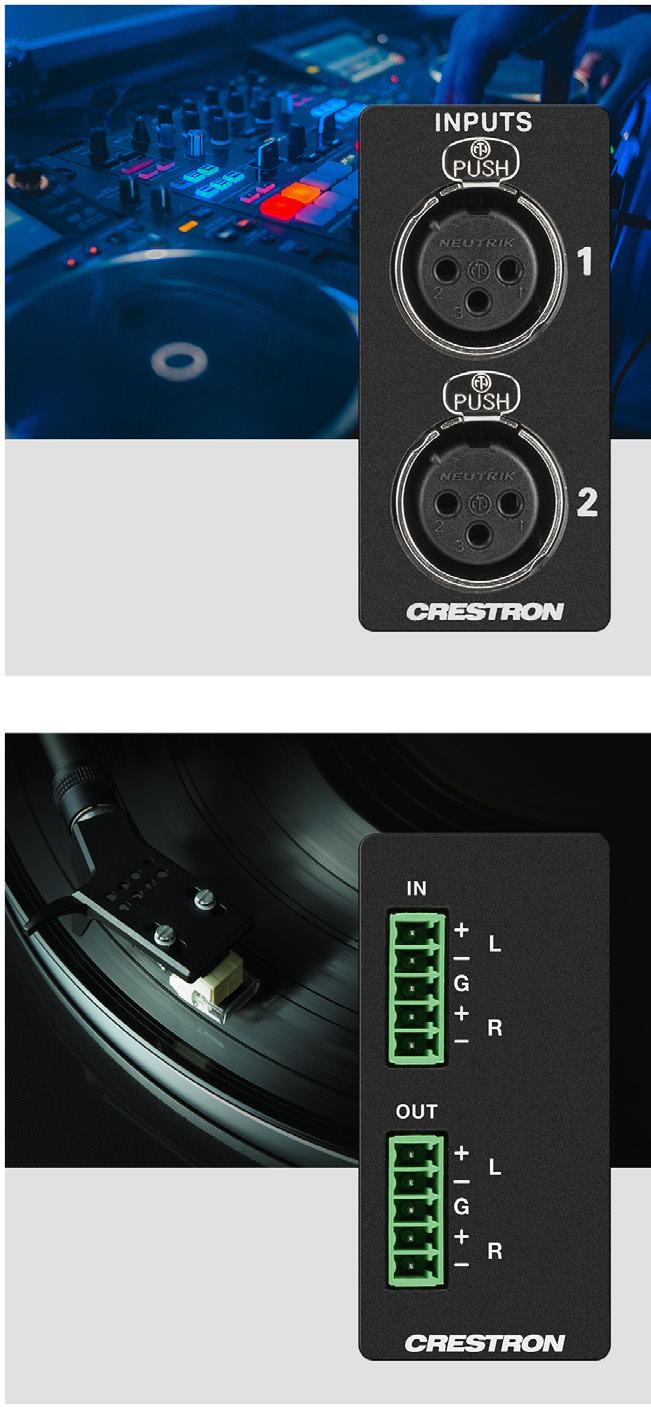

Audio in all areas
Crestron will be presenting its latest in AVover-IP technology with its DM NVX platform. Designed to elevate the onboard audio and video experiences. The four DM NVX Audio Edge devices are versatile units that offer a range of connectivity options from Bluetooth to USD and professional audio inputs. They come in two forms - wall plates and surface mounts - and feature PoE power for flexible and easy installation onboard.
Michael Short, senior director of marketing operations and residential, comments: “We are seeing a growing demand for audiovisual solutions that can be utilised across the entire vessel, driven by the rise of streaming services and consumers’ desire for entertainment everywhere.”
Also on show and compatible with the DM NAX networking platforms will be the DMNAX-XSP Audio Return Processor, which addresses the challenge of distributing audio across a yacht. This processor can bridge streaming TVs to Crestron’s DM NAX multiroom audio distribution system, enabling access throughout the yacht.

Eco-conscious decking options
Esthec, part of the Bolidt group, will introduce two new synthetic decking products this year, catering to different segments of the market. The first is an ultralight version of its synthetic decking, designed specifically for the electric boating sector. This new product maintains the company’s signature durability, which is claimed to last over 15 years, while offering a more eco-conscious option with reduced weight.
“The focus on the ultralight version is to not jeopardise durability while offering a sustainable option, as if you need to replace decking every two years, this negatively influences the yacht’s carbon footprint,” says Esthec co-founder, Marcel van der Spek.
The second product is a thicker product line for larger yachts. This prefabricated product will be available in 8, 10, and 12-millimetre options to match traditional teak dimensions. It will be showcased with various special applications, such as caprails and steps, both with LED integration options. Continuing to prioritise eco-conscious credentials in product development, the company has also hinted at an additional “groundbreaking development” in the works, which Van Der Spek describes as a potential game changer. Further details are expected at the show.
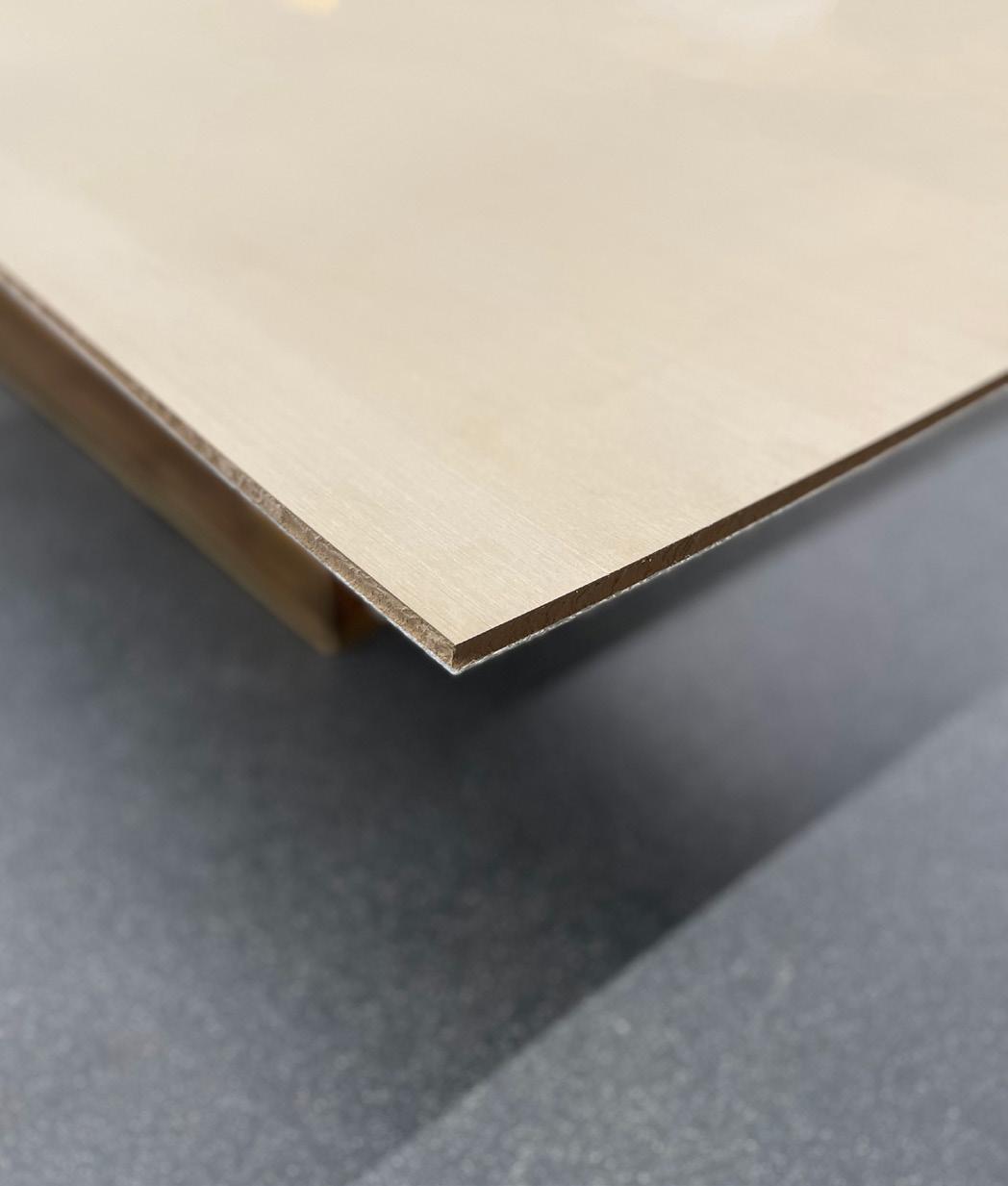

An underwater view
Based on the prototype shown at last year’s show, OceanLED will showcase a new addition to its underwater camera range: the EYES Superyacht Camera, designed exclusively for superyachts. The weld-in, flush-mounted camera can be installed on any metal hull and offers a view into the underwater world. With an IP69K water intrusion certificate, the camera is powered by a 1/1.8” 4K sensor with 9.2 million pixels, delivering 4K visuals with a 100° angle of view. This results in an ultrawide perspective with no curvature or distortion. Its usage is aimed at yachts getting close to shore, looking for underwater hazards, or simply witnessing the underwater world. The camera also has low-light capability, meaning the feed can be seen in semi-darkness.
The IP connectivity makes it possible to view the camera feed from anywhere onboard, accessible by smartphone, tablet or computer connected to the Wi-Fi network. Aside from the entertainment aspect of watching below the hull, this also serves as a method of improving security capabilities onboard to witness the immediate underwater area of the yacht 24/7.

Efficient stabiliser performance
Quantum hopes to introduce a breakthrough in stabilisers with its new patent-pending F45 – Electric/Hydraulic Hybrid Power System, which draws on the best attributes of a traditional hydraulic power unit and the advantages of a direct electric drive system. After almost five years of development and eight months of intense testing, the first F45 System has been installed on a refitted 47-metre Feadship. Results from the first sea trial in June 2024 were impressive, with efficiencies both at zerospeed and underway. Stabilisers are big power consumers, particularly at zero speed, and often generate large power fluctuations that cause a strain on the generators and the power grid. The F45 is able to manage power fluctuations, as well as store and recover power through a proprietary solution called MESS (Mass Energy Storage System). This flywheelbased technology can outstrip traditional capacitor banks by a power density of eight times. Furthermore, excess energy from fin deceleration (zero speed) or hydrodynamic force (underway) can be recovered and stored for future use through Dynamic Energy Recovery.

Creating energy while sailing Rondal is set to unveil a new innovation: a prototype of the tentatively named ‘Hydro Generator’, a energy regeneration system designed for installation on sailing yacht hulls.
Initiated by Huisfit, the product focuses on the refit market. “While many hybrid and diesel-electric yachts can regenerate power with a propulsion propeller, many yachts with traditional propulsion lack this capability,” says Jidde Looijenga, innovation manager for the Royal Huisman group. “ We sought to develop a method to enable regeneration for these yachts.”
With options suitable for smaller yachts with an output of 9Kwh and for superyachts at 15Kwh, tests by MARIN (Maritime Research Institute Netherlands) achieved impressive efficiency readings based on output, speeds, and lower than expected propeller drag. The product is expected to be registered for a Dame Award.
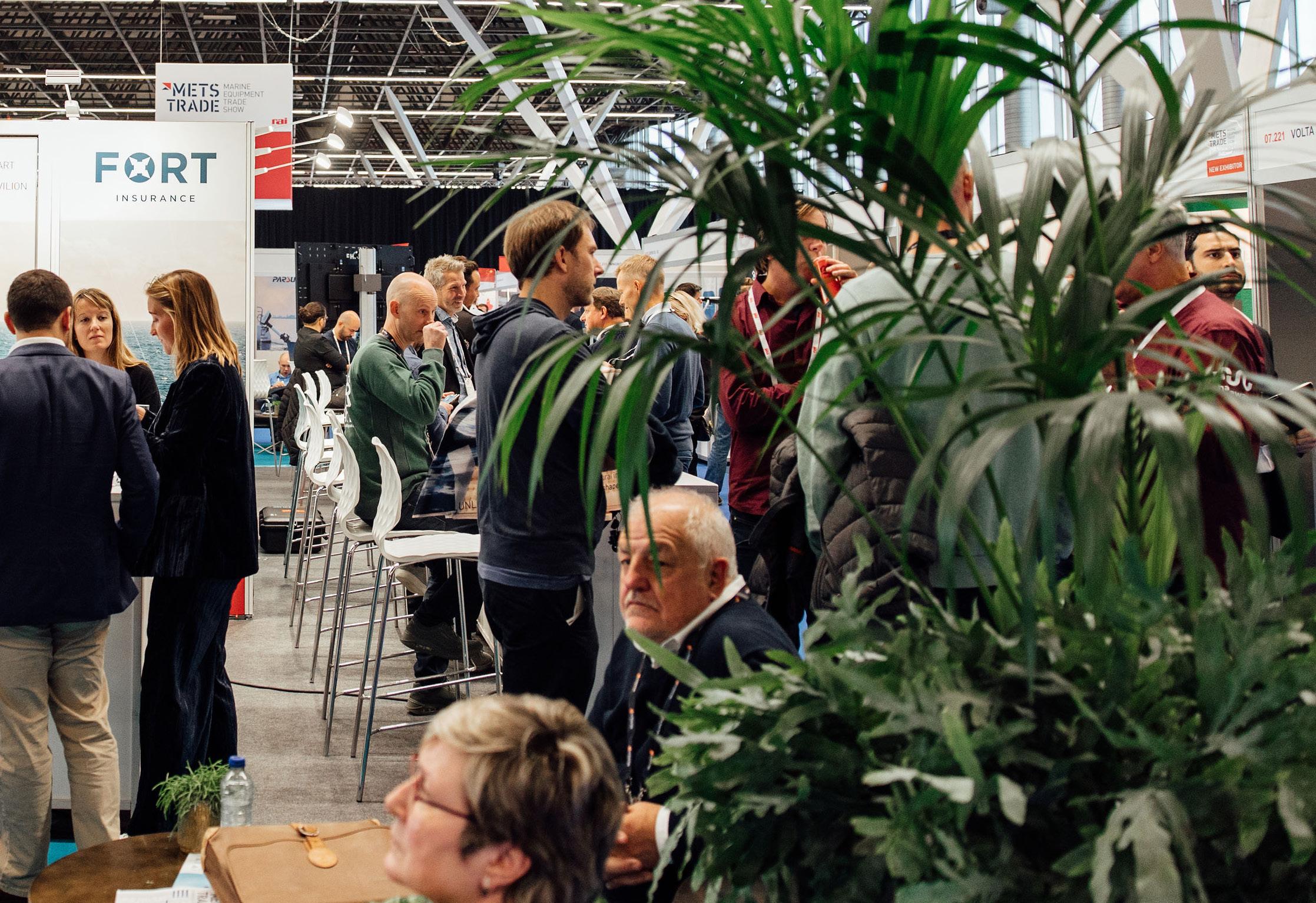
Enhanced navigation systems
SEA.AI, known for its machine vision products, including the Sentry system, has announced a strategic partnership with TimeZero for this year’s show to integrate Sentry’s capabilities into TimeZero’s navigation software. The collaboration aims to enhance situational awareness by consolidating multiple sensor inputs into a single interface. SEA.AI’s system combines thermal and optical cameras with machine learning algorithms to detect and classify floating objects in real-time, including those not detected by radar or AIS. The Sentry platform is capable of detecting objects up to 700 metres.
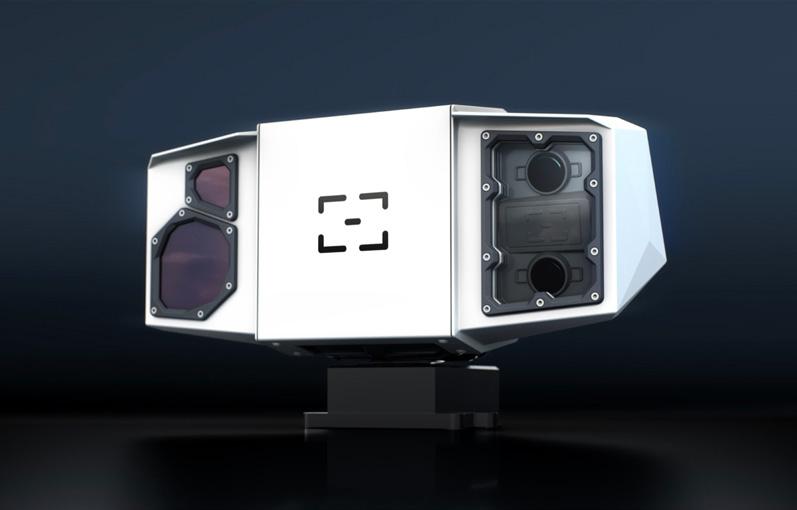
“Working with TimeZero enables us to embed our vision directly into the navigation process and combine the data of other equipment onboard, enhancing every aspect of maritime voyages,” says Marcus Warrelmann, CEO of SEA.AI. “Together, we’re not just integrating systems; we’re building the future of safe and intelligent navigation.”
Safer anchoring
Building on the prototype design unveiled at last year’s show, Swiss Ocean Tech will return with Anchor Guardian, its fully developed anchor monitoring system. This patented technology works to address anchor dragging. The system utilises sensor fusion with modules on the chain and hull with algorithms to provide real-time monitoring with sub-metre accuracy in anchor position tracking to prevent potential groundings, collisions and environmental damage. A crucial feature of its NMEA2000-compatible software is integration with existing onboard systems. This makes the interface accessible via ECDIs, tablets or smartphones and enables the crew to access and interpret data from anywhere onboard.
“The focus of our efforts is safe anchoring, and the process has to become simpler to succeed,” says Swiss Ocean Tech founder, Thomas Frizlen. “We give captains the control and information they need to set the anchor in the best way and to monitor.”

Sustainable fabric collections
Dickson Constant’s Sunbrella brand will highlight its commitment to sustainability and innovation this year by displaying the ‘Endless Stories’ fabric collection for marine applications. Designed inhouse and woven in northern France, this new collection is developed from production waste materials, integrating up to 50 percent recycled fibres. This marks Sunbrella’s first dedicated range of recycled materials for marine use.
The ‘Endless Stories’ collection features textural effects achieved through weaving techniques and the incorporation of looped yarn. Aligning with its sustainability focus, the brand also anticipates upcoming European regulations by eliminating PFAS in fabric finishing. Additionally, the company will preview the upcoming ‘Sunbrella Plus Recycled’ initiative at the show.
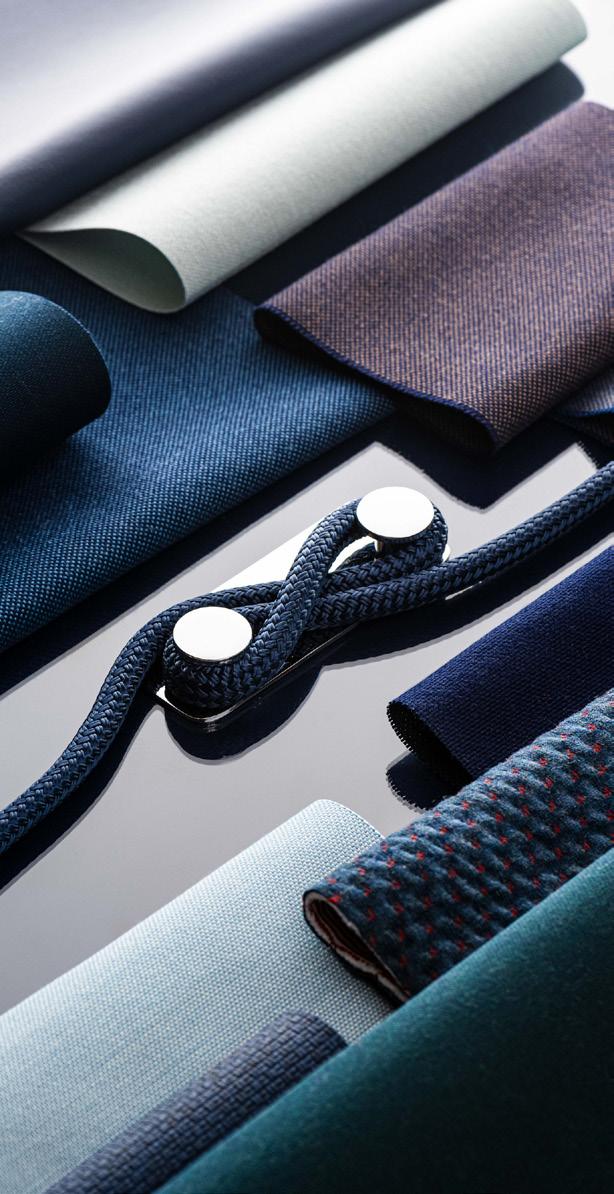
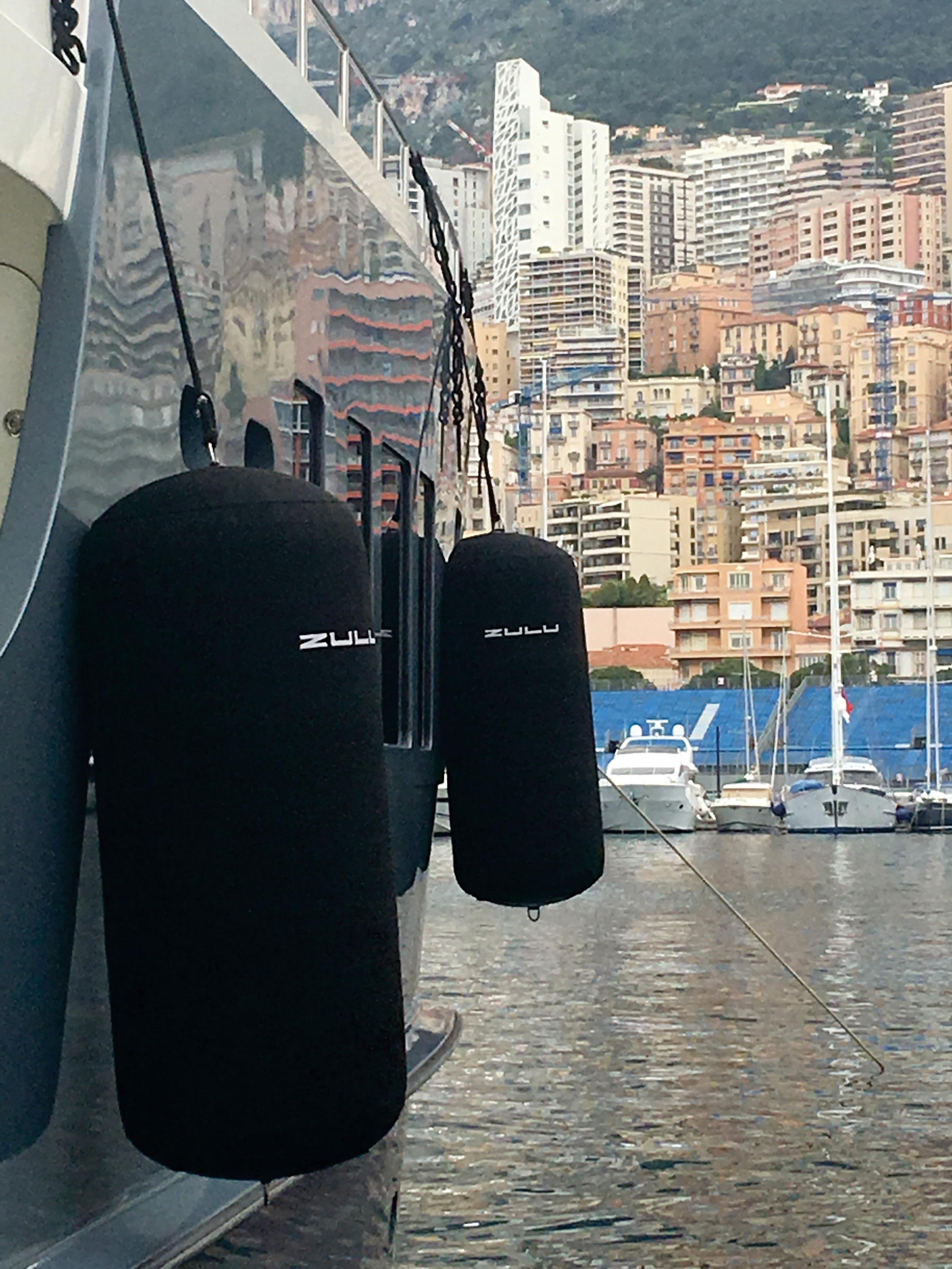
DIRECTOR NIELS KLARENBEEK
How were the new features from the 2023 edition received?
The new initiatives were very well received. The Foiling Pavilion and the Start-Up Pavilion, in cooperation with Yachting Ventures, were both positively embraced, so we will be bringing these back this year. The concept in the Start-Up Pavilion is unique, whereby exhibitors can only participate once, encouraging them to transition to regular exhibitors. Yachting Ventures has reported plenty of interest, and they will be back again with 15 start-ups, who will also compete in pitching competitions. The Foiling Pavilion is expected to generate even more interest driven by the exposure of the America's Cup. This technology also stands out as a facilitator that trickles down to leisure marine applications and inspires boat builders to understand the technologies better.
What's new for METSTRADE 2024?
This year's significant development is that we are now running the Superyacht Forum, scheduled for Monday and Tuesday. As a result, we have also formed a new Superyacht Content Board, an alliance between METSTRADE and key trade associations in the superyacht industry representing all facets of the industry. Topics for the forum will include three main streams: innovation, sustainability, and professionalism. We are very excited about how this first edition, ‘Think Ahead,’ will play out, and it aligns with our longer-term strategy, where, in the following years, we will have even more targeted education and discussions, both in the forum and on the trade floor.
What are the attendance predictions for this year’s event?
We are expecting a record-breaking year. Last year, we had 1,540 exhibitors, and we're confident we will surpass that. For 2024, we anticipate over 1,500 exhibitors from 54 nations. As of July, we already had over 1,300 exhibitors confirmed, so we are well on track to make this year the largest event in our history.
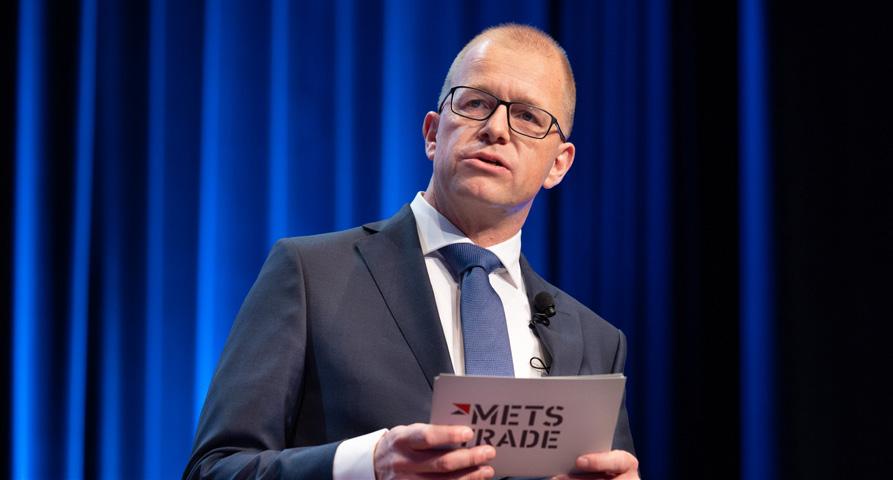
Are there any further plans for METSTRADE?
While we are concentrating on leveraging the quality of the existing elements we launched last year, we are also planning a significant expansion for 2025. We have witnessed some capacity issues for the past few years as we have limited space, meaning the Superyacht Pavilion has again been booked up quickly like previous editions. Our team is already working on the 2025 show as the last remaining hall in the RAI centre, which has yet to be used, will be opened for the show, creating a further 8,000 square metres of exhibition space.
How will you utilise this additional space in 2025?
The expansion will allow us to accommodate the waiting list of exhibitors, but we will also place greater emphasis on superyacht refits. While the show is traditionally focused on new-builds, this expansion allows us to showcase more from the refit and operations realm. We will introduce refit clusters, recognising that refits often happen in specific regions with their own ecosystems of subcontractors and suppliers. These clusters will exhibit together, giving owner-representatives and captains a comprehensive view of refit options. While marine equipment remains our core focus, this expansion allows us to incorporate more operational services, reflecting the evolving needs of the industry.
What are your predictions for future trends at METSTRADE?
We have seen a considerable shift toward more advanced technology, focusing on smart equipment, IOT elements, integrated systems, and alternative propulsion, which will continue. Sustainability has also taken priority, as reflected in our growing Sustainability Route, launched two editions ago in collaboration with the Water Revolution Foundation. Last year, we had five participants on the route, and this year, we will have 15 participants showcasing sustainable verified solutions. My aim in the near future is for the vast majority of exhibitors to be part of this route.
Updated audio-visual
Celebrating its 25 years of experience in yachting last year show, Videoworks returns to display its updated audio and video systems solutions. The company is presenting three key technologies, each representing an evolution of its existing system. One is its updated custom interface tool with new formats for smartphones, tablets and smart TVs using technologies like the Crestron GUI (Graphical User Interface) app. The company will also present an upgraded ETO (Electrical Technical officer) panel version, allowing for more efficient onboard equipment management. The improved panel offers enhanced control over systems, from monitoring temperature and humidity to managing current consumption and zone statuses.
Lastly is the SD-WAN software-based network technology, which provides virtualised resources for connections over networks via standard broadband internet links and allows for monitored internet access via a web platform where clients can track connections. The system automatically chooses the best solution based on specific needs.
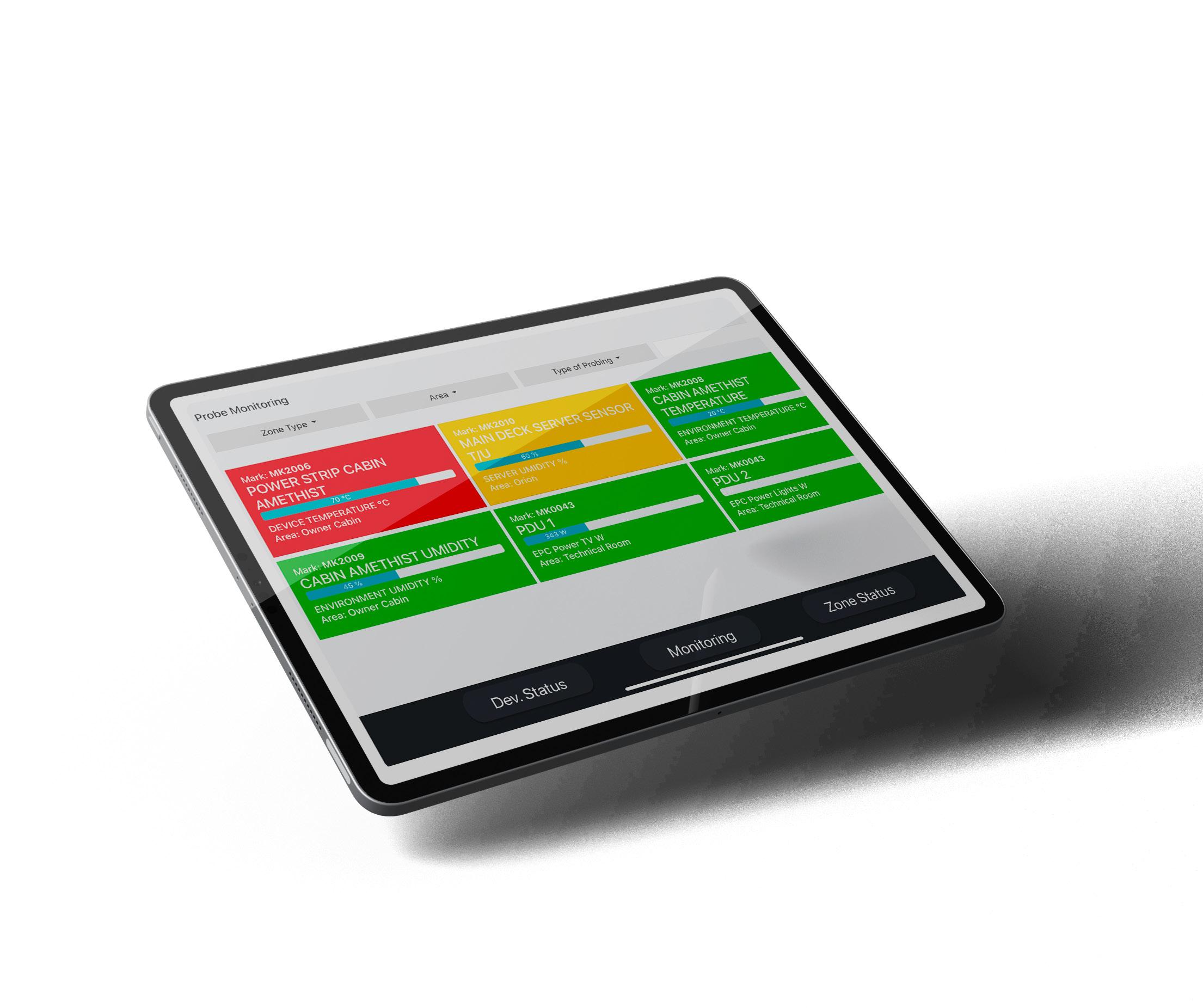

The first units of Wavefront’s new product, the Vigilant FLS 600, will be displayed at this year’s show. The company specialises in underwater detection, imaging and navigation. Its technology allows superyachts to venture into new and remote locations where underwater environments may not be known and charts inaccurate.
The patented Vigilant technology produces real-time, easy-to-interpret 3D depth images - to a maximum of 600-metre range. The technology also creates a 3D terrain map of the seabed and automated alarms warning of potential grounding and collision with objects in the water. The system can be utilised with bridge systems to provide a real-time navigation aid.
Paul Badger, Wavefront managing director, says: “We were excited to see the first shipment of the Vigilant 600 units leaving our production line this summer and headed for their new owners to deliver class-leading navigation and obstacle avoidance.”
METSTRADE has been a cornerstone event for marine equipment and technology since its inception in 1988. Hosted annually in November at the RAI Amsterdam Convention Centre, the event draws professionals from over 130 countries. The upcoming 2024 edition, scheduled for 19-21 November, promises to uphold its tradition of fostering international networking and innovation.
Rewind to the inaugural show that introduced the novel concept of providing a level playing field for exhibitors and a B2B-only visitor policy. The approach laid the foundations for exponential growth in both exhibitor numbers and visitor attendance. From the beginning, a hallmark of the show has been its country-specific pavilions.

“The show has grown organically over the years and has become an instant hit, from the first edition there was already a British Pavilion, and that has become part of METSTRADE’s DNA,” says Niels Klarenbeek, director of METSTRADE. “Today, we have lots of marine industry associations that come to the show representing their countries.”
The 2024 show will represent 19 major countries, with France, Italy and the USA boasting the most extensive pavilions. From countries to specific segments of the wider marine industry, 2005 saw another significant milestone: the first edition that introduced the Superyacht Pavilion.
Klarenbeck reflects: “My predecessors decided to accommodate a certain area within the show dedicated to superyacht equipment, and that equipment zone became the pavilion we see today – it is by far the fastest-growing element of the show.”
Fast-forward to the pandemic years, which presented various challenges, coinciding with Klarenbeek’s appointment as director in 2020. Despite cancelling the physical event that year, METSTRADE adapted with the virtual alternative, METSTRADE Connect. The show’s comeback in 2022 was marked by the first Women in Marine Industry breakfast.
Last year’s edition saw METSTRADE expand its scope with further additions. Two new pavilions were opened: the StartUp Pavilion, in partnership with Yachting Ventures, provided a platform for emerging marine businesses; and the Foiling Pavilion, representing the latest technological developments in this emerging sector. The 2023 event also addressed career development through initiatives like the Career Corner, facilitated by Marine Resources and Young Professionals in Yachting.
“My predecessors decided to accommodate a certain area within the show dedicated to superyacht equipment, and that equipment zone became the pavilion we see today – it is by far the fastest-growing element of the show.”

Filtering marine air
Xquip, a designer and manufacturer of carbon fibre superyacht equipment for boarding solutions, will showcase its new Dock Step product. This foldable boarding solution combines functionality with the yacht’s customised aesthetic. Constructed from high-quality carbon fibre and stainless steel 316, the Dock Step offers durability and longevity while maintaining a modern appearance. Its lightweight and foldable design ensures easy handling, while customisable two-, three- and four-step configurations and colour-matching options provide integration for any yacht. Alongside the Dock Step, Xquip will also have its selflevelling stairs and modular carbon davit crane solutions at the show.
“The Dock Step serves as the initial point of contact for guests boarding a superyacht,” says Thon van Riet, Xquip sales executive. “As the first impression is crucial, opting for a Dock Step from Xquip ensures a standout presence.”
Recognising the challenges smaller yacht builders face in complying with IMO Tier III regulations on NOx emissions, Xeamos will present its Zero NOx airless Selective Catalytic Reduction (SCR) system. Specialising in exhaust gas purification and emission reduction through catalytic converters and particulate filters, the company is now focusing on a new airless SCR concept tailored for smaller vessels. Designed for yachts between 30 and 45 metres this compact system, which works on airless operation for up to 2000kW propulsion engines, is custom-tailored, integrates noise reduction technology and is said to withstand underwater exhaust pulsations.
“Superyachts have engine rooms which are big enough to install exhaust after-treatment systems to comply with environmental regulations, but for smaller yachts it is a different situation” explains Daniel van Drunen, yachting sales manager at Xeamos. “Often there is hardly space for these systems and a compressor with capacity to take care of the air supply to the SCR systems; therefore we developed the airless SCR system, eliminating the need for a compressor onboard.”

Integrated security systems
LINC Security will exhibit its YachtAware platform, which streamlines CCTV and Access Control systems for superyachts by integrating multiple security subsystems into a unified interface. The system incorporates Milestone XProtect for CCTV video management, Paxton for access control, 2N for intercoms, and Advantech Adam 6052 for inputs, outputs, and MQTT communication protocols. YachtAware’s flexibility stems from its API integrations with various backend systems, allowing for future expansion and customisations. Integrating these leading security providers underscores the importance of robust backend support. The platform consolidates security functions into a single user interface, optimising crew operations and enhancing overall vessel security.
Says Martin Harris, founder of YachtAware: “YachtAware is designed specifically for superyachts and offers a tailored solution that enhances usability and accessibility, ensuring a smooth and efficient experience.”

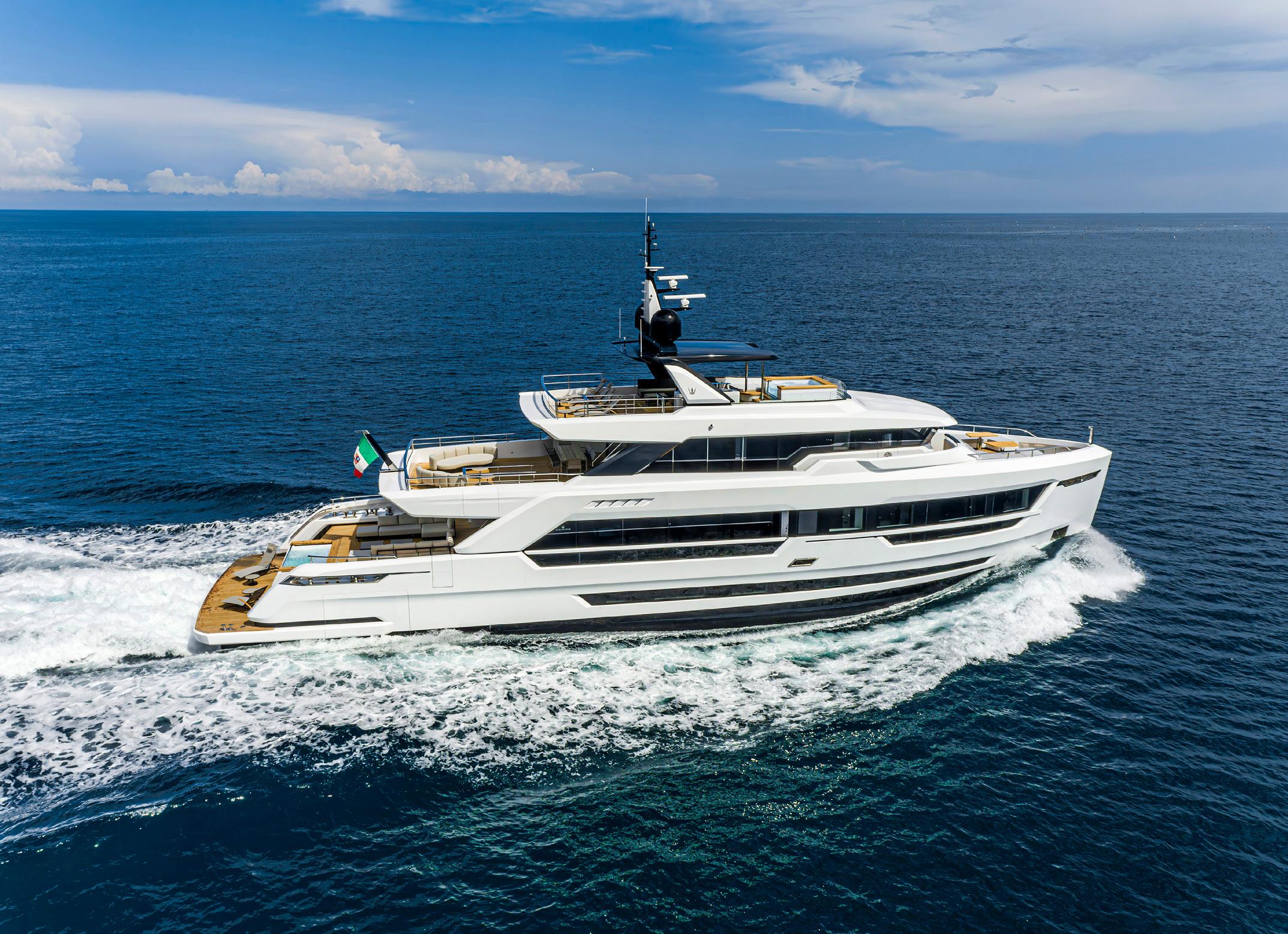

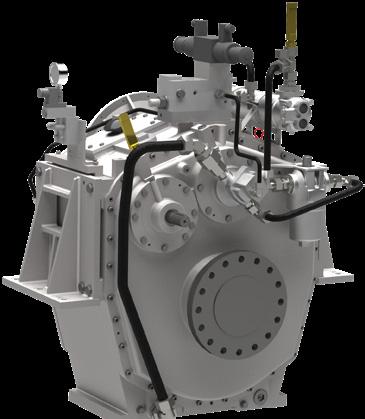
*equipped with 2 x WAF 464L
Superyacht operations have long been a complex juggle of multiple systems, endless emails, and spreadsheets until DeepBlue stepped in. The company launched its software solution platform in 2013 and has been transforming and simplifying the landscape of yacht management ever since. Easing workloads for crew, DPA’s, accountants, and management agencies, DeepBlue redesigns and constantly updates each corner of yacht operations within its centralised platform. From finance and fleet management to security, the company will showcase these latest developments this year at the autumn yacht shows, including the Monaco Yacht Show and METSTRADE.
Money makes the superyacht world go round, and at the heart of the company’s offering is its upgraded accounting module, which streamlines all yacht financials, simplifying managing budgets and expenditures. A game-changing partnership with Centtrip allows for seamless reconciliation of card transactions and wire transfers directly within DeepBlue, further streamlining financial processes. The new module has an enhanced layout and new report options, including cash flow and budget comparisons. There are multiple elements to financials onboard, and procurement is one of them. With DeepBlue’s updated and intuitive Purchase Order (PO) module, yachts can now easily create, approve, and manage orders. Used in conjunction with the Inventory, Spare parts, and Finance modules, the PO is a highly efficient and seamless tool for all crew departments to utilise.
For charter yachts, DeepBlue provides a dedicated module for Advanced Provisional Allowance (APA) management and reporting. This overhauled system enables unlimited APA accounts per charter, providing transparent tracking and reporting of all transactions. Fully integrated with the Finance module, it functions perfectly for the most efficient charter operations.
The newly redesigned flagship Fleet Management product (v1.10) draws from a decade of experience in complex data management and offers a comprehensive fleet dashboard, powerful reporting tools, and fleetwide actions.
Several hundred yachts and thousands of users are currently utilising DeepBlue, and the number is increasing as users see the benefits. The Fleet Management module gives a bird’s-eye view of entire fleets, from crew data and document status to pending invoices and tasks, charter calendars, and ISM safety documentation and reports.
Recognising the need for on-the-go access, especially within busy seasons, DeepBlue has launched a mobile app focusing on essential crew operations. The unlimited user policy allows yachts to delegate simple tasks to the crew. This toolkit features mobile modules such as timesheet reports, leave requests, expense logging, and inventory management via QR codes. With large amounts of data comes the worry of protection, but security hasn’t been overlooked. The company has introduced two-factor authentication via the mobile app, ensuring secure account access. Additional options are available for more sensitive actions. Permission levels can also be adjusted depending on yacht needs and access.
As superyachts grow in size and complexity, DeepBlue is at the forefront of management solutions, offering a centralised platform integrating a 360-degree approach to all yacht operations. This eliminates the need for multiple systems, which often lead to inefficiency, and instead seamlessly integrates various task-specific modules for a cohesive, go-to experience.
https://deepblue.app/
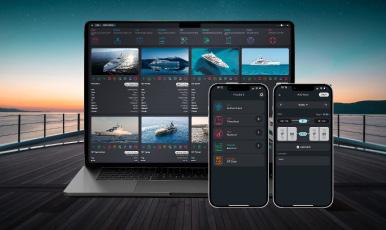
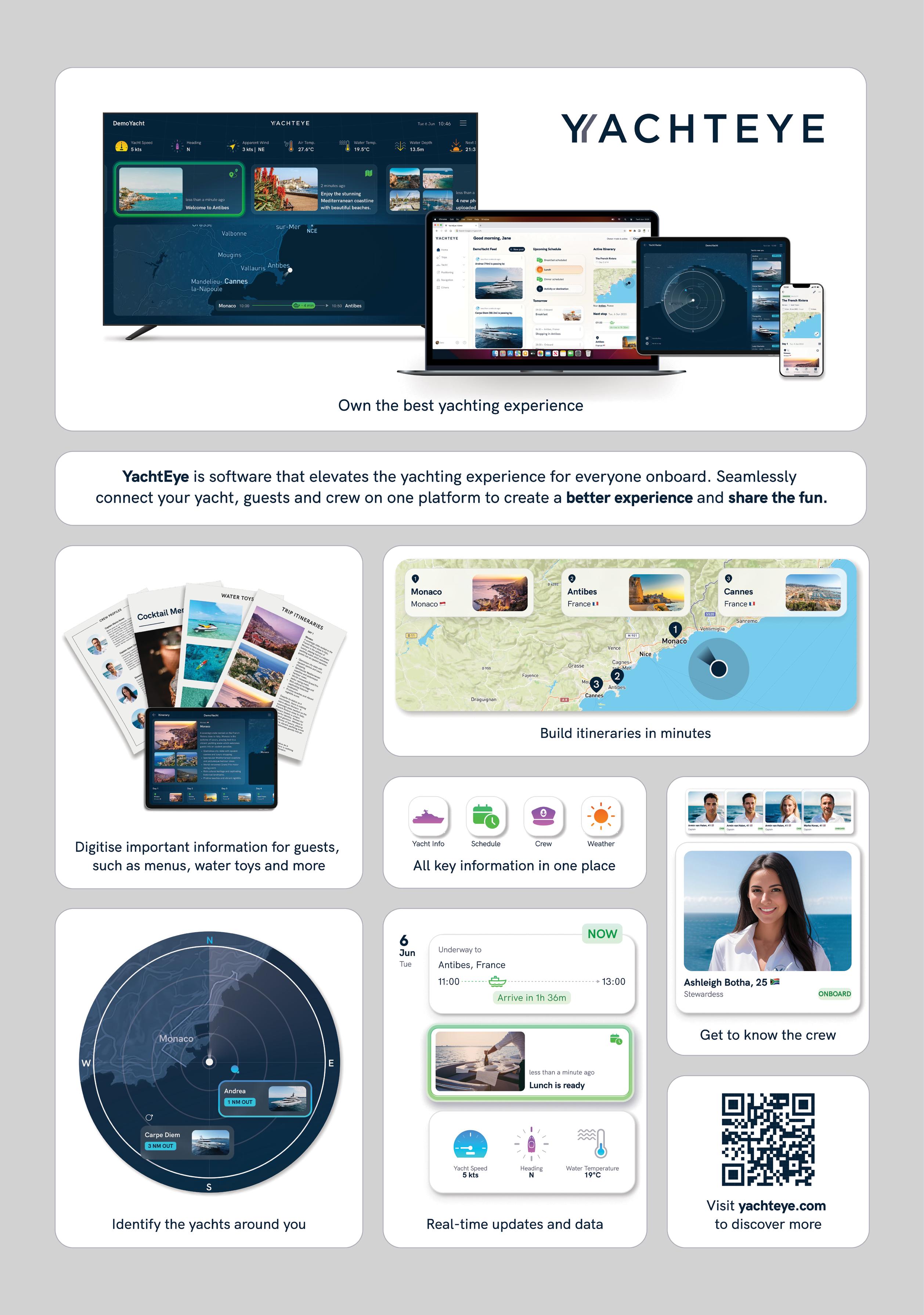

Volvo Penta’s new IPS professional platform takes the winning IPS concept, beefs it up for commercial use and aims it squarely at the 40-60 metre size bracket. With the first superyachts to feature the system already under construction, will this prove a disruptor in the big boat sector?
BY CHARLOTTE THOMAS
Volvo Penta launched its inboard Performance System (IPS) drivetrain on the leisure boat market in 2005 after years of secret research and development. The timing was fortuitous: the first superyachts to feature Azipods – Lürssen’s 90-metre Ice (exAir) and Benetti’s 65-metre Ambrosia – were soon to be launched to great fanfare, and the IPS system would prove to be a game changer at the other end of the scale.
The two propulsion technologies were very different, but the advantages were remarkably similar. The IPS’s efficient, forward-facing, azimuthing ‘legs’ provided assured handling and manoeuvrability, just like the Azipod thrusters made independent rudders redundant and offered a drive unit that would pave the way for diesel-electric, hybrid and, ultimately, electric propulsion installations.
Volvo Penta has grown its range considerably in the intervening years, developing larger IPS units coupled to bigger Volvo Penta engine blocks of up to 1,000hp, which in a multipleIPS30 configuration can comfortably power yachts up to 30 metres. At the same time, the uptake of azimuthing drives in the larger superyacht segment has grown steadily. But there has always been a blind spot: the 4060 metre bracket, where the commercially orientated azimuthing pods are too large and the current crop of IPS options – along with more recent alternatives from Cummins and Caterpillar – are too small.
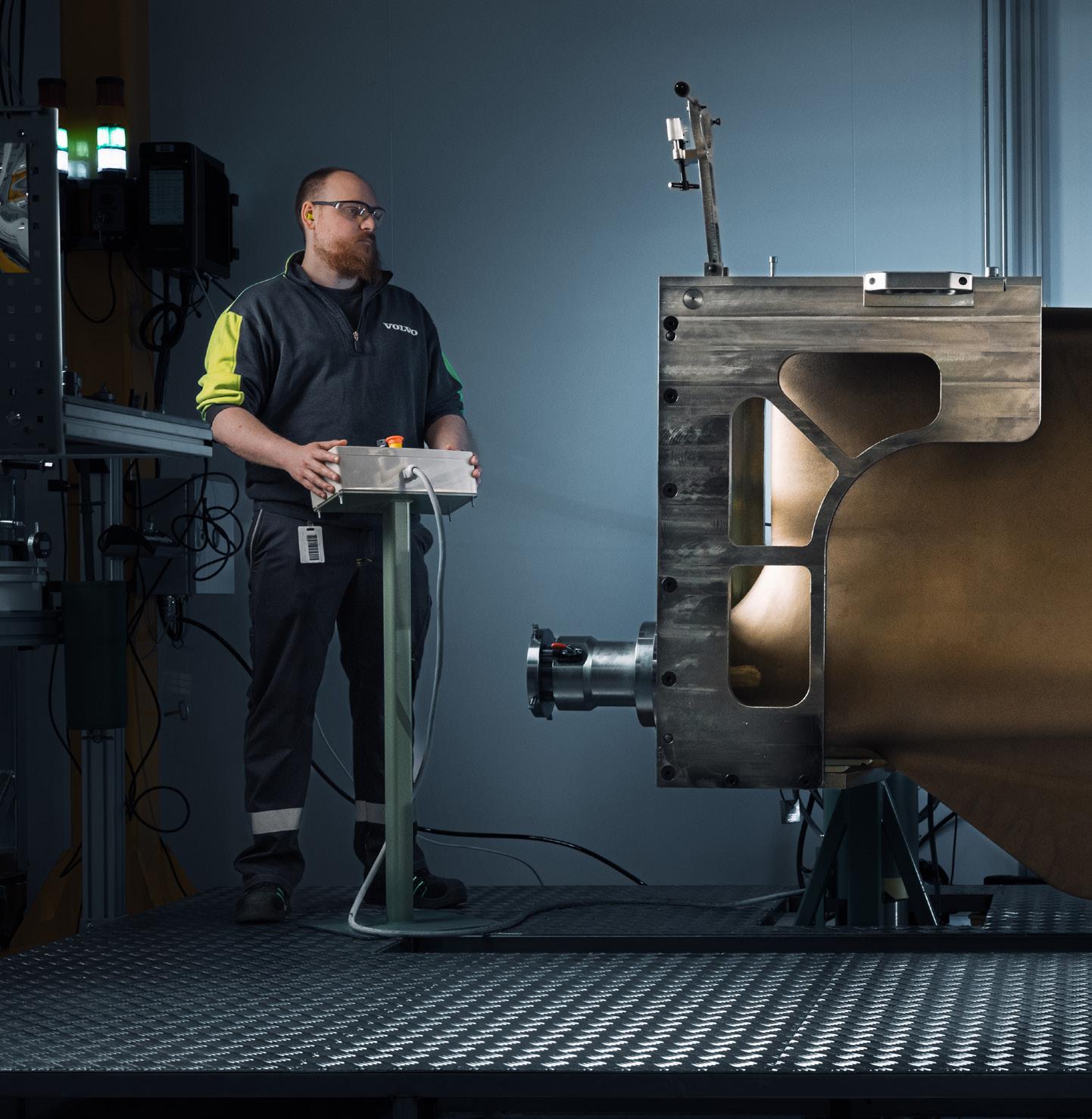
It is fitting that Volvo Penta chose this year, the 20th anniversary of the original IPS drive, to launch a new addition to the range that fills the gap. Named IPS Professional Platform, the drive unit at the heart of the system is the all-new IPS40, but the name is significant because the new unit is designed primarily for commercial use with an emphasis on robustness, longer service, shorter maintenance intervals and a configuration that suits a variety of operational profiles. It also signifies a leap for IPS into one of the fastest growing segments of the superyacht fleet.
“Launching IPS 20 years ago gave us a platform to innovate in the marine industry,” says Johan Inden, former CTO and current President of Marine Business at Volvo Penta. “Volvo Penta IPS professional platform is now a step of magnitude into much larger yachts and commercial vessels, and it’s a commercially spec’d product from the beginning, meaning we started with our commercial customers as the primary requirement setting.”
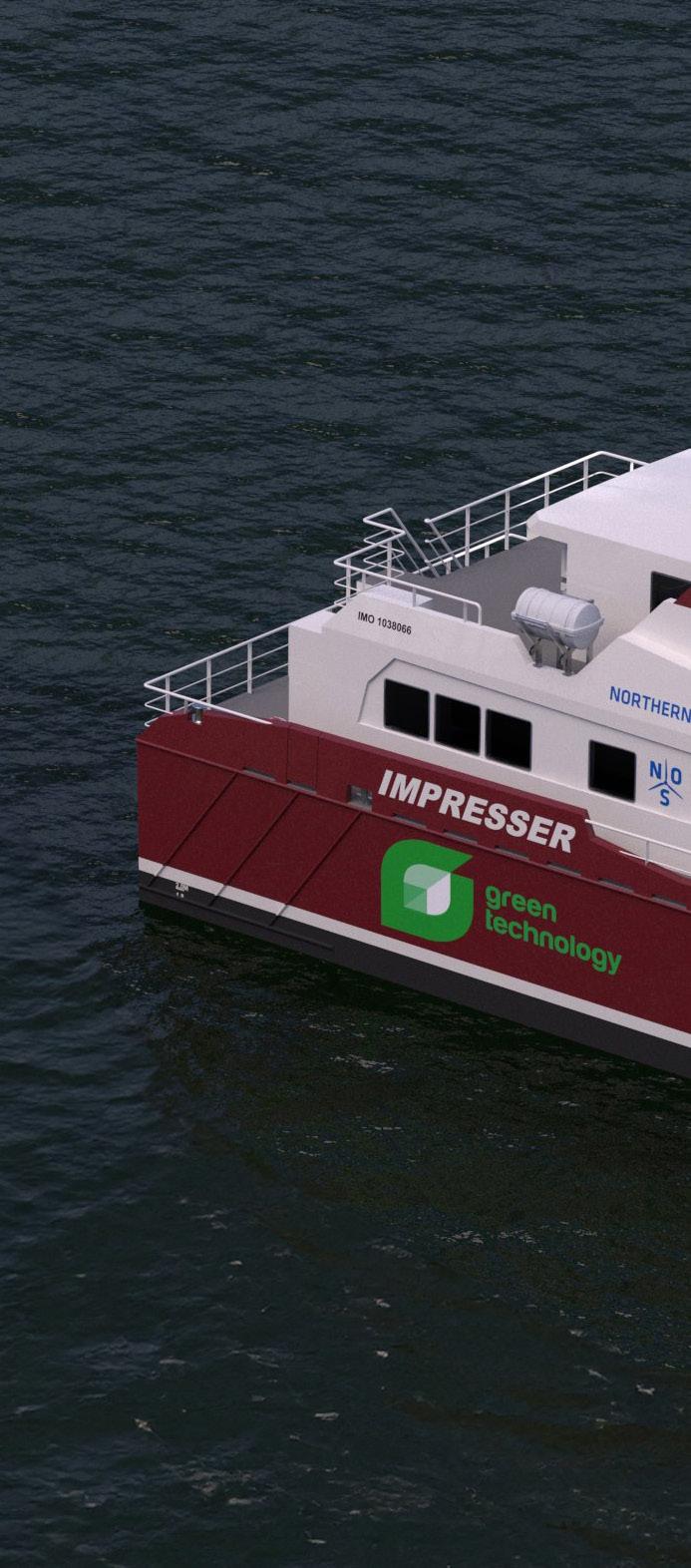

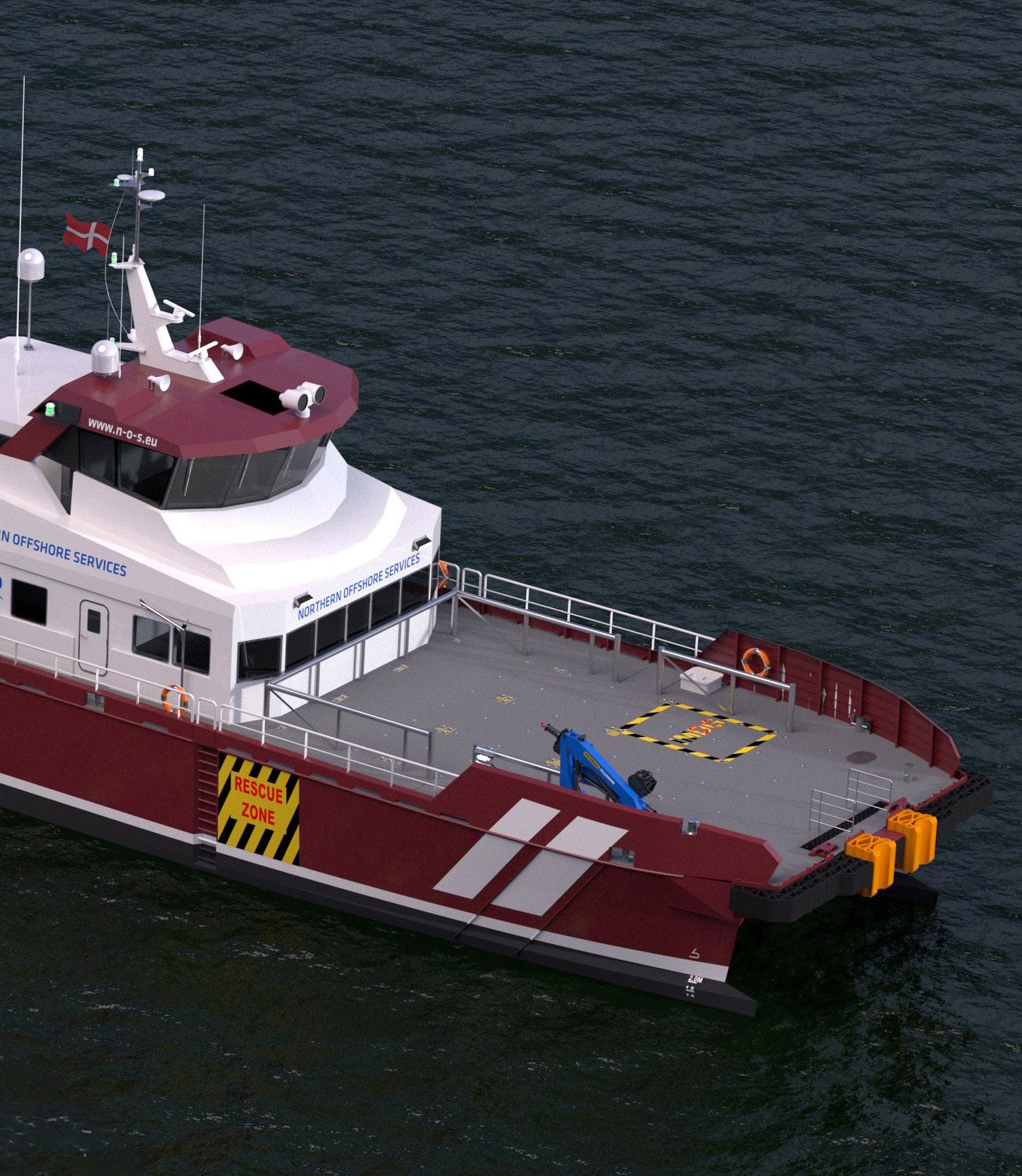
To test the IPS40 drives Volvo Penta bought a 25-yearold, 37-metre passenger catamaran that had previously operated in the archipelagos of northwestern Norway. The cat had conventional in-line propulsion with variable pitch propellers driven by four (non-Volvo Penta) 965hp engines. The team at the Volvo Penta test facility in Krossholmen ran the ferry for six months with the original propulsion package to log data and see how she performed, before rebuilding it with the IPS professional platform using two IPS40 units with two 800hp D13s attached to each unit. The IPS units were installed much further aft in the hulls, with around four metres freed up compared to the conventional drive system – enough for another crew cabin or, on a yacht, additional guest area.”
“With less horsepower we still achieve the same service speed of 31 knots, and we saved 2,000kg in weight even though we added Tier III treatment systems,” says Petter Andolf, Chief Project Manager. “The vessel also uses less fuel at speed, and up to 14 knots the system runs with only two of the four D13s, so you save a lot more at low speeds. Acceleration to 30 knots used to take over 50 seconds, but with the IPS it now takes 28 seconds and the turning radius has decreased by 20 percent.”
Applying the data captured from the Penta 40 to a similar ferry operating on the Amalfi coast, which Volvo Penta has been logging data on for the past three years, the team says that ferry could save 22 percent of fuel per year, which equates to more than 70,000 litres of diesel or 190 tons of CO2 emissions, and would also save 600 hours per engine each year with all the associated benefits in terms of maintenance.
How To Build It was able to experience the IPS Professional Platform on the Penta 40 in May 2024, and also docking the ferry alongside using a standard IPS joystick control. The system is simplicity itself to use and the control inch-perfect in close quarters. In addition, the performance underway was excellent, so it will be exciting to see the results on the first superyachts to have the professional platform .
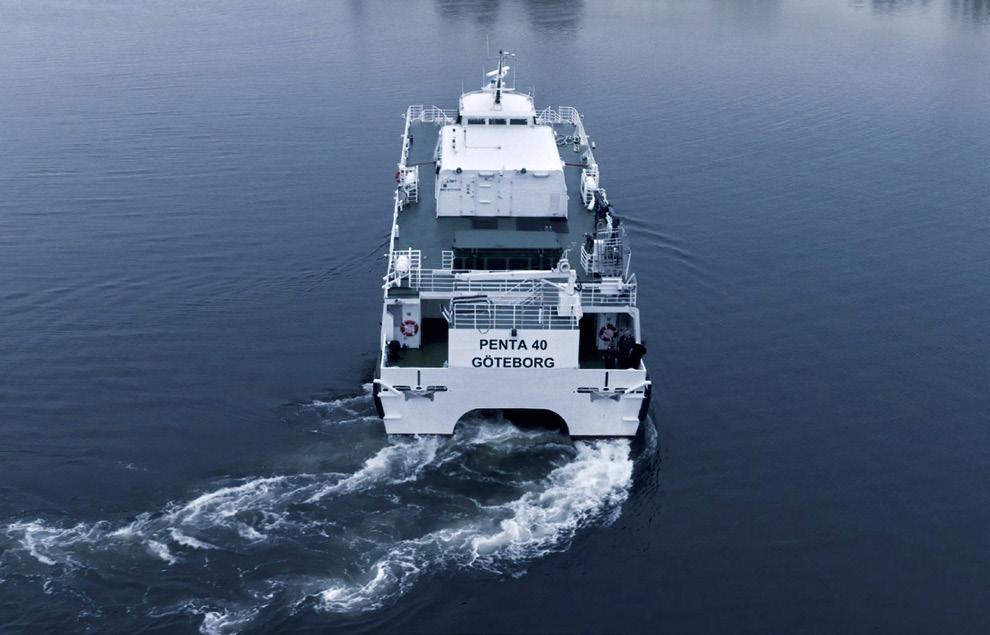
One of the key design aspects of the IPS40 system is the twin, fore-and-aft engine arrangement that powers each drive unit. It is here that the Volvo Penta team have considered current and future tech, not only in the software switching between one or both engines depending on speed for fuel efficiency, but also in what else could power the units.
For example, along with a single D13 engine, the second drive could be an electric drive motor powered by a battery bank or, in the future, fuel cells to effectively create a hybrid drivetrain. As full-electric solutions come on stream, both power units could be electric motors, delivering emission-free propulsion. The drive unit itself is somewhat agnostic as to the power source, providing an element of future-proofing. This was also a consideration when designing the drive’s dual-powered transmission.
“In the first place it has been conceived to work with the D13 engines, but we knew we needed to plan for the coming hybrids and full electric solutions,” says Skoglund. “So the concept study was quite wide from the start and to optimise it for full electric it would probably not look exactly like it does now, but this is a good compromise that will be fairly efficient in all combinations.”
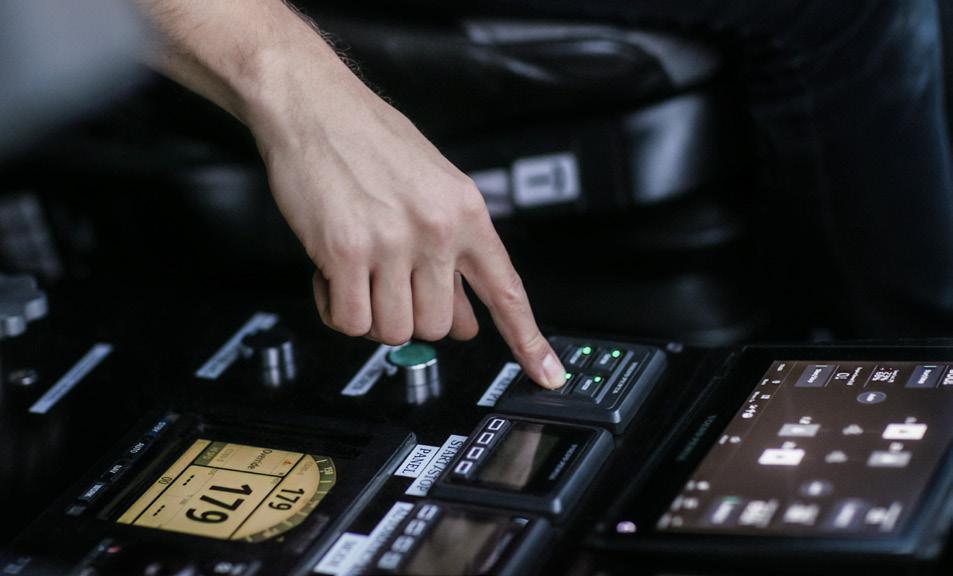
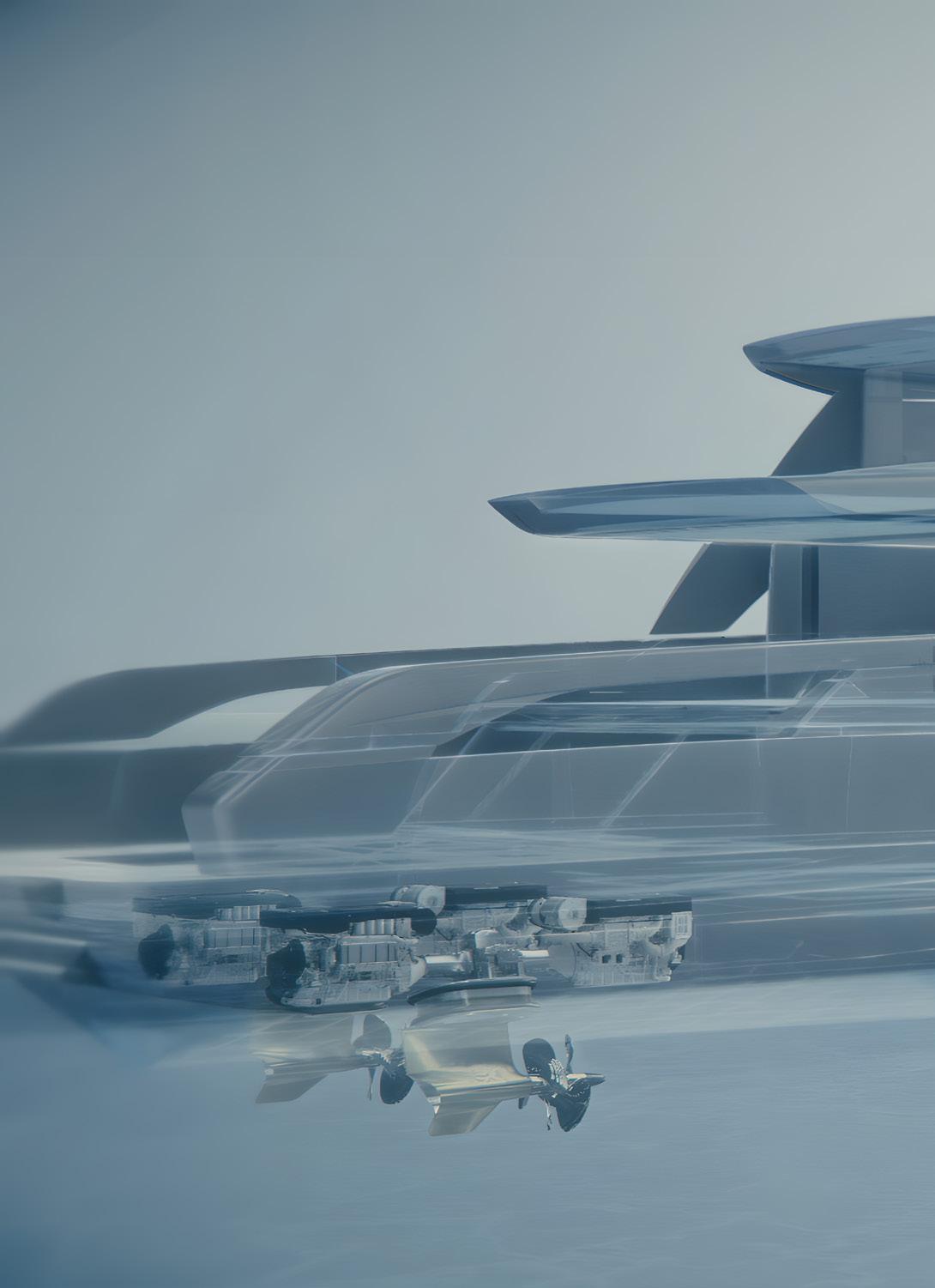
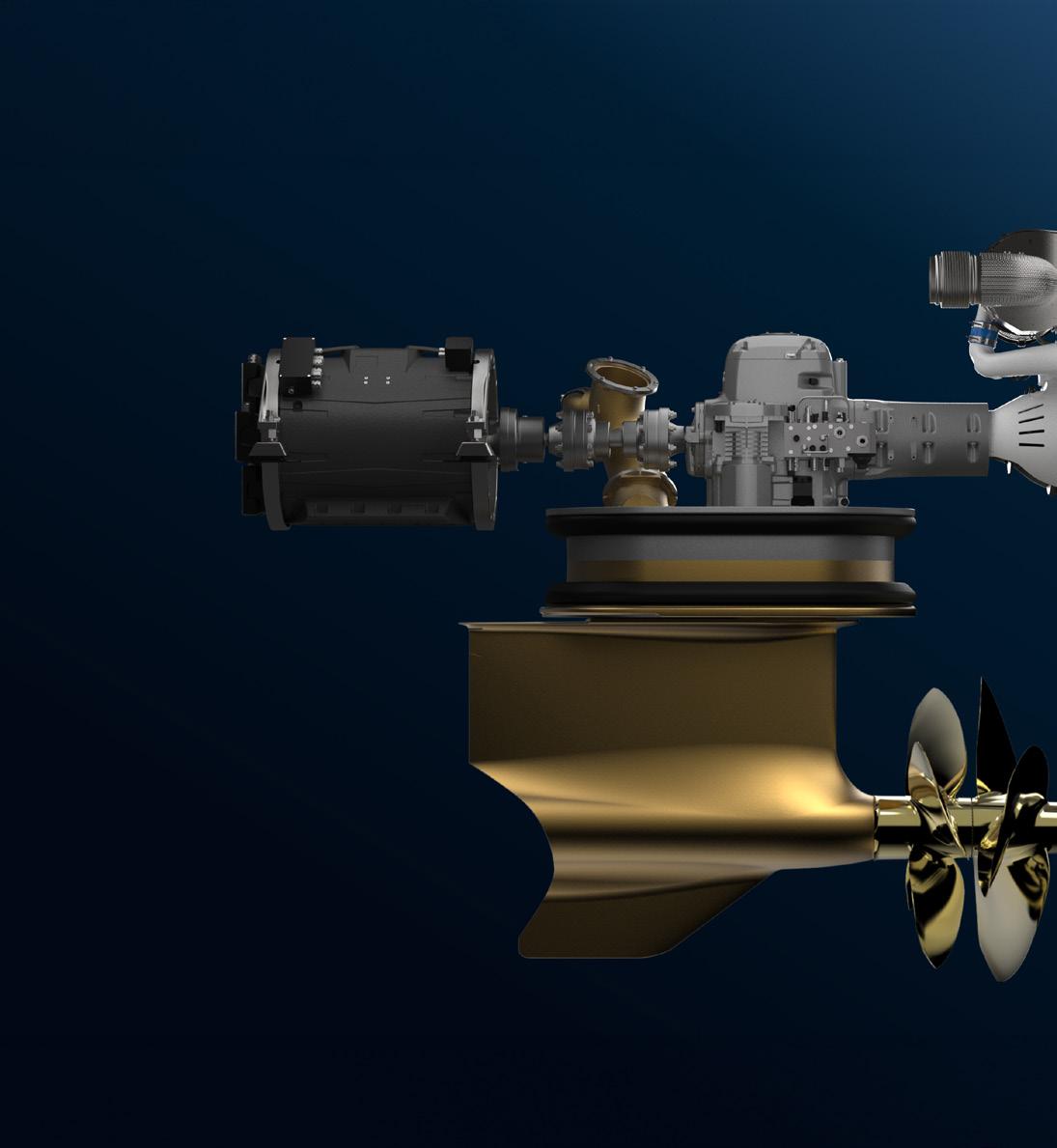
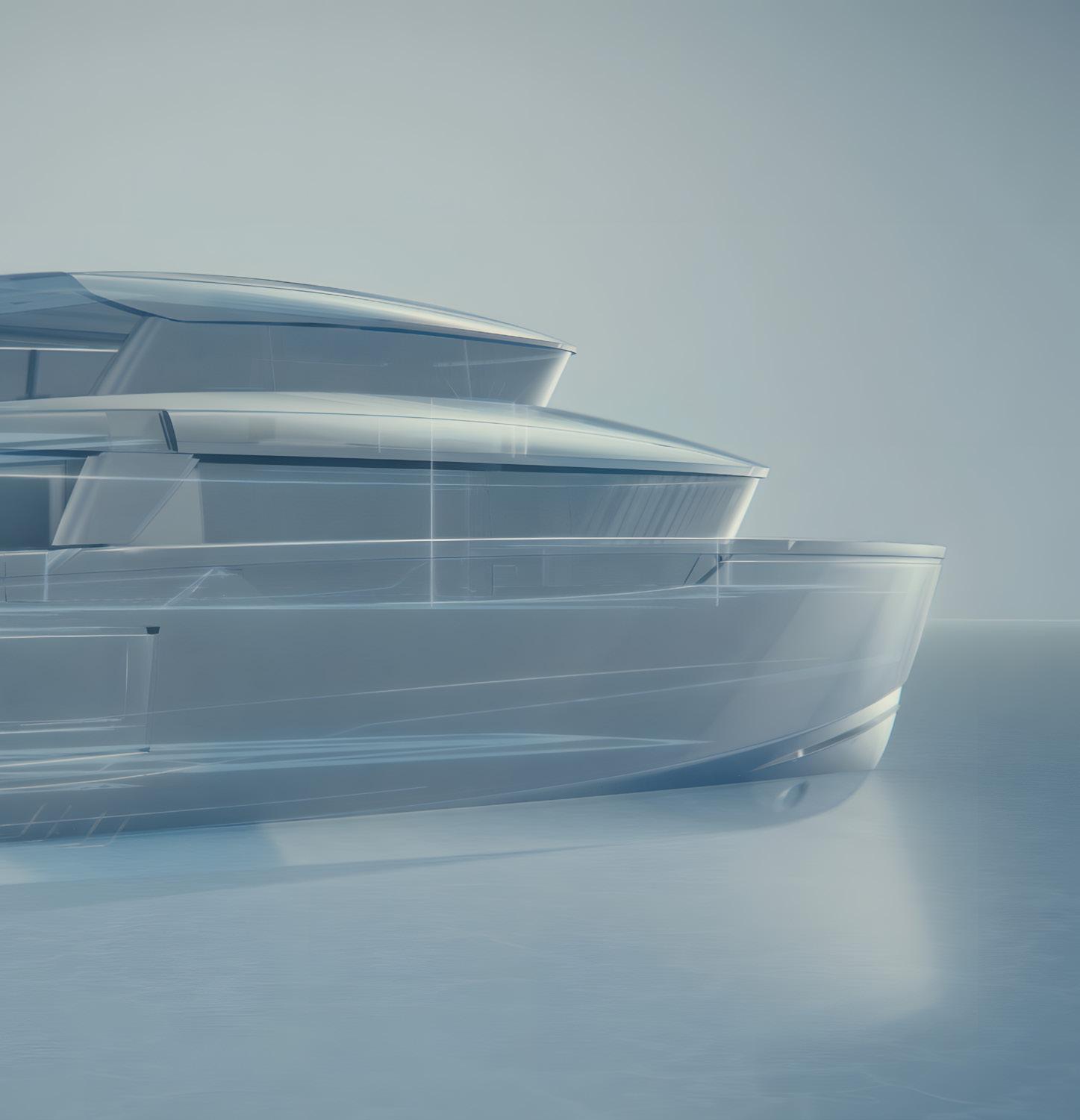
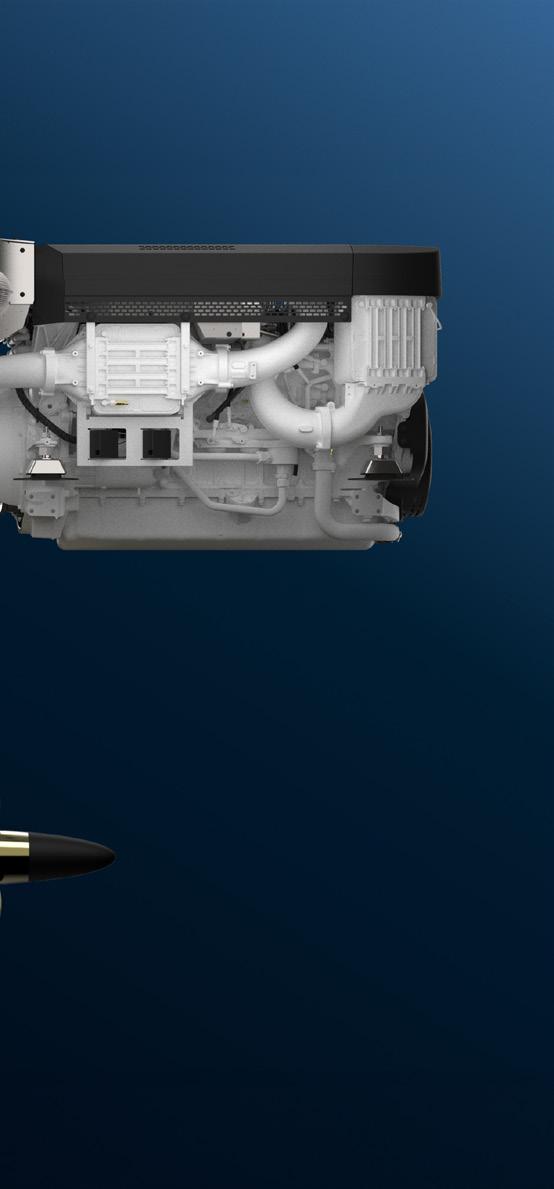
“We’re designing for a very wide operating range for both displacement vessels and faster hulls from 12 to 40 knots.”
The IPS professional platform combines the heritage of the regular IPS installation with a number of novel features. Instead of incorporating a larger and more powerful engine, for example, it has a twin-engine setup and each unit will be connected to two 13-litre D13 engines. It's joystick-driven, has DPS functionality and assisted docking – all features of the IPS family – but the concept has been ‘stretched’ to serve vessels up to 55 or even 60 metres.
“We’re designing for a very wide operating range for both displacement vessels and faster hulls from 12 to 40 knots, which we achieve by having a number of different propellers and gear ratios available,” says Inden. “You can have expanded range or lower fuel consumption, or you can spend efficiency in other ways; you can make it lighter, go longer, or enhance acceleration, in combination with reduced noise and a better turning radius. You get a different performing vessel.”
The design development of the professional platform has involved over 9,000 hours of computer simulation and 1,000 hours of sea trialling on a specially modified, 37-metre catamaran passenger ferry (see sidebar p.101), while also building on 846,000 hours of data logged from IPS30 drives that enabled the team to see exactly how vessels are operated.
“It’s a pretty simple pattern,” says Inden. “You spend time at low speed and at high speed, and very little time in the transition zone. From this we realised the twin-engine set-up will really drive efficiency.”
With Volvo Penta supplying the complete system, from pod and powertrain to hardware and software control, it can implement smart elements such as automatically shutting down one of the two engines when at lower speeds to save both fuel and engine hours (Volvo Penta claims 25 percent fewer engine hours in a general use case). The system can also alternate which engine is shut down to ensure engine hours remain balanced. But there’s more to the system:
“The first generation is twin diesels, but this is where the ingenuity of the solution comes because we will also offer a hybrid version where you have a diesel engine on one side and an electric engine on the other,” Inden says. “And then you start building flexibility for having a large battery pack, or a fuel cell or a bank of generators. And the third generation, which will be the long-term solution, is full electric with twin electric engines. This is something we’re already working towards and we have an internal timeline to achieve it.”
While the fundamental design of the IPS40 units is broadly similar to its smaller siblings, the commercial requirements and the complexities of the twin-powerplant installation has meant a more fundamental design and engineering rethink. In other words, it is not just a scaling up of the smaller IPS units.
“The design is centred on other demands such as strength and durability,” says Martin Skoglund, Vice President Product Management Marine. “For example, it’s not that because we have double the torque we just need to double the size of the bearings – it doesn’t work like that. We also started working quite early with DNV to understand class requirements and how we could fulfil required redundancy in smart ways.”
The IPS40 units are a step up from the IPS30s not only in capability – the maximum steering angle for the units has been increased from 28 to 40 degrees, for example – but also in terms of sheer size. The IPS40 weighs two tonnes not including the engines, twice the weight of the IPS30, and with the twin-engine configuration that has meant a fundamental overhaul of the design process that Volvo Penta typically provides for the shipyard.
“The sales engineering department is helping out with questions of naval architecture and for elements like positioning and the new centre of gravity when repowering with the IPS professional platform,” says Skoglund. “We are using four case studies developed with two superyachts and two crew transfer vessels to see what documentation we will need to provide, and how we need to update our simulation tool to help the designers.”
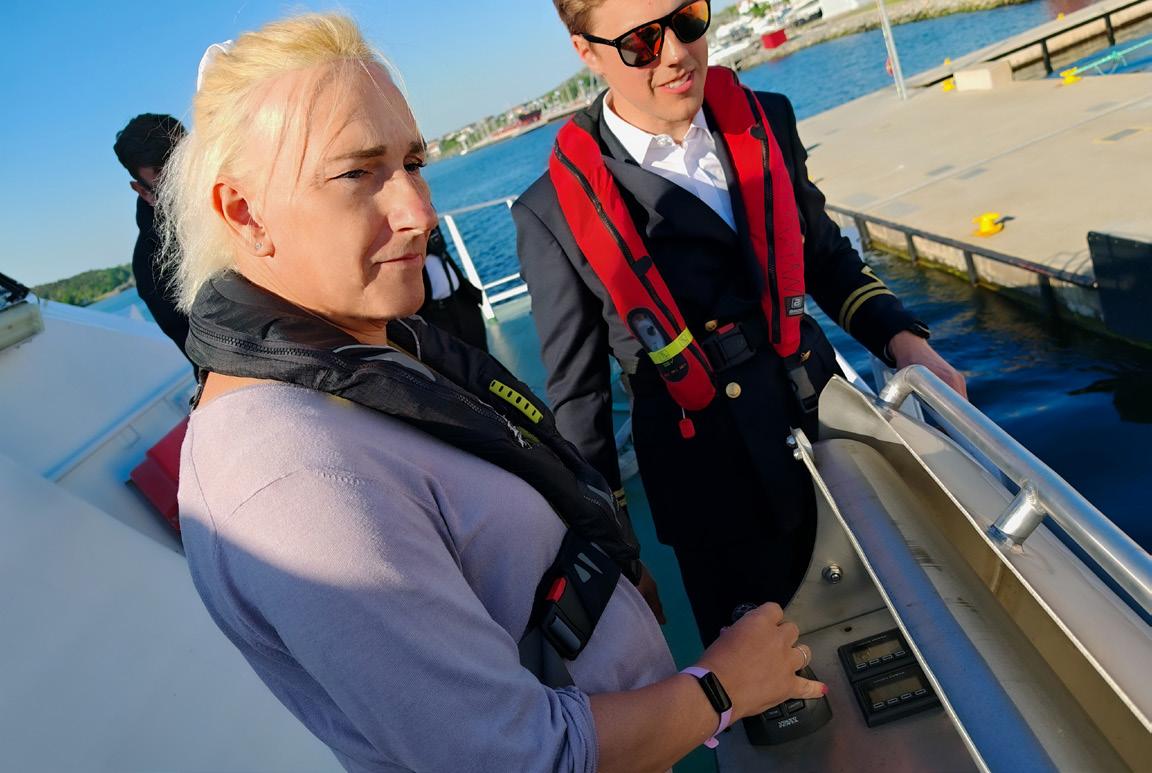
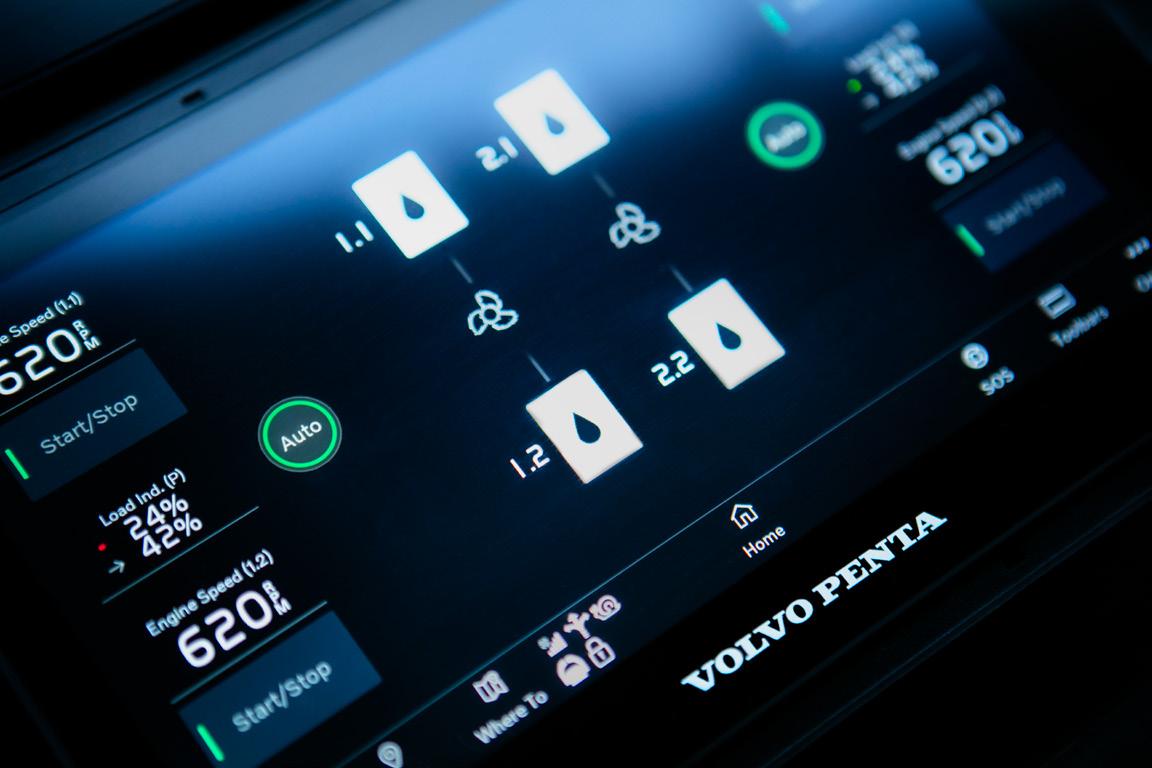

The IPS40s are being built on a new production line at Volvo Penta’s facility in Köping.
Facing page, from top: The author docking the Penta 40 test catamaran; the IPS system interface showing the twin engines.
The first yachts to feature the IPS professional platform are already under construction, including a Sanlorenzo that will feature the higher-rated 1,000hp D13 engines for speeds of around 23 knots, and the first 41-metre Amer (featured in this issue of How To Build It) that will carry IPS40s with the 700hp D13s for displacement speeds of 14 knots. The first two crew transfer vessels, which will serve as in-operation trial vessels, were due to enter service at the end of the summer 2024.
“We’re working with some other yacht builders that I can’t disclose,” says Martin Jufors, Vice President Sales Marine, “but we have a lot of interest both from existing customers, and from new customers for whom the IPS40 provides a solution to power a wider proportion of their range,”
The IPS40s will be built on a new production line in a clean room at Volvo Penta’s giant facility at Köping, Sweden, alongside the smaller IPS production lines, where there are also on-site test facilities. The split of units will be 50:50 between commercial and yachting and although it will start off fairly low volume, the new production line will be able to ramp up if required. Current production will be available for delivery in 2026.
The launch of the IPS professional platform is a potentially significant development for the mid-size superyacht bracket, especially given the built-in flexibility of the system to switch to hybrid and electric drivetrain options using the existing transmission design.
“With the two commercial vessels entering service in 2024 for a Swedish operator and the first yachts with the IPS professional platform due for launch in 2025, it’s great to see it all starting to happen,” Inden concludes. “These are really exciting times for us!”








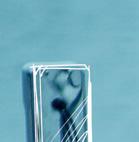




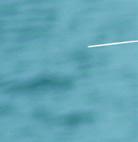


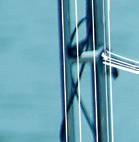

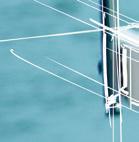
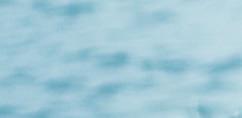






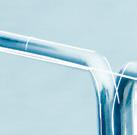
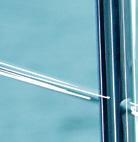
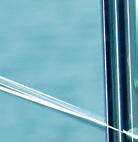
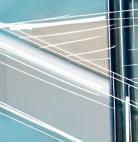














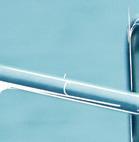
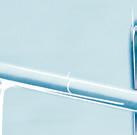

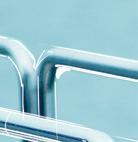

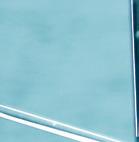
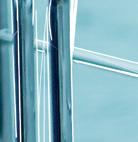
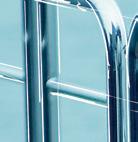
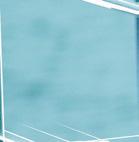

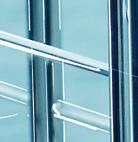
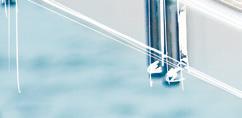
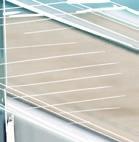
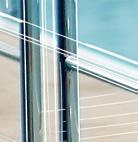
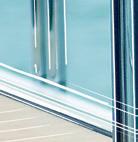

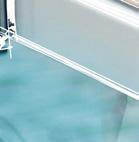
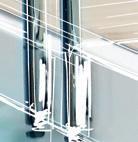


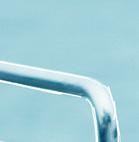
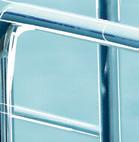
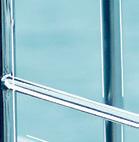
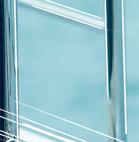
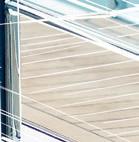



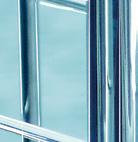



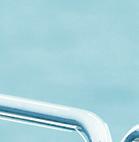
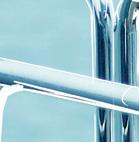
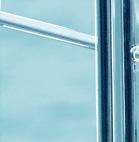
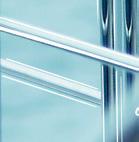
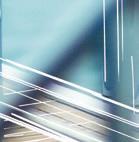





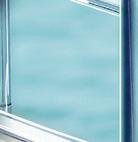

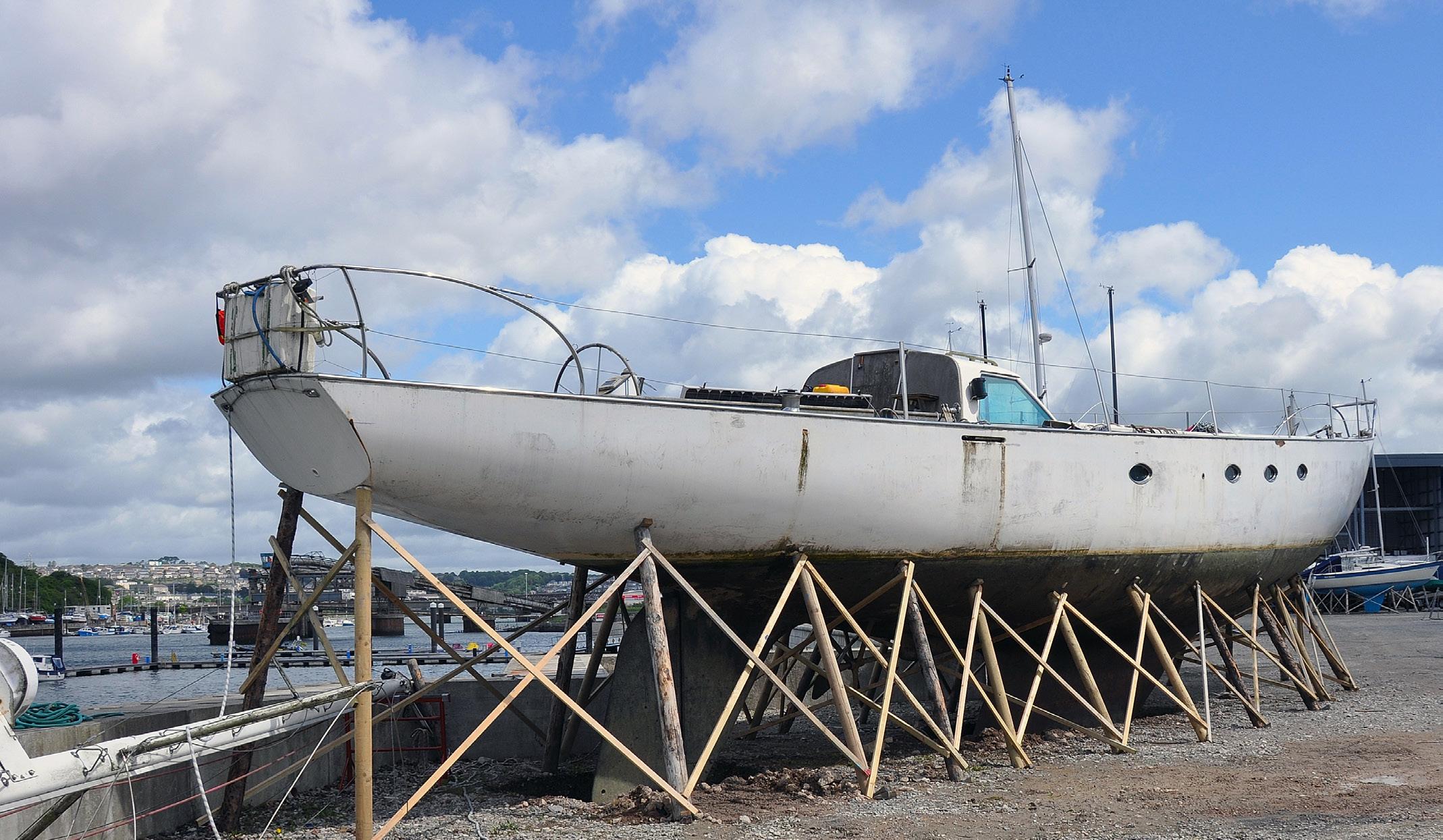
As a growing number of fibreglass yachts near the end of their lives, the industry has a problem: how do we deal with these fundamentally eco-unfriendly composites? Two enterprising brothers are coming up with solutions, both for up-cycling the existing fleet and for rethinking the future of composite building, while refitting a 55-year-old GRP sailing ketch.
BY CHARLOTTE THOMAS
When brothers Dan and Nick Couchman came across a classic 22.77-metre GRP ketch in the French harbour of Morlaix just over a decade ago, little did they realise they would be about to embark on a voyage of discovery. The yacht, named Francis Drake, was the last of eight designs by Robert Clark (the designer of British Steel for Sir Chay Blyth and Gypsy Moth III for Sir Francis Chichester) for the UK’s Ocean Youth Club charity at the start of the 1970s. But years of service taking over 15,000 young mariners to sea followed by private ownership, neglect and the ravages of time had reduced the oncepioneering yacht to little more than a wreck. “The owner had struggled and not quite abandoned her, but he had certainly not paid the marina fees and so they had moved her from a pontoon to a horrible damp sea wall, where she’d been for a couple of years,” begins Dan Couchman. “She was damaged on her port side and there had been a lot of moisture ingress. Her then owner was the inventor of a synthetic decking product, and she had the prototype covering crudely laid on her deck. Having stripped a lot of boats down, I knew it was pointless spending money on a surveyor, because I knew what they would say – don’t touch it!”
Nevertheless, the brothers decided they wanted the yacht, not least because Francis Drake is synonymous with their home town of Plymouth, and after a year of intense negotiations she was theirs. They sailed her back – somewhat precariously – to the UK, hauled her out and mothballed her for close to eight years while they decided what to best to do with her. “We were both busy with other business ventures – me in the marine industry and Nick in the sports world – and over the years we gradually came up with a plan of action,” says Couchman. Their plan was to refit the yacht from a training vessel carrying 14 teenagers in pipe cots to a luxury charter vessel with a large master cabin and two aft guest cabins, plus a cabin for two crew, and also to take advantage of the opportunity to address a more fundamental issue facing the marine industry.

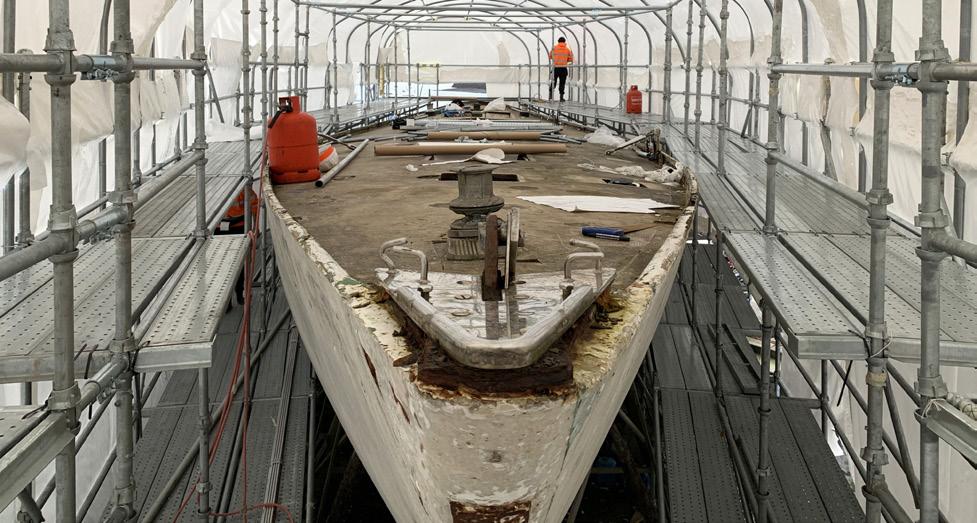

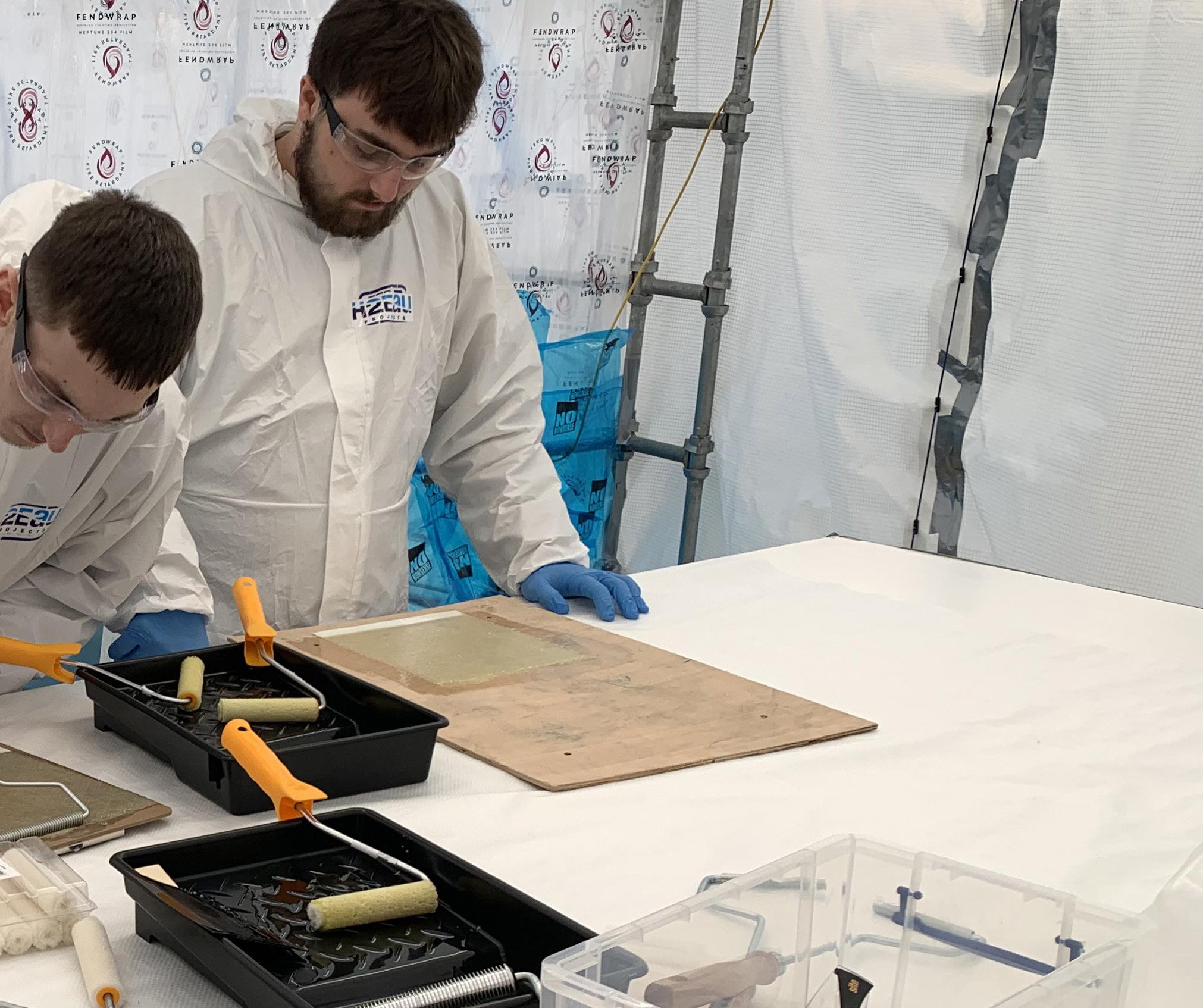
“The idea was to create an industry template on how we can address the problem of GRP when it reaches the end of its lifecycle,” Couchman explains. “Francis Drake is now almost 55 years old and she was a potential 35-ton landfill disaster. How do you bring an existing classic yacht back to life with the latest materials, technologies, build processes and, more importantly, with a sustainable approach to the whole project? We wanted to make this project the epitome of up-cycling.”
Dan, a former yacht captain, set about tapping into the various contacts he’d built up over his career in the marine industry, and bring them on board the project as partners to explore solutions to the GRP problem. Work began in earnest in 2022 with the restoration being undertaken under the umbrella of the brothers’ company H2Eau Projects, alongside Warwick Buckley at BYD Naval Architects (a veteran sailor, Warwick crewed aboard Flyer II that won the 1981-82 Whitbread Round the World Race).
Bottom:
When we visit the yacht in October 2024, she is housed in a shrink-wrapped tent with a specially designed scaffold structure, sitting on hardstanding at the edge of the sea wall at Plymouth’s Yacht Haven Quay (indeed, not long before, part of the sea wall had collapsed in a storm, leaving Francis Drake perched perilously close to ruin). What’s hiding inside the tent is an intriguing project, both for the bold approach the team is taking and the indepth research it has been conducting.
“When she was built the design was groundbreaking as no one had tried building a 72-foot yacht in GRP before, certainly not in Europe,” says Couchman. “Clark, however, insisted on using steel stringers and longitudinals instead of composite, which the Lloyds surveyor had wanted them to use. The steel stringers were inverted angle profile with the channel facing upwards; so of course the moment someone put any of the thousands of holes in the deck over the years, the water just flowed off the deck and into those channels to be distributed all over the boat like an irrigation system!”
As a result, much of the structure of the hull and deck was corroded and decayed, and the first year was focused on a complete strip-down of the interior and shotblasting the hull to take it back to a single skin.
The team also discovered a horror show of haphazard repairs, from inch-thick layers of paint to car body filler: “It was just an awful mess,” is how Couchman sums it up.
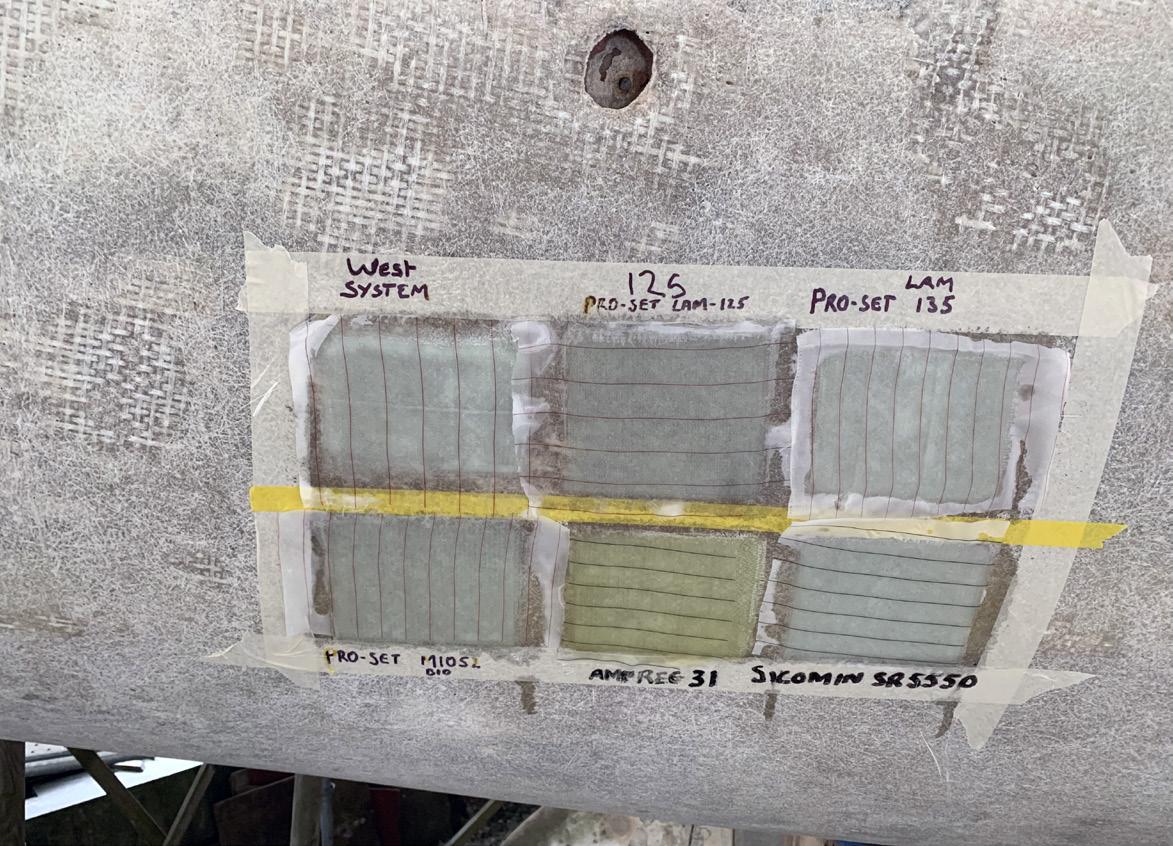

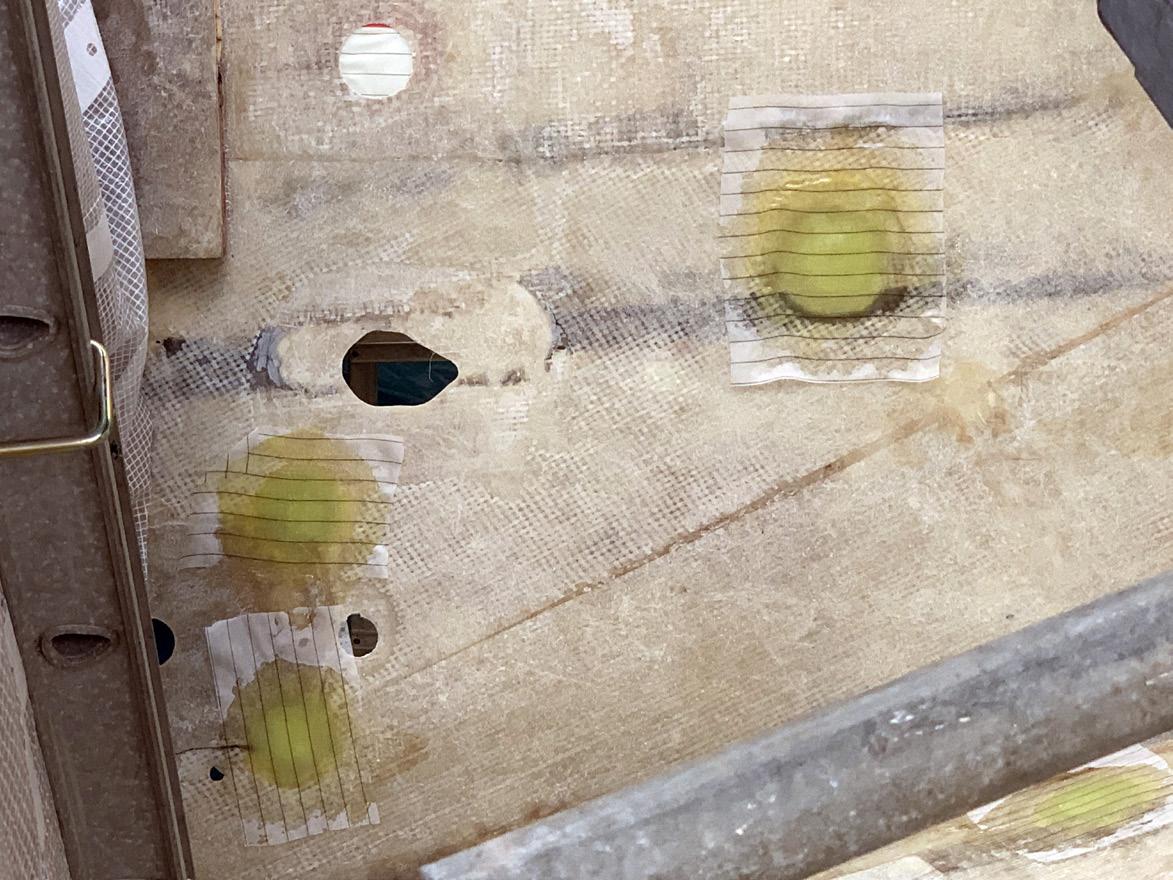
Clockwise from below: Extensive testing was done with six epoxy brands to find the best mechanical bond to the old polyester resin. The team eventually settled on Pro-Set Lam135, using a hole repair kit with Perspex templates cut at multiple diameters to speed up the process.
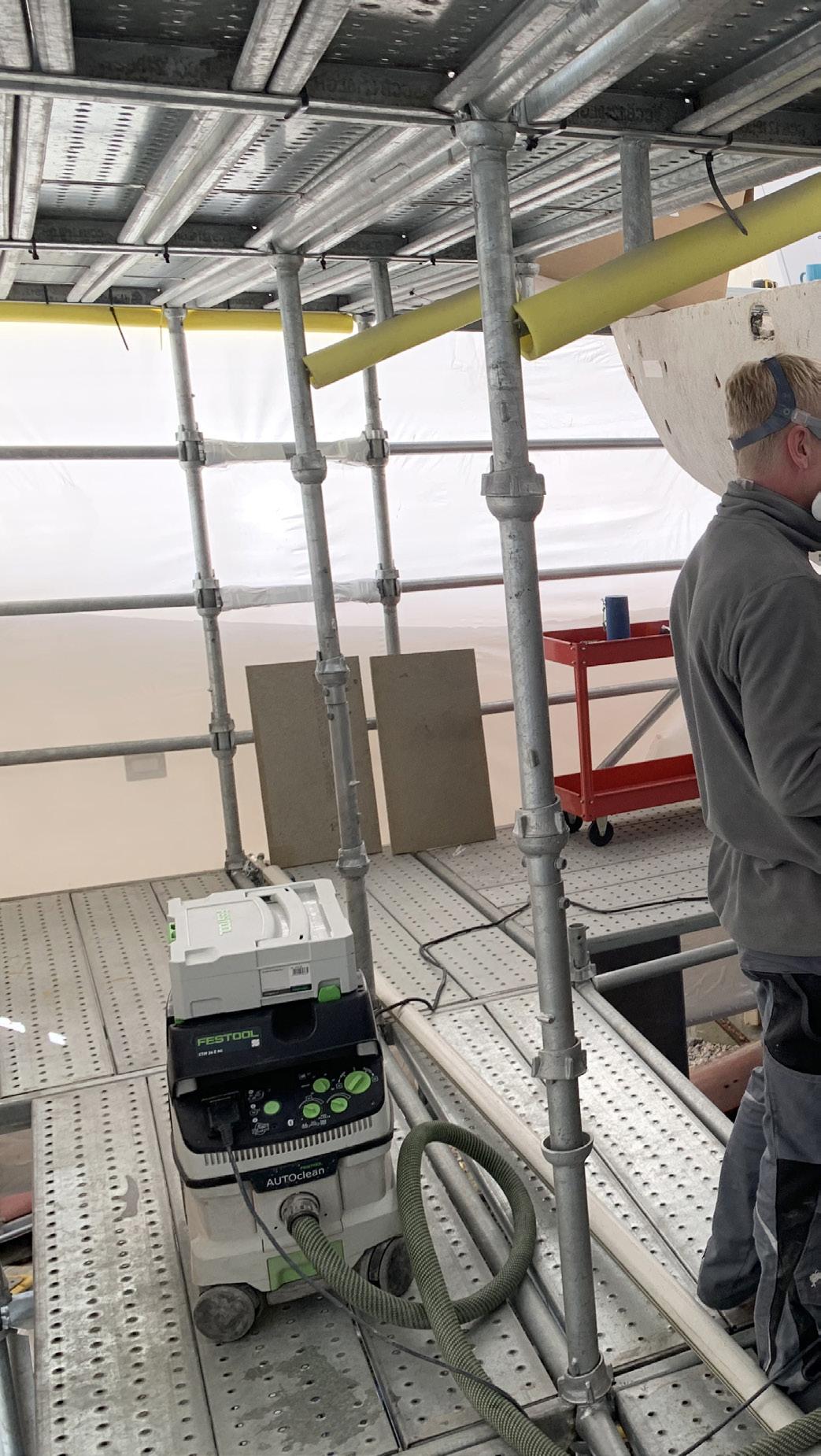
In the sections where the hull had already been peeled right back, the team looked at how best to repair and fill holes in the skin, and brought on board several epoxy companies as partners to what was fast becoming an R&D project.
“With the original hull built using polyester resin, adhesion of new e-glass elements and repairs was an issue, so extensive testing was done with the top six brands to work out which would give the best mechanical bond,” says Couchman. “We used Plymouth University to help us with that and did dollypull testing on the trial patches.”
The team eventually settled on Pro-Set Lam135, and developed a hole repair kit using Perspex templates cut at multiple diameters to create a semi-production line for easy mat cutting. The patch is then held in place against a backing of peel ply and breather tissue glued with West System’s G/flex, that can be peeled off and reused.
“The Pro-Set and the repair technique is very high-end, and used by NASA and the aerospace industry,” Couchman explains.
“The repairs are probably 50 times stronger than the original hull.”
With so much of the original structural elements and core materials beyond salvage, the team is taking a novel approach: basically, the entire hull is being stripped back to a single skin, either side of which a new structure will be built, with the original hull effectively encapsulated for posterity. The next stage will be the lamination of a new sheer-tie against the outer hull skin, with the structure being built up using Diab core, and quadraxial noncrimp fibre mat from Saertex. “We’re using quadraxial because there are a lot of stress forces in the yacht,” Couchman explains. “It was one of the issues with the original design because it was so long and thin.”
The team is also taking the opportunity to raise the topsides and even out some of the concave sheer of the original design, which brings a positive aesthetic change but also improves headroom below – an essential component for a modern luxury charter yacht. However, the project is not just an exploration of how to refit and up-cycle end-of-life GRP yachts: Couchman and his team are also using it as a test bed for new materials and composites that could be used for refit, but also potentially transform composite boatbuilding into a more sustainable industry.
“The repairs are probably 50 times stronger than the original hull.”

H2EAU PROJECTS (4)
“We’re trying to evaluate where we can strip out GRP and get away from what is essentially the asbestos of the industry, which is fibreglass,” says Couchman. “There’s no true recycling for it at the moment – a bit of pyrolysis and a bit of crunching to make tarmac or playgrounds, but that’s about it. When you’ve got a resin system with a core and glass fibre, it’s almost impossible to separate them without some sort of horrible chemical bath, which has its own knock-on effects.”
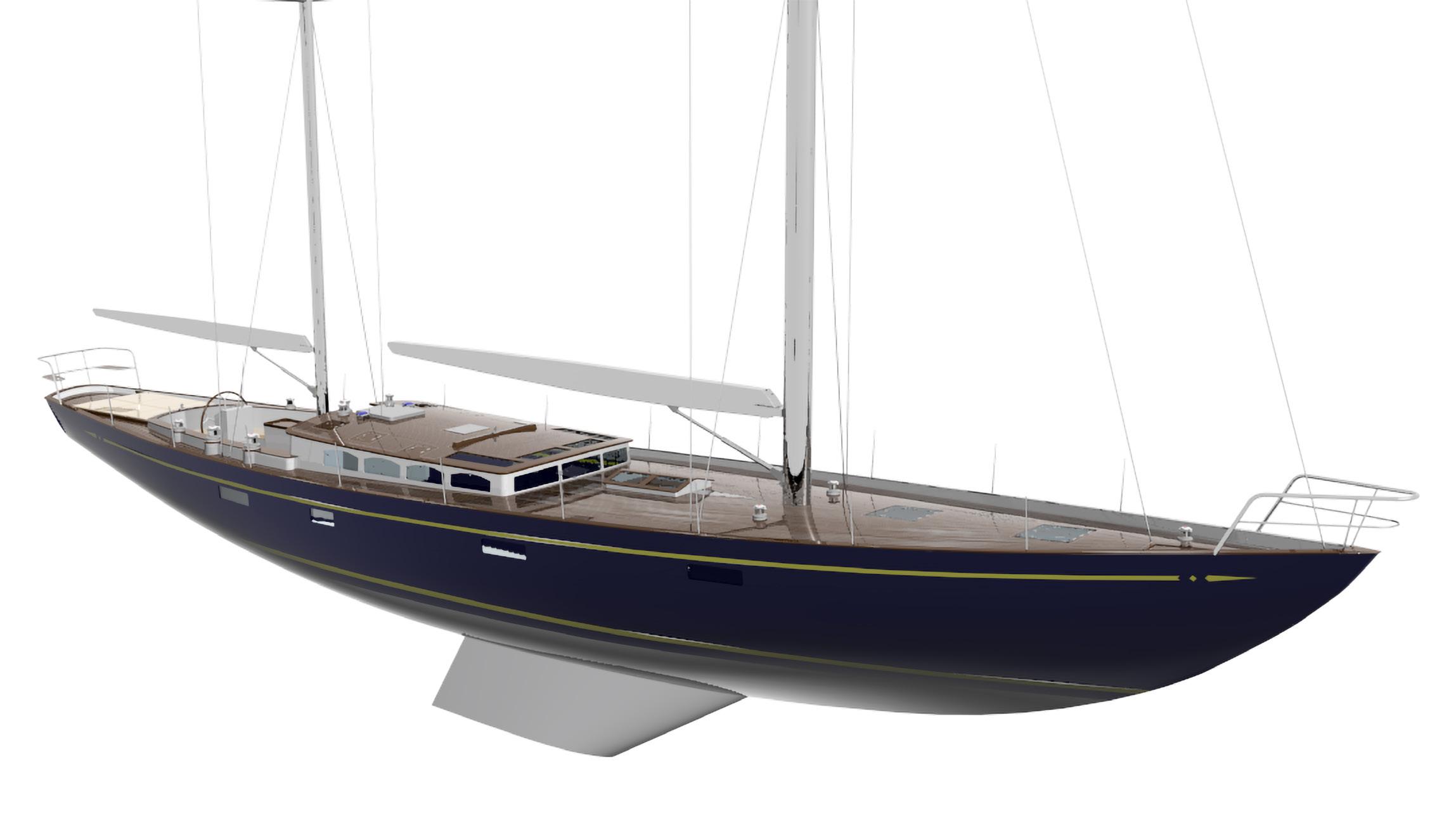
Couchman has been looking into natural alternatives and is working with Greenboats in Germany on hemp and NFCs for interior elements and floor soles, as well as other materials such as carpet from recycled fishing nets or bathroom counters made from crushed laptops and smartphones. “There’s a lot of clever things out there: you’ve just got to track them down,” he says.
Sitting on a worktable in a makeshift office inside the scaffolding tent is a panel with six intriguing patches on it. The patches are different formulations of basalt fibre and epoxy – part of the research Couchman is overseeing into a new and more sustainable composite building material.
“Basalt is one of the most prevalent rocks on the planet,” he says, “so there’s a plentiful supply of it – as long as the mining is done in the right manner – and it’s a very natural, sustainable and recyclable material. And from what we’ve done already, its performance properties are 20 percent higher than glass fibre. But we’ve gone beyond basalt now and we’re doing a project with another of our companies,
Discovery Technologies, which uses a hybrid of many natural sustainable materials. It’s a bit top secret at the moment, but we’re applying for DNV approval for it and we hope to roll it out next year.”
Discovery Technologies has been working on the project with Plymouth University and the National Composite Centre based in Bristol, UK, and the team is being headed up by an ex-McClaren composites specialist. Couchman’s aim is to use the new proprietary material, in which basalt accounts for only around 25 per ent of the mix, to build new yachts under the Discovery Yachts brand that the Couchman brothers acquired early in 2023. The idea is to combine the new material, which has properties very close to carbon fibre with, more environmentally resin systems.
“We’re working with West Systems and ProSet, and also a brand called Entropy Resins which is plant-based,” Couchman says. “At the moment that’s around 30-40 percent bio-content, but it’s changing almost by the month, and there’s a US company that has already cracked 80 percent.”

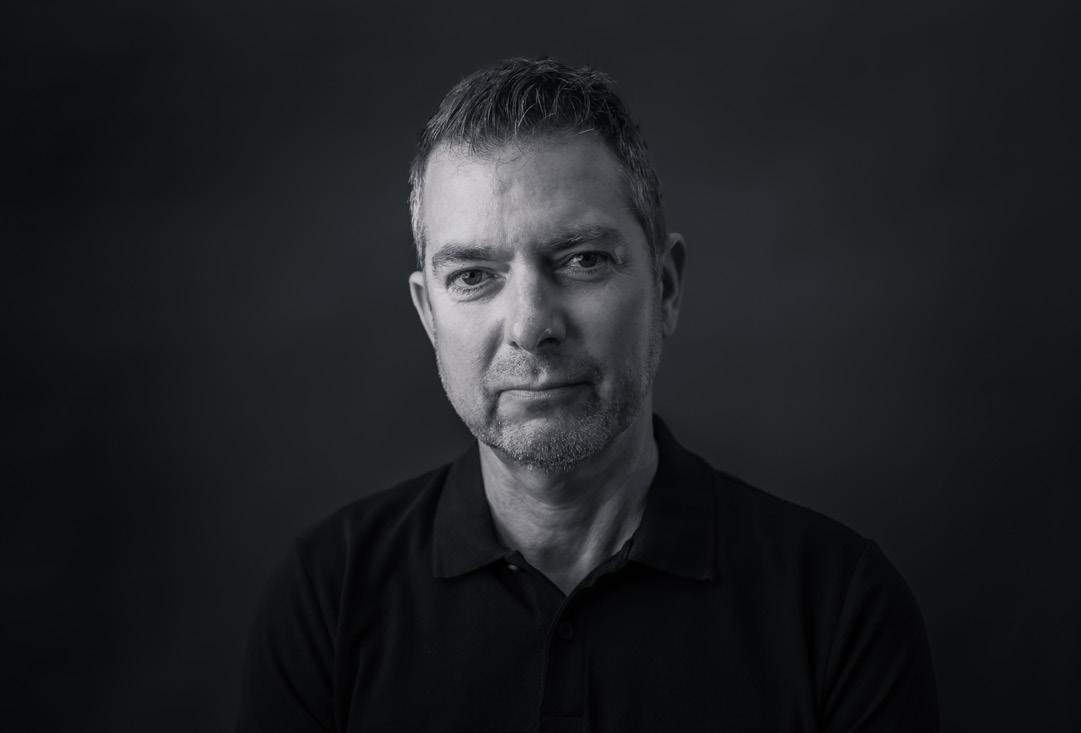

Not long after the Couchmans had begun the work of stripping back and refitting Francis Drake, Dan was offered the chance to buy the mould tooling of a 67-foot sailing yacht. He quickly figured out it was from Discovery Yachts, a British builder of bluewater sailing yachts founded in the late 1990s that had become insolvent during the pandemic after 25 years in business. Couchman leapt at the chance, and tracked down the rest of the moulds, IP and designs.
The Couchmans then set about resurrecting the Discovery Yachts brand and its popular, Ron Holland-designed range of yachts that spanned from 55 to 68 feet. Working with naval architect Rob Doyle and Mark Small, who had worked on the original designs, the new Discovery Yachts is set to offer updated models with a new 55, and new 60 and a new 68, hopefully built using the sustainable basalt-based “DComp” composite that Discovery Technologies has been developing alongside the Francis Drake project. Combined with the new composite, Discovery Yachts will use NFCs and bio-resins to create a cleaner and more sustainable build.
“There is already aviation certification for the raw material, and also for a similar version in the Italian superyacht industry, and we’re hoping DNV approval will follow soon,” says Couchman. “We’ve also put a lot of work into analysing the full lifecycle and making sure the supply chain is fully aligned, because we want to show what boatbuilding can be for the future working with the right partners. Our whole approach is to set new standards in design, experience as well as sustainability.”
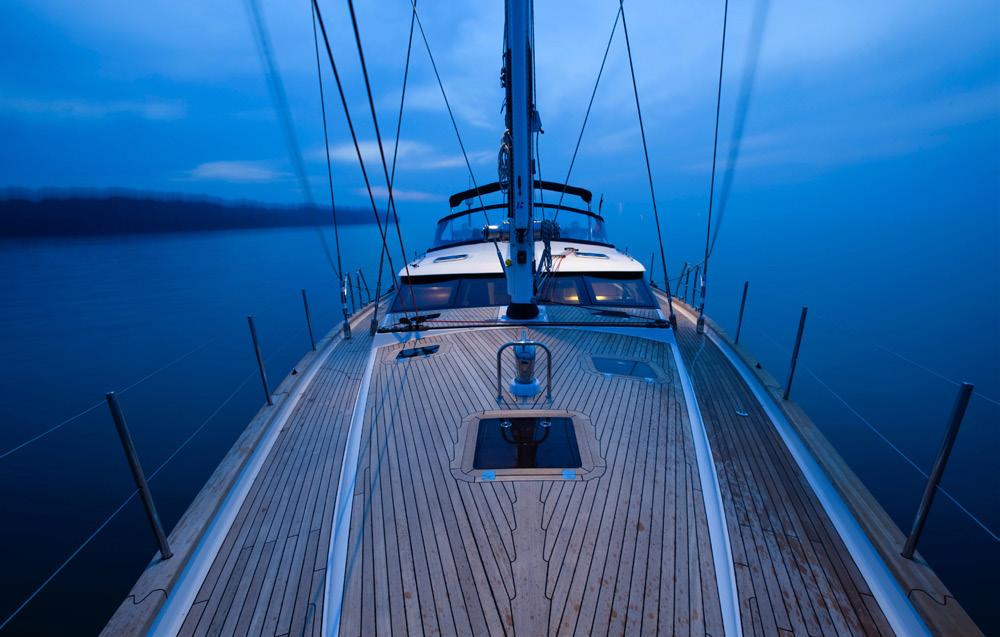
The team is also collaborating with providers of recyclable thermoplastic composites. “Although we haven’t quite worked out how to do the full recycling part yet, that will come,” says Couchman. “Even now, if you put your heart into it and use the latest technologies and products that are available you can build a far more sustainable boat these days than just using standard GRP.”
It's a lofty aim considering the humble beginnings of the original refit project, and there’s still a long way to go, but it’s clearly paying dividends. It has also led to Couchman unveiling a new division of Discovery Yachts called ReDiscovery, with the aim of applying the knowledge gained
on Francis Drake to offer specialist refits of the existing Discovery Yachts fleet, which numbers more than 80 hulls. As of October 2024, there were already ReDiscovery projects underway on two Discovery 55s.
“Francis Drake hasn’t become a beautiful swan yet, that’s still a couple of years away, but she has already been an amazing sounding board for R&D development with the supply chain, because suppliers come to see us and they love it,” Couchman maintains. “It’s really engaging to see what works and what doesn’t, and to figure out where we can improve the build process and make it cleaner. It’s about embracing the latest evolution of technologies, and that’s what Francis Drake is really all about.”


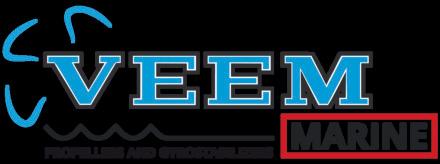
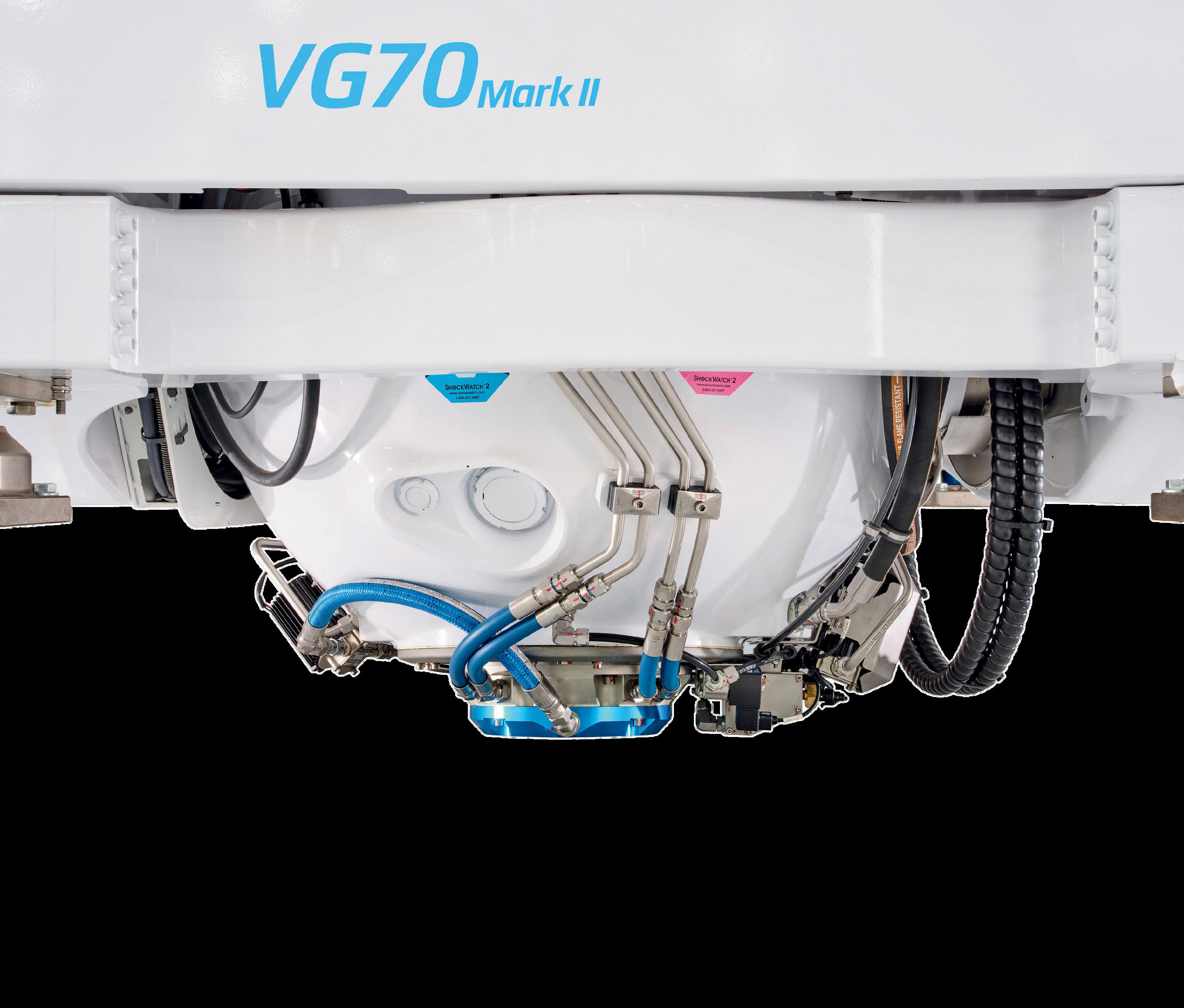
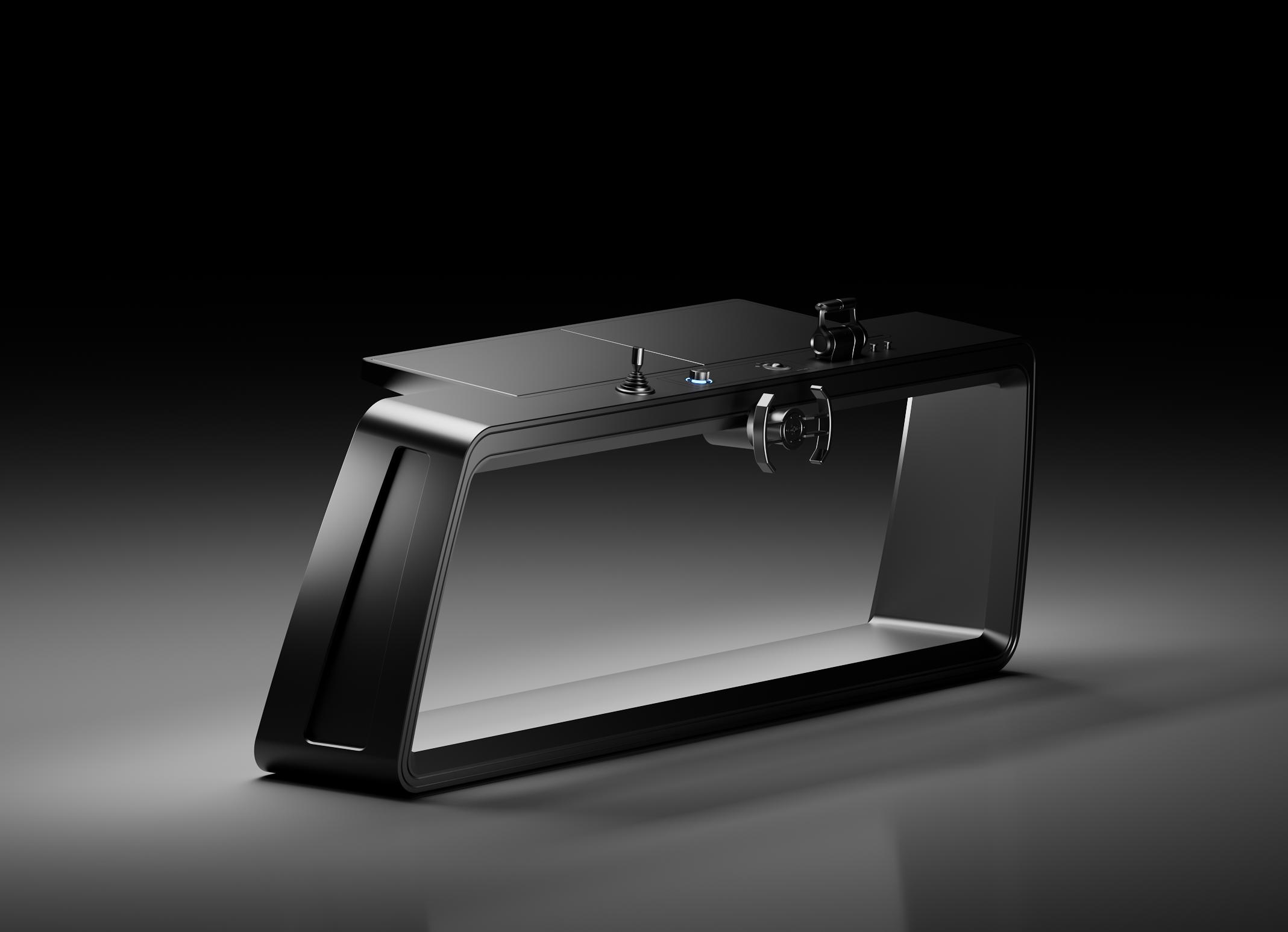

Multiplex offers high end solutions for the biggest yachts afloat. Their carbon boarding systems are second to none.






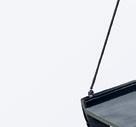


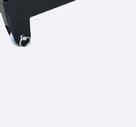
The multi flap is light, stable, weather-proof, and resistant to deformation. At 4.4 kg per metre and with a quick, simple


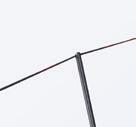
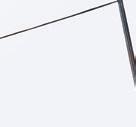










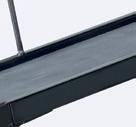




fixing system, it can be mounted and dismounted by a single person.







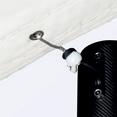

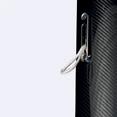



Easy installationand less weight combined with an elegant design have made the sun awning system a product of great popularity. Each sail is individually hand-made, so it will perfectly suit the vessel’s outline. Miscellaneous pole paintings, several types of sailcloth, loudspeakers, and lights can personalize the systems according to taste.



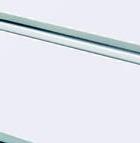
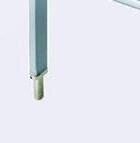
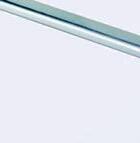




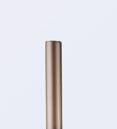


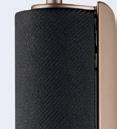





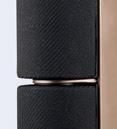

Based on the multifender modular component system, all multifender systems are produced according to individual requirements. This means that we tailor the multifender to all imaginable conditions for vessels up to 12 tons.
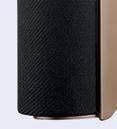


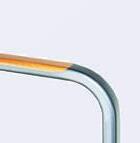
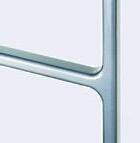
Despite its low weight, the multiguard system can withstand a lateral pressure of up to 100 kilograms and has been certified by Lloyds Register. The system is available in a free choice of colours with worldwide service.
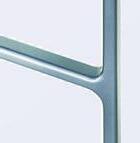

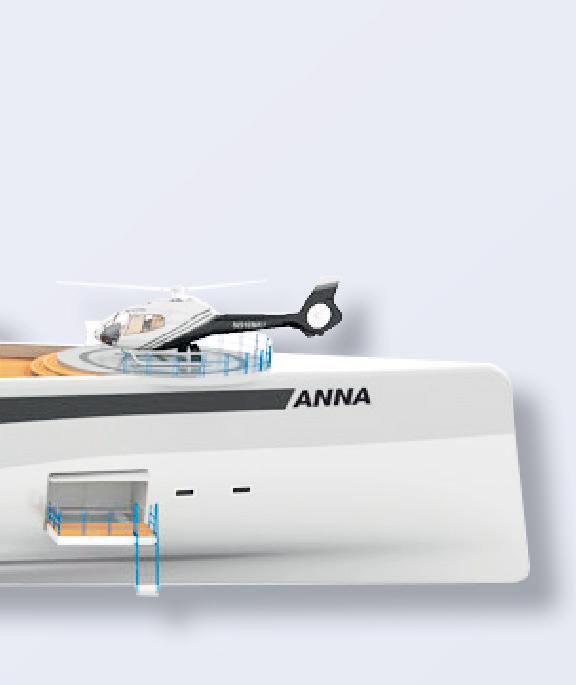
The multistair can be used for access directly into the cockpit over the side or stern. It can be swung 90 degrees from a fully horizontal to a fully vertical position, with all steps automatically aligning in parallel with the sea‘s surface.






The lightness of this ladder construction enables easy assembly and dismantling. The use of carbon fibre and stainless steel ensures 100 % corrosion resistance.


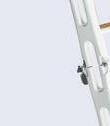
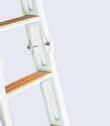





Red Ensign Group’s revised yacht code came into effect on 1 July, 2024. Julian Smith, Principal Surveyor for Cayman Islands Shipping Registry and REG Yacht Code Secretariat, summarises the implications for industry stakeholders.
BY JULIAN SMITH
The existing Red Ensign Group (REG) Yacht Code has been amended in many minor areas for the sake of clarity and to ensure the Code is applied in a technically consistent manner, thus ensuring a much-needed level playing field for designers and shipyards. Data regarding accidents and incidents involving large yachts submitted to the Red Ensign Group since the last revision of the Code was published, have also been reviewed in detail to support the regulatory decision making process.
The REG fully understands the implications of imposing retrospective regulation to existing vessels. Only one item has been added to the 2024 edition of the Code that effects existing passenger yachts having a load line length of 120 metres or more, or having three or more main vertical zones, which are now required to be provided with an onboard stability computer or shore-based support capability relating to flooding casualties.
Significant updates and amendments to the Code affecting new vessels include the following:
– Adoption of the SOLAS 2024 amendments regarding the design of mooring and towing arrangements and the selection of equipment.
– Adoption of the SOLAS 2026 amendments regarding the design, construction and certification of man riding tender launching appliances.
– Adoption of ISO 24482 – Large Yachts: Navigational Bridge Visibility.
– Scope for the use of alternative fuels.
Following a review of numerous serious incidents involving significant water ingress, the Code now includes detailed requirements relating to design criteria for shell doors, their hinges, locking arrangements and control systems. Additional requirements relating to stability criteria assuming beach clubs or tender garage spaces with shell openings located less than 600mm above the upper most load line are partially flooded, are currently under discussion with a view to amending the Code in due course.
The Red Ensign Group (REG) Yacht Code was first published in November 2017 following a major review and update of its predecessors, Large Yacht Code edition 3 (LY3) and the 6th edition of the Passenger Yacht Code (PYC). Since its entry into force on the 1 January 2019, the REG has continued to monitor developments and periodically engages with industry stakeholders to discuss the scope and depth of regulation within the Code and to ensure it maintains its ability to accommodate innovative arrangements and emerging technologies, many of which are unique to this sector of the marine industry.
The Industry Working Group that participates in the ongoing revisions of the Code consists of approximately 155 different stakeholders representing the individual REG Administrations, classification societies, shipyards, naval architects, management companies, consultants and industry associations. During the development process, the group is tasked with identifying any industry specific risks that have yet to be properly addressed and provide feedback regarding existing regulation. This stakeholder engagement and consultation exercise took place over a period of some two years and consisted of hybrid meetings in the Netherlands at the offices of SYBAss and Feadship, together with a series of correspondence groups and subgroup meetings. The conclusion is what is now the 2024 edition of the REG Yacht Code, as published on 1 January 2024. The latest edition of the Code is applicable to contract signing dates – or in the absence of a contract, keel laying dates – on or after 1 July, 2024.
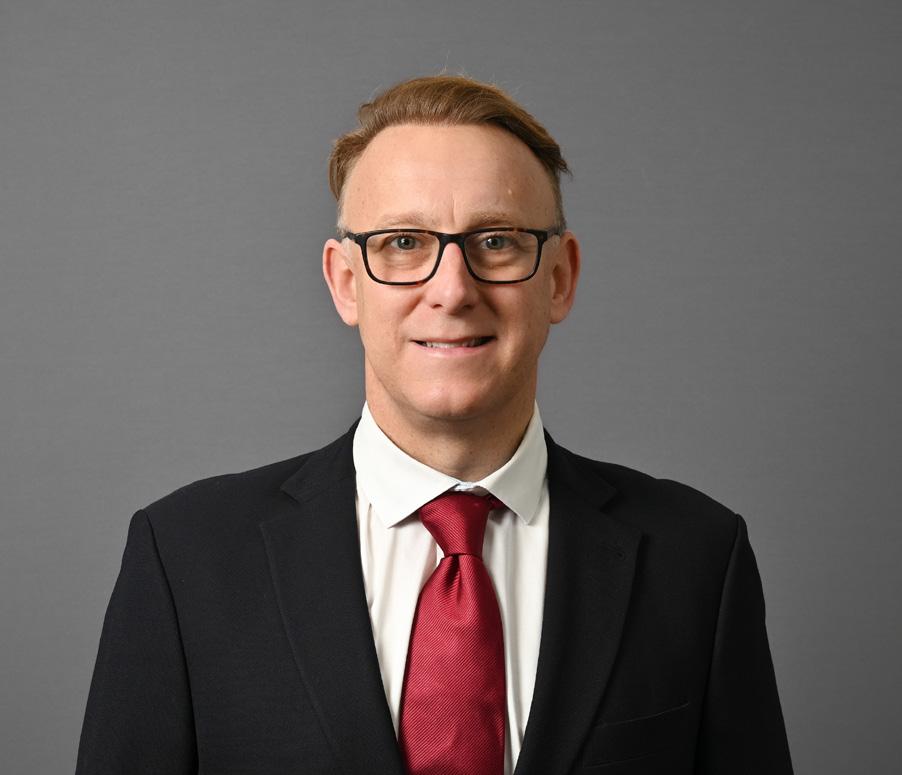

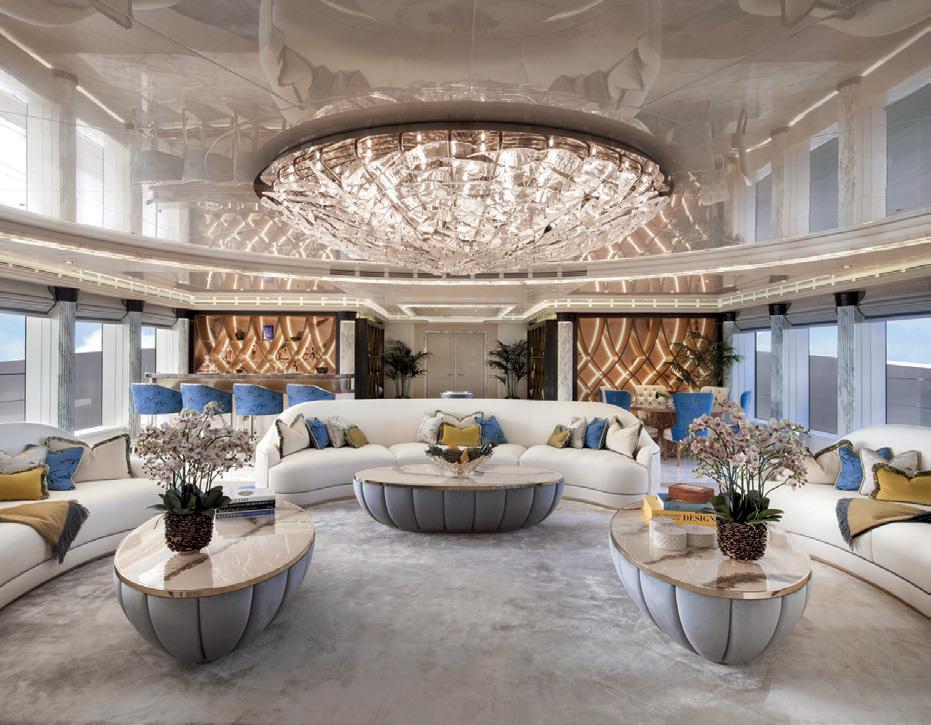
A comprehensive review of the existing intact and damage stability criteria has been undertaken and the following key areas now added or amended:
– Limitations regarding the use of internal down flooding and cross flooding devices for compliance with damage stability criteria.
– Clarification of stability criteria and drainage arrangements for swimming pools, spa baths and Jacuzzis.
– The adoption of SOLAS 2020 amendments to probabilistic damage stability criteria for passenger yachts carrying more than 120 persons.
– Revised guidance for watertight doors which may be open for navigation onboard passenger yachts.
A number of key areas, which significantly impact the general arrangement of the yacht and have previously been open to interpretation, have been reviewed and amended to include the following:
– Clarification of criteria for launching lifeboats, liferafts and Marine Evacuation Systems (MES) under adverse angles of heel and list.
– Clarification of non-man riding requirements for rescue boats installed onboard large yachts of less than 500GT.
– Clarification of requirements for number and arrangement of launching appliances and embarkation ladders.
The following risks associated with fire safety have now been addressed in the Code and detailed regulatory requirements subsequently added:
– Simplified requirements for battery powered propulsion and hotel systems.
– Storage of electrically driven tenders and toys.
– Requirements for storage of compressed gases and paint.
– Muting of audio-visual entertainment systems upon activation of the fire detection, public address and general alarm systems.
“The REG fully understands the implications of imposing retrospective regulation to existing vessels.”
In recognition of the increased quantity and complexity of equipment now found on board large yachts with respect to diving operations together with the associated risks, the scope of the Code has been expanded to include regulatory requirements for the following:
– SCUBA (Air and Nitrox).
– Hyperbaric recompression chambers.
– Storage arrangements for diving equipment.
Requirements concerning the provision of safety radio-related equipment have now been updated to harmonise with SOLAS Chapter IV, albeit yachts of less than 300GT do not require an enhanced means of ensuring continued availability (i.e. duplication of equipment, the provision of a shore-based maintenance agreement or at sea maintenance capability).
The qualifying criteria for such vessels to be considered as a large yacht (rather than an alternate ship type) has now been included in the Code and the difference between cargo and stores carried for the mother vessel now defined.
One initiative which has been well received by industry is the extension of the ‘Short-Range Yacht’ (operation within 60 nautical miles of a safe haven and specified weather restrictions) from 300 to 499GT subject to those yachts over 300GT being provided with a fixed fire extinguishing system in accommodation and service spaces. In conclusion, the REG Yacht Code will continue to be a live document to accommodate changing trends and technologies. In the meantime, the REG will continue to engage with and listen to industry to ensure that the Code remains relevant, userfriendly and sets an appropriate level of safety.
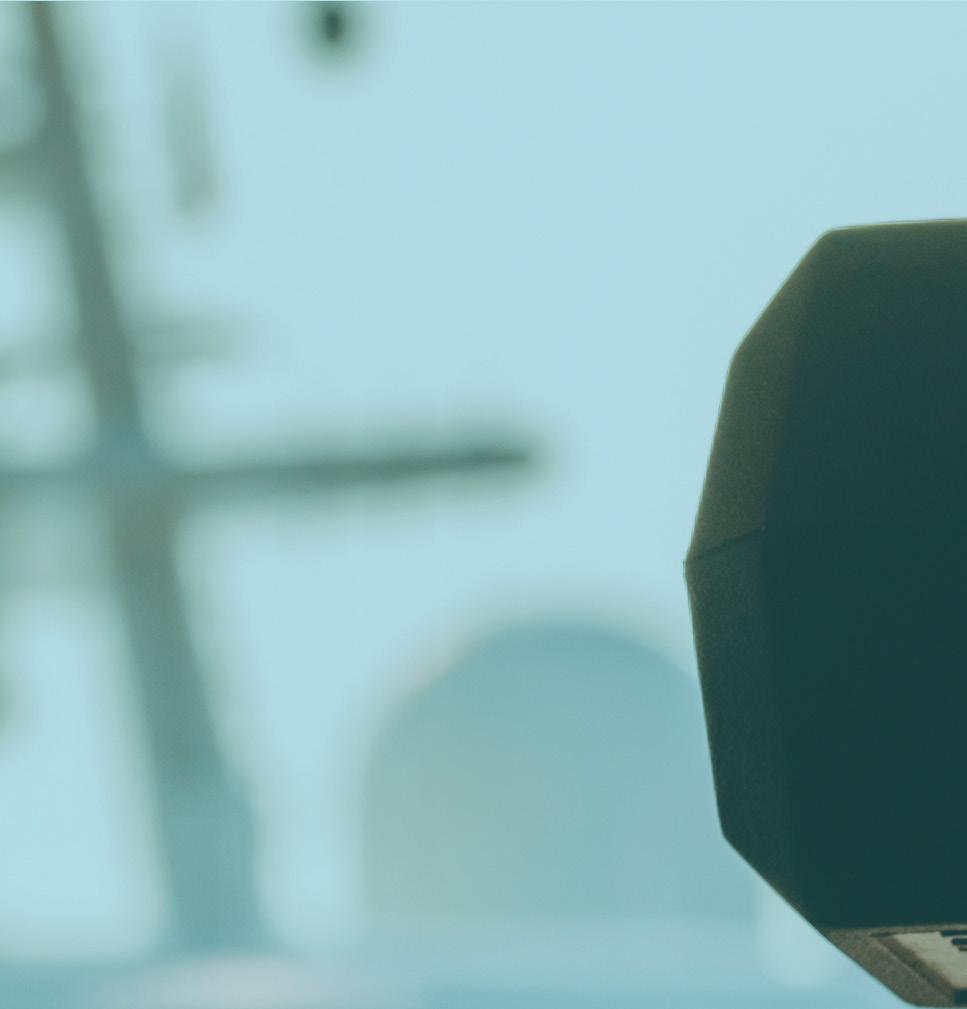



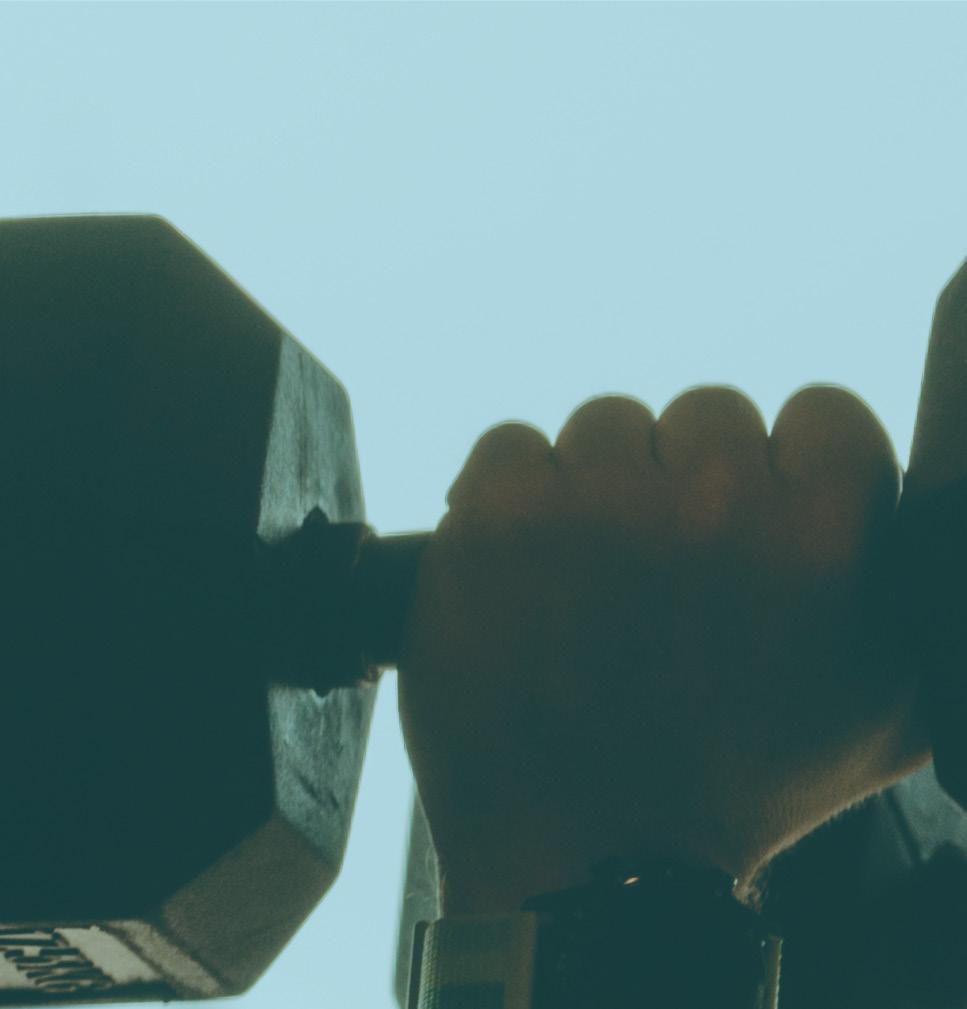
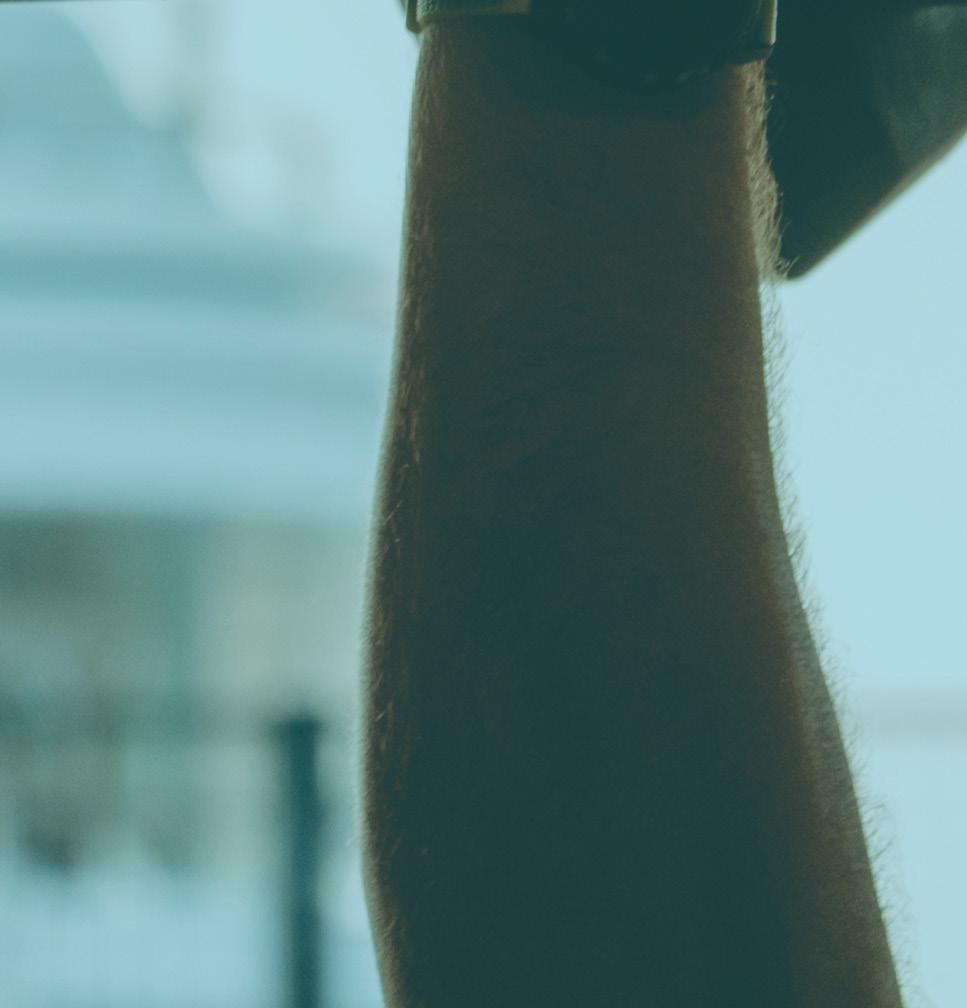


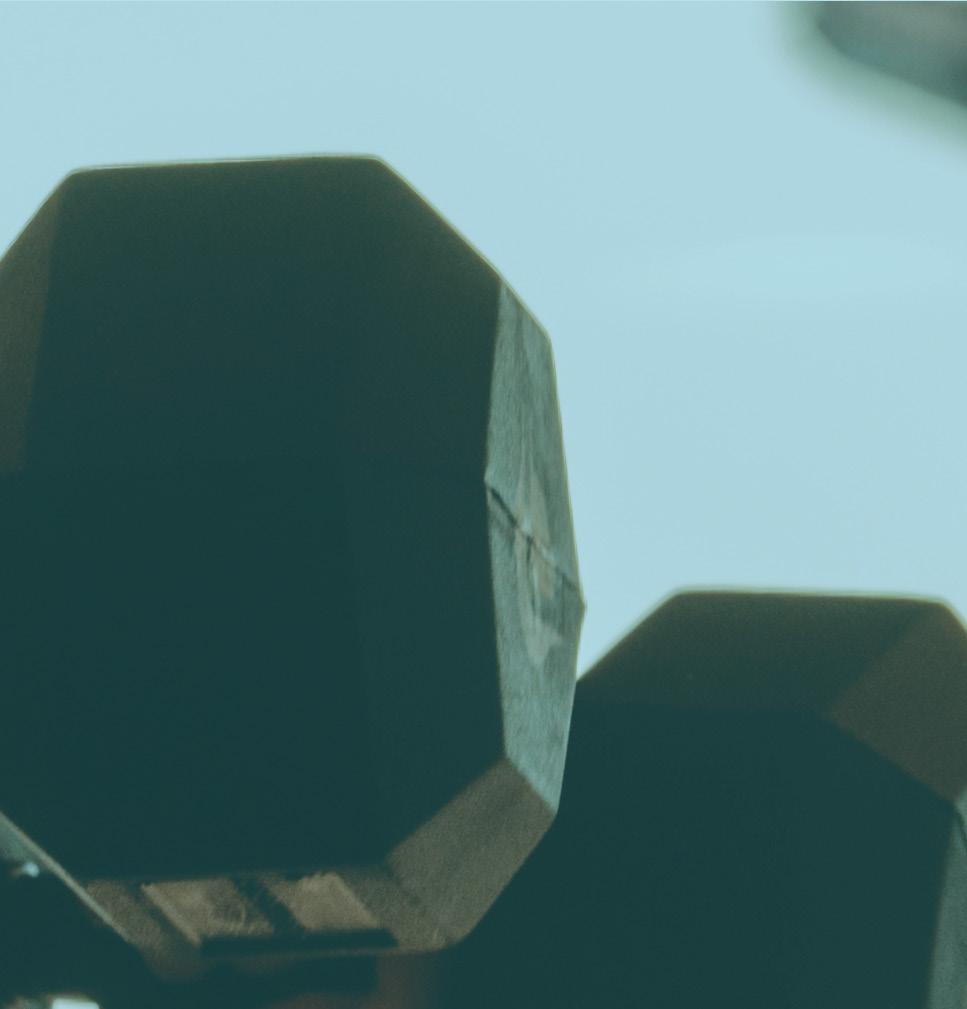
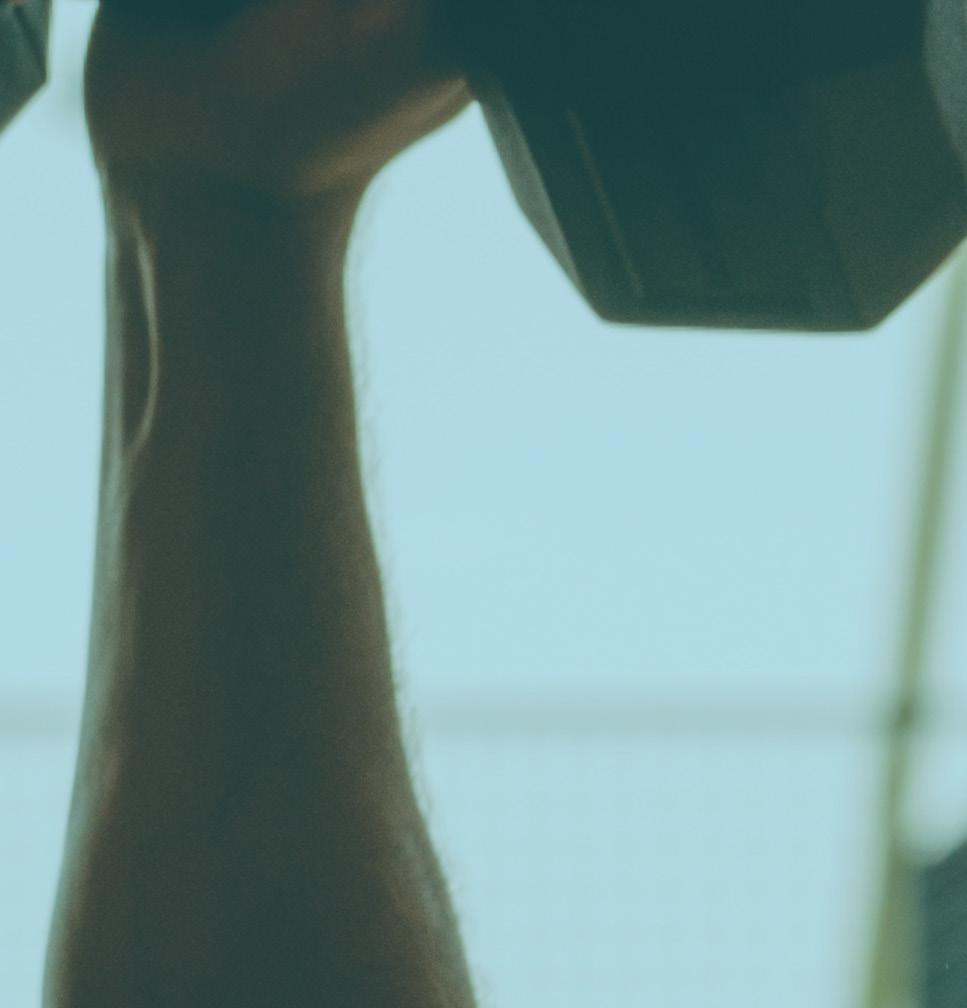



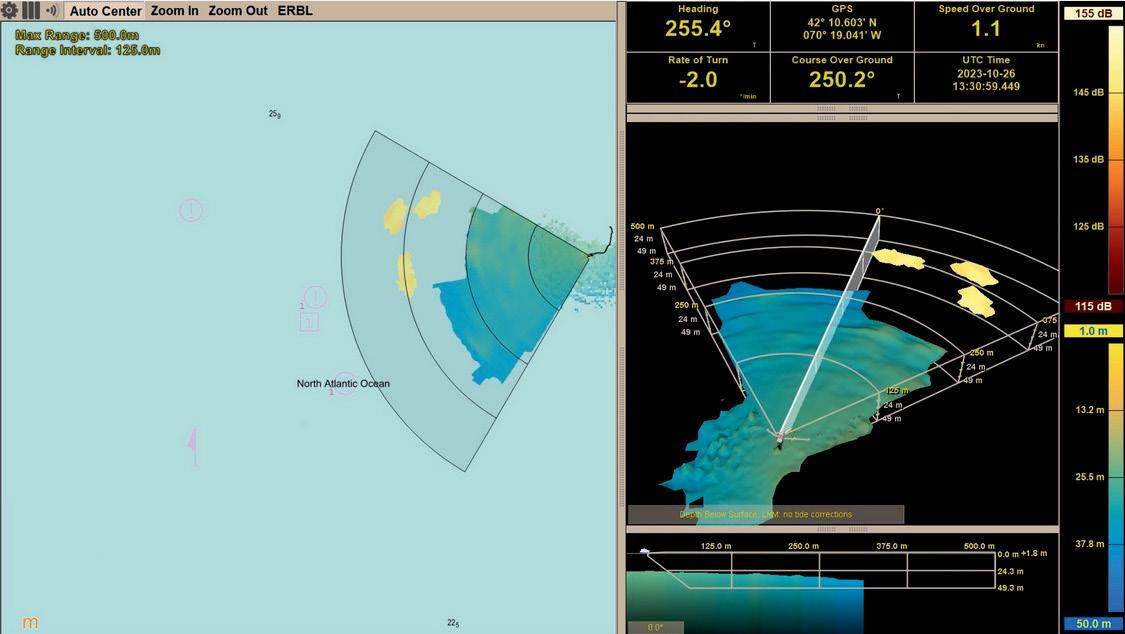



Get real time imagery of what's ahead
NAVIGATE SAFELY & CONFIDENTLY
See obstacles in the water and shallows
Avoid whales with benign sonar
Keep your map history for future use
Contribute to global mapping initiatives
Display in 3D and on a chart
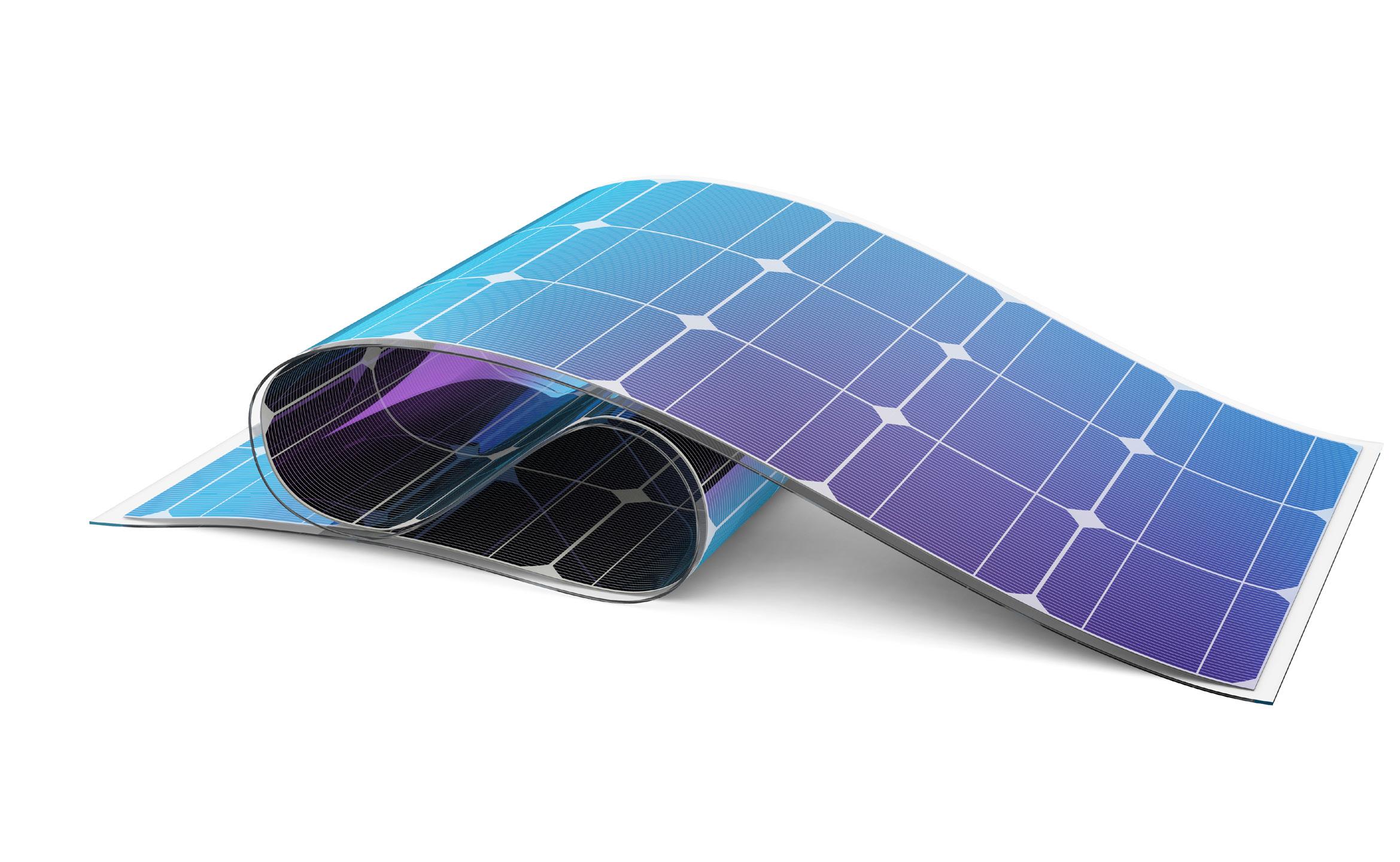

From shipyard roof-top installations to the Monaco Energy Boat Challenge, solar power is having something of a moment, yet it is rarely found on superyachts. What is the current status of solar tech and will it ever increase traction as an onboard renewable on big boats?
BY CHARLOTTE THOMAS
While solar power is increasingly a key source of renewable energy for national grids, industrial manufacturers –including shipyards – and homeowners, it hasn’t made much impact on the design and operation of superyachts. Aesthetics, practicalities, cost and low energy yield are all blamed to varying degrees, but that hasn’t put off some corners of the yachting industry. No one visiting a boat show in the past few years could have failed to notice the Eco line of catamarans from Sunreef Yachts, for example. The Polish brand has made a point not only of using solar power in its hybrid projects, but has developed its own patented, toughened solar panels that are built into every square metre of hull and superstructure. Similarly, Silent Yachts set out specifically to develop a range of operationally ecofriendly power cats that draw on solar as the dominant power source and couple that to a complete electric drivetrain.
“The solar panels are limited by the space on board, which is why historically we picked a catamaran, and also why we didn’t pick a sailing cat where the mast and sails would impede the sunlight,” says Steve Bell, Vice Chairman of the board of Silent Yachts since the company changed ownership in early 2024. “We store as much energy as we can in batteries, which on our Silent 62 is around 300 kilowatt-hours in total. Cruising at six knots uses 20kW per motor, or 40kW total, so a simple maths calculation [300 divided by 40] suggests an eight-hour range.”
The 62 carries a total of 16.8 kilowatts-peak (kWp) of solar panels, meaning in an ideal scenario the panels would produce 16.8kW of power. This is never the case, however, as losses through efficiency, angle of sun, dirt on the cells, or any number of factors, always impedes energy generation. It is one of the details that sometimes gets lost in the marketing about the capabilities for generating power from the sun.
“On a really good day our 16.8kWp of panels will pull around 12kW,” confirms Bell. “There’s a misconception that kWp equals actual kW produced, but that doesn’t happen with any solar panel.”


There is also the hotel load to consider. On the Silent 62, this typically equates to around 10kW when using energy-hungry systems like the air conditioning, which means the solar panels are serving the hotel load while the stored energy is powering the drivetrain. It starts to make more sense if you consider a typical operational profile, the Med cruising around the Balearic or the Greek islands, for example. This may involve two or three hours of motoring to reach a bay, then spending the rest of the day at anchor.
“What we’re also trying to do is manage the hotel load to keep that energy burn to a minimum, including educating our customers about things like turning stuff off when it’s not needed,” Bell says. “That means you effectively get to run the yacht off solar and only need to charge the batteries with the generator every four or five days.”
Bell adds that cruising at 3.5 knots reduces drivetrain power draw to around 8kW. If you minimise hotel load, this could mean free, continuous daylight cruising. But you still wouldn’t be sailing around the world using only solar power: “You could do that, but only if you want to do it at two knots – which people don’t,” adds Bell.
For Silent Yachts, whose largest planned model is the 36.74-metre Silent 120 Explorer, scaling up is relatively straightforward for models like the 80, which uses the same propulsion drives as the 62 and has more space for solar panels to handle the increased hotel load. The challenge is transferring the tech to bigger superyachts, where the hotel and propulsion energy demands on energy are exponentially higher. This may suggest there’s a limit to the usefulness of solar as a renewable energy source on superyachts, although that is somewhat missing the point.
The idea of covering every surface of your superyacht with solar cells creates another obstacle centred on aesthetics. Styling is a key driver of owner interest, but one way to integrate solar energy more comprehensively – and less obtrusively – is solar glass. Glass that integrates solar cells to draw power has been around for a long time, and not just in land-based architectural contexts, where the technology is increasingly popular for large public buildings, electric charging stations and even private car ports and domestic terraces.
For Italian builder Arcadia it has been a trademark feature in several of its models since the first 25.9-metre A85 model in 2009.
Arcadia Yachts show how solar tech can be transformed into something that is architecturally pleasing – especially from the inside – while meeting the twin demands of sustainability and practicality. The glass superstructure of the A85 contains more than 40 square metres of solar panels, producing up to 4.5kW of energy – not enough to power the yacht, but sufficient to make a contribution to the hotel load, particularly when combined with other energy-saving design elements. The glass used by Arcadia was developed by Austrian company Ertex Solar, which produces glass that can be specified with different levels of transparency and solar cell density, as well as patterns and designs. Arcadia says improvements in solar tech have led to a 30 percent increase in energy yield since its first launch.
The same year the Arcadia A85 was launched, Feadship came out with its Aeon Future Concept, which had not 40 but 400 square metres of solar panels. The Dutch builder has since taken steps to include solar cells on one of its latest launches, the 59.5-metre Project 713 (now named B), which underwent initial sea trials in July. The first Feadship to carry solar panels for auxiliary power generation, over 87 square-metres of high-efficiency solar cells are recessed into the curved superstructure surfaces of the upper decks. Feadship claims that the laser-cut, walkable, saltwater-resistant panels are able to counteract the effects of partial shading and can generate a total power of approximately 16.8kW, equivalent to about 100 kWh on sunny days.

Although available, thin-cell PV technology for sun awnings or sails is still in development.
Top: The interior of the Arcadia 85 shows how solar tech can be architecturally pleasing. Following spread: Superyacht B is the first Feadship to harness solar energy for auxiliary power generation.

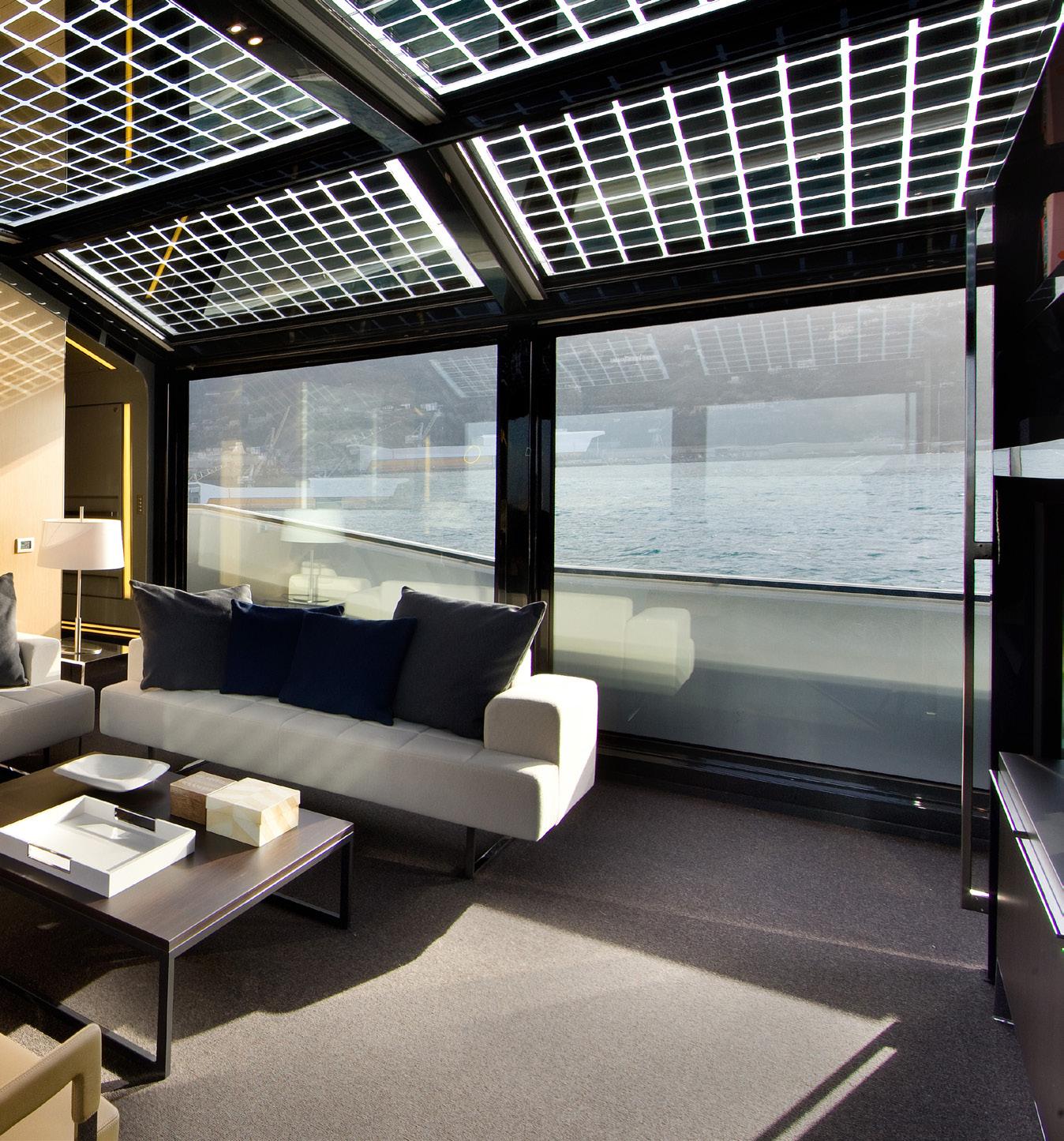
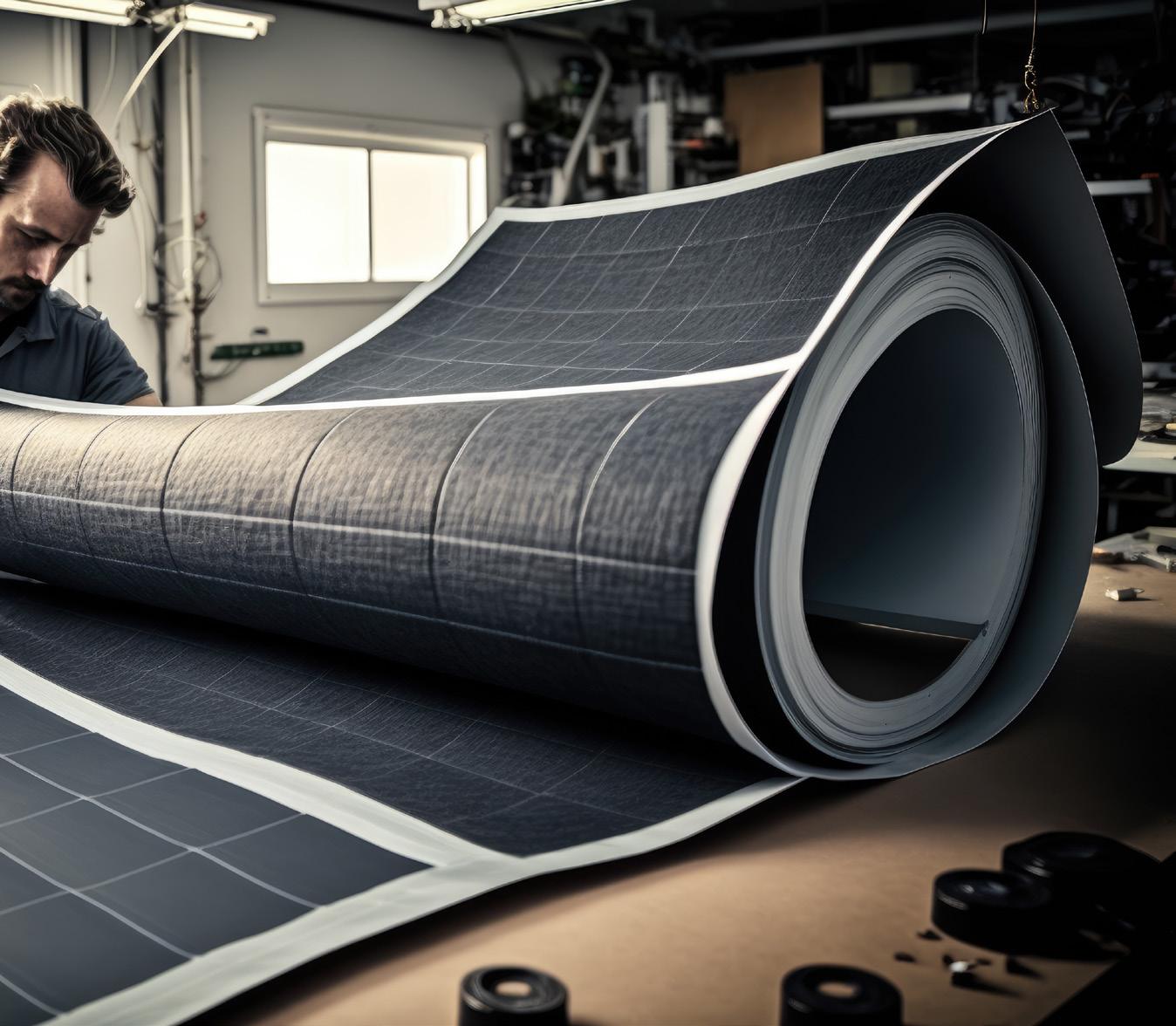
Other superyacht builders are considering how solar might form part of the future energy mix. Heesen Yachts, for example, is looking into adding thin-film photovoltaic panels on the mast and integrating cells into the fabric of sun awnings for free, sustainable power.
“In our case we looked at putting 25 squaremetres of flexible Solbian SP panels on the mast of a 50 or 55-metre yacht,” says Erik van Mourik, Manager Cost & Accounting D&D at Heesen. “This would save approximately one percent of the hotel load on a 24-hour cycle. This is not much on its own, but if you combine it with other measures such as waste heat recovery and smart air-con zoning, you can create a more substantial package of energy savings.”
Baglietto uses solar energy to run its Bzero fuel cell technology. Sized to fit on a yacht, the array of solar panels at its one-to-onescale test installation at the shipyard in La Spezia powers a hydrogen production module, which filters and de-ionises seawater through AEM-type electrolysers to produce green hydrogen with 5.0 purity grade at a maximum pressure of 35 bar. The PEM-type fuel cell then uses the hydrogen as fuel to produce clean electricity. The prototype plant is now producing hydrogen and space has been allocated for the Bzero technology aboard Baglietto’s second 60-metre T60 hybrid in-build.
Another example of solar being harnessed as part of wider energy strategy on board is the Project Zero sailing yacht featured in the last issue of How to Build It, which is aiming to reduce onboard energy consumption from 90kW to less than 30kW. In this case, a key part of the energy production comes from hybrid photovoltaic-thermal (pv-T) panels developed from existing land-based building tech.
In general, however, the pace of development of solar tech has been relatively slow, despite next-gen technologies such as perovskite structures (see sidebar) that promise to improve the efficiency of panels at lower cost than traditional silicon cells, and allow for novel uses such as the creation of solar paint, or solar fabrics for awnings and sails. But perovskites are still a way off commercialisation and it doesn’t alter the fact that their placement and orientation will remain critical.

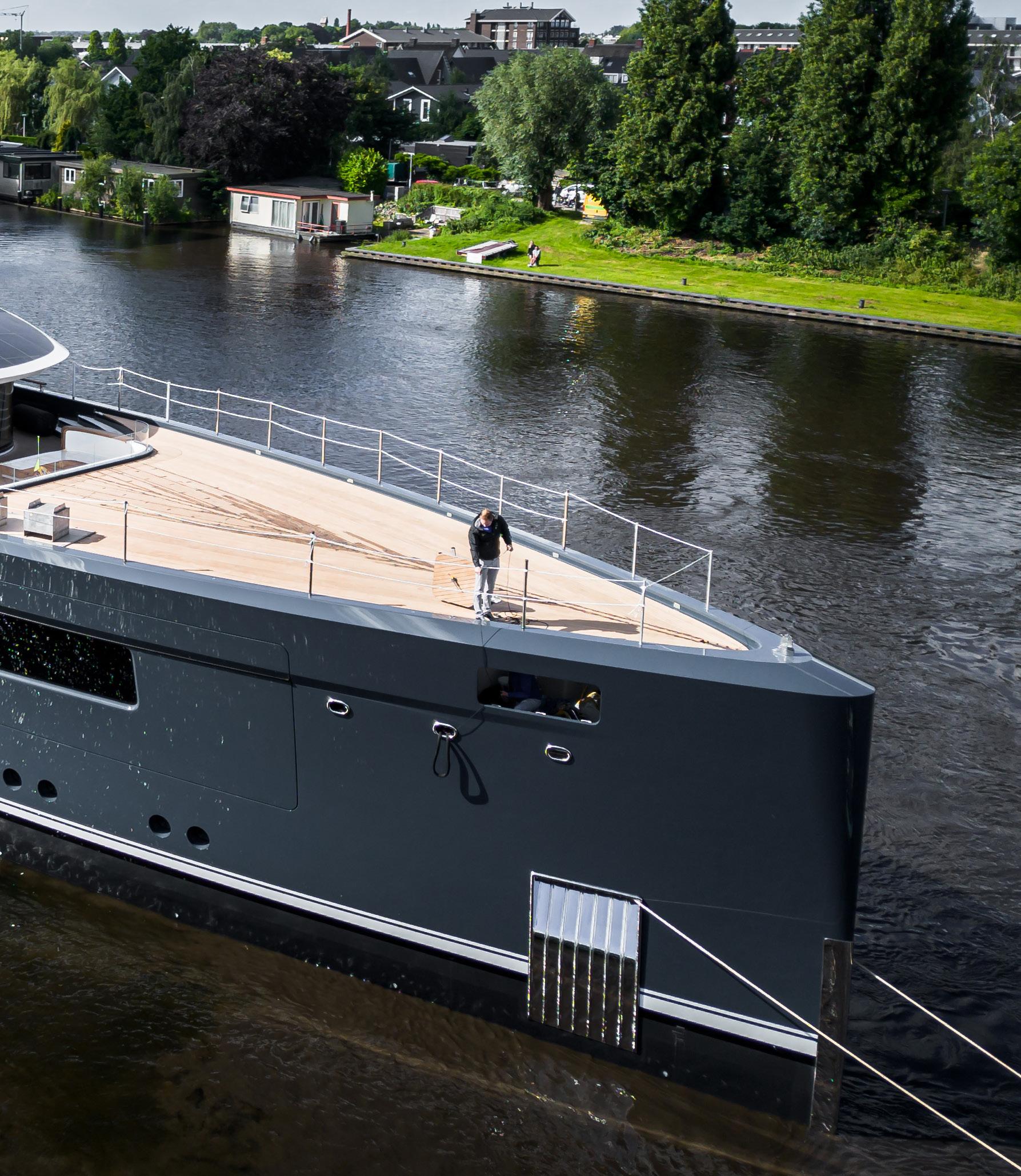
“The difference in efficiency between having a panel flat or tilting is around 25 percent,” says Bell. “That means if you have panels mounted vertically in the hull topsides, or even on sails, then in the midday sun in the tropics you’re not going to get any photovoltaic energy. For example, at 09:00 on a beautiful sunny morning in Venice we looked at what the panels on our 62 were producing, and the high-voltage panels – which are around 13kWp and typically produce nine to 10kW –were producing just 1.8kW.”
While the solar industry is constantly talking about new solutions and innovative products, Bell suggests the fact that manufacturers are selling huge numbers of conventional panels means there is less incentive to invest in new tech and new production methods with potentially high start-up costs.
“For our new models we’re looking at how to optimise the space for panels based on retaining aesthetics,” he continues. “We are looking at solar panel tech, but I think that isn’t going to change much for the foreseeable future – technology development at the moment is really in batteries and energy management. Indeed, while there have been some improvements in panel efficiency over recent years, by contrast we’ve gained 15 percent capacity for the same physical size of battery over the same period.”
It may well be that the sweet spot for yachts that draw on solar power as a key provider of sustainable energy will remain in the 20 to 40-metre bracket, but there’s still no reason why larger yachts should not include solar as part of their power mix. For one, it’s essentially free and it’s green – at least in the operational phase – and anything that reduces the need for fossil fuel power generation is a positive. Moreover, by its very nature it drives a conversation about how to mitigate energy consumption on board, whether through smart zoning, developing new technologies in air conditioning, insulation and lighting, or just more efficient energy management. As solar tech improves with more efficient cells and more innovative materials able to harvest more energy, it’s only going to get more interesting for yachts of any size.
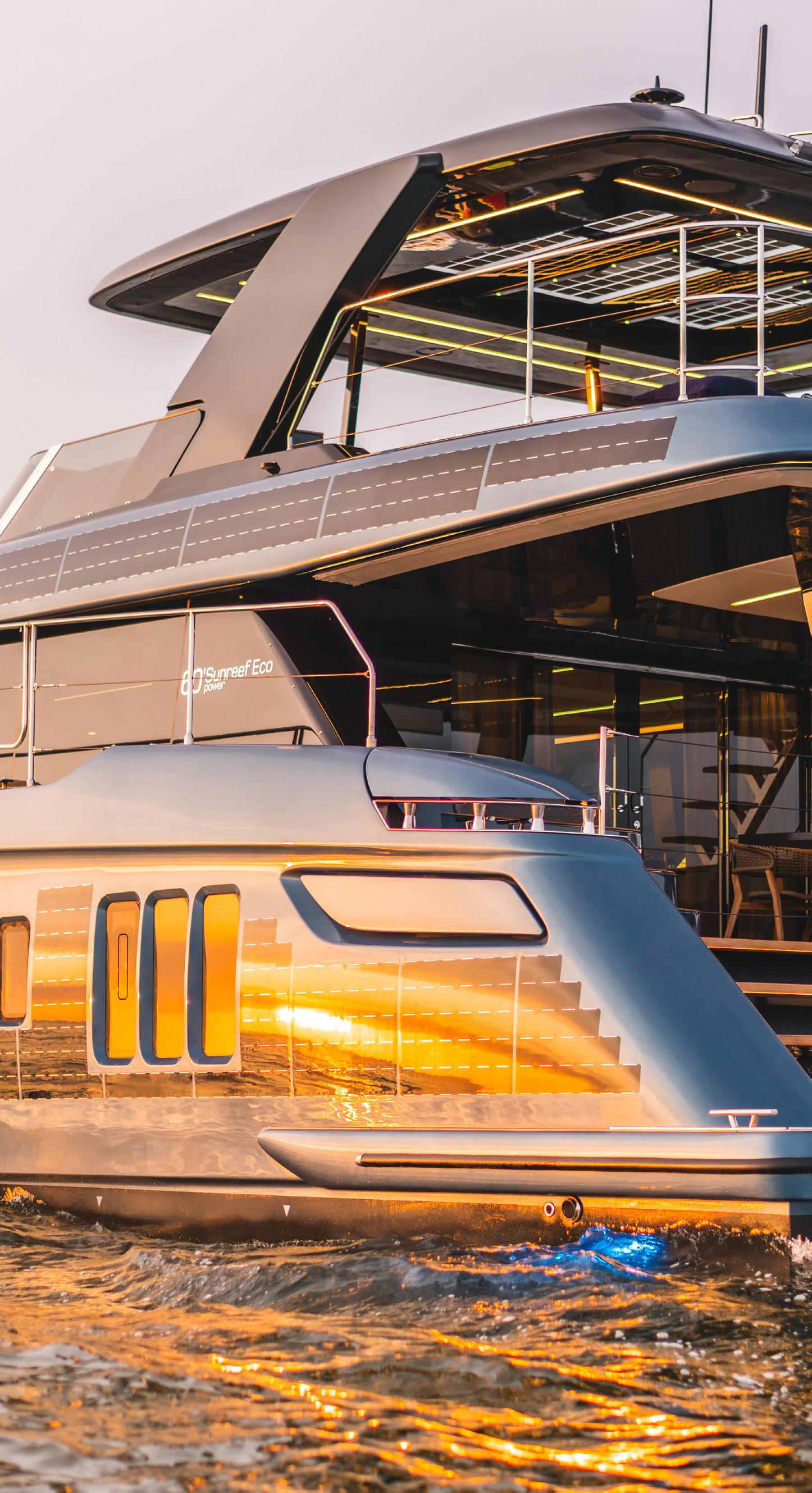
“The difference in efficiency between having a panel flat or tilting is around 25 percent.”
The idea of a paint that can capture energy from the sun has been mooted for several years, but so far no such paint has emerged on the market. In fact, there are three possible solar paint technologies currently being explored – even if they are still years away from commercial production or availability.
The first is a product developed by a team at the Royal Melbourne Institute of Technology that absorbs moisture from the air and uses solar energy to break the water down into hydrogen and oxygen, with the hydrogen being used for clean energy.
The second, developed by the University of Toronto, uses colloidal quantum dot photovoltaics – essentially nanoscale semiconductors – to capture light and convert it into electricity more efficiently than conventional solar cells. The dots can be tuned to different light spectrums by changing their size.
Finally, there are perovskites. Named after a Russian mineralogist, perovskites are a type of crystal structure and have been a topic of discussion for a while now. Perovskites offer properties that allow for higher power conversion efficiency (similar to what are known as multi-junction solar cells) and can take liquid form – ideal for solar paint.
A team at the University of Sheffield in the UK developed the first spray-on solar cells back in 2014, but more recently scientists at Oxford University have produced a micro-thin perovskite coating with the potential to generate up to nearly twice the amount of energy of current solar panels and can be applied to almost any surface. The researchers believe that over time, perovskites will be able to deliver efficiency exceeding 44 percent, pointing to the increase in yield they were able to achieve during just five years of experimentation, from 6 to 27 percent. Watch this space!


When your skills become a seamless unit with your equipment and materials, you are on the way to a perfect paint job.
With our yacht coatings, you can achieve outstanding durability, maximum gloss and longevity from the first to the final layer. Enjoy the creation of easy, efficient and high-performing finishes.
Scan the QR Code to explore our product range → Celebrating 20 Years of Excellence
instagram.com/alexsealpaint linkedin.com/company/alexseal-yacht-coatings